Press Releases
Hudbay | Workers from communities account for almost 50% of operators in the mine area
 22th March
22th March
Hudbay: Workers from communities account for almost 50% of operators in the mine area
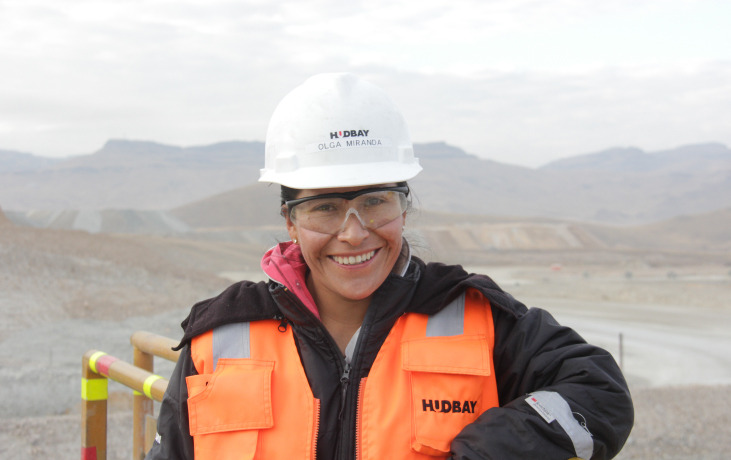
At Constancia Mining Unit, 46% of the mine equipment operators reside in the rural communities of Chilloroya and Uchucarcco, areas of direct influence of the project in the Cusco province of Chumbivilcas. This number has been growing over the years, given that in 2016 local operators only represented 16%; this is partly explained by the training programs that both Hudbay and its main contractors have implemented in the area.
To date, 35 community operators have graduated from Hudbay's training program and 28 of them are currently working operating various equipment such as 336 Excavator, Road Roller, Caterpillar D-10, 8x4 Dumper, Actros Tanker and 996H Front End Loader.
Among the workers who have participated in this program is Olga Miranda, a native of the rural community of Uchucarcco, who is currently working as a mine auxiliary equipment operator at Constancia.
"I used to work as a floor and lookout person for a mining contractor where I was able to see how work was being done in the mine. I considered that I could also perform those duties, so when the opportunity appeared, I took it," says Olga.
She participated in one of the training programs in March 2017 where for six months she was trained to operate a crucial piece of equipment for the operation such as the 336 excavator. Being among the most outstanding in the program, she was hired in October of that year and started her professional life at Hudbay Peru.
Due to her excellent performance, her immediate bosses offered her the opportunity to continue training in the operation of other equipment such as the 374 excavator (which she did in June 2019) and the Hitachi EX5600-6 shovel (which she has been doing since December 2020).
Olga hopes to pursue a career path with the company and eventually become a trainer for other community members and for more women to learn how to operate this type of machinery.
The hiring of skilled workers from the communities in the area of influence of mining projects allows the mine to meet its needs during operation without having to resort to excessive external personnel, thus achieving greater operational and financial efficiency and boosting local economy, generating long-term development.
proEXPLO 2021: Mineral Resources for a Sustainable Future
Renewables and electric cars will drive copper demand this decade
 26th March
26th March
Renewables and electric cars will drive copper demand this decade
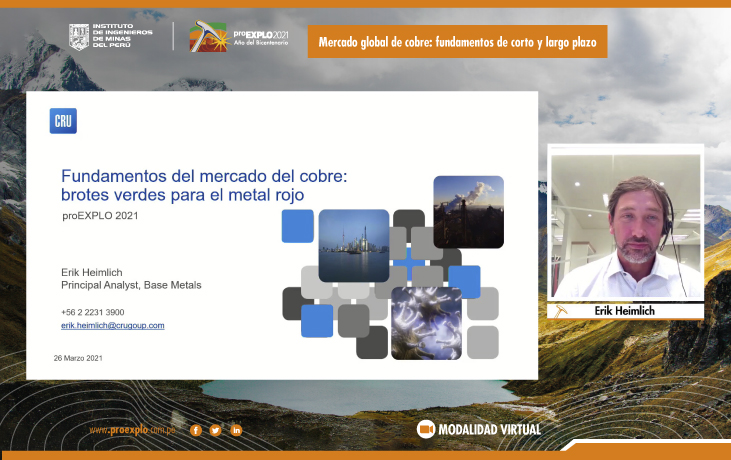
On the last day of the 12th International Congress of Prospectors and Explorers (proEXPLO 2021), the Senior Analyst of the Base Metals Analysis team at CRU, Erik Heimlich, evaluated the real situation and what is to come in relation to copper; as well as the causes that will impact both its production and demand.
With the presentation "Global Copper Market: Short and Long-Term Fundamentals", the economist indicated that non-conventional renewable energies and electric cars will drive copper demand in this decade, that is, in the period 2021-2030.
Regarding price, Erik Heimlich estimated that copper price volatility will continue. "Hopefully it will peak in 2021 and come down a bit in the next few years. Also, there will be new mines and small surpluses that are estimated to be less than 200,000 tons per year in a market of 25 million tons," he said.
Likewise, he pointed out that when we talk about a copper price supercycle, this refers to prolonged periods of rise. "Going forward, the candidate for a supercycle is the transformation to a green economy, which will imply a greater demand and also supply restrictions," he said.
He added that China is in a transition to less capital-intensive and is trying to develop high-tech sectors; therefore, copper consumption after 2030 will depend on what will happen with consumption in the world outside China.
At another point in his presentation, Erik Heimlich emphasized that banks are increasingly evaluating social and environmental risks; and that ratings for mining companies are lower than for other sectors. "Financing will depend on the correct measurement of social and environmental risks," he said.
In response to questions posed by the general manager of Kallpa SAB and moderator of the keynote, Alberto Arispe, the senior analyst of the Base Metals Analysis team at CRU specified that China has made strategic purchases to protect and ensure supply.
"They tend to buy when the price is low and they buy it from outside China; but it is only 3 months of consumption. Also, China's strategy is that they made a lot of early investment (even when sectors of the population with lower GDP per capita did not justify it), such as high-speed trains or electricity grids; and we know that in their eighth five-year plan they expect services development," Erik Heimlich pointed out.
proEXPLO 2021: Mineral Resources for a Sustainable Future
Peru has Good Chances of Joining CRIRSCO
 26th March
26th March
Peru has good chances of joining CRIRSCO
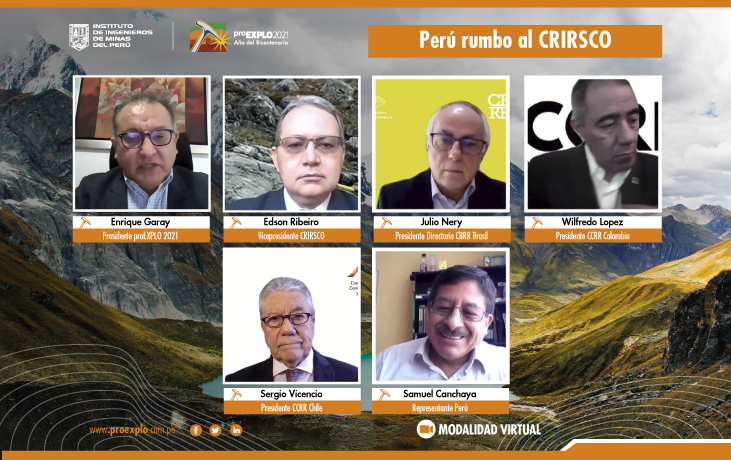
The vice-president of the International Committee for Resources and Reserves Reporting (CRIRSCO), Edison Ribeiro, expressed today his confidence that Peru could be part of this organization recognized worldwide as the entity that represents the mining industry in matters related to classification and reporting of mineral assets.
"Peru is in a unique position because the CRIRSCO representatives for the working committee are already appointed. I am confident that Peru is going to have a very fast process; but it all depends on the Peruvian representatives," stated Ribeiro.
During the Round Table: "Peru on the road to CRIRSCO" - organized by the 12th International Congress of Prospectors and Explorers (proEXPLO 2021) and moderated by the president of the congress, Eng. Enrique Garay; the executive also explained some of the benefits of the CRIRSCO system.
"It seeks to promote best practices, share experiences and create this global network of mining professionals. It also allows for a common language that is based on a standard definition. If an American investor chooses a project in Peru or another country, he/she will be able to understand reports and risks. That is the basis for cooperative transactions in mining projects," he said.
In his turn, the representative of the future National Reporting Organization (NRO) of Peru, Samuel Canchaya, explained that currently the Geological Society of Peru (SGP) and the Peruvian Institute of Mining Engineers (IIMP) are leading this initiative and that "later on, the Lima Stock Exchange (LSE), the Association of Mining Engineers and other institutions could join.
"One of the benefits for CRIRSCO of including Peru in its organization would be to have a country with great potential and a long history. It will also promote investment in exploration and mining projects; as well as facilitate the exchange of specialized knowledge between the Peruvian members and CRIRSCO members", he emphasized.
Regarding the step or stage Peru is in, Samuel Canchaya indicated that work is being done to address the entity's organization matters; and the signatures of the memorandums of understanding between the directors of the SGP and IIMP.
"The documents included in the NRO-Peru bylaws, the code of ethics, the guidelines for the preparation and publication of Technical Reports on exploration, resources and reserves; the qualification of competent and qualified people, are already more than 90% advanced", Canchaya said.
International presence
Round Table: "Peru on the road to CRIRSCO", held this Friday, March 26 at proEXPLO 2021, also included the participation and presentations of the president of the board of directors of the Brazilian Commission for Resources and Reserves (CBRR), Julio Nery; president of the Colombian Commission for Mineral Resources and Reserves, Wilfredo López; and the president of the Qualifying Commission for Competencies in Mineral Resources and Reserves of Chile, Sergio Vicencio; who shared details about their entry processes and the mining situation in their respective nations.
proEXPLO 2021: Mineral Resources for a Sustainable Future
From discovery to mine session attracts participants attention
 26th March
26th March
"From discovery to mine" session attracts participants' attention
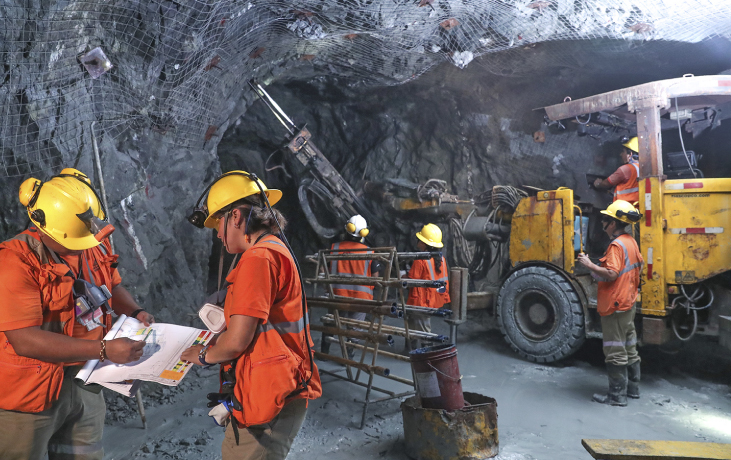
At the 12th International Congress of Prospectors and Explorers (proEXPLO 2021), a series of talks and conferences focused on the mining exploration business were grouped into three blocks.
One of the blocks was "From Discovery to Mine", which was held on Thursday 25 and Friday 26, and captured the attention of participants by providing information on methodologies and techniques that are being applied and/or studied.
The first talk was entitled "Terminology for Mineral Resources and Ore Reserves Reporting" and was given by Heller Agustín Bernabé Tapia, who detailed in his summary that one of the conclusions of the study is that mineral resources and ore reserves must always be estimated with economic, geotechnical and metallurgical parameters.
The second presentation addressed the discount ratio and the role of risk in mining decision-making. Representatives of Astay Systems, Alí Ivan Meres Vargas, Juan Manuel Mansilla Olivas and Fernando Enrique Sagastegui Ayala, pointed out in their report that they are constantly looking for ways to include the various sources of risk of a mining project in the assessment.
And the third talk, held on Thursday 25, was "Evaluation of investment projects through risks and uncertainty". According to the document, published on the congress website, Manuel Viera Flores, CEO & Managing Partner Metaproject S.A Chile and General Manager Metaproject Engineering SAC Peru, informed that this paper shows a methodology on how to economically evaluate an investment project, under scenarios of risk and uncertainty, for a correct decision-making.
"The mining industry presents a valuable challenge to project engineering and economic valuation of investments, this is to make intelligent designs with the flexibilities identified in Conceptual Engineering in order to make better and more accurate decisions. This will allow adding value to the business", wrote the also President of the Chilean Chamber of Mines in his paper.
Second day of talks
On Friday 26th, three more presentations were also given. The day began with the presentation "Role and challenges of operational geometallurgy at Cerro Corona, Cajamarca, Peru", given by Julio Castro, Anthony Julian, Edwin Ayala, Gabriel Becerra from Gold Fields, the mining company that operates this important mine.
The deposit’s geometallurgical classification is extremely important for the prediction of metallurgical performance in processing and is aimed at maximizing economic benefit. The definition of GMUs (Geo Metallurgical Units) based on lithology, alteration, structural characterization, mineralogical and metallurgical parameters allow the forecasting of recoveries, throughput, concentration of pollutants and reagents consumption. Production strategies based on geometallurgical models benefit the company by improving mining plans, maintenance plans, impurities effect mitigation and the consequent process optimization,” indicated their paper.
The next talk, given by specialists from Belgium, was entitled "Deepening an old, verticalized pit: rock slope instability hazard assessment using a "digitally augmented" structural database (Flône limestone quarry, Belgium)" and focused on the methodology and results used to assess the rock instability hazard of the Flône pit (Belgium) using a deterministic kinematic stability analysis.
The block ended with the presentation of Solange Guiuliana Ríos Angulo who analyzed the social impact assessment and analysis of socio-environmental conflicts in a mining project in southern Peru using mathematical models.
In her paper, the author stated that the objective of the article is to assess social impacts (SIA) and analyze possible socio-environmental conflicts (ECA) that could arise during the implementation of a mining project, through the use of mathematical models.
proEXPLO 2021: Mineral Resources for a Sustainable Future
PCM: Peru has a great geological potential to be explored
 26th March
26th March
PCM: Peru has a great geological potential to be explored
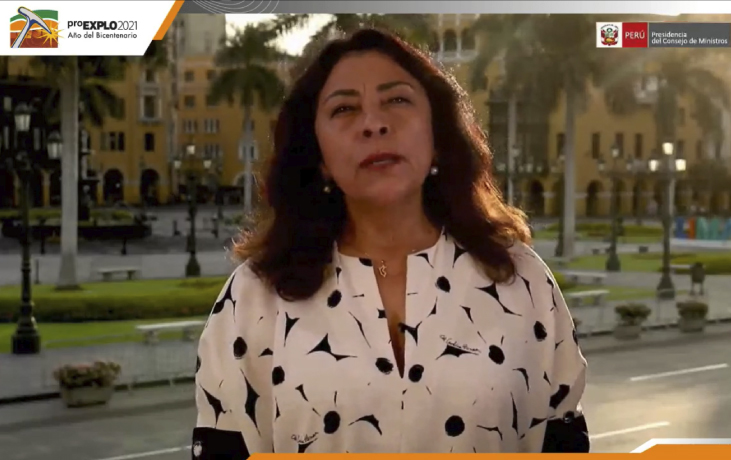
The head of the Presidency of the Council of Ministers (PCM), Violeta Bermudez, during the closing ceremony of the 12th International Congress of Prospectors and Explorers (proEXPLO 2021), emphasized Peru's mining tradition and its importance to Peruvian economy.
"Peru has a long mining tradition with a great geological potential to be explored and world-class operations. In addition, mining is one of the great engines of our economy as it represents around 60% of foreign exchange income; and in the last 10 years this activity has represented 10% of the GDP", said the head of the PCM.
She added that Peru requires investments that generate opportunities for the progress of all people and thus overcome the challenges of inequality.
Regarding proEXPLO 2021, organized by the Peruvian Institute of Mining Engineers (IIMP), Violeta Bermúdez highlighted that it has focused on strengthening the links between academia, industry and mining investors in order to reinforce the development of mining exploration in a context of responsible and environmentally sustainable investment.
A similar opinion was expressed by the vice-president of the IIMP, Miguel Cardozo Goytizolo, who in his speech emphasized the fact that in this proEXPLO, "not only has it been ratified that Peru has an enormous mining potential and is one of the main exploration destinations in the world, but also that it has great challenges ahead in order to move forward and crystallize its objectives in the short, medium and long term".
"Which is why it will be vital to promote and facilitate exploration in our country. If we do not do so, we lose knowledge, information and opportunities. Without exploration, the growth of the mining sector will not be viable and the future of the sector and the country itself will be put at risk," Dr. Cardozo emphasized.
Successful results
Enrique Garay, president of proEXPLO 2021, reported on the achievements of this edition, which was 100% virtual.
"In the five days of congress, we had the participation of 4,000 professionals, 200 students from national and foreign universities; and 330 attendees to pre and post courses from 10 countries. Also, the speakers came from North America, Latin America and other countries; and it is worth mentioning the participation of the speaker Rafael Bernaola who made his presentation from a mine", said Eng. Garay.
At the closing ceremony it was also announced that the president of the Organizing Committee of proEXPLO 2023 will be Eng. Sebastián Benavides, who currently serves as exploration manager for Peru and Ecuador at First Quantum Minerals.
"It is an honor for me to continue with the great legacy that proEXPLO has built and transformed today into the main mining exploration meeting in Latin America. Furthermore, at proEXPLO 2023, while we hope to return to an in-person setting, we will look to take lessons from this digital experience in order to maximize the reach of the conference to participants from Peru and around the world," stated Eng. Sebastian Benavides.
Picota de Plata
It is worth mentioning that this year the "Picota de Plata" Award went to Eng. Román Tejada Rospigliosi.
proEXPLO 2021: Mineral Resources for a Sustainable Future
World population growth will boost copper demand
 25th March
25th March
World population growth will boost copper demand
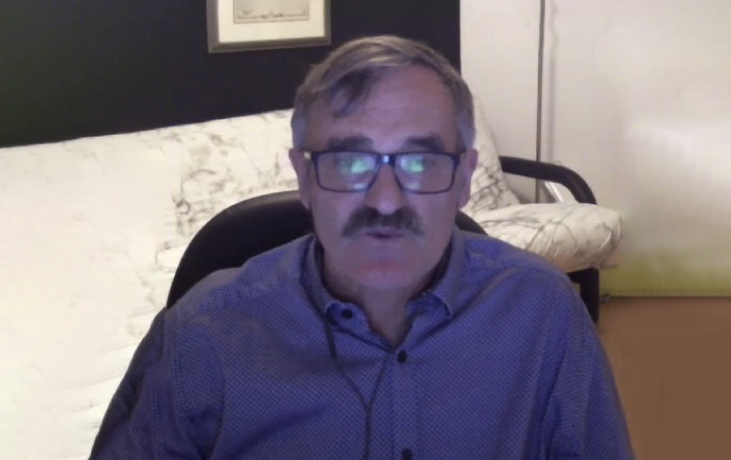
The mining industry has shown great efficiency in supplying the growing demand for copper that is associated with population growth in this century, said Michael Doggett, senior consultant at Michael Doggett & Associates, during the conference "Transforming mineral resources for a sustainable future: lessons from the first 20 years of the new millennium", on the fourth day of activities of the 12th International Congress of Prospectors and Explorers -proEXPLO 2021.
According to Doggett, while population growth in the 2001-2020 period averaged 1.19% per year, copper production in that period grew at an average annual rate of 2.14%. This scenario will continue in the 2020-2040 period, with an average annual population growth of 0.82% compared to 1.48% in the case of copper production.
This situation represents a challenge for the mining industry and coincides with the analyses being made by other analysts and consulting firms regarding the great demand for the red metal that will have to be met in the coming decades. Doggett was optimistic about the industry's performance, as it has been successful in turning mineral resources into reserves.
Another detail to consider is the direct relationship between copper price and copper exploration mentioned by Doggett, which may indicate exploration budget increases in the current situation of red metal prices around US$4/lb.
The specialist was also confident that the industry needs to adapt to the changes occurring in the world that demand new methods for ore processing, particularly if we take into account that the ore grades of new deposits are lower than those that existed two decades ago.
The panelists who also participated in this special edition of Jueves Minero, organized by the Peruvian Institute of Mining Engineers (IIMP), agreed with the analysis made by Doggett regarding the future of mining; although they warned about the particularities of Peruvian mining.
Silvia Rosas, professor at the Pontificia Universidad Católica del Perú and former president of proEXPLO 2019, stated that Peruvian mining companies must bet on a circular economy; while the State must also address the old environmental liabilities generated by old technologies.
Alberto Arispe, General Manager at Kallpa SAB, posed the scenario where there may be substitutes for a product whose price increases significantly. "I believe in the market and of course when prices rise significantly, substitutes will be found, but I don't think nickel can reach US$ 100,000 per ton," responded Doggett.
Ángel Mondragón, member of the organizing committee of proEXPLO 2021, said that it was clear that in recent years the mines that have entered feasibility and construction have lower grades. In fact, Doggett pointed out that of the 10 large projects mentioned, only three are projects that have grades above 1% copper content; while the other six have grades between 0.4% and 0.6%.
proEXPLO 2021: Mineral Resources for a Sustainable Future
Ingemmet talks on Peru's mining potential
 25th March
25th March
Ingemmet talks on Peru's mining potential
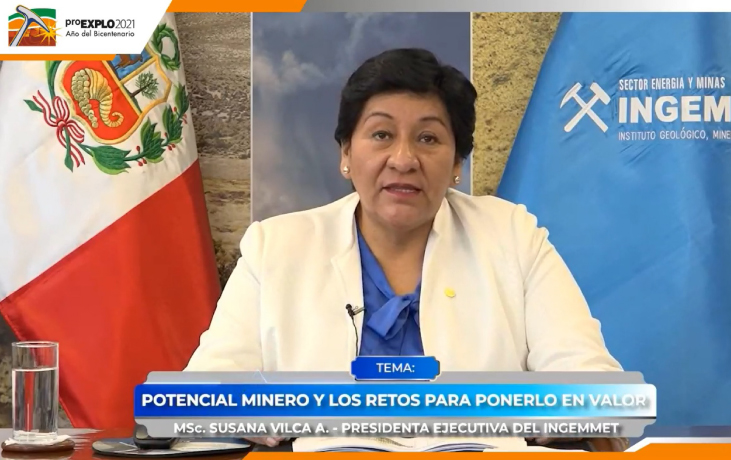
This Thursday, March 25, at the 12th International Congress of Prospectors and Explorers - proEXPLO 2021, Ingemmet's Executive President, MSc. Susana Vilca Achata, presented the paper "Mining Potential and Challenges to Enhance its Value".
During her presentation, the head of Ingemmet pointed out that of the 26 Areas of No Admission of Petitions (ANAP's), 6 currently have high geological mining potential corresponding to porphyry, porphyry-skarn, high sulfidation epithermal and VMS mineral deposits.
She also pointed out that 14.4% of the national territory is under concession and that of this total, only 1.23% is in mining activity, a value consisting of 1.01% in exploitation activity and 0.22% in exploration.
“More exploration is required in order to reach the exploitation stage. Moreover, nowadays it is not possible to value the mining potential if we do not have high quality and accurate databases", she stated.
Likewise, she highlighted that two decades ago, gold, copper, molybdenum, silver, lead and zinc mining projects located in the Western Cordillera were valued; and that nowadays concessions are being granted to add value to the deposits related to critical minerals (lithium, zinc, tin and rare earth elements) and are tending towards the sub-Andean and Eastern Cordillera.
More presentations
Ingemmet representatives were also present in the Main Hall. The first talk was on "GEOCATMIN Geodatabase and Mining Cadastre Management System", which was given by MSc. Juan Salcedo from the Information Systems Office.
It should be noted that GEOCATMIN (acronym for Geological and Mining Cadastre Information System) is a digital platform of Ingemmet that has more than 200 layers of information.
The second presentation entitled "Promoting agile technological transformation in the mining cadastre and mining concession granting process" was given by the head of the Mining Cadastre and Pre-Cadastre Unit, Engineer Eloy Cesar Salazar Loayza.
Rildo Rodriguez, Director of Regional Geology at Ingemmet, gave a presentation on "Machine Learning of the 50K National Geological Map and Mining Exploration"; and this block ended with the participation of Ingemmet researcher Luis Quispe Renteria, who gave a talk on "Interpretation of Magnetotelluric Data from the Southern Peruvian Transect and its Relation to Metallogeny”.
proEXPLO 2021: Mineral Resources for a Sustainable Future
Women's participation in the Peruvian mining labor market is 6.7%
 25th March
25th March
Women's participation in the Peruvian mining labor market is 6.7%
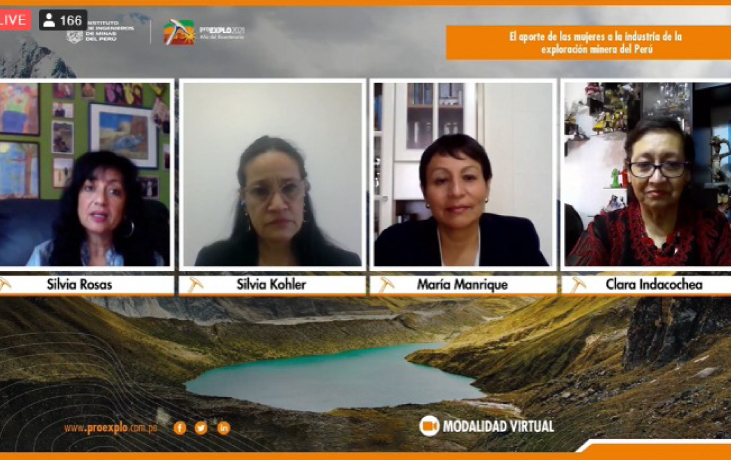
On the fourth day of the 12th International Congress of Prospectors and Explorers - proEXPLO 2021 - the Round Table "Contribution of women to the Peruvian mining exploration industry" was held, with the participation of experienced geological engineers Silvia Kohler, Clara Indacochea and María Manrique.
During her presentation, Silvia Kohler, member of the steering committee of the Geological Society of Peru, indicated that the participation of women in the mining labor market is 6.7%, placing it after Colombia and Chile, where the participation is 8.8% and 8.4%, respectively.
The ranking is led by Canada (17.9%), Australia (16.6%), Brazil (13%), Mexico (11%) and Ecuador (10%). Peru is only ahead of Argentina, which has a share of 6.5%.
Kohler also indicated that, according to statistical information from the Ministry of Energy and Mines (Minem), a greater participation of women is observed in artisanal mining production; followed by small mining and the general sector.
"The importance of women in geology can be seen among female students. Female students entering the Geological Engineering career in the 2009-2019 period at Universidad Nacional Mayor de San Marcos represented 22%; while in the case of Universidad Nacional de Ingeniería, 10%", she commented.
Clara Indacochea, a geological engineer from Universidad Nacional San Agustín de Arequipa, highlighted that the new gender inclusive model in mining generates added value to intangible capital, facilitating access to financing; it reduces personnel turnover and increases motivation, among other positive impacts.
"It is great that the company is willing to commit to gender inclusion policies and pay equity, but we need it to be an active player," said Indacochea.
"To achieve equal opportunities with the training of men and women to fulfill multiple roles without gender exclusivity," said María Manrique, geological engineer and member of Ingemmet's geochemistry staff.
Conclusions
The Round Table "Contribution of women to the Peruvian mining exploration industry" concluded that companies are required to commit to the application of their gender policies to promote the active participation of women professionals in technical, administrative, managerial and CEO positions.
It is also expected that companies take the necessary measures to implement gender equity practices and salary retribution; as it has been demonstrated that inclusive and diverse work teams are more creative, innovative, profitable, less conflictive and have higher performance.
"Peru is on the road to CRISCO. This forces us to be more competitive and encourages many women who have experience in exploration, database management or modeling to become more competitive and be able to sign resources and reserves at a global level," said Silvia Kohler.
proEXPLO 2021: Mineral Resources for a Sustainable Future
Round Table: Peru on the Road to CRIRSCO to be held tomorrow
 25th March
25th March
Round Table: "Peru on the Road to CRIRSCO" to be held tomorrow
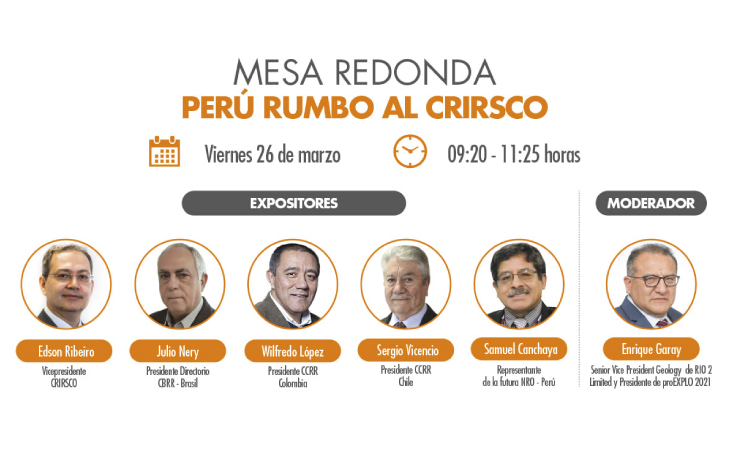
The International Committee for Resources & Reserves Reporting (CRIRSCO) is a globally recognized body, endorsed by the International Council on Mining and Metals (ICMM) as the entity that represents the mining industry in matters related to the classification and reporting of mineral assets.
In this sense, the organizers of the 12th International Congress of Prospectors and Explorers - proEXPLO 2021 revealed that the key to achieving one of the mining industry's main goals is for Peru to be part of CRIRSCO and thus encourage national professionals to certify mineral resources and reserves.
For this reason, the Round Table "Peru on the road to CRIRSCO" will be held this Friday 26th at 9:20 am. In order for a wider audience to learn more about this important topic, this meeting will be broadcast on the official Facebook and YouTube channel of the Peruvian Institute of Mining Engineers (IIMP).
Participants in the Round Table
This conference will be attended by the vice-president of CRIRSCO, Edison Ribeiro; the chairman of the board of the Brazilian Commission for Resources and Reserves (CBRR), Julio Nery; and the president of the Colombian Commission for Resources and Reserves, Wilfredo López.
Also participating will be the president of the Chilean Commission for Resources and Reserves, Sergio Vicencio; representing Peru will be Samuel Canchaya; and the moderator will be the president of proEXPLO 2021, Eng. Enrique Garay.
"Peru is on the road to CRISCO. This forces us to be more competitive and encourages many women who have experience in exploration, database management or modeling to become more competitive and be able to sign resources and reserves at a global level," said Silvia Kohler, member of the steering committee of the Geological Society of Peru and participant of the Round Table "Contribution of Women to the Peruvian Mining Exploration Industry" in proEXPLO 2021.
proEXPLO 2021: Mineral Resources for a Sustainable Future
Progress in exploration projects continue to be presented at proEXPLO 2021
 24th March
24th March
Progress in exploration projects continue to be presented at proEXPLO 2021
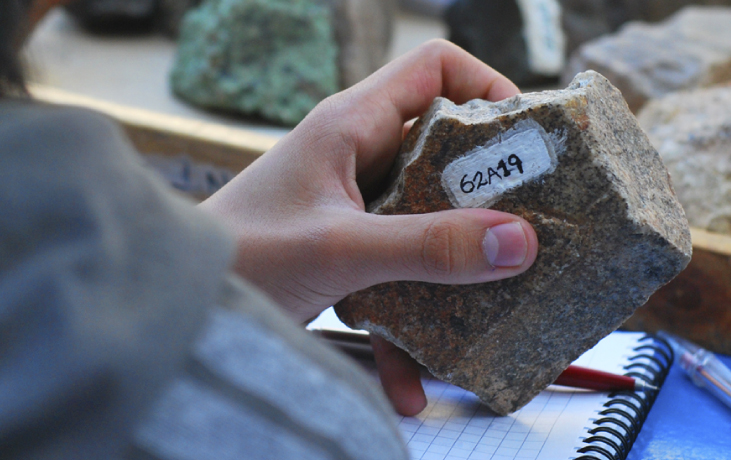
Mining finance specialist, José Luis Martínez, recommended using option contracts to access the financing required by mining exploration project owners at an early stage to continue developing the works that make it possible to determine the mining potential and consequently its value.
On the third day of proEXPLO 2021, attendees had the opportunity to learn more about the progress of a number of exploration projects at the "Economic Geology" conference. Thus, this block started with the presentation entitled "Exploration History and Geology of the Cu-Mo-Au porphyry deposit of Cobre Panama".
According to the presentation, "Cobre Panama" is currently an operating mine with proven and probable reserves of 3,143.7 Mt @ 0.38% Cu, 59 ppm Mo, 0.07 g/t Au, 1.37 g/t Ag; for a total of approximately 12 Mt of Cu content and 7.1 Moz Au.
The second presentation was on the Fénix Gold project, located in the Atacama region of Chile and owned by Rio2 Limited, followed by the talk "Copa de Cobre challenge: Machine Learning for predictive mapping from satellite imagery”.
The fourth presentation entitled “A common hydrothermal magmatic system generates different styles of gold mineralization at Algamarca and Shahuindo, Northern Peru”, allowed to learn more about a same hydrothermal magmatic system that generated different styles of gold mineralization at Algamarca and Shahuindo (in northern Peru), which are contiguous Miocene intermediate sulfidation gold and silver deposits located in the Marañón fold and thrust belt in northern Peru; In addition, they are hosted in the organic-rich sedimentary sequences of the Goyllarisquizga group.
Later, proEXPLO's participants had the opportunity to learn more about "Cerro Corona: Evolution of geological models, geophysical vectoring and their implications for increasing Cu and Au mineral resources beyond 2030”.
According to the summary presented by the speakers, Cerro Corona is a porphyry-type copper (Cu) deposit rich in gold (Au), and where only 500 meters of the porphyry system has been mined and explored, still having a high exploratory and mining potential, which is open.
Similarly, it was indicated that the re-interpretation and unconventional vectoring of the 3D geological models together with modern deep IP and Magneto-telluric (MT) studies, helped to define 8 drilling targets.
This block ended with the presentation “The San Francisco Gold-Silver-Copper Project, San Juan, Argentina – an example of a gold-rich intrusion-related tourmaline breccia system”.
Thus, according to the information provided by the speakers, a set of tourmaline breccia pipes related to intrusive rocks has been identified by exploration at San Francisco, whose drill results yielded gold grades among the highest reported for this style of deposit (e.g., 37 m @ 6.3 g/t Au, 122 g/t Ag and 0.9% Cu).
proEXPLO 2021: Mineral Resources for a Sustainable Future
Jon Hronsky and the integrated model for copper and gold mineralization
 24th March
24th March
Jon Hronsky and the integrated model for copper and gold mineralization
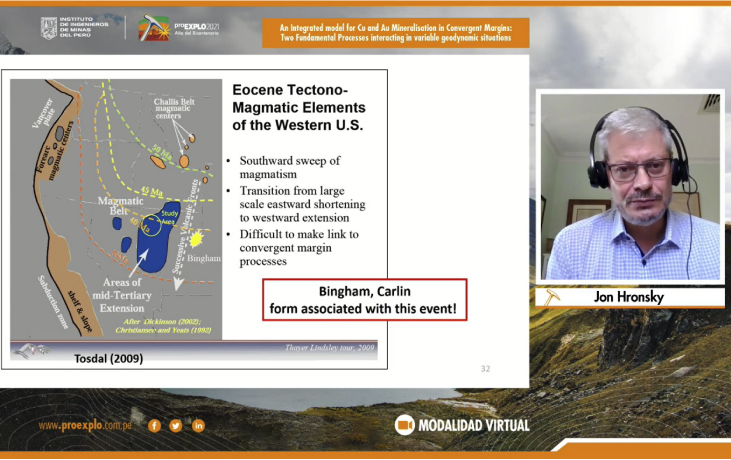
On the third day of proEXPLO 2021, this keynote speech was given by Dr. Jon Hronsky, who is currently Director of Western Mining Services (WMS), a consulting group that provides strategic level services to a wide variety of groups (from junior to major) throughout the global mineral exploration industry.
In his presentation "An integrated model for Cu and Au mineralization at convergent margins: two fundamental processes interacting in variable geodynamic situations", the specialist commented on the Loucks process and the FUME process, which stands for Fertile Upper Mantle Extraction.
Thus, according to Jon Hronsky, convergent margin orogens, such as the Andes, show a complex range of copper (Cu) and gold (Au) ore types; and while there are often clear links between Cu and Au metallogeny, there are also scenarios where these deposits occur separately.
"Recent advances indicate that two fundamental processes act to form ore deposits at convergent margins. These are the Loucks process, which is related to anomalous high-pressure fractionation of hydrated magmatic arcs that generates Cu metallogeny, and the FUME (Fertile Upper Mantle Extraction) process that generates Au metallogeny," he commented.
He added that both processes occur in response to anomalous geodynamic conditions on a regional scale. In some cases, these conditions favor only one of the two processes, while in other cases, both processes are favored simultaneously.
proEXPLO 2021: Mineral Resources for a Sustainable Future
Interview | Carlos Salazar Oré, Geology and Exploration Manager of Hudbay Peru
 24th March
24th March
"The more greenfield projects are drilled, the greater the chance of new discoveries”
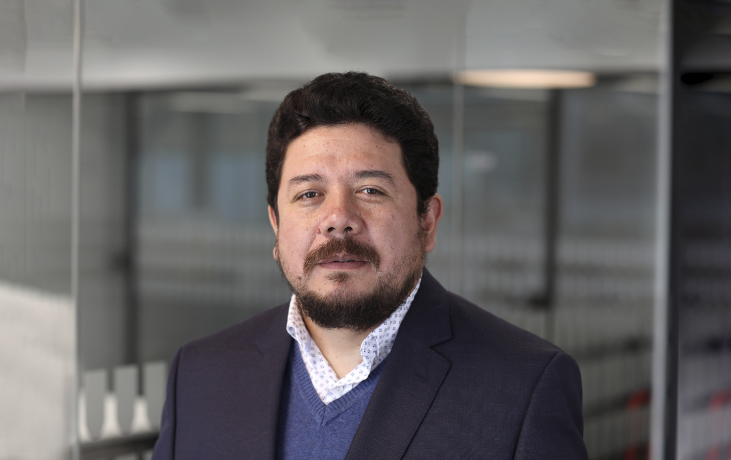
Carlos Salazar Oré, Geology and Exploration Manager of Hudbay Peru, also shared some of the mining company's plans and the work being carried out in the context of the pandemic.
What are your expectations for this 12th International Congress of Prospectors and Explorers (proEXPLO 2021)?
For Pan American Silver, proEXPLO 2021 is an opportunity to reaffirm our commitment to responsible mining and to work together with the private sector, academia, investors and other social actors on the innovation that redefines the mining of the future towards sustainability.
What are your expectations for this 12th International Congress of Prospectors and Explorers (proEXPLO 2021)?
proEXPLO is one of the most expected and important events in the calendar of scientific events related to exploration. The program is very interesting, the use of new technological tools as part of the innovation in mining exploration and the presentation of new discoveries and projects developed mainly by junior companies, shows that the exploration activity is being reactivated in spite of the difficult situation we are going through.
What aspects can facilitate mining exploration?
The excessive amount of paperwork to carry out initial explorations and the time it takes in our country compared to others with which we are competing, has led to a decrease in explorations, especially in greenfield projects.
We have to improve in this aspect and this does not mean that we should be less rigorous in environmental and social issues, but we should clearly measure the impacts generated at each stage of exploration projects, the more greenfield projects are drilled, the more possibilities there will be to have new discoveries.
Experts point out that we are facing a great demand for minerals around the world. Is Peru doing what is necessary to meet the new scenario in the global ore market?
We believe so. Currently, a lot of work is being put into boosting the sector to take advantage of the wave. We know that the idea is for the country to reach a production of 3 million fine metric tons of copper per year by 2025, which will be achieved with the execution of important projects such as Mina Justa, Quellaveco or Toromocho.
We must "surf" this wave, taking advantage of the fact that we are an attractive country for mining investment thanks to our huge reserves of copper, gold, silver, zinc, among other minerals.
Why is prospecting and exploration important in mining?
Prospecting is the initial stage in the mining value chain and that is why it is so important. It is where the first occurrences of minerals are identified, which leads us to continue with different studies for the identification of targets in which more detailed exploration work will be carried out, which are also important because through them we will better define the system, determine the geometry and size of the deposit and estimate the resources contained.
What are Hudbay's growth plans?
One of our main objectives is to continue growing as a company in Peru. That is why we have been consolidating a portfolio of properties in areas with high prospective and emerging exploration potential.
An important achievement in brownfield projects has been the consolidation of a significant group of properties around our Constancia mine which have high exploration potential.
Regarding greenfield exploration, we have completed 3G studies (Geology, Geochemistry, Geophysics) in several of our prospects and we are working on the preparation of studies to obtain drilling permits; and in others, we are in the initial activities for drilling, one of them is Llaguén, located in northern Peru, which is in an early stage of exploration.
What technologies are being or will be applied by Hudbay for its prospecting and exploration activities?
At Hudbay we are working on the integration of all our information and using the latest technological developments for its better understanding; the use of machine learning in various applications is giving us important results in the prediction and identification of new exploration targets in both our brownfield and greenfield explorations.
What has been Hudbay's plan for COVID-19 both in its operations and with its communities?
The plan is to prioritize the health and safety of both our workers and communities. We implement a strict protocol to avoid any contagion in the operation. Our personnel undergo clearance tests and a quarantine period when entering and leaving the mine, maintaining the health bubble.
Our protocols have been recognized with the Safeguard seal awarded by Bureau Veritas, which guarantees the safety of the operation.
Externally, we have made significant investments to mitigate the impacts of the pandemic on the population. We have donated sanitary equipment, biosafety tools, etc. In addition, we managed projects to boost the local economy and financed pre-investment studies and projects to strengthen local healthcare centers.
We want to help Chumbivilcas overcome these ravages from the pandemic in the shortest possible time.
proEXPLO 2021: Mineral Resources for a Sustainable Future
Option contracts, a financing alternative for initial exploration projects
 24th March
24th March
Option contracts, a financing alternative for initial exploration projects
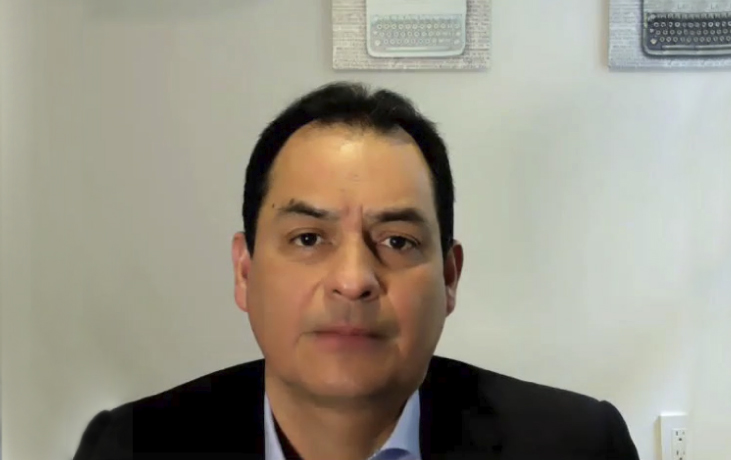
Mining finance specialist, José Luis Martínez, recommended using option contracts to access the financing required by mining exploration project owners at an early stage to continue developing the works that make it possible to determine the mining potential and consequently its value.
In the conference entitled "Structuring and financing of exploration companies" that he gave on the third day of sessions of the 12th International Congress of Prospectors and Explorers - proEXPLO 2021, Martinez focused his attention on exploration projects of non-consolidated companies, because consolidated or large companies have access to the capital market.
Financing for an exploration project has a different scenario than when the project is already under development or construction. In that sense, it is relevant to ask oneself at what stage of the cycle we are in and from there evaluate how to position for the future.
Martinez said that in the discovery stage and preliminary works it is very difficult to determine the project's value and therefore it is also difficult to attract the attention of mining companies, classic sources or other sources. Here what can make the difference is the technical team available and to keep in mind that the value is created along the way.
He also warned that at this stage, what any financing does is dilute the ownership of the project, partly because there is not much value at the initial stage. If the property or project is visible with the few results it has, the owner will be solicited; although this is not the common denominator.
On the other hand, he warned about the work of financial advisors who offer to obtain financing. "There is always someone who comes and says I will find financing for you," said Martínez, and in this regard, he recommended to take into account the background of such advisors. He did not rule out that for projects with progress, law firms can provide access to financing.
He also recommended to have the information organized, taking into account how the already consolidated companies present their information. He stated that a well-structured option contract is a mechanism that protects property and can facilitate project financing based on the progress made.
proEXPLO 2021: Mineral Resources for a Sustainable Future
Opportunities to fulfill dreams and goals
 22th March
22th March
"Opportunities to fulfill dreams and goals"
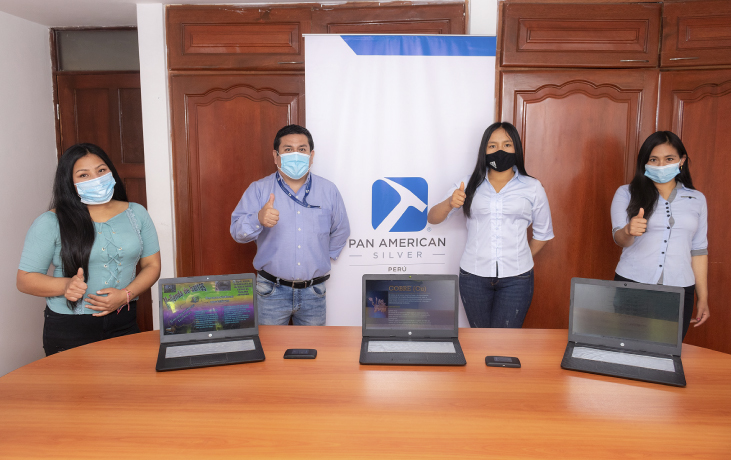
Studying a professional career or working in a job that for a long time was thought to be only for men, have not been obstacles, nor have they limited the aspirations of young women who participate in the Talento Mujer Minera training program financed by Pan American Silver in alliance with the Cetemin Institute.
There are 35 integral scholarships for talented women from the area of social influence of mining units La Arena (La Libertad) and Shahuindo (Cajamarca), in six specialties: Geology and explorations, Mining exploitation, Metallurgical and chemical processes, Risk prevention and safety, Heavy equipment maintenance and Environment.
Pan American Silver Peru offers this opportunity so that more women can develop both academically and professionally, and thus contribute to the reduction of gender gaps in the mining sector.
Magaly Rodríguez, program participant (Caserío La Arena - Huamachuco - La Libertad) says: "We have to seize the opportunity that the company gives us and thus be able to fulfill our objectives, dreams and goals. When I finish my studies, I would like to work in a public or private institution where I can apply all my knowledge".
Making women participants in the development of their communities and the country starts by encouraging and supporting them to fulfill their goals and dreams, forming empowered women and leaders for building an egalitarian future. "I am happy to belong to this program, it is a great opportunity for me to grow as a woman and develop professionally. I believe that we must be able to overcome our fears, we must have good self-esteem and love ourselves as we are, and show that we are capable," said Carmelita Polo, a student of Metallurgical and Chemical Processes (Caserío Liclipampa - Cachachi - Cajamarca).
At Pan American Silver Peru, we remain firmly committed to the well-being of our neighbors, promoting equal treatment for women, valuing their capacity as students, professionals, authorities, mothers, or any other role they play in their community, in order to build a sustainable future.
proEXPLO 2021: Mineral Resources for a Sustainable Future
Junior Mining Companies May Access Venture Capital in Peru
 23rd March
23rd March
Junior mining companies may access venture capital in Peru
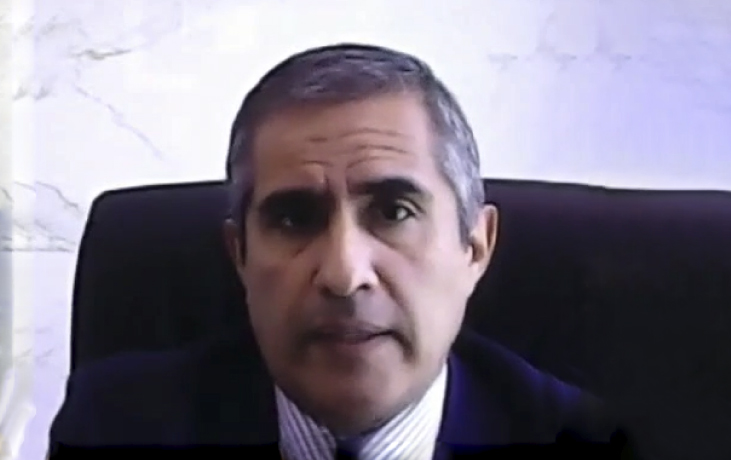
The General Manager of Kallpa SAB, Alberto Arispe, commented that nine junior mining companies list their shares on the Lima Stock Exchange (LSE) with a market value of US$ 365 million, a fact that differentiates the Peruvian stock exchange from its peers in other countries in the region.
He pointed out that these are companies that have "raised" resources or venture capital in Peru, while explaining that the LSE stands out for being a stock market with more weight for the mining sector, as opposed to other stock markets in the Latin American region.
"40% of the Peruvian stock market is made up of mining shares and if we compare with Brazil, the mining sector only represents 15% there; while Chile, a mining country, has a 0% representation (of mining shares), the same happens with Colombia", explained Arispe.
During his presentation "How to finance a Peruvian mining project on the Lima Stock Exchange", the Kallpa SAB executive also mentioned that venture capital investors have a tax benefit.
"Investors have a tax benefit that when they sell their shares in the LSE they must pay a tax equivalent to 5% of the profit, and if those shares are sold in other markets, they could pay a tax of 30% of the profit," said the financial expert.
On the other hand, he highlighted the success story of junior mining company Rio Alto Mining, which went from having a market value of US$30 million to becoming a producing company with a market value of US$1 billion. This occurred after acquiring control of La Arena project (in La Libertad region) and buying the option from IAM Gold between 2009 and 2011.
Rio Alto Mining's development dynamics led to the acquisition of Sulliden Gold and its Shauindo project (in the Cajamarca region) in 2014; although later in 2015 the company was purchased by Tahoe Resources.
proEXPLO 2021: Mineral Resources for a Sustainable Future
Thierry Sempere and his vision of Peru's mining geology
 23rd March
23rd March
Thierry Sempere and his vision of Peru's mining geology
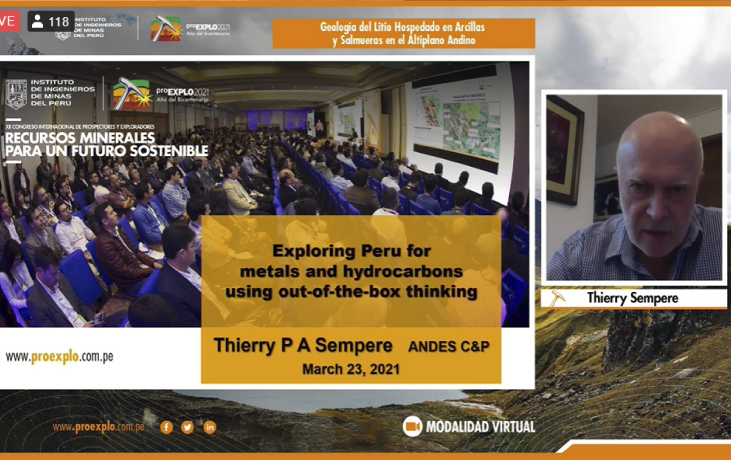
On the second day of the 12th International Congress of Prospectors and Explorers -proEXPLO 2021- Thierry Sempere gave a talk on "Exploring Peru for metals and hydrocarbons using innovative thinking".
"In fact, the Andes are far from being homogeneous, either longitudinally or transversally. In my opinion, one should not try to generalize all Andes because it is always better to avoid comparing apples and oranges. This marked lateral topographic variation reflects that the processes - I insist on the plural - that resulted in the construction of the Andes have also varied longitudinally - and probably transversely as well. We should always remember that," he said.
He also commented that the main problematic paradigm is the widespread belief that the Andes result only from tectonic shortening imposed by the subduction of the Nazca plate. "This belief is now so ingrained by tradition that it has become dogma," he questioned.
In another part of his presentation, Thierry Sempere indicated that there are two types of geologists, academic geologists and economic geologists. "Dogmatists outnumber creative ones. What academics really care about is dogma. On the other hand, creative people know that dogmas stop progress. And we know that innovation sometimes brings discomfort," he said.
Sempere also disagreed with those who seek to write papers without adequate validation of the data. He also expressed the risk of falling into the trap of arranging the data to justify conclusions that have already been reached. In this sense, he expressed his concern that the so-called "post-truth" may also affect information and research in geology.
proEXPLO 2021: Mineral Resources for a Sustainable Future
There is an interesting dynamism in the actions of junior mining companies
 23rd March
23rd March
There is an interesting dynamism in the actions of junior mining companies
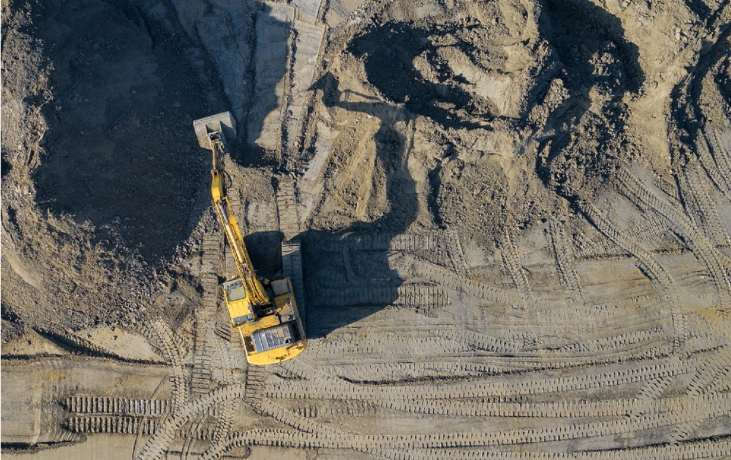
The 12th International Congress of Prospectors and Explorers - proEXPLO 2021 - was the setting to learn more about mining exploration activities.
On the second day of the congress, the junior mining companies’ session took place and was moderated by Andrés Recalde and Sebastián Benavides, both members of the Organizing Committee of proEXPLO 2021.
The first company was Regulus Resources, which gave news about its Antakori project, located in Cajamarca.
"Antakori has good levels of high grade on surface. We have high expectations and expect to be able to update our results by the end of this year," said the mining company's CEO, John Black.
Patrick Elliott, president and CEO of Forte Copper Corp. said that the permits for its Esperanza, Pucarini and Don Gregorio projects are being processed and that the goal is to work to achieve their maximum value.
Element 29 Resources was the third junior to participate in this block and informed that they are working in 2 key projects in the national territory: Flor de Cobre (which is located in the copper belt area of southern Peru) and Elida (located in the same strip as the Antamina mine).
"At Flor de Cobre, two areas have been identified, Candelaria and Atravezado; and at Elida we have already identified the first project target. Also, we are now working on the permits for the 2 projects. Once we have them, we will move on to drilling and then engineering," said Brian Booth, President, CEO and Director of Element 29 Resources.
For his part, Bear Creek Mining Corporation CEO, Eric Caba, explained that Corani (in Puno) has the required permits for construction, in addition to having the support of communities in the area of influence.
"Corani is a silver-lead-zinc deposit and in terms of profit per metal and with current prices, silver comes to be almost 60% and the rest is divided between lead and zinc," Eric Caba pointed out.
Another project of interest to the market is Soledad owned by Chakana Copper and according to its president and CEO, David Kelley, since August there have been several breccia discoveries at Soledad that are quite mineralized; furthermore, the mineralogy at Soledad is predominantly copper and they have also seen a late gold event.
On the other hand, the block closed with a presentation by the CEO of Candente Copper Corp, Joanne Freeze, who explained that 3 porphyries have been identified at Cañariaco. The first one is Cañariaco Norte, which has a positive pre-feasibility; and the other two porphyries are Cañariaco Sur and Quebrada Verde, which would present interesting exploration potential.
"For this year, we hope to have the Preliminary Economic Assessment in Cañariaco Norte, which will allow us to have new numbers for the cash flow and we hope that by the end of the year we will be drilling in Cañariaco Sur and Quebrada Verde," said Joanne Freeze.
proEXPLO 2021: Mineral Resources for a Sustainable Future
Interview | Marco Balcázar, Director of Social and Corporate Affairs at Pan American Silver
 23rd March
23rd March
"Prospecting and exploration are vital steps to find ore bodies"
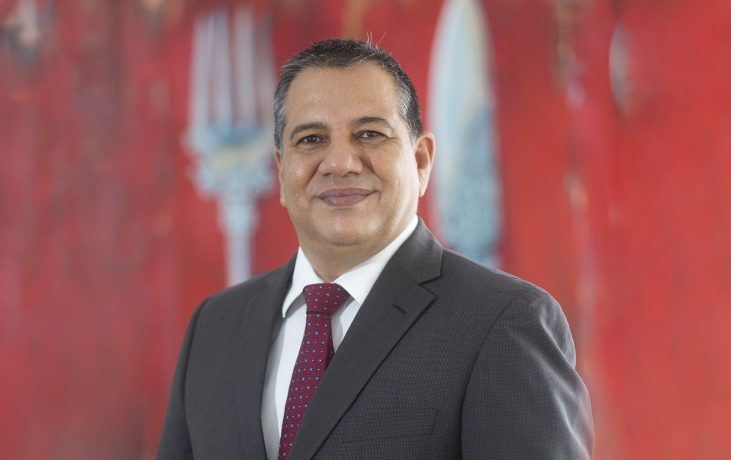
This was stated by Marco Balcázar, Director of Social and Corporate Affairs at Pan American Silver, who also shared the prevention measures they have been taking in the face of the pandemic.
What are your expectations for this 12th International Congress of Prospectors and Explorers (proEXPLO 2021)?
For Pan American Silver, proEXPLO 2021 is an opportunity to reaffirm our commitment to responsible mining and to work together with the private sector, academia, investors and other social actors on the innovation that redefines the mining of the future towards sustainability.
Undoubtedly, this event will be a great opportunity to share with other specialized fronts one of our main convictions: to achieve a clean production that generates value.
Why is prospecting and exploration important in mining?
Peru is historically a mining country. However, without exploration there is no mining. And it is specifically these exploration investment figures that have shown a significant decrease in our country.
Under this scenario, it is necessary to understand that prospecting and exploration are vital stages to find ore bodies that ensure the industry's sustainability. In addition, they contribute to strengthening the link between the State, private companies and the population.
What investments does Pan American Silver have planned for 2021-2022?
In Peru, an investment of US$ 12 million has been considered for 2021, and a similar amount will be invested in 2022.
What technologies are being or will be applied by Pan American Silver for its prospecting and exploration activities?
The technology we are using for exploration is basically geophysics.
How would you describe Peruvian geology?
Peruvian geology is committed to the development of the country and the world. It is one of the professions that has a long-term vision focused on sustainability.
Not only does it map the mineral wealth in different parts of our country, identifying minerals that are necessary for the world's industries to continue their production, but it also has a growing commitment to the environment and safety for future generations.
It is these spaces for dialogue and involvement between companies in the industry and specialists of the mining sector that make it possible for Peruvian geology to continue to position itself as a world reference in mining.
Geological sciences have once again proven to be a fundamental pillar in times of crisis, as the one we are currently going through; sustaining mineral exploration and production industries, so important in this economic reactivation.
How would you describe Peruvian geology professionals?
Peruvian geology professionals have a deep-rooted commitment to development and sustainability. Undoubtedly, they are prepared to deal with the versatility of the industries that govern their profession and that allow them to supply industrial, economic and social growth.
It is important to emphasize that the contribution of this profession must have an even deeper interpretation, since the involvement of these professionals is also linked to urban and territorial planning, as well as risk management and infrastructure projections.
Analytical capacity, versatility and creativity are just some of the characteristics that complement the profile of these Peruvian professionals, who have had the opportunity to be academically trained in one of the most challenging scenarios in geological terms.
What has been the main impact of the COVID-19 pandemic on Pan American Silver's performance?
Adaptability and innovation have been the main pillars to ensure compliance with the organization's objectives without neglecting the commitment to the safety and well-being of workers and neighboring communities.
The implementation of control measures within the camps, medical follow-up, telephone triage, rapid and molecular tests, as well as the creation of work cells within the organization in order to safeguard the health of workers and achieve the sustainability of operations.
In terms of safety, rigorous protocols have been applied in each of the operations in the central and northern regions of the country.
We have had more complex fronts. For example, at the social level, where the relationship with our areas of influence has migrated to non-face-to-face spaces to safeguard the health of our neighbors and collaborators. However, the trust co-created up to this point has allowed this transition to be quite organic and has acceptance among all those involved, therefore, it is necessary to continue implementing and educating with all the preventive measures to minimize the contagion of our workers and neighboring populations.
proEXPLO 2021: Mineral Resources for a Sustainable Future
Junior mining companies share their plans at proEXPLO 2021
 20th March
20th March
Junior mining companies share their plans at proEXPLO 2021
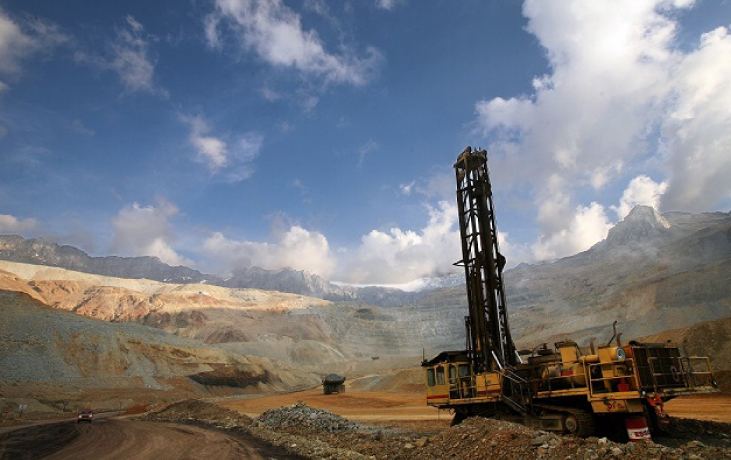
The first day of the 12th International Congress of Prospectors and Explorers -proEXPLO 2021- provided an opportunity to learn about the real situation of major exploration projects in both Peru and Chile, as well as to learn about some of their plans for this year.
Thus, in the Junior Mining Companies session, the President and CEO of Rio2 Limited, Alex Black, informed that the Fénix Gold project (located in Chile) is 100% gold oxide and contains 5 million ounces of gold as resources and 1.8 million ounces of gold in reserve.
On the other hand, the CEO of Kuya Silver, David Stein, explained that in Bethania (Huancavelica) exploration and development will be carried out at the same time. He also indicated that National Instrument 43-101 would be ready by the middle of this year, and that they are completing the detailed engineering.
For his part, Graham Carman, CEO of Tinka Resources, shared that the Ayawilca project (located in Pasco) is one of the largest undeveloped zinc deposits in the world and in Peru; and that "the company maintains good relations with the communities and works to build long-term relationships".
Lars Dahlenborg, President of Hannan Metals, listed the work being carried out at their San Martin and Previsto projects. "This will be a year of discovery and we have around US$ 2 million budget for this year", he said.
Another company that provided relevant data was Panoro Minerals. Its Vice President of Exploration, Luis Vela, stated that the company has 9 projects located in the southern Peruvian cluster and that they are open to receive new strategic partners.
He added that Panoro Minerals has 13 agreements with communities, environmental permits (including FTA, DIA, CIRAS and 2 EIAs) that would represent investments of US$ 58 million.
The block closed with a presentation by Pucara Gold CEO and director, Steve Zuker, who stressed that the company is totally focused on Peru.
"Peru is still the best place in Latin America to explore. Currently, we have 9 projects in the pipeline that have been established in Peru," said Steve Zuker.
proEXPLO 2021: Mineral Resources for a Sustainable Future
Minister of Energy and Mines affirms exploration is the foundation of everything
 22th March
22th March
Minister of Energy and Mines affirms exploration is the foundation of everything
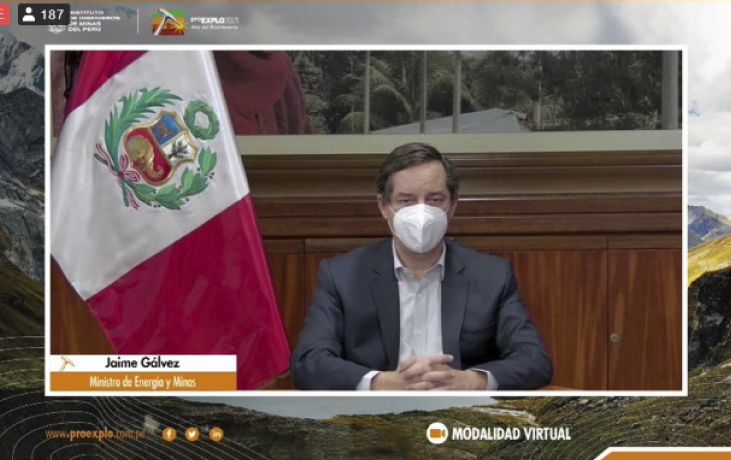
The 2021 mining exploration project portfolio includes 60 projects with an aggregate investment amount of US$ 506 million.
The head of the Ministry of Energy and Mines (Minem), Jaime Gálvez, participated in the opening ceremony of the 12th International Congress of Prospectors and Explorers - proEXPLO 2021.
"The mining sector is strategic for the country and exploration is the beginning of all," said the minister.
He also highlighted that our country is attractive for mining exploration due to its recognized geological potential; it also has legal stability and offers competitive energy prices, among other positive factors.
In this sense, Jaime Gálvez urged the next government to pay more attention to mining exploration and work towards recovering its fourth place in the market.
"For this year, investments in mining exploration could reach US$ 300 million and by 2022 reach US$ 360 million. In addition, our current portfolio is based on 60 new projects that represent an investment of US$ 506 million," he explained.
More efforts in the sector
At the opening ceremony of proEXPLO, the Minister of Minem also indicated that in May of this year the "Regional Multi-Stakeholder Dialogues" program is expected to be launched in Cajamarca.
"We have already started in Moquegua and we hope to bring these dialogues to Cajamarca in May," he revealed.
Similarly, Jaime Gálvez commented that although the mining formalization program has had advances and also stagnated, the current administration is working on measures to boost small and artisanal mining; to accompany them in the formalities; to be able to trace gold and to ensure that working conditions are respected.
On the other hand, he stated that his administration has focused on strengthening the Geological, Mining and Metallurgical Institute (Ingemmet). "With the support of the United States cooperation regarding research on lithium and rare earths in the country", pointed out Jaime Gálvez.
proEXPLO 2021: Mineral Resources for a Sustainable Future
proEXPLO 2021 paid tribute to Georg Petersen
 22nd March
22nd March
proEXPLO 2021 paid tribute to Georg Petersen
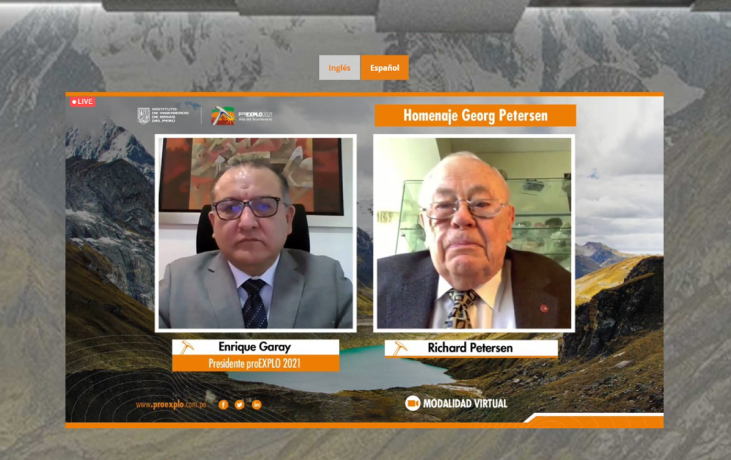
The Organizing Committee of the XII International Congress of Prospectors and Explorers - proEXPLO 2021- paid a great tribute to Georg Petersen, researcher and university teacher. The ceremony was held on the first day of the congress and was attended by Richard Petersen, son of Georg Petersen.
“His professional career was developed in the oil industry, initially with the firm Faustino Piaggio and sons, Soc. Ltda. To work on the modernization of the Zorritos oil field, in Tumbes. Some time later he occupied the Superintendency, when the deposit became property of the Fiscal Petroleum Company”, he commented.
It should be noted that the Mines section of the Pontifical Catholic University of Peru houses the Georg Petersen Museum, where a collection of more than a thousand specimens of minerals, rocks and fossils, from Peru and abroad, is exhibited, which Dr. Georg Petersen he collected during his travels and through exchanges with other countries.
On the other hand, in order to disseminate the importance of mining activity before the Spanish conquest, George Petersen's family donated to the Institute of Mining Engineers of Peru (IIMP), in November of last year, a total of 1,500 copies of the work "Mining and metallurgy in ancient Peru", written by the prominent researcher.
proEXPLO 2021: Mineral Resources for a Sustainable Future
Minister of Energy and Mines will inaugurate proEXPLO 2021 mining exploration congress
 22nd March
22nd March
Minister of Energy and Mines will inaugurate proEXPLO 2021 mining exploration congress
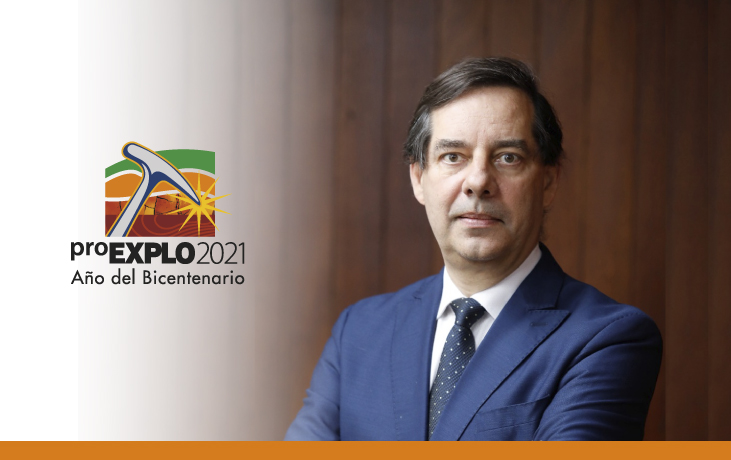
This conclave is a space for the exchange of knowledge chaired by Eng. Enrique Garay, which will take place from March 22 to 26 in an entirely virtual way, and will bring together students, professionals, businessmen and investors from different parts of the world.
The official opening ceremony of proEXPLO will take place from 6:45 p.m., but the presentations have been taking place from 9:00 a.m.
proEXPLO 2021 will show the main advances in innovation applied to exploration activity, the progress of the main exploration projects in the country, and participants will be able to do business with companies and suppliers, and expand their contact networks.
"This year the pandemic opens up the opportunity for us to carry out proEXPLO 2021 virtually, a situation that will allow us to disseminate more and better the various topics that have been organized for this year," reveals the IIMP.
This proEXPLO edition will feature an innovative program of activities clearly focused on the mining exploration business, which is organized in three framework sessions.
The first session will focus on innovation in exploration, in which the exhibitors will analyze and debate on the new technological tools applicable in mineral exploration.
The second session will deal with exploration successes and the purpose is to present the new deposits discovered in Peru and Latin America.
While the third session will address the optimal transition from the exploration phase to a mine; and the objective is to disseminate among attendees the engineering processes that turn discoveries into profitable mining operations.
Showcase of opportunities
On the other hand, the IIMP has scheduled the 1st Exploration Project Fair for proEXPLO 2021, as a new platform for commercial relations between small mining investors and large mining companies or investment funds, interested in expanding their portfolios.
Likewise, during the 5 days of the congress, suppliers will have the opportunity to meet with companies and publicize their range of proposals aimed at mining. This activity will take place within the framework of the Logistics Meeting.
Keynote Talks and Round Tables
In proEXPLO 2021 there will also be keynote conferences by prominent professionals.
Thus, there will be presentations by Dr. Antoine Caté with his theme "Machine learning for exploration: a review of current and future tools"; by Dr. Thierry Sempere (“Exploring Peru in search of metals and hydrocarbons using innovative thinking”); and Dr. Jon Hronsky, who will speak on “An integrated model for Cu and Au mineralization at converging margins: two fundamental processes that interact in variable geodynamic situations”.
There will also be Dr. Michael Doggett with his theme "Converting mineral resources for a sustainable future: lessons from the first 20 years of the new millennium", and the Msc. Econ. Erik Heimlich with his presentation on the “Global copper market: short and long term fundamentals”.
Similarly, the organization will hold, on Thursday, March 25, a Round Table entitled "The contribution of women to the mining exploration industry in Peru" and which will be led by Silvia Kohler, Clara Indacochea and María Manrique.
Meanwhile, on Friday, March 26, the Round Table "Peru towards CRIRSCO" will be held, an international initiative of standards in mineral reporting.
proEXPLO 2021: Mineral Resources for a Sustainable Future
Today, Monday 22, proEXPLO 2021 started
 22nd March
22nd March
Today, Monday 22, proEXPLO 2021 started
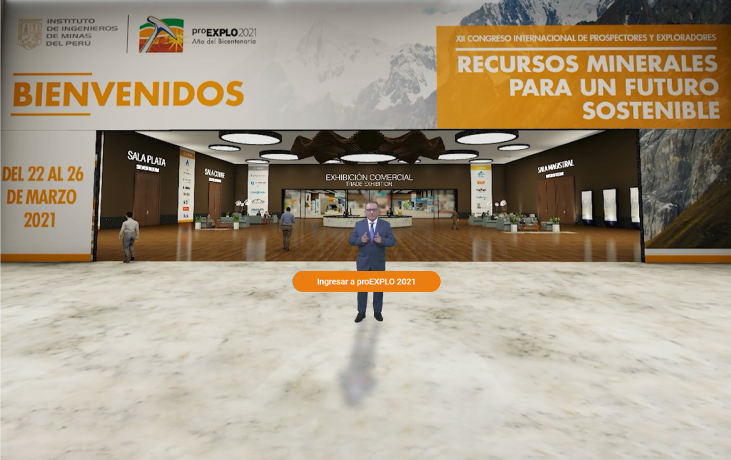
"I reiterate my welcome greeting and invite you to enjoy this new experience of high-level knowledge that is proEXPLO 2021", emphasized the president of proEXPLO 2021, at an event that will have the participation of renowned professionals from countries that are mining powers and who will give keynote lectures on the main current mining issues.
According to the organization, during the five days of the congress 60 technical works will be exhibited in a virtual way and that have been grouped into three thematic axes: Innovation in mining exploration, Economic Geology and From discovery to the mine.
“Similarly, we will hold two sessions dedicated to junior mining companies and private exploration projects. The objective is for each of the invited companies to explain their respective exploration strategies and business plans of their companies ”, Garay commented.
On the virtual platform, visitors will also have the opportunity to enter the "Exhibition Fair" through which they will seek to generate networking at all levels.
Also, in this new edition, proEXPLO will offer the round table "Peru towards CRIRSCO" with the participation of the vice president of CRIRSCO, the three Latin American members (Brazil, Colombia and Chile) and a representative for Peru.
proEXPLO 2021: Mineral Resources for a Sustainable Future
Courses prior to the start of proEXPLO 2021 were successfully completed
 22nd March
22nd March
Courses prior to the start of proEXPLO 2021 were successfully completed
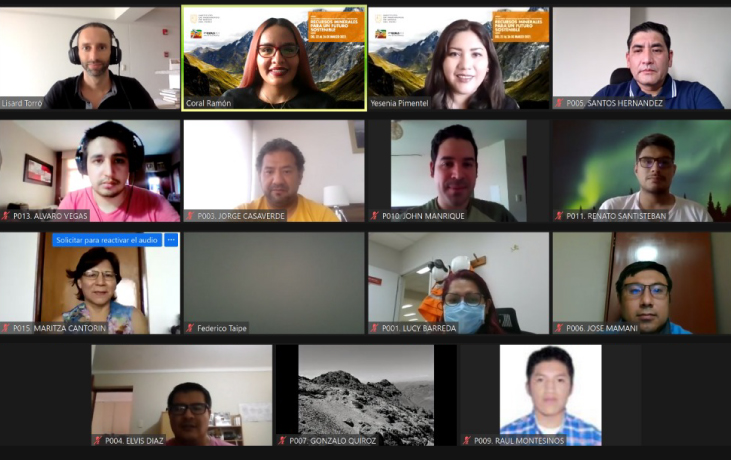
More than 200 participants attended the virtual courses taught by specialists from Australia, the US, Sweden, Canada and Peru between Friday 19 and Sunday 21. Among the short pre-Congress courses we can mention:
- Geometallurgy for explorers.
- Valuation of mining projects.
- Roofs and Floors of Epithermal Deposits and Transition to Porphyry Type Deposits: Application to Exploration.
- Fundamentals of Mining Disclosure Securities Laws - NI43-101 and S-K 1300.
- Strategies for the specific geochemical analysis (in situ) of minerals.
It should be noted that one of the purposes of proEXPLO 2021 is to seek the rapprochement between exploration work and the work of researchers at the Academy, in order to achieve a better understanding of the natural processes of formation of mineral deposits and that geological models are getting better and better.
In that sense, the researchers are both teachers who will train the geologists of the next generations and who can also participate in the continuous training of the geologists who are already working. "Here is the great role of proEXPLO 2021, which is to participate in training with conferences, posters, seminars and short courses," said Dr. Jean Vallance, head of pre and post courses of proEXPLO 2021.
proEXPLO 2021 begins this Monday, March 22, and throughout the week a series of activities will be developed to meet the demand for knowledge and information about the mining industry.
To learn more about how to register and participate in proEXPLO 2021 activities, go to https://proexplo.com.pe/es/categorias-ins
More details about the program of talks and conferences in this link: https://proexplo.com.pe/es/oral
This year the Congress will be 100% virtual. Learn more about the platform at: https://virtual.proexplo.com.pe/
proEXPLO 2021: Mineral Resources for a Sustainable Future
proEXPLO is the event where exploration, pillar of the mining industry, is highlighted
 22th March
22th March
"proEXPLO is the event where exploration, pillar of the mining industry, is highlighted"
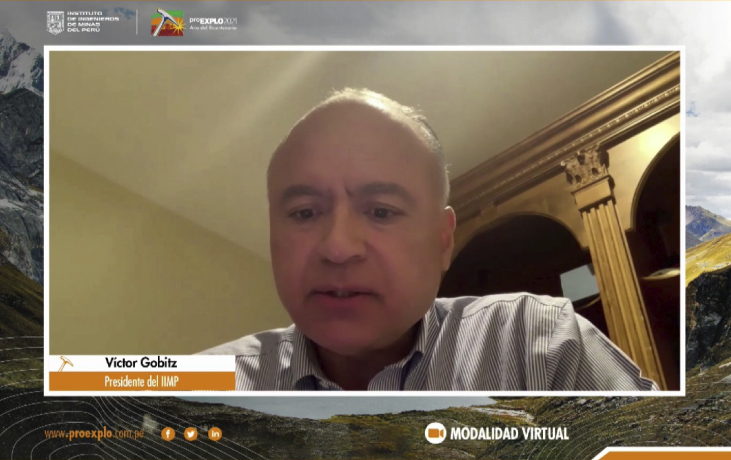
This Monday, March 22 was the first day of the 12th International Congress of Prospectors and Explorers - proEXPLO 2021, an event organized by the Peruvian Institute of Mining Engineers (IIMP).
The opening ceremony was attended by the President of the IIMP, Eng. Victor Gobitz, who emphasized that proEXPLO 2021 is an event whose importance lies not only in sharing specialized knowledge about the world of exploration, but also in putting on the agenda this important activity for the development of the mining industry and the future of our country.
"I would like to emphasize that proEXPLO is an event that highlights exploration, the pillar of the mining industry and the only way to give sustainability to our mining industry over time", Mr. Gobitz said.
Road to PERUMIN
During his participation, the President of the IIMP also informed that the program of activities on the road to PERUMIN will be held this year, which aims to promote spaces for an open and decentralized debate on mining.
"This program is the prelude to what will be PERUMIN 35th Mining Convention, which will be held in September 2022," he said.
He also pointed out that as part of the activities of Road to PERUMIN, the collaborative mining innovation program PERUMIN Hub has been presented, where groups of innovators will have the opportunity to connect directly with companies in the sector and showcase their projects and technological creations.
He also stated that the study "Mining: Development Opportunity in the Face of the National Crisis", which has been developed by the IIMP and the Center for Competitiveness and Development (CCD) of San Martin de Porres University, has recently been released.
"As we can see, all these activities are being developed within the framework of a crisis, where mining investments will not only have a greater preponderance in the economic recovery of our country, but will also contribute to revive the employment rate and boost other economic sectors", stressed Eng. Victor Gobitz.
proEXPLO 2021: Mineral Resources for a Sustainable Future
President of proEXPLO highlights the relevance of exploration in Peru
 22th March
22th March
President of proEXPLO highlights the relevance of exploration in Peru
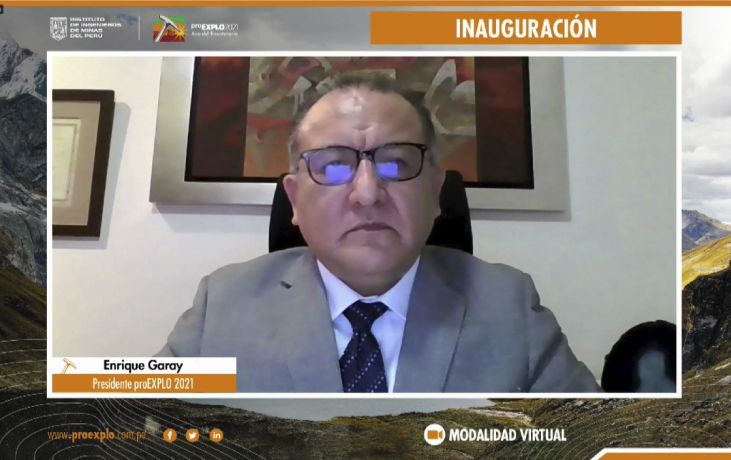
The President of the 12th International Congress of Prospectors and Explorers (proEXPLO 2021), Enrique Garay, said that the event is an enriching space for the exchange of knowledge, where not only the main advances in innovation applied to the exploration activity will be shown, but also the progress of leading exploration projects in the country.
"We believe that proEXPLO 2021 is an excellent platform and a great opportunity to put on the agenda the true importance of our explorations, which are the foundation of our mining industry. Today, more than ever, it is important to reinforce the message of the fundamental role that our mining industry will play in facing the crisis aggravated by the pandemic and, above all, to take advantage of this new scenario of attractive mineral prices", emphasized Eng. Enrique Garay.
At the beginning of his presentation, the President of proEXPLO 2021 offered moving words to all the Peruvians who have fallen victim to this pandemic. "We would like to remember in a brief tribute to all those who died during the pandemic, especially the 25 geologists who worked in the exploration industry and whose passing has left a void in our industry", said Eng. Enrique Garay.
According to the organizers, during the five days of congress, 60 technical papers will be presented virtually and have been grouped into three thematic areas: Innovation in Mining Exploration, Economic Geology and From Discovery to Mine.
"Similarly, we will hold two sessions dedicated to junior mining companies and private exploration projects. The objective is for each of the invited companies to explain their exploration strategies and business plans," said Garay.
On the virtual platform, visitors will also have the opportunity to enter the "Exhibition Fair" through which they will be able to network at all levels.
Also, in this new edition, proEXPLO will offer the round table "Peru on the road to CRIRSCO" with the participation of the Vice President of CRIRSCO, the three Latin American members (Brazil, Colombia and Chile) and a representative for Peru.
In this regard, Garay said that once Peru is in CRIRSCO, Peruvian geologists will be able to subscribe reports on their exploration work for the different stock exchanges in the world.
proEXPLO 2021: Mineral Resources for a Sustainable Future
ALS | Innovation in testing for the mining industry
 18th March
18th March
Innovation in testing for the mining industry
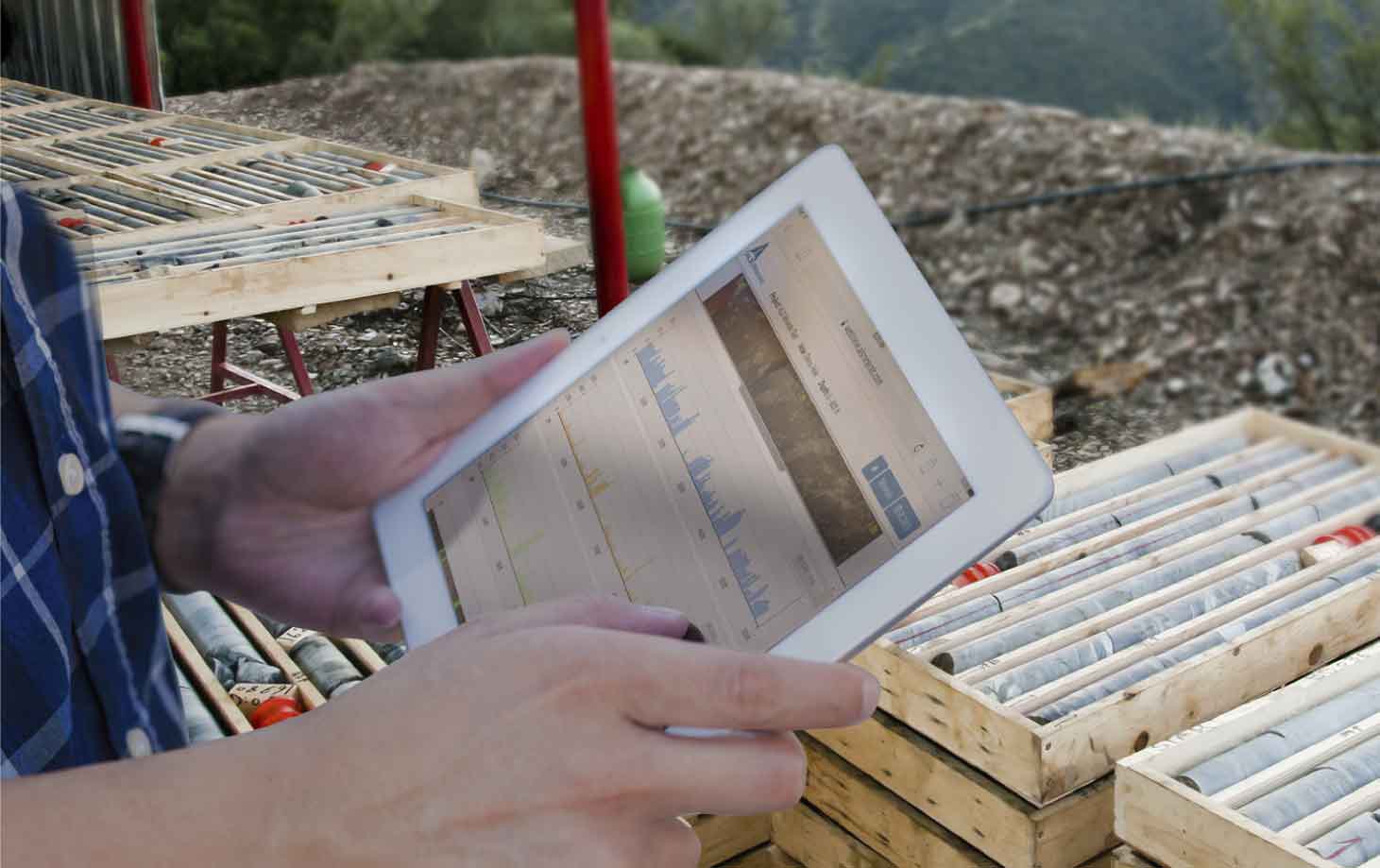
In order to provide participants with interactive and dynamic access, the 12th International Congress of Prospectors and Explorers (proEXPLO 2021) launches its application.
Thanks to a culture of innovation, ALS is at the forefront of new technologies, always with a high and renowned quality.
Among these innovations, the following stand out:
Determination of Pb Isotopes: A fast and low-cost method. This tool is useful as a vector in deposits rich in sulfides or uranium.
Analysis packages at Super Trace levels: In soil and sediment geochemistry it is of vital importance to have low detection limits, thus increasing the reliability of data at low concentrations and the possibility of determining anomalies. The methods are available with Aqua Regia and 4 acid digestions.
TerraSpecTM 4HR spectra acquisition and interpretation: The biggest hurdle in implementing routine spectral analysis is accurately interpreting large volumes of raw spectral data and integrating it into the workflow on par with geochemical information. This is now possible thanks to the synergy with our strategic partner AusSpec.
Scanning core boxes and obtaining hyperspectral mineralogy using TerraCoreTM: TerraCore technology provides continuous, 1 millimeter (mm) scale hyperspectral scanning of core boxes, obtaining maps of alteration minerals and spectral parameters previously indistinguishable to the naked eye. This service can be delivered either at ALS facilities, in mines or in advanced projects.
ALS provides a wide range of high-tech tools for your projects, in order to add value to all your project information.
proEXPLO 2021: Mineral Resources for a Sustainable Future
Nexa | An ESG company and its role in times of uncertainty
 18th March
18th March
Nexa, an ESG company and its role in times of uncertainty
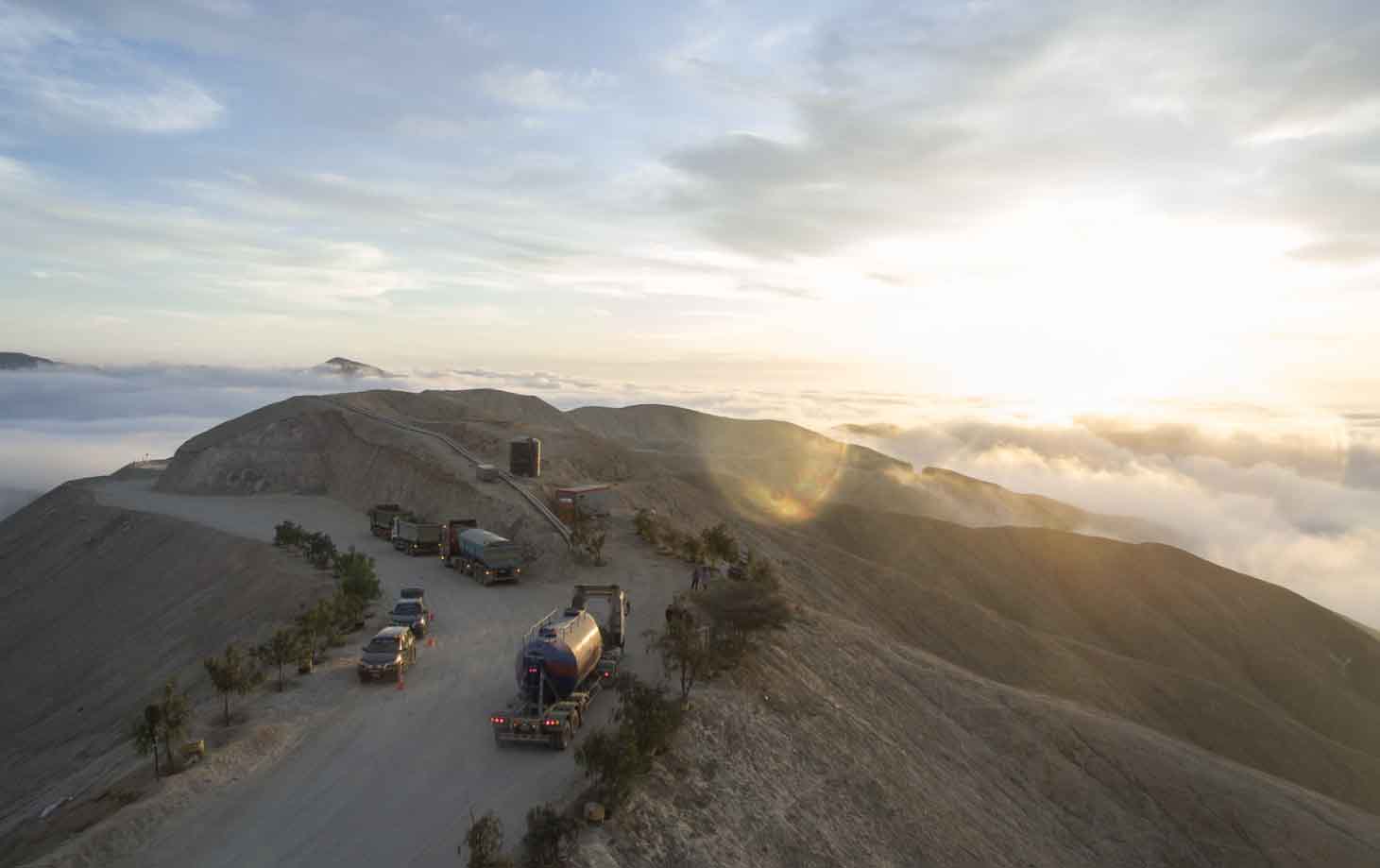
In order to provide participants with interactive and dynamic access, the 12th International Congress of Prospectors and Explorers (proEXPLO 2021) launches its application.
This way, Nexa has refocused its vision on three important pillars: Environmental, Social and Governance (ESG) whose interpretation focuses on a more holistic approach.
"The importance of the environmental pillar is unquestionable for the sector, but with the arrival of the coronavirus in Peru, all our efforts and energies have been oriented towards a single objective, the health and safety of our employees, contractors and communities," says Ricardo Porto, CEO of Nexa Peru.
In fact, the company formed crisis committees with members of all its units to ensure compliance with the action and prevention plan, optimizing its response capacity and becoming the first mining company to approve the Plan of Surveillance, Prevention and Control of COVID-19 with the Ministry of Energy and Mines.
Nexa also made important donations, such as 12 mechanical ventilators and 400 oxygen cylinders for health centers in the country. In addition to implementing a telehealth project with ultrasound stations for the regions of Ica, Pasco and Ancash.
They also delivered more than 11,000 food baskets for vulnerable families in their areas of influence, 38,000 masks for health personnel in Ica, and other biosafety materials for health personnel and police officers in Ica and Pasco. In the latter region, community surveillance committees were created in conjunction with the communities.
In parallel, the company continued with other social projects such as educational networks, dual Training, Afforestation, Strengthening the management and conservation of vicuñas, sheep chain, improved kitchens, among others.
It is important to note that, in this process, the support of "Somos Todos" volunteers, which is a Nexa's program that aims to contribute to this social transformation, has been fundamental.
proEXPLO 2021: Mineral Resources for a Sustainable Future
The first batch of medical oxygen donated by Antamina, along with other mining companies, is already in Lima
 1th March
1th March
The first batch of medical oxygen donated by Antamina, along with other mining companies, is already in Lima
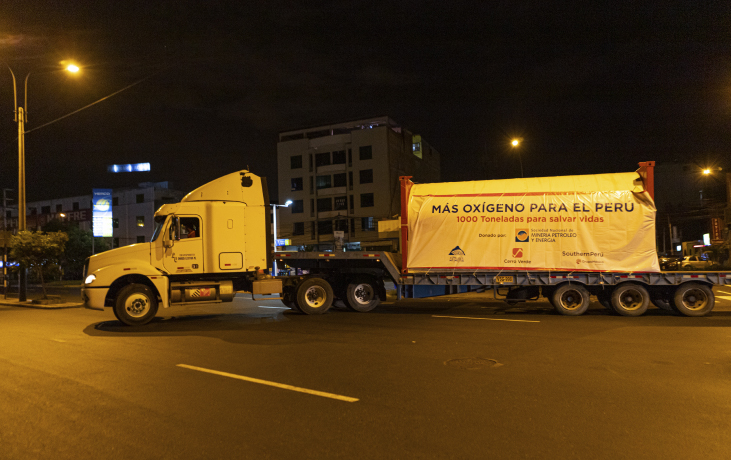
In order to provide participants with interactive and dynamic access, the 12th International Congress of Prospectors and Explorers (proEXPLO 2021) launches its application.
On the night of March 10, the National Society of Mining, Petroleum and Energy (SNMPE) informed that the first ISO tank loaded with medical oxygen arrived in Lima from Chile, as part of the donation made by Compañía Minera Antamina and the companies Cerro Verde and Southern Peru, of this vital element to Peruvian hospitals.
This first batch of oxygen arrived at the Edgardo Rebagliati Hospital and the following batches will supply the hospitals designated by the Ministry of Health (Minsa) to fight against the shortage of this important resource in the treatment of COVID-19 patients.
"This donation began with the transportation by air of four ISO tanks from Germany to Santiago de Chile. In these ISO tanks, 40 tons of medical oxygen will be transported weekly to the national territory", reported Antamina.
As recalled, last March 10, the signing of the donation agreement took place at the Government Palace, with the presence of the President of the Republic, Francisco Sagasti. On behalf of Compañía Minera Antamina, Antonio Pinilla, Vice President of Legal and Compliance, was present.
In this way, the companies associated to the SNMPE, with the special support of Antamina, Cerro Verde and Southern Peru, committed to finance the purchase and transportation of 1,000 tons of medical oxygen from Chile to the hospitals designated by the Ministry of Health.
"It should be noted that since the pandemic began, Compañía Minera Antamina, as a social actor, has taken a more active role in benefiting the health, welfare and development of its workers, the communities in its area of influence and Peru," said the company.
proEXPLO 2021: Mineral Resources for a Sustainable Future
Everything ready for the 12th International Congress of Prospectors and Explorers
 15th March
15th March
Everything ready for the 12th International Congress of Prospectors and Explorers
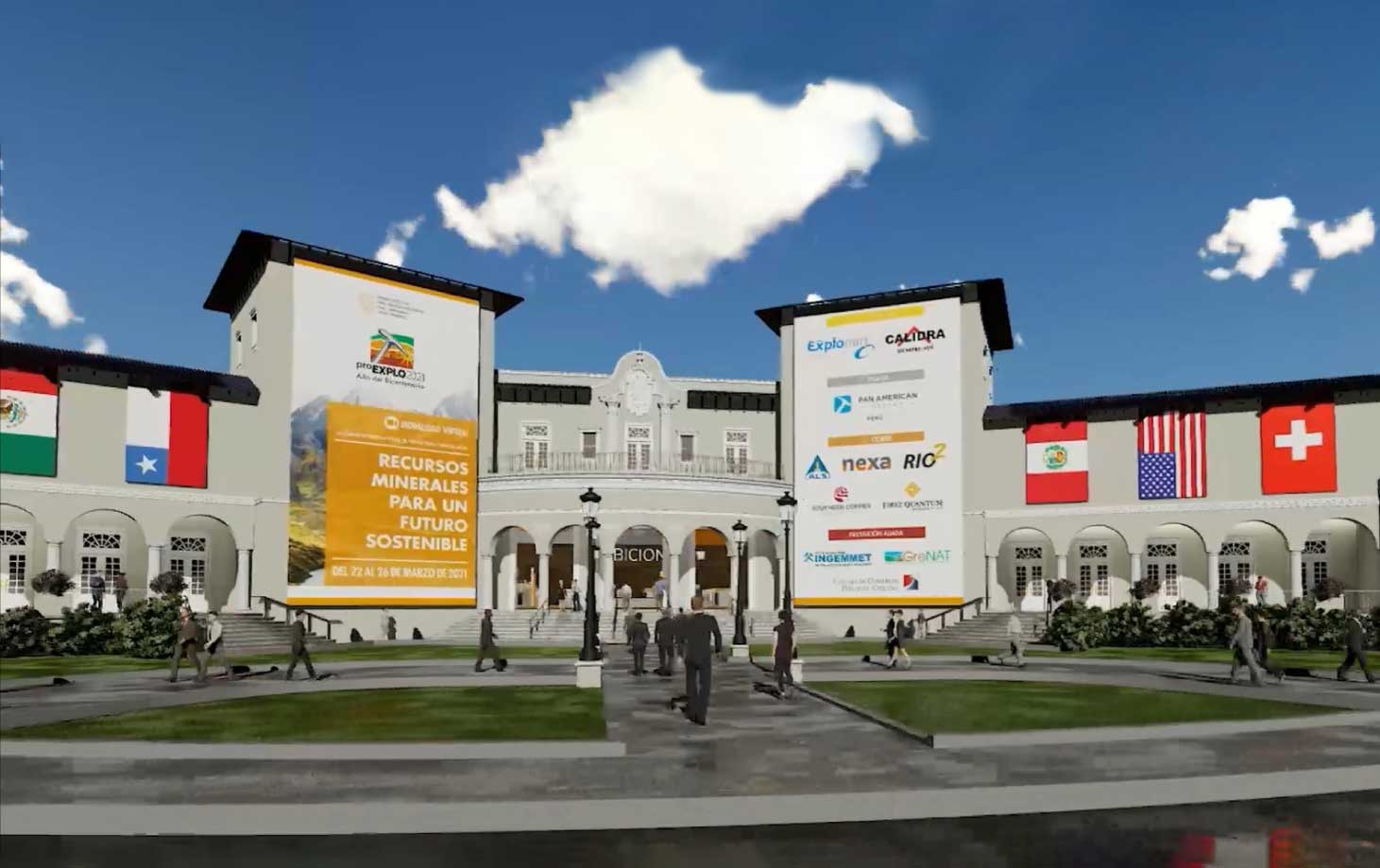
Prospecting and exploration are two fundamental stages for the future of mining. Also, the constant advance of technology forces mining professionals to be always informed and prepared.
Based on these two factors, the Peruvian Institute of Mining Engineers (IIMP) is holding the International Congress of Prospectors and Explorers, whose 2021 edition will start this Monday, March 22 and run until Friday, March 26.
"This year the pandemic gives us the opportunity to conduct the proEXPLO 2021 virtually, something that will allow us to disseminate more and better the various topics that have been organized for this year," reveals the IIMP.
The organizer has also planned an innovative program of activities focused on the mining exploration business, which is organized in three framework sessions.
The first session will focus on innovation in exploration, in which speakers will analyze and discuss new technological tools applicable to mineral exploration.
The second session will deal with exploration successes and the aim is to present the new deposits discovered in Peru and Latin America.
While the third session will address the optimal transition from the exploration phase to a mine; and the objective is to disseminate among the attendees the engineering processes that turn discoveries into profitable mining operations.
Opportunity showcase
On the other hand, the IIMP has scheduled for proEXPLO 2021 the 1st Exploration Projects Fair to be launched as a new platform for commercial relations between small mining investors and large mining companies or investment funds interested in expanding their portfolios.
Also, during the 5 days of congress, suppliers will have the opportunity to meet with companies and present their proposals oriented to the mining industry. This activity will take place within the framework of the Logistics Meeting.
Keynote Speeches and Roundtable
proEXPLO 2021 will also feature keynote speeches by prominent professionals.
Among the speakers will be Dr. Antoine Caté on "Machine learning for exploration: a review of current and future tools"; Dr. Thierry Sempere ("Exploring Peru for metals and hydrocarbons using innovative thinking"); and Dr. Jon Hronsky, who will speak on "An integrated model for Cu and Au mineralization at convergent margins: two fundamental processes interacting in variable geodynamic situations".
Also present will be Dr. Michael Doggett on "Transforming mineral resources for a sustainable future: lessons from the first 20 years of the new millennium", and Msc. Eco. Erik Heimlich with his presentation on the "Global copper market: short and long term fundamentals".
Similarly, on Thursday, March 25, the organizers will hold a Round Table entitled "The contribution of women to the Peruvian mining exploration industry", which will be led by Silvia Kohler, Clara Indacochea and María Manrique.
On Friday, March 26, the Round Table "Peru on the road to CRIRSCO", an international initiative of standards in mineral reports, will be held.
Further information
To learn more about how to register and participate in the activities of proEXPLO 2021, please visit https://proexplo.com.pe/es/categorias-ins
More details about the talks and conference program can be found at: https://proexplo.com.pe/es/oral
proEXPLO 2021: Mineral Resources for a Sustainable Future
Interview | Elmer Flores, Manager of Generative Exploration Peru for Newmont
 15th March
15th March
"We need to continue exploring to develop new projects and new mines"
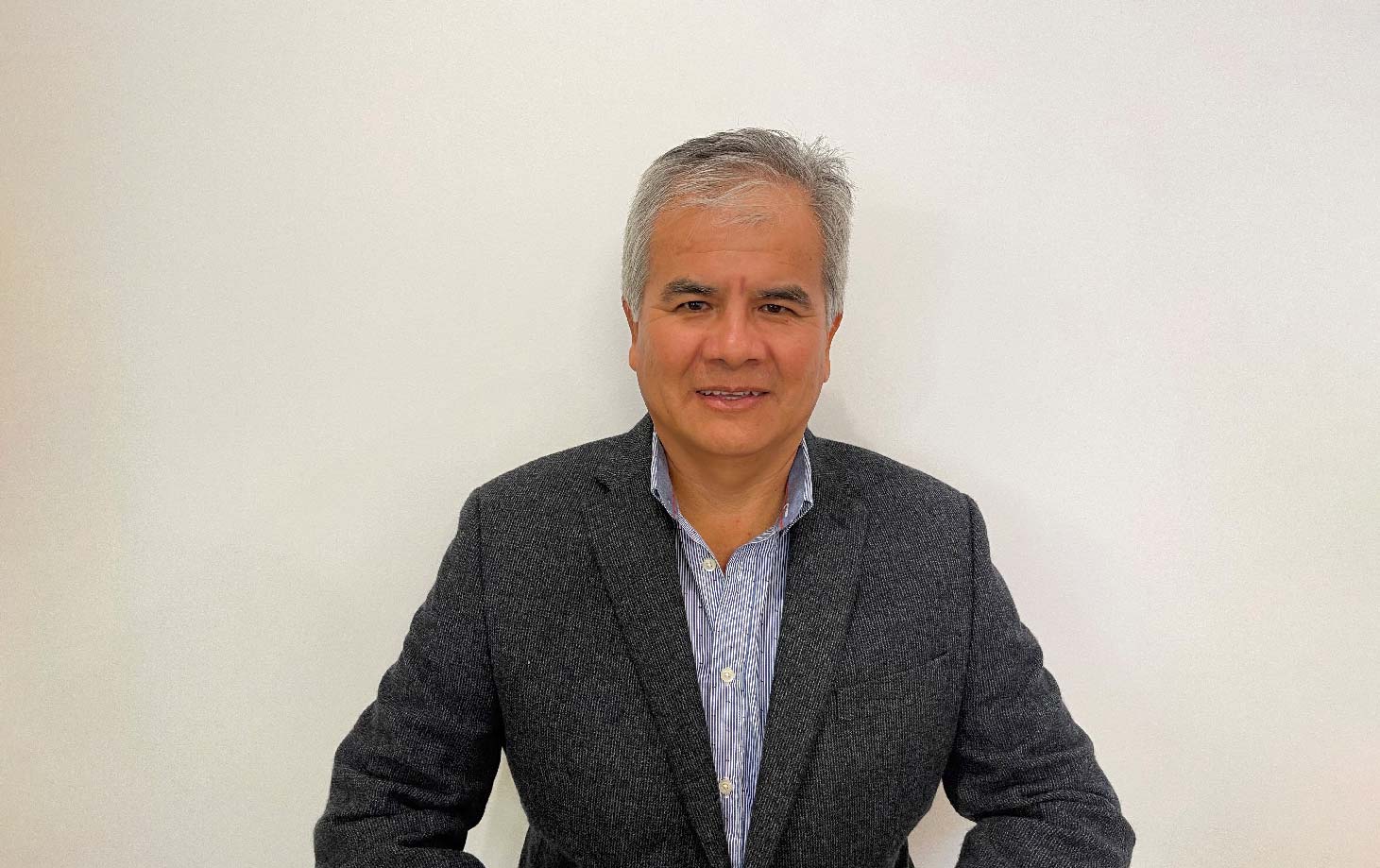
Said Elmer Flores, Manager of Generative Exploration Peru for Newmont, who also considers it important that the government supports and guarantees the stability and viability of investments.
What are your expectations for this 12th International Congress of Prospectors and Explorers (proEXPLO 2021)?
2019 has been a very challenging year for exploration, especially for greenfields; however, the goals for brownfields have been somewhat achieved; in that sense, our expectations for proEXPLO 2021, to be held 100% virtually, is that we will have the opportunity to access conferences, booths and core shacks of different mining operations, exploration projects, as well as new technologies in geological prospecting.
We expect this event to be well attended due to the ease of remote global connectivity and the existence of a market interested in new projects since commodity prices are very favorable.
How would you describe Peruvian geology?
Peruvian geology is one of the most complete and complex in the world, with an incredible geological potential. We have in our territory almost all the known and studied mineralization, with world-class deposits that host gold, copper, molybdenum, silver, zinc, lithium, etc.
Why is prospecting and exploration important in mining?
Because prospecting and mineral exploration is the beginning towards finding new prospects, developing them into projects and turning them into mines. Keep in mind that mines have a certain useful life as their resources and reserves are depleted; therefore, further exploration is needed to develop new projects and new mines.
What investments does Newmont have planned for the years 2021-2022?
We have several initial exploration projects in the portfolio nationwide; however, since March of last year these have been almost paralyzed due to the pandemic.
As you know, for initial exploration works, the projects are located in very remote places and we interact with very isolated communities with very little health care; therefore, under these current conditions of high rates of contagion, little or no availability of ICU beds, it is difficult to develop explorations in new projects. We hope that with the vaccine this will be controlled and we can go back to the field.
Do current copper and gold prices favor exploration for these types of mining products?
Certainly, they encourage investment in exploration and development of proven projects; however, government support is key to ensure the stability and viability of investments.
What technologies are being or will be applied by Newmont for its prospecting and exploration activities?
Newmont is a company that is always at the forefront of new technologies for exploration (Geochemistry, Geophysics, Artificial Intelligence, etc.).
What are the professional competencies that Newmont will demand for the next 2, 5 and 10 years?
There are many professional competencies that Newmont will require in the future, but it will be aligned according to how the COVID-19 pandemic is controlled, as well as the social viability and especially government support.
proEXPLO 2021: Mineral Resources for a Sustainable Future
Logistics Meeting organized by proEXPLO 2021
 15th March
15th March
Logistics Meeting organized by proEXPLO 2021
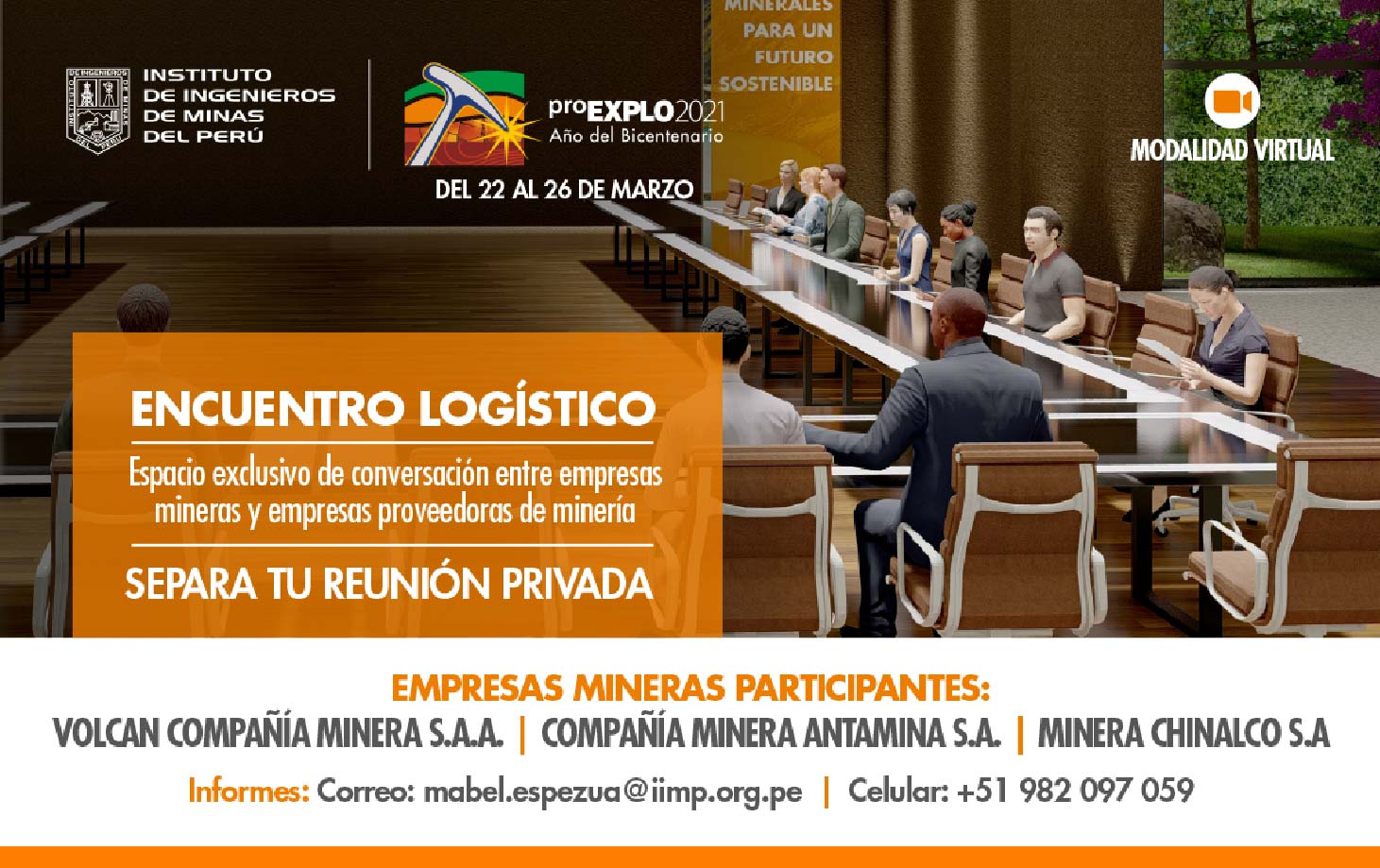
The 12th International Congress of Prospectors and Explorers -proEXPLO 2021- in addition to promoting the importance of exploration for the future of mining, will also be an important space to bring together mining companies and suppliers of goods and services.
This objective will be achieved through the Logistics Meeting (Encuentro Logístico), which will be attended by Volcan Compañía Minera, Minera Chinalco and Compañía Minera Antamina.
"The Logistics Meeting is an exclusive conversation space between mining companies and mining supplier companies. In this context, the Peruvian Institute of Mining Engineers will be the link between both," announced proEXPLO 2021's organizers.
They also mentioned that each representative of the mining companies will attend a maximum of 2 suppliers of the same company per meeting for a maximum of 20 minutes.
Companies interested in taking part in the Logistics Meeting can contact us at mabel.espezua@iimp.org.pe or (+51)982097059.
proEXPLO 2021: Mineral Resources for a Sustainable Future
In Canada two companies join forces to offer augmented reality digital twins for the mining industry
 15th March
15th March
In Canada, two companies join forces to offer augmented reality digital twins for the mining industry
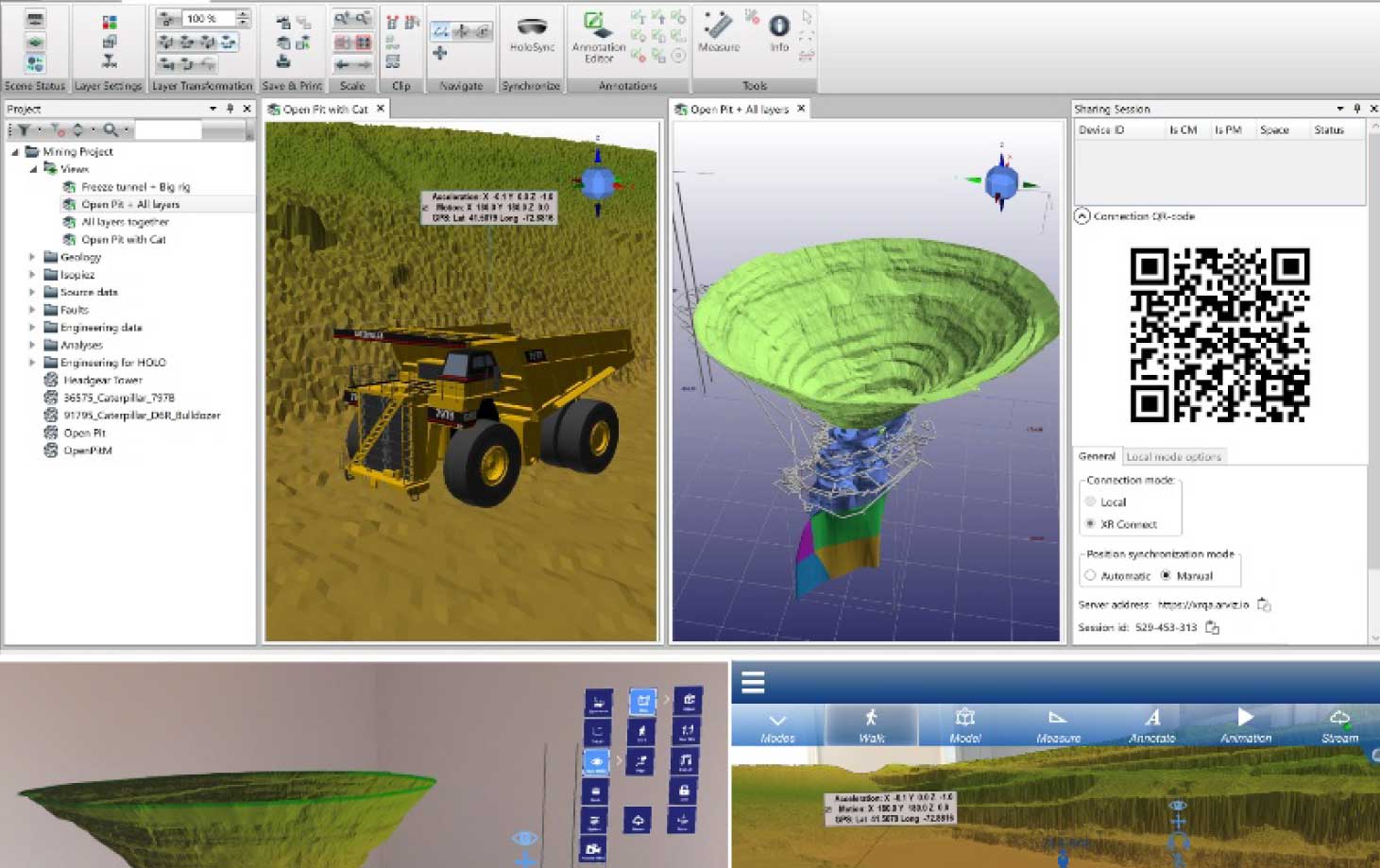
The 2021 mining exploration project portfolio includes 60 projects with an aggregate investment amount of US$ 506 million.
Arvizio and Sight Power companies announced a partnership aimed at delivering augmented reality (AR) digital twins to the mining industry; as well as a seamless integration of mining data, 3D models and LiDAR scans to share between Sight Power's Digital MineTM platform and Arvizio's Immerse 3D augmented reality solution.
"This combination provides the industry with a powerful and integrated suite of mining operations software and AR to optimize the mining process by reducing costs, improving efficiency, increasing productivity and improving safety," reported Canada's Arvizio.
It added that digital transformation is a major trend in all aspects of mining and AR is emerging as a key component to incorporate and visualize mine planning data into the design, planning, operations, resource management and investor relations processes.
"Digital Mine is a system for collecting and processing detailed information related to all operations and work processes in the mining business. This information, when combined with modeling, monitoring and distributed sensor systems, provides a cohesive solution to automate daily routine operations for geologists, mining engineers, mine surveyors and other specialists, resulting in increased labor productivity and reduced technical errors," they explained.
The company said its "Immerse 3D" system allows 3D models and LiDAR scans, used with Digital Mine, to be visualized in AR, and that Immerse 3D's advanced model optimization and hybrid rendering capabilities are ideal for visualizing LiDAR scans and geological models of mining operations that can cover many miles/kilometers and include multiple layers. In addition, Immerse 3D enhances the Sight Power Digital Mine platform by extending Digital Mine capabilities to include AR visualization and collaboration for multiple users and locations in fully synchronized sessions using web meeting platforms such as Microsoft Teams and Zoom.
For his part, Sight Power CEO Sergey Reznichenko stressed that working with leading mining companies using Digital Mine demonstrated that combining operational technology, monitoring systems, devices and spatial datasets into a single workflow system streamlines mining operations at every stage.
"We are delighted to partner with Arvizio to integrate Immerse 3D AR visualization into our workflows and use augmented reality to train stakeholders around the world for more efficient information sharing, troubleshooting, verification of key operations and safety systems in their mining projects," said Sergey Reznichenko.
The extension of the Immerse 3D platform enhances the capabilities of Digital Mine technology using AR in these and other scenarios:
- Supporting personnel training and equipment repair to reduce operating costs and downtime.
- Expanding Digital Twin capabilities in processing plants for real-time monitoring.
- Real-time virtual presence at the mine site.
- Continuous evaluation of mine evolution models to identify problems and avoid costly overruns.
proEXPLO 2021: Mineral Resources for a Sustainable Future
Interview | Walter Tejada Liza, BHP's Head of Country - Peru Metals Exploration
 15th March
15th March
"We must promote new projects in order to meet the future demand for metals"
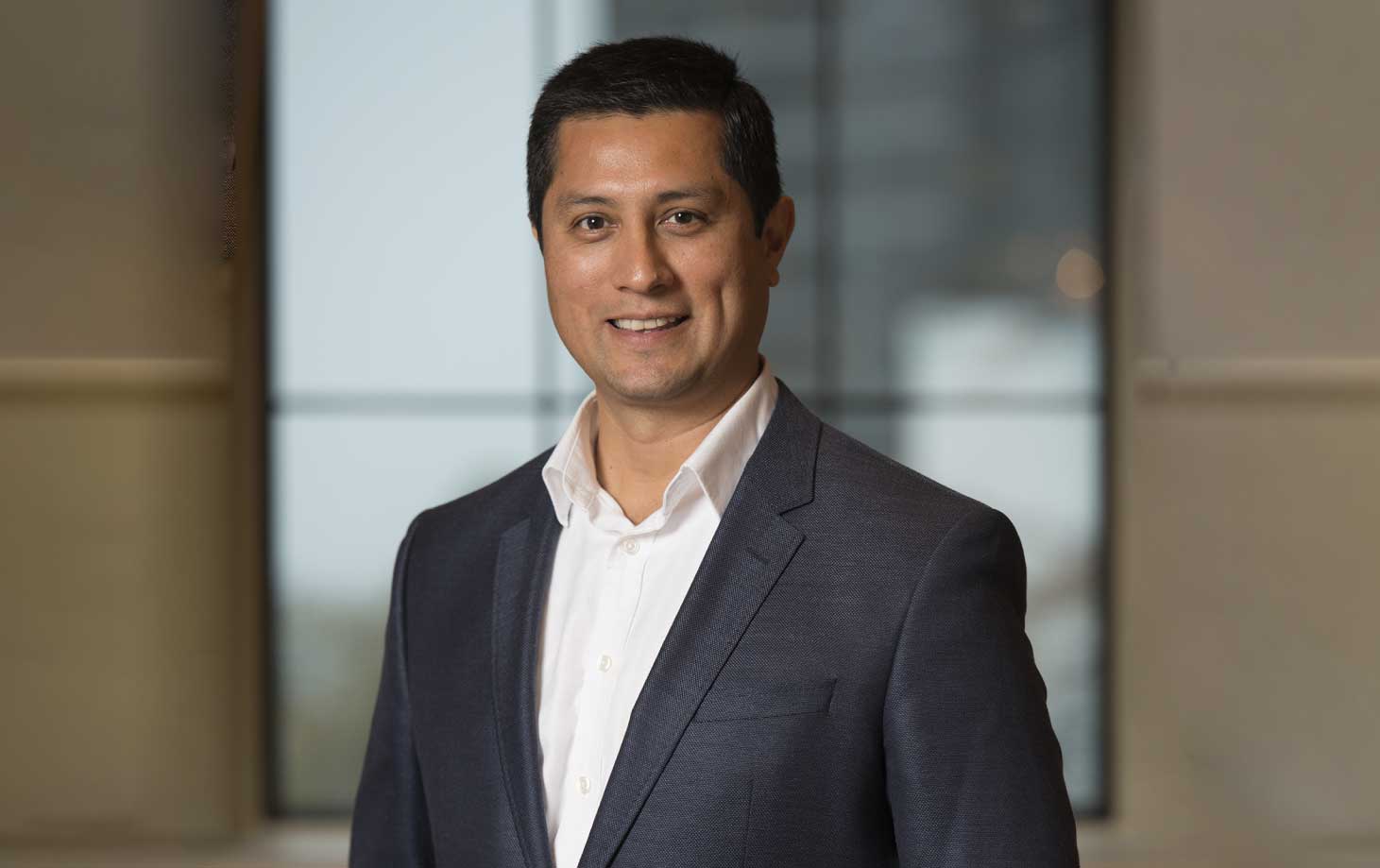
BHP's Head of Country - Peru Metals Exploration, Walter Tejada Liza, shared the work carried out by the company in the current health context.
What are your expectations for this 12th International Congress of Prospectors and Explorers (proEXPLO 2021)?
Meeting again with leaders in the exploration sector, both from Peru and other countries, will be very enriching as it will allow us to learn about the progress of projects, advances in exploration concepts, tools and technologies, as well as the challenges we face at the current juncture.
Also, the exchange of experiences is an opportunity of great value for BHP.
What aspects can facilitate mining exploration?
We need to encourage more responsible investment and promote a national regulatory framework that is competitive with those of other countries in the region.
Also, in order for projects developed in Peru to compete on equal terms, it is necessary to reduce permitting times, without losing quality and safety, and thus generate work and wealth for all.
Experts point out that we are facing a great demand for ores around the world. Is Peru doing everything necessary to respond to this new scenario in the global mineral market?
We believe that we must promote new projects that allow us to meet the future demand for metals; this requires the work of socially and environmentally responsible companies.
At BHP we have a Social Value approach: it is the contribution we make to society, partners, shareholders, communities, the economy and the environment. Creating Social Value is a priority to achieve our objective of mobilizing people and resources to build a better future for all.
What exploration investments does BHP have planned for the next two years?
BHP has been committed to Peru and its geological potential for decades. We have several exploration projects in the pipeline ready for drilling, and we are in dialogue with the communities and authorities in order to reach agreements that are beneficial for all.
What technologies are being or will be applied by BHP for its prospecting and exploration activities?
At BHP we are constantly evaluating new technologies that can improve our ability to predict and detect mineral deposits, including those hidden under cover.
In addition, we have a variety of exploration tools and machine learning techniques, drones, among others.
We also support pioneering research studies at prestigious universities.
What has been BHP's plan for dealing with COVID-19 both in its operations and within the communities?
In South America, since the beginning of the health crisis, BHP operations have applied a contingency plan focused on controlling - in a dynamic and flexible manner - the effects of the pandemic on its workforce to safeguard their health and safety.
The company has implemented a series of control and hygiene measures, in coordination with the health authorities, and existing protocols at the national level. In addition, each operation establishes specific measures according to the risk criteria both within the operation and the region where it operates.
This year, BHP is relying on the experience and lessons learned in 2020. Preventive testing, for example, is a great tool to prevent infected people from entering projects or mines.
Every week, as a preventive measure, BHP operations carry out active case search days, with PCR and antigen tests. This active case search is carried out in the hometowns of workers, directors and contractors.
In March 2020, BHP also launched direct support plans for the communities near our operations. Based on our Social Value strategy, we created comprehensive programs to help those who needed it most.
In our exploration activities in Peru, we have designed protocols to deal with the pandemic in the field and according to the program to be executed, considering the number of people and work area conditions, as well as lodging, transportation, and food. Health monitoring has been fundamental for the execution of work during the pandemic. These protocols have worked thanks to the commitment of all personnel to comply in detail with them.
We have had the opportunity to provide humanitarian support to the most remote high Andean areas and strengthen the capacity of medical centers linked to our communities through the provision of PPE for COVID. We have also prioritized the generation of awareness among our communities, promoting hygienic practices in coordination with health centers, improving their sanitary facilities, water supply points and provision of disinfection and personal protection equipment.
proEXPLO 2021: Mineral Resources for a Sustainable Future
Interview | Eng. Enrique Garay, president of the proEXPLO 2021
 15th March
15th March
“proEXPLO 2021 seeks to reflect the present and future of peruvian and world mining exploration”
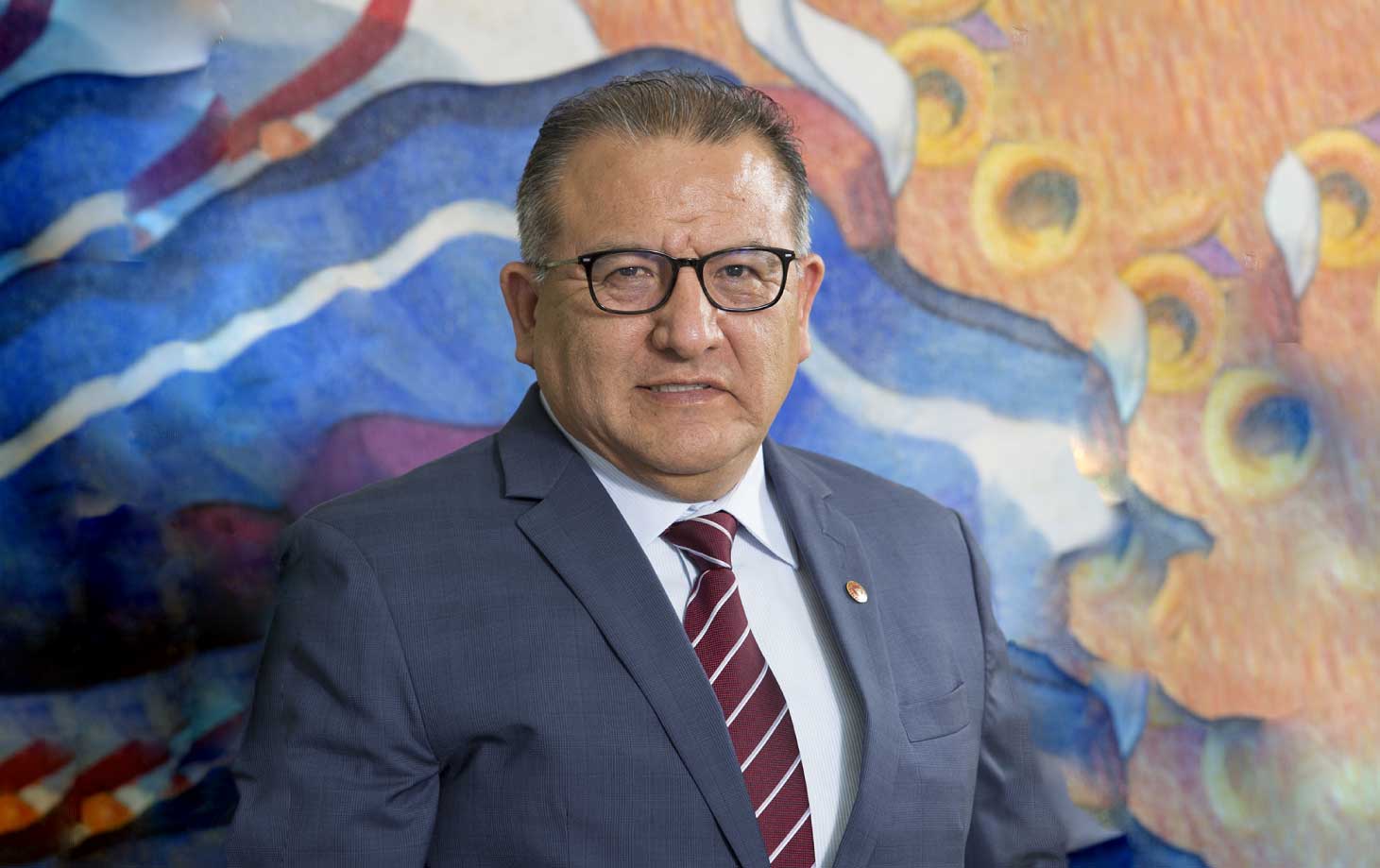
The president of the 12th International Congress of Prospectors and Explorers, Eng. Enrique Garay, analyzes the current situation of mining and shares more details about the next edition of this important congress.
What are your expectations for this 12th International Congress of Prospectors and Explorers (proEXPLO 2021)?
2019 has been a very challenging year for exploration, especially for greenfields; however, the goals for brownfields have been somewhat achieved; in that sense, our expectations for proEXPLO 2021, to be held 100% virtually, is that we will have the opportunity to access conferences, booths and core shacks of different mining operations, exploration projects, as well as new technologies in geological prospecting.
The 12th International Congress of Prospectors and Explorers - proEXPLO 2021 will start this Monday 22nd. What are the key messages that will be developed in this new edition?
The 12th International Congress of Prospectors and Explorers - proEXPLO 2021, which I am honored to chair, has set 4 key messages.
The first key message is embodied in the Congress theme: "Mineral resources for a sustainable future". With this, we seek to continue strengthening the links between academia, industry and mining investors, so that new deposits can be found in the future to provide minerals for a cleaner environment.
The second message is to highlight innovation in exploration through talks that will promote discussion on new technological tools applicable to exploration.
The other two key messages put forward by the Organizing Committee are to bring to light the success stories in mineral exploration and to disseminate strategies on the optimal transition from exploration to mine. On this last point, we want participants to learn more about the engineering processes that turn discoveries into profitable mining operations.
This year's proEXPLO Congress will be held virtually because priority is being given to people's health. What challenges have you met?
Indeed, in order to protect the health of participants due to the COVID-19 pandemic, this year the 12th Congress of Prospectors and Explorers (proEXPLO 2021) will be 100% virtual.
As soon as this decision was taken, each member of the Organizing Committee took on the challenge of implementing a series of proposals to satisfy future participants.
As a result, a program has been put together that will offer talks and sessions during the 5 days of congress.
It is worth mentioning that the number of professionals registered is steadily increasing, with 44 countries registered, and we believe that we will reach a wider audience.
In many of the talks of "Road to proEXPLO 2021", the importance of exploration for the future of the mining sector has been highlighted; however, there is no news on the development of new exploration projects or a project that will already become a mine. What do you foresee happening with Peruvian mining in the next 2 and 5 years?
The International Congress of Prospectors and Explorers was created following the same model as the Prospectors & Developers Association of Canada (PDAC) for this part of the world and since its first edition it has focused on highlighting the importance of exploration, geology and prospecting; in addition, proEXPLO seeks to reflect the present and future of Peruvian, Latin American and world mining.
In this regard, it is noteworthy that the mining portfolio includes 53 prospects or projects that are awaiting authorization to be explored; and although the authorities have a proactive attitude to expedite these projects, the social situation, the pandemic crisis and the political climate further complicate the future of these projects.
Likewise, we have to remember that out of 1,000 evaluated prospects, 100 are evaluated through drilling, 10 move on to resource definition, 3 reach pre-feasibility and only 1 becomes a mine; therefore, it is urgent to spread more information about this activity, which is key for the future of mining.
If we do not find more resources and we do not replenish mining reserves, we run the risk of ceasing to produce; therefore, we will stop receiving economic resources through taxes, canon and royalties.
For all these reasons, it is urgent to disseminate more about mining exploration, and proEXPLO 2021 gives us that opportunity.
The IIMP, organizer of proEXPLO 2021, is a standard-bearer in promoting the participation of young mining engineers, metallurgists and geologists in mining companies. What is your position regarding young professionals?
Just as we need to find more resources and mining reserves to continue guaranteeing mining production, in the labor and professional field we also need new professionals, and young people are the ones called to fulfill this mission.
In this sense, it is essential for university students to receive a quality education that will allow them to exploit their knowledge and abilities to the maximum when they have the opportunity to be part of a mining company.
A detail that we must not forget is the importance of foreign language and the use of technology.
The role of women in mining exploration is a topic of interest for the participants of proEXPLO 2021. What can you tell us about this round table? What will be its objective?
Women have been contributing to the mining industry and the exploration industry for many years. I believe I am not wrong when I say that the myth that women cannot enter the mine has almost been eradicated. Furthermore, there are women working in almost all areas of the mining industry; they are also working in environmental areas, community relations, in the process plant and, of course, in the administrative areas.
In this sense, the new edition of the International Congress of Prospectors and Explorers will not only focus on the importance of exploration activity or the discovery of new deposits, but will also highlight the role of women in the mining exploration industry.
Thus, for proEXPLO 2021 -an event organized by the Peruvian Institute of Mining Engineers-, the Round Table "Contribution of women to the Peruvian mining exploration industry" will be held.
This talk will be given by Silvia Kohler, exploration and evaluation geologist with experience in mines and operations of metallic and non-metallic deposits in Peru, Chile and Canada; Clara Indacochea, geological engineer and who has served as representative of Petroperu workers in the period 2013 and 2015; and Maria Manrique, geological engineer and currently engineer in charge of project at the Geological, Mining and Metallurgical Institute (Ingemmet).
proEXPLO 2021: Mineral Resources for a Sustainable Future
Southern macroregion leads in mining exploration investments
 15th March
15th March
Southern macroregion leads in mining exploration investments
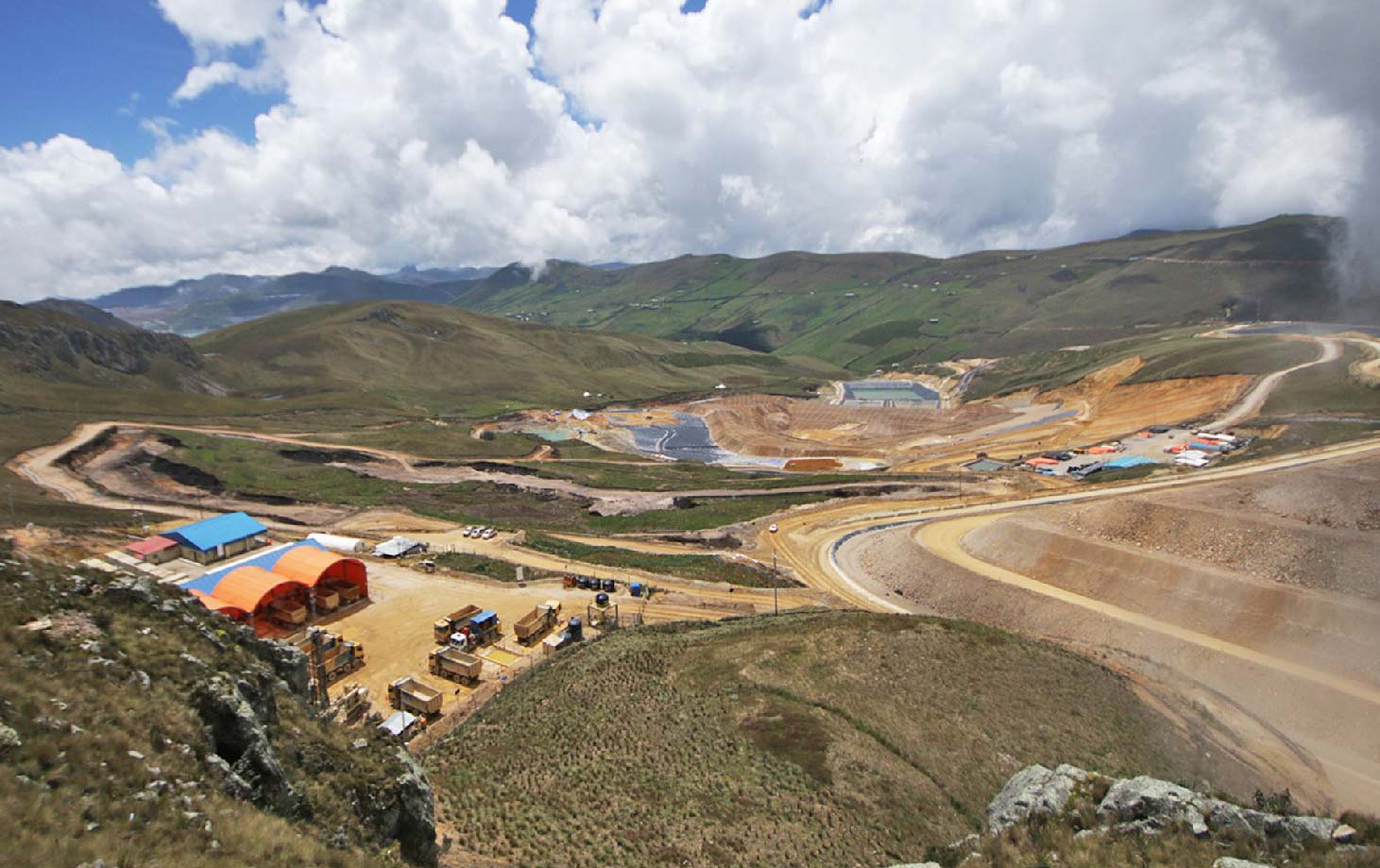
Taking into account the circumstances and the interest in Peru as a world destination for mining investments, the Ministry of Energy and Mines (Minem) presented the new portfolio of exploration projects for this year, which totals US$ 506 million distributed in 60 initiatives.
The General Director of Mining Promotion and Sustainability at the Minem, Luis Ducassi, detailed that regarding the distribution of these exploration initiatives in the regions, the South Macroregion covers most of the projected investments.
"These are estimated at US$ 186 million and are mostly copper investments. The region with the largest number of exploration investment projects is Arequipa," said the director of Minem.
He added that in second place there is a tie between the Northern and Central macroregions, with projects for an estimated US$ 159 million in exploration investments each.
Also, he pointed out that regions such as La Libertad are dominated by gold projects, while Pasco is known for having silver projects.
On the other hand, Luis Ducassi revealed that there are 60 exploration projects that were incorporated with a special methodology.
"These are divided into seven projects that are in the process of preparing their Environmental Management Instruments, whose investments in exploration reach a total of US$ 160 million. There are another 21 projects whose Environmental Management Instruments, have already been approved and are awaiting authorization to initiate activities. Investments in the latter amount to US$ 136 million," he said.
The general director of mining promotion and sustainability of Minem informed that the third category are projects that already have their Environmental Management Instruments approved and the authorization to start exploratory activities by the General Directorate of Mining (DGM).
"In this case, we are talking about 32 projects for a total of US$ 210 million," said the Director from Minem.
proEXPLO 2021: Mineral Resources for a Sustainable Future
proEXPLO launches an app for user convenience
 15th March
15th March
proEXPLO launches an app for user convenience

In order to provide participants with interactive and dynamic access, the 12th International Congress of Prospectors and Explorers (proEXPLO 2021) launches its application.
According to the Peruvian Institute of Mining Engineers (IIMP), organizer of the congress, the app is simple, user-friendly and available for free in both Apple devices (iPhone and iPad) and Android devices (cell phones, tablets, etc.).
Among the main features offered by this platform to users and participants of the congress are the interactive map of the event, where you can see the companies that already have booths at the fair, also ask questions in real time and schedule conferences in the calendar of your device.
People can also register their attendance at conferences so other participants can visualize it and add them to their network of contacts within the platform.
"In the app, there is a tab called 'My Network', which allows you to view all the contacts added and their uploaded information, as well as their LinkedIn and Twitter accounts," states the IIMP.
100% virtual congress
The 12th International Congress of Prospectors and Explorers (proEXPLO 2021) will be held March 22 to 26 and will feature keynote speeches, round tables and specialized sessions on prospecting and mineral exploration.
Also, this edition will be completely virtual and people interested in learning more about mining only have to register at link
To learn more about the virtual fair, please visit this link
proEXPLO 2021: Mineral Resources for a Sustainable Future
proEXPLO 2021 prepares a program of 24 posters distributed in 3 themes
 11th March
11th March
proEXPLO 2021 prepares a program of 24 posters distributed in 3 themes
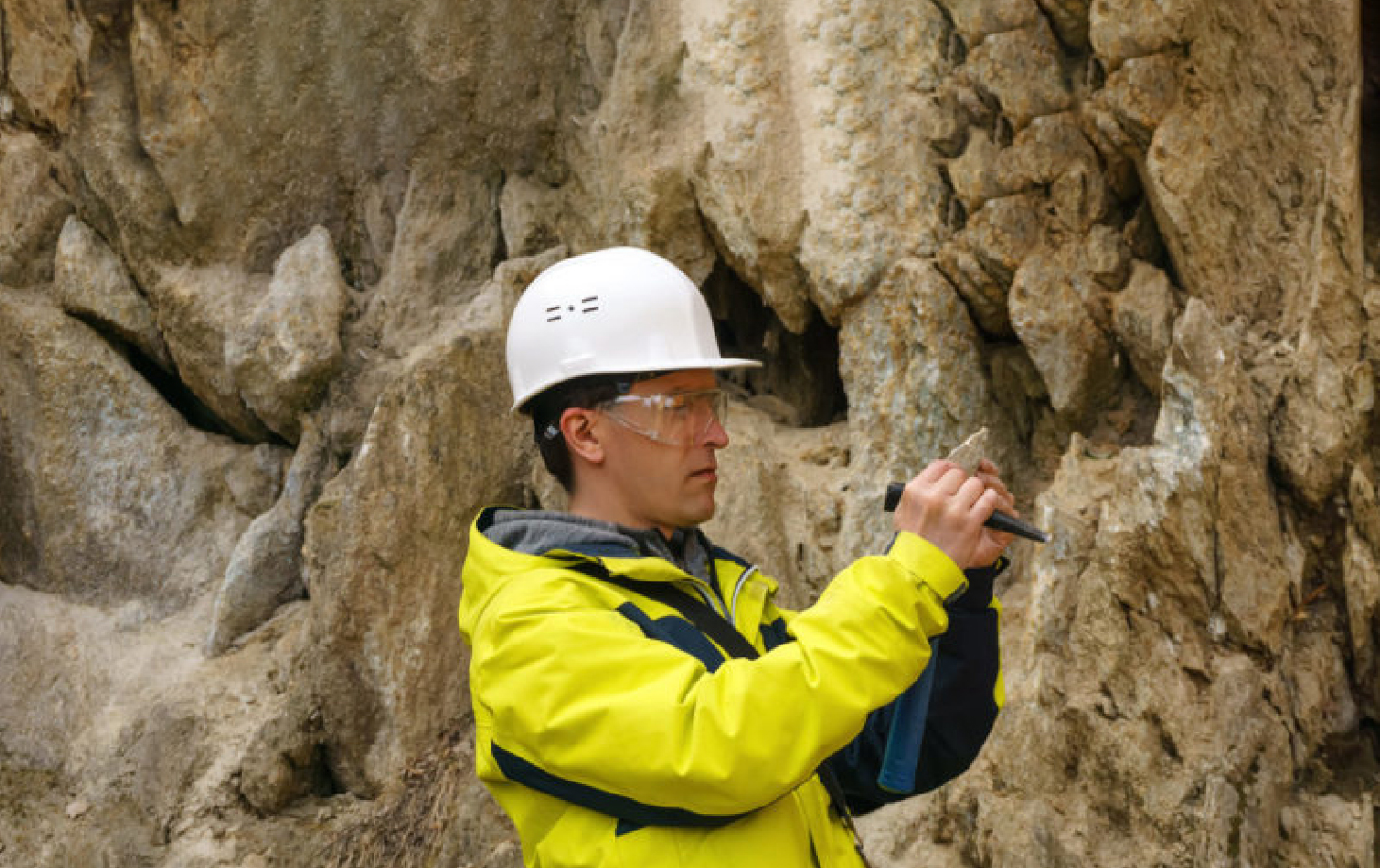
The 12th International Congress of Prospectors and Explorers (proEXPLO 2021) organized by the Peruvian Institute of Mining Engineers (IIMP) will start this Monday, March 22.
For this new edition of the congress, to be held entirely online, the organizers have prepared a program of 24 posters, which will be distributed in three main themes.
The first theme addresses "Economic Geology" and will focus on exploration success stories and advances in geological knowledge.
Some of the titles included in this group are Macusani uraniferous district: Mineralization model using stable isotopes; Generating value in the VMS type ore deposit at Cerro Lindo Mining Unit through the search for new geological domains (mineralized volcanic); Discovery and geology of the Coralillo project, a Cu, Au, Fe mineralized system associated to Cretaceous volcano-sedimentary rocks of the "Casma Group", Huarmey Basin, in the northern coast of Peru; to mention some highlights.
The second theme will be "Innovation in exploration" and the purpose will be to inform about the development of new exploration techniques and methodologies.
It will include topics like the analysis of main components of trace elements in stream sediments of the Cháparra basin (Arequipa) as a tool for gold prospecting; lithological clustering based on multi-elemental data in La Tapada, a polymetallic Andean deposit of Central Peru; among others of interest.
While the third theme entitled "From Discovery to Mine" aims to present works focused on the different stages to make a deposit viable and turn it into a mine, such as geometallurgy studies, resource definition or community relations management.
Among the topics to be discussed, we have circular economy, technological options for pyrite produced from CL tailings, exploration potential of historical tailings dams and its implications for a sustainable future: Case Antigua Mina Carhuacayán, Junín-Peru; Education: Indispensable to avoid social conflicts, and to promote and guarantee the sustainability of mining investment in Peru.
"These posters will be available throughout the 5 days of proEXPLO 2021 so that attendees can visualize them at any time. In addition, if participants want to ask questions via e-mail, they will have the opportunity to have direct contact with the author," explained the congress organizers.
proEXPLO 2021: Mineral Resources for a Sustainable Future
Peruvian investment leads mining exploration project financing
 11th March
11th March
Peruvian investment leads mining exploration project financing
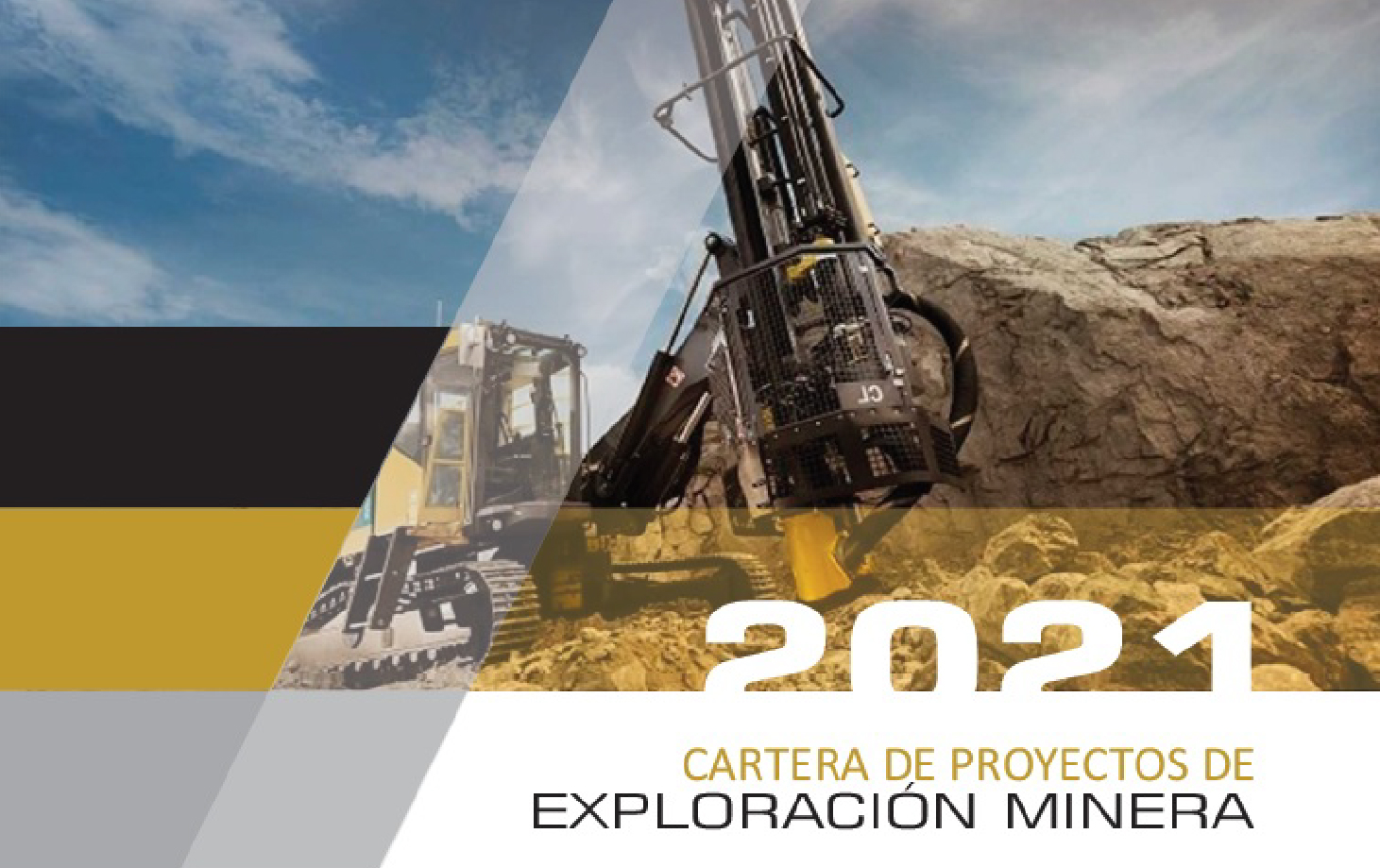
The 2021 mining exploration project portfolio includes 60 projects with an aggregate investment amount of US$ 506 million.
An interesting part of the report of the Ministry of Energy and Mines (Minem) is being able to see the origin of investments and this can be done by considering the country of origin of the main investor of each project.
So, according to the type of investor, there are capitals from 9 countries. In this aspect, Peru leads in the financing of exploration projects with US$ 152 million or 30% of the total amount invested, corresponding to 11 projects in the portfolio.
In second place are Canadian investments, with a total of US$ 132 million, equivalent to 26.2% of the total.
It is worth noting that Canada is in first place in terms of number of projects, with 20 projects in its portfolio.
Brazil is in third place, with a 12.6% share of the global investment portfolio, with a total of 5 projects and a combined investment of US$64 million.
While Switzerland, the United Kingdom and Mexico invested US$ 47 million, US$ 32 million and US$ 31 million, respectively.
The list is completed by capital from the United States (US$ 24 million); Australia (US$ 16 million) and Japan (US$ 8 million).
Minerals to be mined
On the other hand, the Minem detailed that gold projects are in first place, representing 35.1% of the global investment with US$ 178 million distributed in 24 projects of the portfolio.
"In this group are projects such as Las Defensas of Compañía Minera Poderosa in La Libertad and Tantahuatay 4 of Compañía Minera Coimolache in Cajamarca, whose investment amounts are US$ 69 million and US$ 28 million, respectively. The Shahuindo project of Shahuindo in Cajamarca and the Coloso project of Huarmy Colosal in Ancash have US$ 13 million and US$ 12 million budgeted for exploration activities," reported the ministry.
It added that in second place are copper projects, representing 30.7% of the total, with 17 projects and an accumulated investment budget of US$ 155 million.
"The aim is to achieve higher copper production in the long term through the development of projects such as Pampa Negra (US$ 45 million) of Minera Pampa de Cobre and Chapitos (US$ 41 million) of Camino Resources, located in the Moquegua and Arequipa regions, respectively," indicated the Minem.
Finally, in third place are the silver projects, reflecting 20.1% of the total investment in the portfolio, with a total of 9 projects and a combined investment of US$ 101 million.
"The projects that stand out from this group are Yumpag (US$ 49 million) of Compañía de Minas Buenaventura in the department of Pasco, as well as the Caylloma project (US$ 21 million) of Minera Bateas in the Arequipa region," the Minem reported.
proEXPLO 2021: Mineral Resources for a Sustainable Future
Interview | Steve Brown, Gold Fields' Vice President of Exploration
 11th March
11th March
"Peruvian geology offers a very broad horizon for the growth of mining”
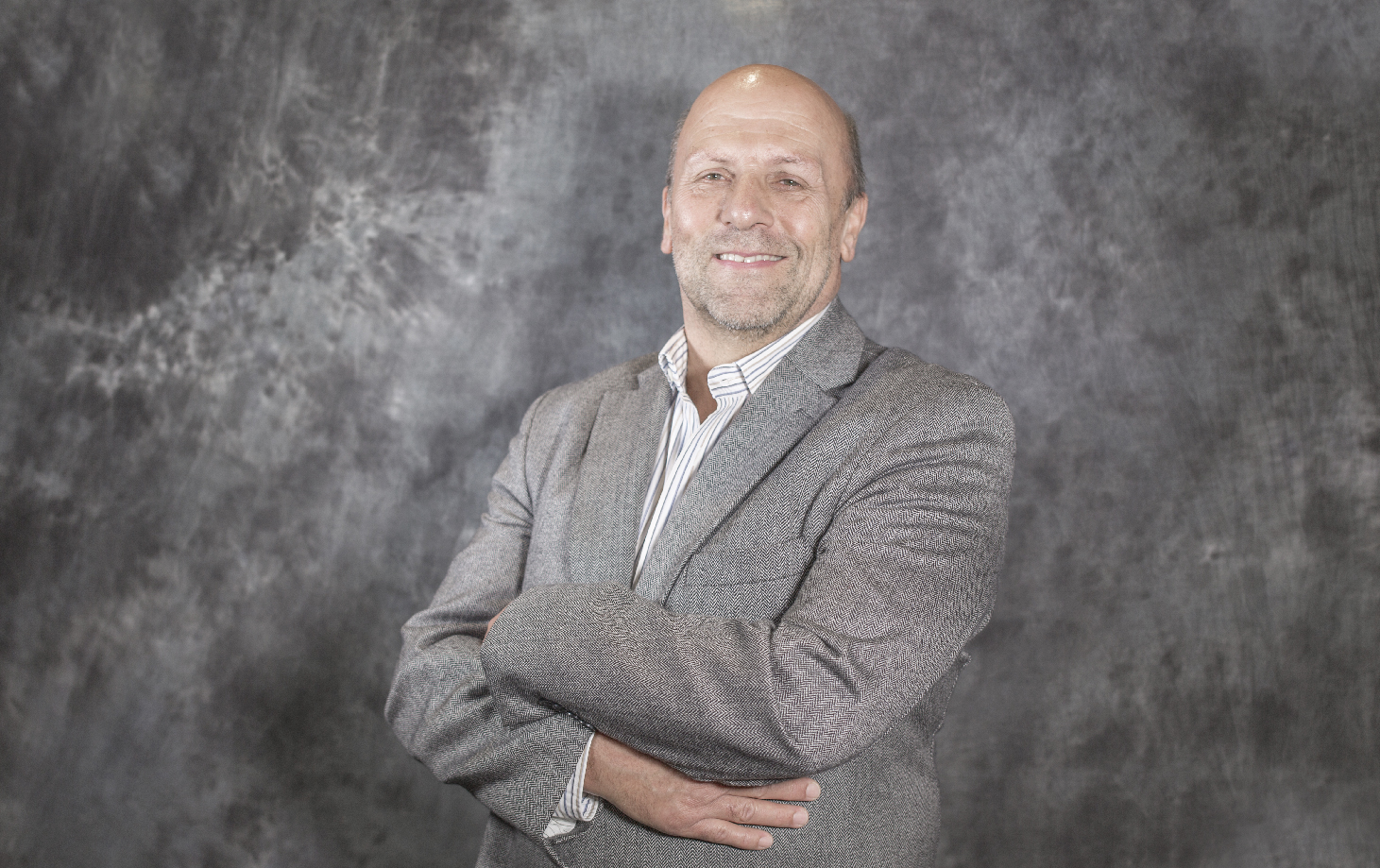
Gold Fields' Vice President of Exploration, Steve Brown, detailed some of the company's plans for Cerro Corona and its new Salares Norte mine in Chile.
What are your expectations for this 12th International Congress of Prospectors and Explorers (proEXPLO 2021)?
In the last 12 months we have experienced - and are experiencing - a unique event that affects the lives of many people and has an impact on the vast majority of companies. It has been a very difficult experience and we are deeply sorry for all the suffering that many people in Peru and around the world have endured.
From the industry's point of view, it has been an opportunity to support not only the national economy but also the communities where we operate, improving the quality of life of many people during this difficult time and becoming an important player in contributing to the health of neighboring communities.
As an industry we have had to adapt at a pace that would have been unthinkable prior to the pandemic, and with that, we see in the 12th International Congress of Prospectors and Explorers (proEXPLO 2021) the opportunity to share and learn best practices from companies regarding how they have handled the challenges that emerged as a result of the health emergency - what were the successes and failures and how we can learn as an industry to implement best practices and establish them as the new industry standards in Peru.
Also, quarantine and movement restrictions have affected the transfer of new information and techniques that are being developed nationwide and around the world; we look forward to hearing at proEXPLO 2021 about new technical advances that we can adapt to our operations.
What aspects can facilitate mining exploration?
The first factor that would help boost exploration projects and investment would be the correct adaptation of environmental regulations (environmental licenses for early drilling stages, prior consultations) and legal regulations for the early stages of exploration, where the risk is high and economic resources are short. Government agencies should improve communication about the positive impact of mining development on society and other industries, such as the agricultural sector.
How would you describe Peruvian geology?
It is very diverse. Composed of sequences of both sedimentary and volcanic rocks both invaded by magmas that carry with them metals such as gold, silver, copper, tin and everything else that forms such an important base for the Peruvian economy.
There is an extensive knowledge base of the country's geology, but it is always good to hear of new discoveries in lesser-thought-of areas, which means there is still much to learn and thus a very broad horizon for future mining growth.
Why is prospecting and exploration important for mining?
Although we now have many high-tech tools, the role of the prospector, who goes out into the field with an idea - or hope - of finding the mineral, is still fundamental. Often all you have is a pickaxe and a good pair of eyes, but the basis of all science is curiosity and persistence, and so prospecting is the foundation of the mining industry.
Exploration applies more scientific criteria to the findings and also begins to apply economic models to the discoveries in order to make the corresponding evaluations on profitability.
What investments does Gold Fields have planned for 2021-2022?
Gold Fields continues to invest in its Cerro Corona mine both technically and with commitments to our surrounding communities and strategic partners; and we are also enthusiastically investing in the search for an asset to replace Cerro Corona, as it is scheduled to close in 2032.
The other investment priority is the construction of the new Salares Norte mine in Chile, which is currently under construction and uncovering phase and will require almost U$ 510 million of CapEx during 2021 to bring the project to a 70% completion level. Project completion and production start-up is expected in 2022.
Do current copper and gold prices favor exploration for these types of mining products?
As prices rise, junior companies become more accessible to capital markets and therefore an increase in the level of exploration can be expected. What might complicate the picture is politics. So for Peru, the mere fact that prices have improved does not imply greater investment in exploration if there is not a stable environment - be it social, political or legal - in which to make investments.
What technologies are being or will be applied by Gold Fields for its prospecting and exploration activities?
We are interested in further applying artificial intelligence in the environments where data density is high enough to allow the formulation of robust algorithms for geology and geometallurgy.
In the exploration field - and being increasingly aware of the concerns of communities regarding mining activities - we follow with great interest the application of AI in the interpretation of remote sensing data such as satellites.
Also, advances in geophysical data collection with the use of UAVs (unmanned aerial vehicles) to minimize the environmental impact of our activities.
In addition, the progress in the development of directional drilling techniques helps us in minimizing the cost of exploration for mineral resources at depth and also the exploration footprint.
What are the professional competencies that Gold Fields will demand in the next 2, 5 and 10 years?
This information is provided by Verónica Valderrama, VP of HR for Gold Fields Americas Region.
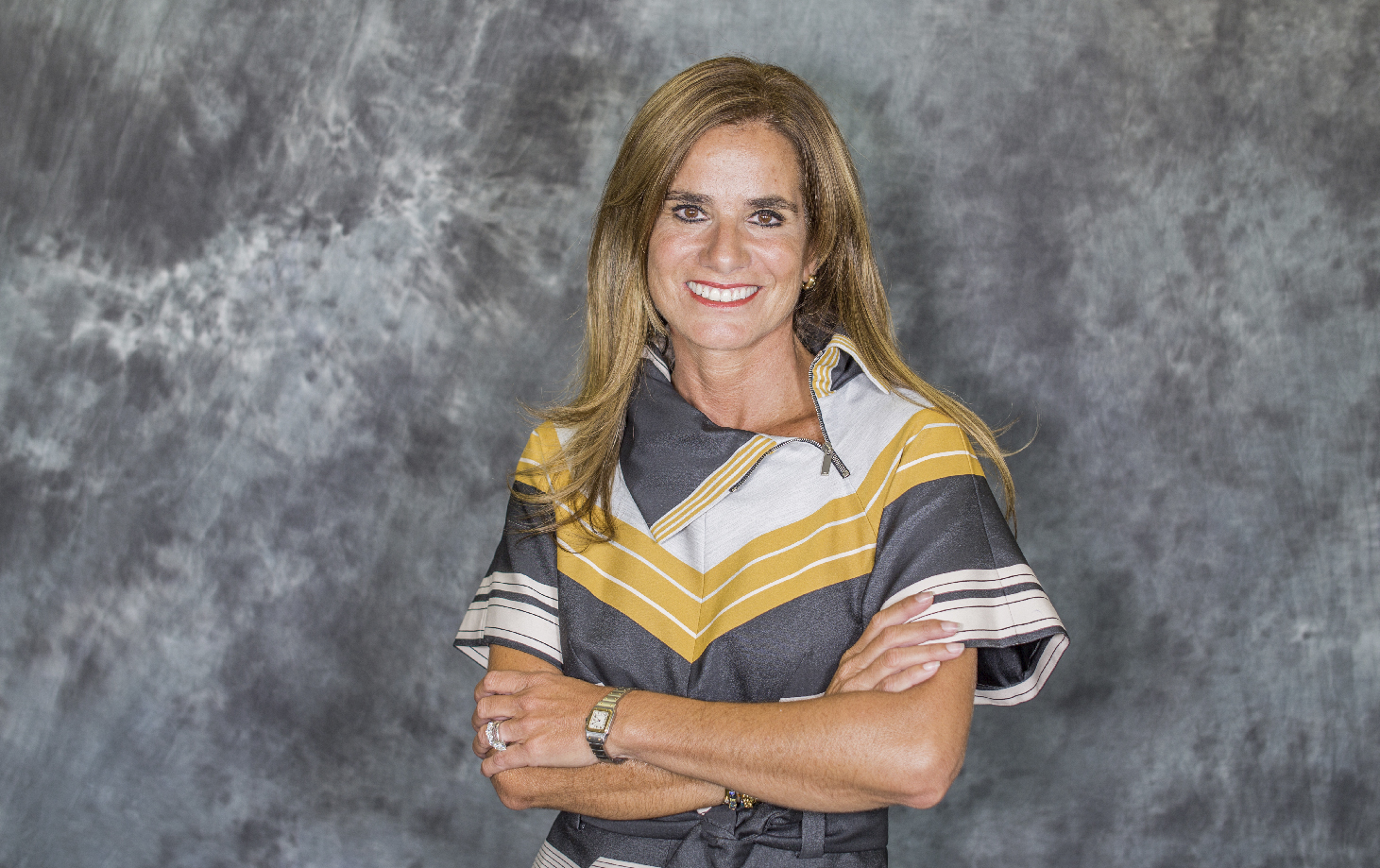
The development of soft skills has become an invaluable necessity for every professional, especially in the mining world where rigidity and harshness have always been characteristic of the industry.
Mining engineers have to be respectful, approachable, empathetic leaders. They must know how to work in a team, give feedback and be able to receive it. Open to direct communication, teamwork and diversity in every sense of the word.
They must be aware of the importance of business sustainability, making their daily tasks an opportunity to care for and respect the environment, stakeholders, co-workers, communities and others.
It is key for professionals to be able to accomplish the following:
- Complete professional: with a great technical and formal knowledge of mining, along with competencies and soft skills that allow him/her to have a deep sensitivity to relevant issues for the mining industry.
- Management without fear of technology: always open to change and based on collaborative work to break paradigms linked to technology. Encourage intergenerational work, so that people learn from those who master digital processes and 4.0 technology tools.
- Competences and creativity: Today there is a predominance of STEM (science, technology, engineering, and mathematics) skills, which must be combined with art and creativity to offer innovative solutions in mining operations, and this will be essential to continue fostering innovation in the industry.
proEXPLO 2021: Mineral Resources for a Sustainable Future
Global mining exploration expenses to recover by 20% this year, according to S&P
 11th March
11th March
Global mining exploration expenses to recover by 20% this year, according to S&P
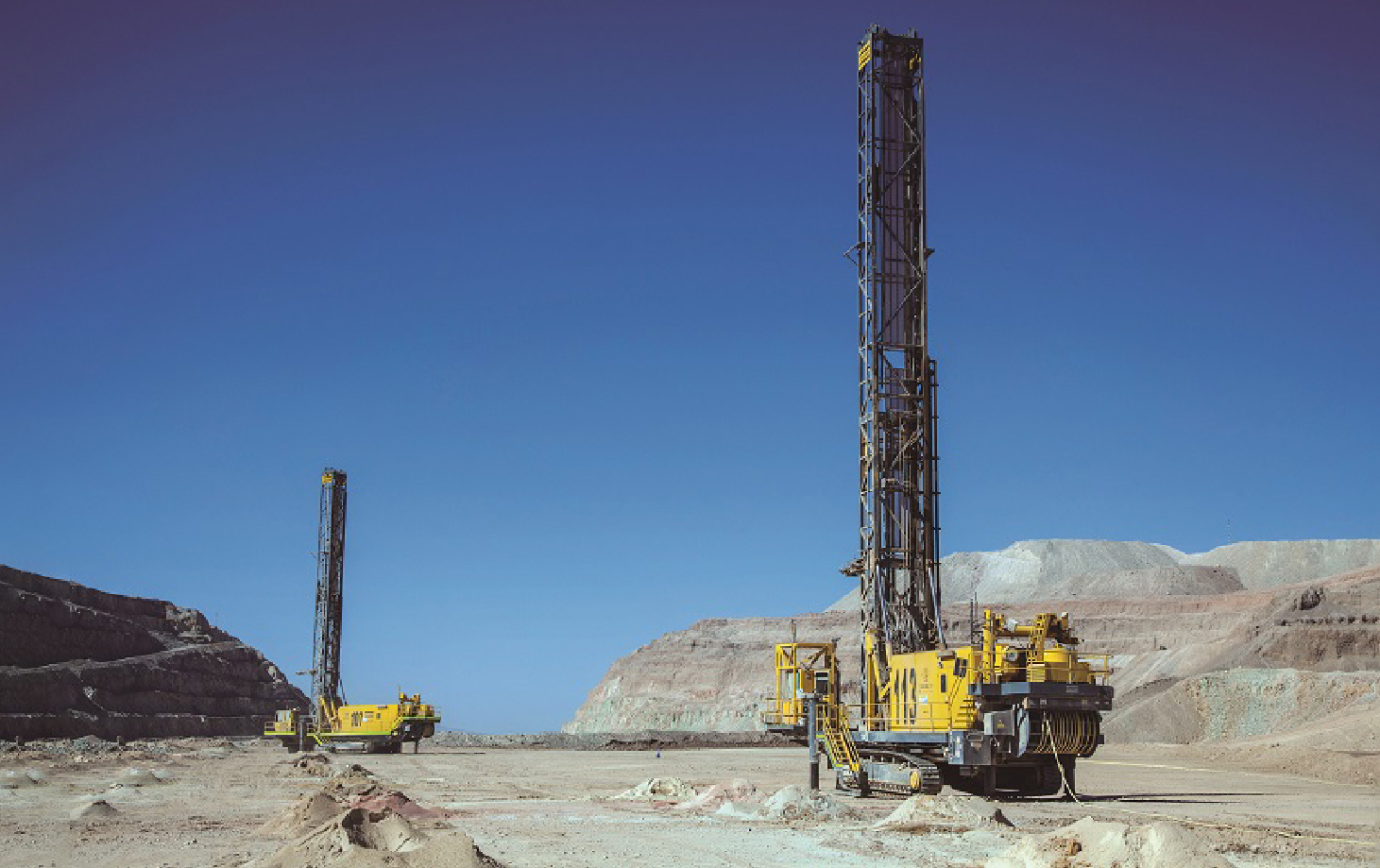
S&P Global Market, a market intelligence and analysis corporation, forecast late last year that the 2021 global non-ferrous metals exploration budget will increase by 20% and would bring it to US$10 billion, surpassing even the 2019 level when US$9.28 billion was recorded.
S&P global had estimated a 10% year-on-year drop to US$8.32 billion in 2020 compared to a year earlier in the global exploration budget.
Even if the COVID-19 pandemic virtually dampened optimism in the global exploration sector, which began to appear in the second half of 20219, fortunately, the mining industry recovered quickly from the initial impact.
Therefore, the rebound is explained by a recovery in drilling activity since June, by the sustained rebound in metal prices, particularly copper and gold (the two most important targets for exploration), and financings returned to pre-pandemic levels.
On site, mining was declared an essential industry in most countries, so closures were relatively brief. All of these factors contributed to the decrease in the 2020 exploration budget being much less pronounced than anticipated at the end of 1Q 2020 (-29%).
COVID-19-related travel restrictions made it difficult to plan large-scale greenfield projects, resulting in overall budget reductions of 11% at major mining companies and 8% at junior companies.
That said, S&P believes that major mining companies have done most of the exploration over the past 10 years, and that scenario will continue, as junior activity will depend on market support.
According to S&P, exploration budgets for gold increased by 1% (US$ 51 million), while those for copper and zinc were the most affected with falls of 24% (US$ 561 million) and 21% (US$ 116 million), respectively.
proEXPLO 2021: Mineral Resources for a Sustainable Future
Ingemmet presents six ANAPs at world mining convention PDAC 2021
 09th March
09th March
Ingemmet presents six ANAPs at world mining convention PDAC 2021
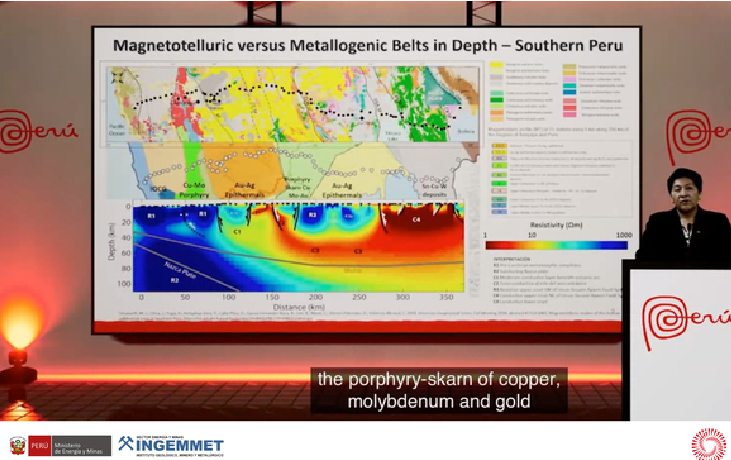
The executive president of the Geological, Mining and Metallurgical Institute (Ingemmet), Susana Vilca Achata, spoke about Peru's geological potential during the world's largest mining convention, PDAC 2021, where she presented six ANAP'S (Areas of Non-Admission of Petitions) in her conference "Ingemmet promotes exploration for world investors".
The head of Ingemmet presented six ANAP'S (Areas of No Admission of Petitions) that have a high probability of existence of deposits related to copper (Cu), gold (Au), zinc (Zn), silver (Ag), among others.
These are the prospects Antabamba Bloque 3 with copper-gold porphyry; Huisani with copper-molybdenum-zinc porphyry-skarn; and Antabamba Bloque 2 with copper-gold-molybdenum porphyry, Mesothermal copper-gold-silver veins. These 3 prospects are located in the Apurimac region.
She also mentioned the prospects Cháparra Bloque 4 (Arequipa) with porphyry copper; Zona 2 (Lima) with zinc-copper VMS; and Pampa Grande in La Libertad with epithermal HS gold, porphyry copper.
She also highlighted the upcoming development and implementation of the online mining claim application form, through which mining claim requests can be submitted online, bringing Ingemmet closer to mining users all around the world and establishing a real time connection with the Mining Cadastre System, among other features.
Engineer Susana Vilca also stated that 840 maps of the National Geological Map at a scale of 1:50,000 were integrated into a geodatabase, divided into 3 WGS zones: 17S, 18S and 19S.
"Digital geological maps and the database allow users to make queries more quickly and efficiently; in addition to autonomously create maps based on their needs", revealed Susana Vilca.
She also presented studies related to mining explorations which database can be obtained through the Geological and Mining Cadastral Information System - Geocatmin, Ingemmet's digital platform that has over 200 layers of information.
On the other hand, the institution specified that, in the world mining convention PDAC 2021, which takes place from March 8 to 11, they are fulfilling the role of promoter of the Peruvian government, in order to disseminate the potential of geological resources and the ordinary mining procedure in strategic spaces to materialize the national objectives regarding economy, competitiveness, employment, among others.
proEXPLO 2021: Mineral Resources for a Sustainable Future
Interview | Raul Parra, head of Antamina's Core Shack
 08th March
08th March
"I predict projects paralyzed by the health crisis will resume in 2021”
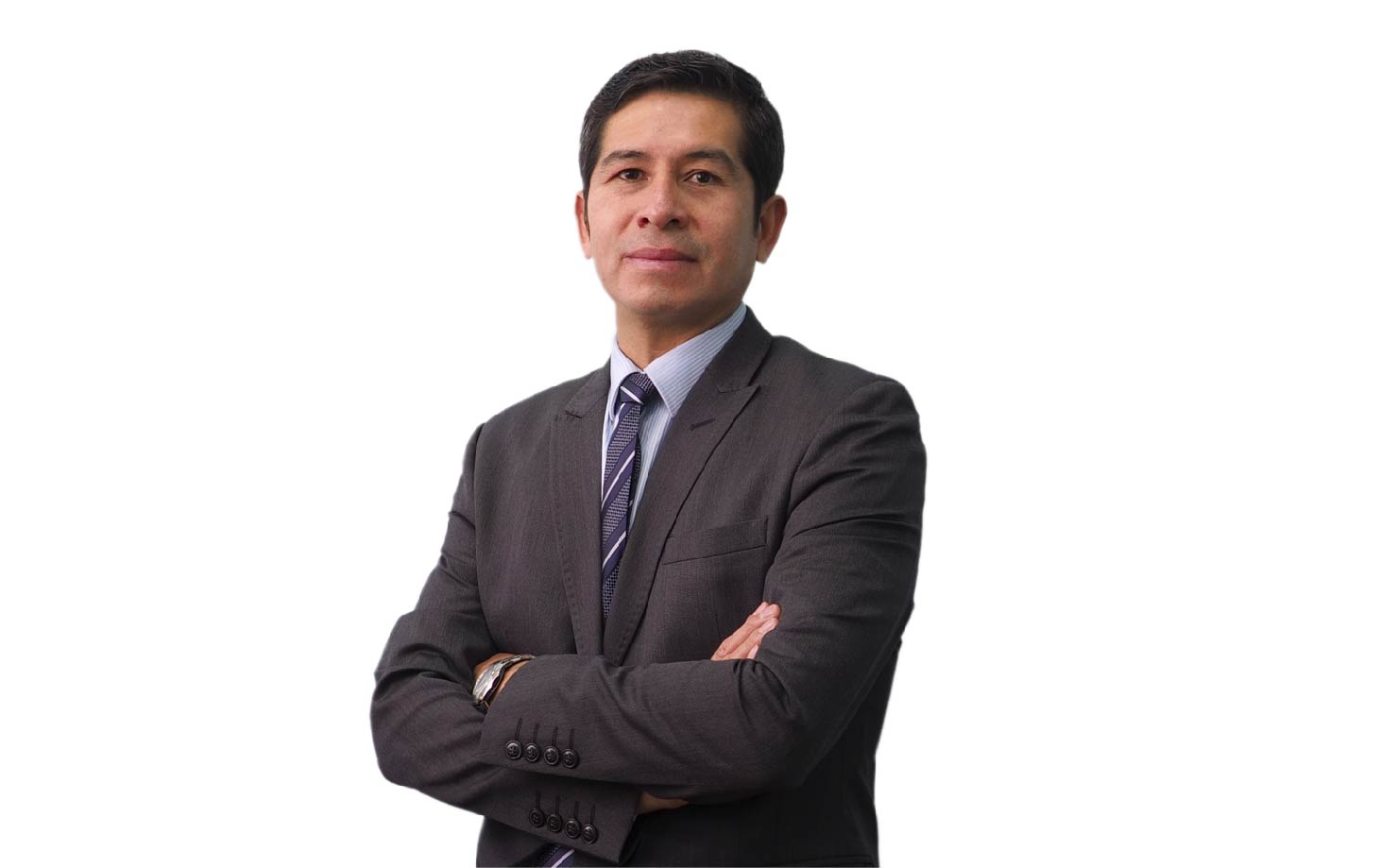
Raul Parra, head of Antamina's Core Shack, considered that the easing of bureaucratic barriers and the improvement and adaptation of regulations for the mining sector would generate more attractive expectations that will help to boost explorations and consequently, to know and increase the country's available resources.
What are your expectations for this 12th International Congress of Prospectors and Explorers (proEXPLO 2021)?
I am very interested and looking forward to participating in the proEXPLO talks, especially on the use of technologies for analysis of geochemical and geophysical data, as also on the demonstrated use of modern equipment for better identification of minerals typical of hydrothermal alterations, which we could use in our projects.
What aspects can facilitate mining exploration?
The first factor that would help boost exploration projects and investment would be the correct adaptation of environmental regulations (environmental licenses for early drilling stages, prior consultations) and legal regulations for the early stages of exploration, where the risk is high and economic resources are short. Government agencies should improve communication about the positive impact of mining development on society and other industries, such as the agricultural sector.
Experts point out that we are facing a great demand for ores around the world. Is Peru doing everything necessary to respond to this new scenario in the global mineral market?
I believe that even though exploration activities in Peru have been developing cautiously, the year 2020 was disastrous for this sector. I predict projects paralyzed by the health crisis will resume in 2021, and new exploration projects will be opened, including not only those focused on base metals, but also on special minerals such as lithium, platinum, nickel, tin and cobalt, which are growing in demand because of changing consumption habits towards modern technologies.
Therefore, the easing of bureaucratic barriers and the improvement and adaptation of regulations for the mining sector would generate more attractive expectations that will help to boost explorations and consequently, to know and increase the country's available resources.
Why is prospecting and exploration important for mining?
Exploration is the main source of research and target generation for future mining projects. Minimizing or not investing in exploration projects would lead to the depletion of already available resources, which would result not only in the withdraw of investments from this sector, but also in the loss of jobs. Exploration also enhances knowledge about Peru's geology, shows project options and encourages investment in the mining sector.
What exploration and exploitation investments does Antamina have planned for the years 2021-2022?
Antamina, as a company, has been working for years on the generation, evaluation and analysis of geochemical and geophysical information, such as the determination of the geochemical and geophysical footprint, based on information from the Antamina deposit, in order to work and refine our exploration targets.
What technologies are being or will be applied by Antamina for its prospecting and exploration activities?
The main technologies we are working with would be the geochemical analysis of thousands of field samples using Machine Learning, the use of lithogeochemistry, magnetometry and spectral analysis of field samples and diamond core.
proEXPLO 2021: Mineral Resources for a Sustainable Future
Contribution of the Mining and Energy sector in the fight against COVID-19
 08th March
08th March
Contribution of the Mining and Energy sector in the fight against COVID-19
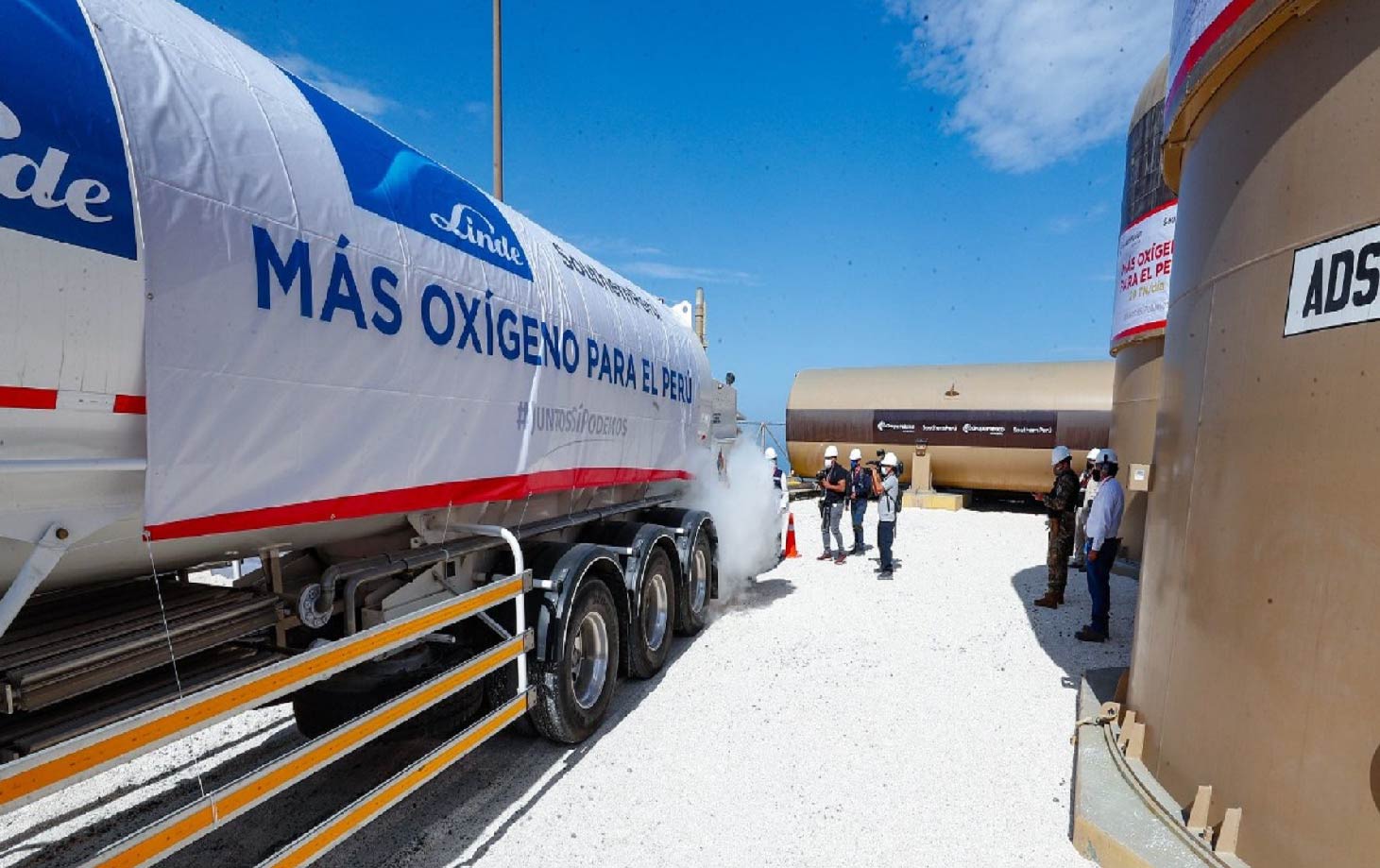
The Ministry of Energy and Mines (Minem) announced that companies of the mining-energy sector have committed to donate 21 plants, 3 concentrators and 1,000 tons of oxygen during this quarter, which will be used for the care of covid-19 patients who have been receiving treatment in public health facilities.
This alliance between companies and the Government took place on February 23, with the donation of 20 tons of medical oxygen per day from Southern Peru, which will be used in 14 health facilities in Moquegua, Arequipa, Ica and Lima. The donation was received by President Francisco Sagasti and the head of Minem, Jaime Gálvez.
Other companies have also donated oxygen plants that will operate in hospitals in Bambamarca (Cajamarca), Mariscal Nieto (Moquegua), Antauta (Puno), Tambobamba (Apurimac), Huaraz and Huallanca (Ancash), Arequipa, Huanuco, Lima, among others.
Meanwhile, in the hydrocarbons subsector, companies such as Petroperu donated an oxygen plant installed in Saramiriza, Loreto region, which will be used to attend the native communities that live in the vicinity of the North Peruvian Oil Pipeline. Also, companies in this sector have been donating oxygen cylinders on a daily basis in the rainforest and northern coast areas of our country.
Additionally, the private sector has been supporting with concentrators, oxygen regulators and other devices. This shows that the joint effort between the public and private sectors is beneficial for citizens and for protecting the most vulnerable groups.
In this way, companies in the mining and energy sector renew their commitment made last year, when they contributed to the fight against covid-19 by donating 30 oxygen-producing plants, 2,905 cylinders and 119 concentrators; reason why this effort, aimed at the welfare of the community, is highlighted by Minem.
proEXPLO 2021: Mineral Resources for a Sustainable Future
proEXPLO 2021 aims to improve the perception of Peru in terms of mining exploration investment
 08th March
08th March
proEXPLO 2021 aims to improve the perception of Peru in terms of mining exploration investment
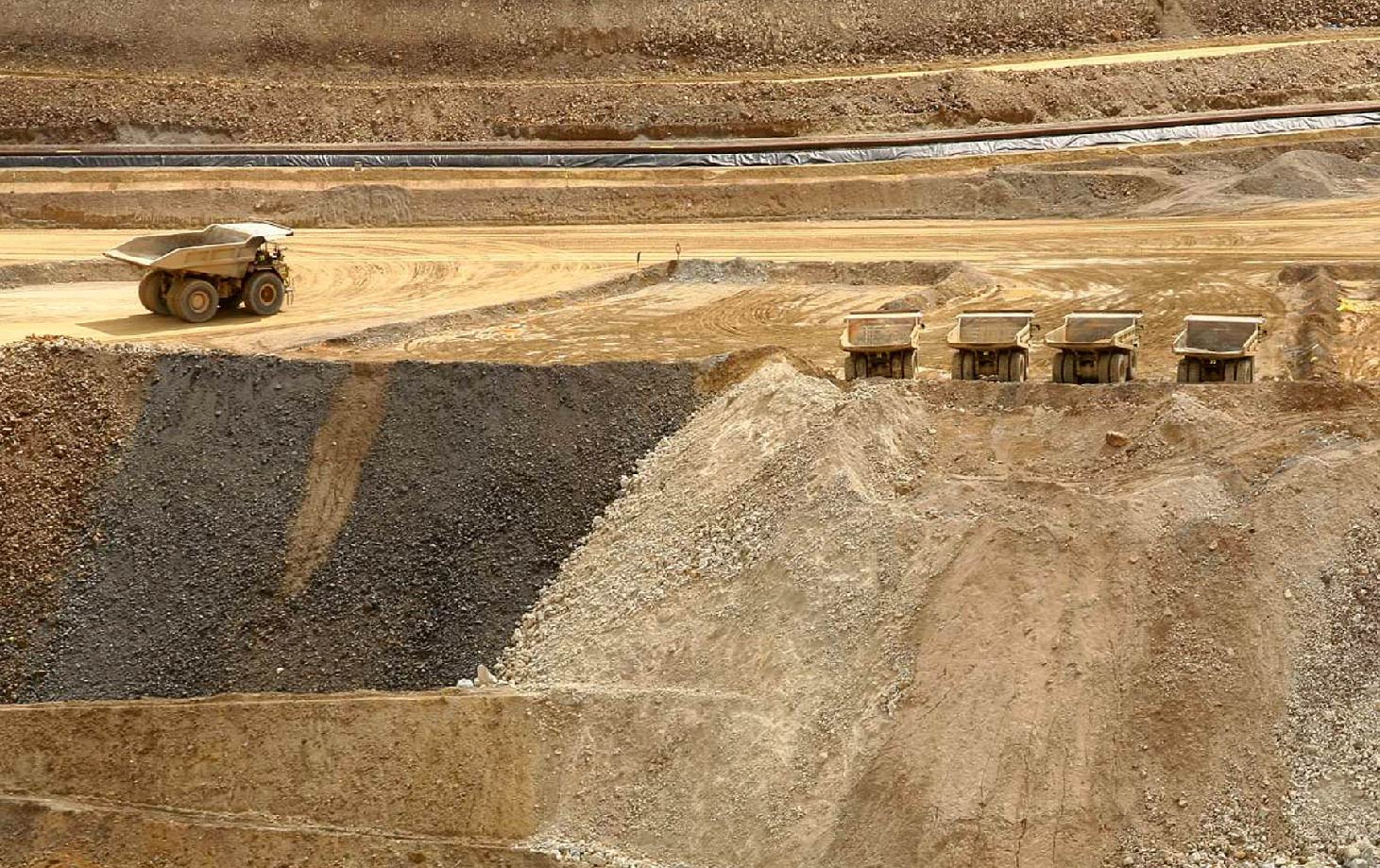
The Fraser Institute's 2020 ranking showed that Peru has regressed not only in attractiveness for mining investment, but mainly in terms of best practices for mining potential; something that is a cause for concern considering that Peru is recognized worldwide for its geological wealth.
In this sense, events like the 12th International Congress of Prospectors and Explorers are oriented to highlight the advances in the exploration projects portfolio of Peru and other countries in the region, as well as the set of measures and plans aimed at emphasizing Peru's status as a mining power.
According to the Fraser ranking, Peru, which ranked 24th in 2019, fell to 34th in 2020 in terms of investment attractiveness, considering a total of 77 mining jurisdictions included in the ranking.
However, the biggest setback occurred in the mining potential best practices, dropping from 12th, in 2019, to 30th place in 2020. That implied a drop of 18 places in one year; while the best position in the five-year period 2016-2020 occurred in 2018 when it ranked 8th.
Making progress in the objective of allowing national professionals to certify mineral resources and reserves is an important step in the task of attending an important demand in the initial mining activity. Hence the importance of having personalities linked to the International Committee for Resources and Reserves Reporting (CRIRSCO) in proEXPLO 2021.
CRIRSCO is a globally recognized organization, supported by the International Council on Mining and Metals (ICMM) as the entity that represents the mining industry in matters related to the classification and reporting of mineral assets.
"The key to achieving one of the mining industry's main ambitions is for Peru to become a member of CRIRSCO and thus encourage national professionals to certify mineral resources and reserves. Under this vision, this will be one of the central themes of the 12th International Congress of Prospectors and Explorers - proEXPLO 2021", explained the congress organizers.
On the other hand, proEXPLO 2021 will not only focus on the importance of exploration activity or the discovery of new deposits, but will also highlight the role of women. This is a step forward in highlighting the contribution of women to the Peruvian mining exploration industry, in a context where the international trend is to emphasize the work of women in economic activities.
On the other hand, the main themes of this proEXPLO 2021 edition are:
- Innovation in exploration: new technological tools applicable to mining exploration will be presented and discussed.
- Exploration success stories: new deposits discovered in Peru and Latin America will be presented.
- Optimal transition: from exploration to mine, oriented to present the engineering processes that turn discoveries into profitable mining operations.
proEXPLO 2021: Mineral Resources for a Sustainable Future
proEXPLO 2021 to highlight the contribution of women in Peruvian mining exploration
 04th March
04th March
proEXPLO 2021 to highlight the contribution of women in Peruvian mining exploration
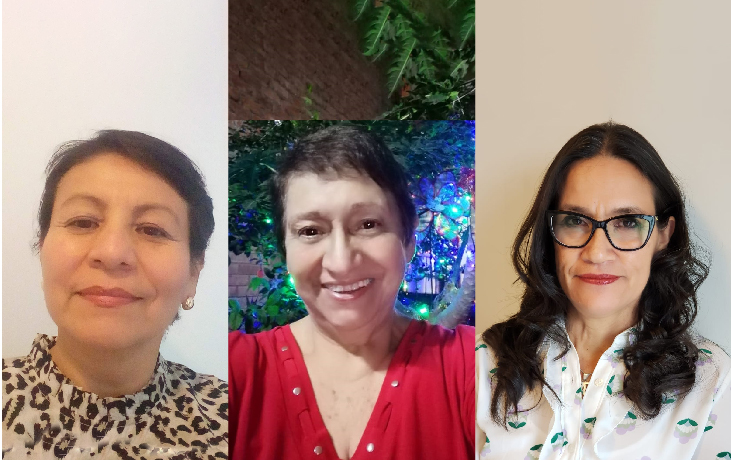
This new edition of the International Congress of Prospectors and Explorers will not only focus on the importance of exploration activity or the discovery of new deposits, but will also highlight the role of women in the mining exploration industry.
Thus, for proEXPLO 2021 -an event organized by the Peruvian Institute of Mining Engineers-, the Round Table "Contribution of women to the Peruvian mining exploration industry" will be held.
This talk will be given by Silvia Kohler, exploration and evaluation geologist with experience in mines and operations of metallic and non-metallic deposits in Peru, Chile and Canada; Clara Indacochea, geological engineer and who has served as representative of Petroperu workers in the period 2013 and 2015; and Maria Manrique, geological engineer and currently engineer in charge of project at the Geological, Mining and Metallurgical Institute (Ingemmet).
"Women have been contributing to the mining industry and the exploration industry for many years. I believe I am not wrong when I say that the myth that women cannot enter the mine has almost been eradicated. Furthermore, there are women working in almost all areas of the mining industry; they are also working in environmental areas, community relations, in the process plant and, of course, in the administrative areas", stated the president of proEXPLO 2021, Eng. Enrique Garay.
For more information on the talks program, please visit: web
proEXPLO 2021: Mineral Resources for a Sustainable Future
Execution of mining projects portfolio would generate 2.3 million formal jobs
 04th March
04th March
Execution of mining projects portfolio would generate 2.3 million formal jobs
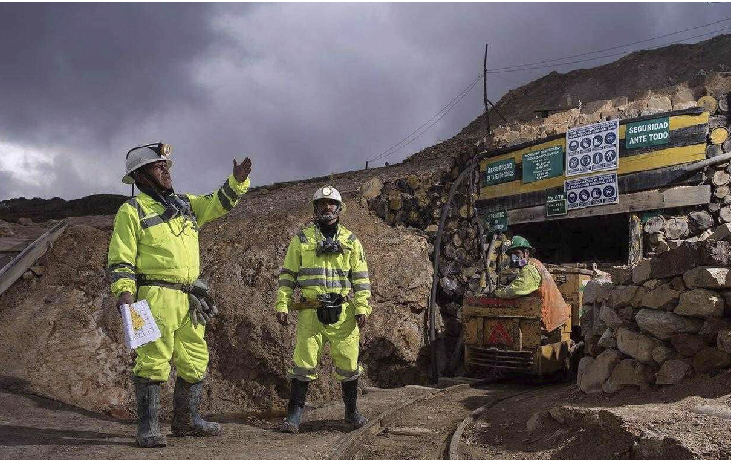
The projects identified in the mining portfolio involve more than US$ 57 billion in investments that, if put into operation, would generate 2.3 million new direct and indirect jobs for the country, which is equivalent to the same number of jobs that have been lost last year due to the negative effects of the COVID-19 pandemic.
That was one of the conclusions of the study "Contribution of Mining to the National Economy", prepared by the Peruvian Institute of Economics (IPE), which was presented as part of the activities "Road to the 14th Gold, Silver and Copper Symposium", to be held in Lima in 2022.
"Mining is an important source of employment generation in Peru, not only because of the quality of jobs it creates directly, but above all, because of the employment it promotes through linkages with other economic activities. Currently, for every direct job in mining, 8 additional jobs are generated", said Diego Macera, manager of IPE.
Economic driver
He also pointed out that mining activity has had a positive impact on the national economy, as it contributes to the dynamism of private investment in a decentralized manner, favoring the development of the country's regions, and added that mining activity represents 10% of the national GDP and accounts for 16% of private investment.
Likewise, the mining sector -he stated- contributes significantly to the Peruvian government's revenues through different concepts, both tax and non-tax, among which are the Mining Royalties, the Special Tax on Mining (IEM) and the Special Tax on Mining (GEM, charges that are not found in other sectors).
Fiscal Impact
In this line, IPE also calculated the fiscal potential of mining activity taking as a starting point the date of execution of the projects according to the portfolio of the Ministry of Energy and Mines (Minem).
Thus, it analyzed two groups, the first made up of 15 mining projects that would be operational by 2025, and a second group of 27 mining operations that would be operational by 2030.
In this regard, Diego Macera commented that based on the estimates of the value of mining production for these two groups, it was calculated that in the first case (15 projects), tax revenues from the mining sector would be generated in favor of the Peruvian State for approximately S/ 43 billion between 2025 and 2035; while the contribution of the remaining 27 projects would be around S/ 96 billion in the period 2030 and 2040.
"At IPE we have calculated that the entry into operation of the two groups of project portfolio would imply an extremely positive impact for the country's development especially if we observe both the direct and indirect effects generated," remarked Diego Macera.
The study revealed that in the first 10 years of operation of these mining projects, a total of S/ 109 billion in direct and indirect fiscal revenues would be generated. In the following ten years, if the second group of projects starts operating, the Government would obtain additional revenues for S/ 240 billion.
Effect on exports
According to figures from the Central Reserve Bank (BCR) in recent years, the mining sector has contributed the most to the country's exports, generating foreign exchange for the stability of macroeconomic accounts.
Between 2010 and 2019, US$24,655 million in mining products were exported annually on average, representing an annual average of 58% of total exports.
The report by the Peruvian Institute of Economics estimated that with the entry into operation of mining projects in portfolio, mineral exports would increase by 66% compared to what was observed in 2017.
"Mining will be the driving force for the recovery and reactivation of the national economy. We need the political will of authorities to move forward with this valuable portfolio of mining projects that will contribute to Peru's development and will allow the Government to obtain more tax revenues to invest in closing social gaps and defeating poverty," said Diego Macera.
proEXPLO 2021: Mineral Resources for a Sustainable Future
Interview | Volcan is focused on developing a solid brownfield exploration program
 03rd March
03rd March
"Volcan is focused on developing a solid brownfield exploration program"
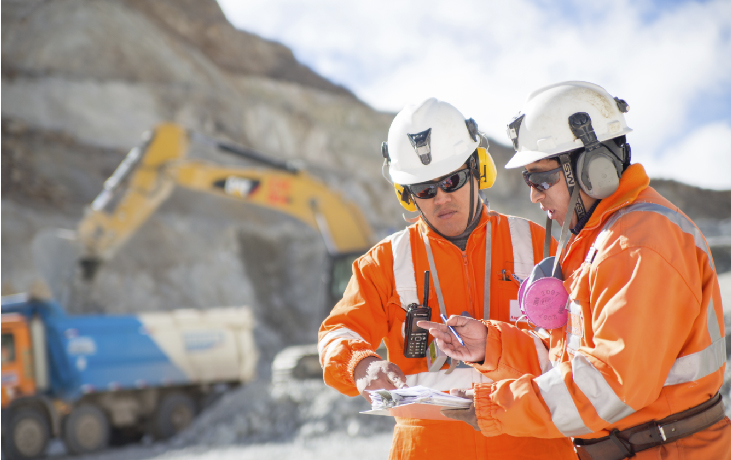
Volcan Compañía Minera also shared their ongoing work to benefit its communities in the context of the COVID-19 pandemic.
This interview was attended by a group of company executives, including Eng. César Farfán, Corporate Geology Manager; Jorge de Olazabal, Environmental Permits Manager, Vanesa Aita, Commercial Manager and Roberto Servat, Social Responsibility Manager.
What are your expectations for this 12th International Congress of Prospectors and Explorers (proEXPLO 2021)?
First of all, to support this important International Congress of Prospectors and Explorers - proEXPLO 2021.
Also, to see the contributions of new projects in an environment where ideas, knowledge and experiences can be exchanged, further enriching our knowledge and therefore the mining industry.
Experts point out that we are facing a great demand for minerals around the world. Is Peru doing everything necessary to respond to the new scenario in the global mineral market?
We are indeed facing a great demand for minerals worldwide, mainly driven by the public spending of the main world powers to reactivate their economies.
The above mentioned is reflected in good commercial terms and prices for producers, however, on the Peruvian supply side we are not prepared due to the following:
a) Age of the mines: In the last 2 years, metal mining production was affected by low grade due to the longevity of a number of mines.
b) New projects: The Ministry of Energy and Mines (Minem) does not foresee the start of any large projects by 2021. Construction of six major mines will begin between 2022 and 2025. Let us hope that social problems and government bureaucracy do not generate further delays.
c) Delays in approvals: The list is of projects put on hold (48 projects) or with delays is large and well known; Conga, Tia Maria, Quellaveco, among many others. This continues to postpone a portfolio of US$ 56,000 million in mining investment projects, according to the American Chamber of Commerce of Peru (AMCHAM).
d) Pandemic: The pandemic caused a total halt of mining activities for several months, which has resulted in lower production and investments for new projects. Currently, the mines are not at 100% production due to the constant infection of their workers. On the other hand, all approvals for new projects are taking longer than usual.
e) Investment attractiveness: our country dropped 10 positions in the important Fraser Ranking published at the end of February, which measures the level of attractiveness of the main countries based on regulatory burden, geological potential, taxes, social agreements, political stability and others.
Red tape has also affected the development of exploration. What issues are pending to be solved in order to speed up exploration investments?
Prior consultation has become a major restriction for the start of exploration and mining projects, even more so considering the current pandemic situation in which it is very difficult to coordinate directly with the population.
On the other hand, there is a lot of uncertainty with the list of indigenous communities managed by the Ministry of Culture, which changes all the time, causing many projects to find out that they have to go through this process when they were supposed to go into operation, causing delays in the schedules and postponement of investments.
Another important issue is the lack of communication that exists between the Minem and the evaluating entities - such as the National Water Authority (ANA) - who take a long time to evaluate and often do not provide an opportunity for clarifications or support from the holders.
What investments in mining exploration does VOLCAN have planned for the next two years?
In the next two years, VOLCAN will maintain its strategy of developing and advancing its most important advanced exploration projects; on the one hand, it will move forward with the Romina feasibility study, which also shows a high potential for further growth, to feed its Alpamarca plant.
On the other hand, it will continue with the economic feasibility study of Carhuacayan that together with Romina will guarantee a great future for Alpamarca. Likewise, Zoraida, located 7 kilometers south of Andaychagua, where mineralized layers with high zinc, lead and silver grades were discovered, will continue to be developed. Finally, exploration will continue at Palma.
VOLCAN is focused on developing a solid Brownfield exploration program in the surroundings of its Mining Units, in order to guarantee a sustained growth of its operations.
It is worth mentioning the discovery, at Andaychagua, of very high-grade mineralized bodies, located in a corridor of metavolcanic rocks that to date is being explored, with more than 10Km long. At Animón, at depth, a large mineralized body of very high-grade zinc was discovered and is currently being evaluated.
What technologies are being or will be applied by VOLCAN for its prospecting and exploration activities?
VOLCAN CÍA. MINERA has been applying state-of-the-art technologies focused on our exploration activities for several years, which have allowed an adequate management of information under procedures established by the mining industry, with the objective of guaranteeing quality information, analysis and definition of geological mineralization controls that are reflected in the resource models as a final product.
In addition, VOLCAN currently has a corporate database that captures, validates and manages data from the different exploration activities and mining operations, as well as synchronization with internal and external laboratories for the different geochemical analyses.
Given the current situation (COVID-19), which has affected all industries and especially mining, VOLCAN is betting on new technologies that will break the barriers of connectivity, with connections outside its own intranet and integrating all its geological processes in a single database; this will allow efficient control of the different activities as well as better decision-making (Drilling, Sampling, QAQC, Laboratories, Geological/Geotechnical Records, Geometallurgy, Modeling, Resource Estimation and Operations).
As part of the technological leap and towards a digital transformation, VOLCAN is evaluating the implementation of mobile devices, as well as the use of unmanned equipment (Drone) specially designed for exploration and underground mining works that will allow obtaining data faster and in real time, with the application of these technologies is expected to achieve an efficient quality control (QC) in all our geological processes.
We should also mention the application in the medium term of new technologies such as AI (Artificial Intelligence) and ML (Machine Learning) that will help to analyze a large amount of information in order to make predictions and find new exploration targets; of course without neglecting the criteria and analysis of our team of geologists who are the fundamental part of the business and who provide us with increasingly accurate knowledge about our deposits, as well as the contribution of new discoveries that will guarantee the mineral resources in the coming years.
What has been VOLCAN's plan in the face of COVID-19 both in its operations and with its communities?
In this pandemic caused by COVID-19, VOLCAN has reconfirmed its commitment to contribute to the health of the communities where it operates. As a result of good communication with local authorities, we were able to deliver important rapid test donations to help detect the virus in Cerro de Pasco and Junín, where our operations are located.
We have also directly donated two oxygen production plants, one for the Daniel Alcides Carrión Regional Hospital in the city of Cerro de Pasco, where we have two mining units, and another for the Cayetano Heredia Hospital in the city of Lima. These plants will supply oxygen to the entire hospital network for the benefit of citizens affected by COVID-19.
Glencore also approved a social fund for pandemic prevention and assistance measures. This fund has been allocated to protect the health and safety of our employees and communities near our units, in addition to seeking to alleviate the economic burden of our communities through coordination and delivery of basic necessities and nutritious food during this emergency period.
At the end of 2020, we managed to use US$ 366,500, equivalent to hundreds of tons of humanitarian aid of basic necessities such as food, warm clothing for the cold weather, delivery of PPEs, fumigators and equipment for rural medical posts benefiting more than 50 communities, populated centers and institutions such as the General Fire Brigade, the National Police of Peru, among others.
It should be noted that the mining reactivation was achieved under strict biosafety protocols involving our operation, community companies, contractors and the general population. We maintained close communication with local authorities to ensure compliance with protocols and safety standards that allowed us to operate without putting at risk any of the stakeholders involved. These agreements with local authorities also included activities to benefit the health of the community, such as disinfection of streets, markets, donation of fumigation backpacks, among others.
We also worked on a communication strategy aimed at our communities of direct influence to reinforce the information provided about COVID-19 and the sanitary measures to prevent its spread. We worked on three communication channels such as our social responsibility magazine, distributed in all communities of influence, as well as radio spots, particularly in our Cerro de Pasco and Chungar Mining Units. We also used our Permanent Information Offices located in the communities to distribute printed information to the population.
Additionally, a document was shared from the Corporate Office to all community companies and contractors including health and biosafety protocols that have allowed to resume the reactivation process during the pandemic and safeguard everyone's health.
proEXPLO 2021: Mineral Resources for a Sustainable Future
Communication, a key factor in the resolution of social conflicts
 01st March
01st March
Communication, a key factor in the resolution of social conflicts
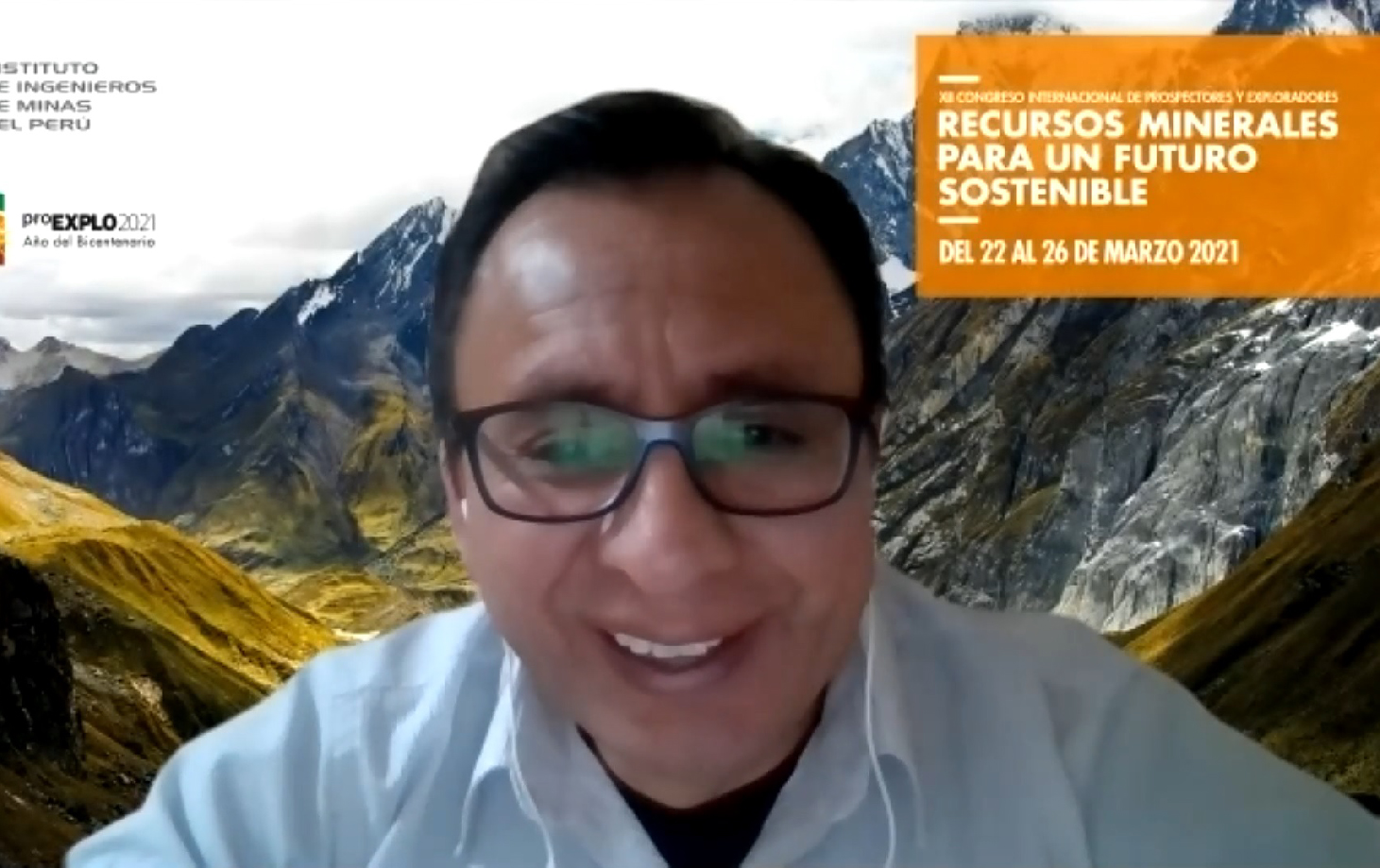
The Superintendent of Social Management at Pan American Silver, Oswaldo Ramirez, participated in the Seminar Road to proExplo 2021 "Social Management in Mining Exploration - Risk and Value Analysis" organized by the Peruvian Institute of Mining Engineers (IIMP).
For the expert in the strategic management of social issues and sustainability in mining and hydrocarbon companies, social management in the mining process has to be dynamic and forget about a "general recipe", because the scenarios are unique and different.
The role of Social Management
"Socio-political risks are always going to be present in all spaces as a consequence of all the actors and each one of them with their own interests and expectations. Therefore, we must be able to look at the interactive process of socio-political risk management that begins with planning, like any process, which continues with the creation of a risk matrix and continues with the adaptation of a structure; in other words, how a company adapts to face each of the risks that are particular to each project", he informed.
In his presentation, Oswaldo Ramírez described the reasons or motives in the communities that generate crises or conflicts due to the presence of extractive projects.
From the anthropological point of view, although the focus is on the behavior of individuals in a given situation, it is necessary to consider the presence of fears due to misinformation or manipulation; there are also beliefs or customs due to local culture.
Therefore, he indicated that there are values or traditions in each community that are not visible but are present and are determinant in the behaviors of the population; therefore, he recommended not to guide social intervention only by looking at behaviors; but also to determine what generates or explains such behaviors.
Likewise, when referring to a socio-political approach, it should be considered that the spaces where mining exploration activities are carried out are spaces where the Government is absent; therefore, processes of poverty, inequality and/or exclusion have occurred; not to mention the processes of disinformation.
"This way, all these facts together generate interests and expectations of the actors, who can manipulate or be manipulated and that situation is going to influence the course of social processes taking place in each of the areas," he expressed.
He also pointed out that communication is essential in conflict resolution, which should seek mutual understanding and work under the win to win logic.
The role of Social Management
"If the parties understand that with the presence of a mining or exploration project they are going to win, the understanding process will be on track; otherwise, it will be difficult. In the same way, work must be done to generate credibility, understanding and reach a mutual agreement so that the reality perceived by the actors can lead to a rapprochement", he emphasized.
Regarding the economic approach, Ramírez remembered that when an exploration project arrives to a territory, expectations arise either to provide goods and/or services to the project, or in terms of demand for technical and unskilled labor.
"The project proposal must take into account these expectations and analyze the potential, competencies and experiences of these local businesses and the local labor force that can be articulated with the demand of the mining project. Therefore, it is important that both contexts fit well in order to achieve project acceptance and conflict prevention," he stressed.
proEXPLO 2021: Mineral Resources for a Sustainable Future
Empathy must prevail in the first contact between companies and communities
 01st March
01st March
Empathy must prevail in the first contact between companies and communities
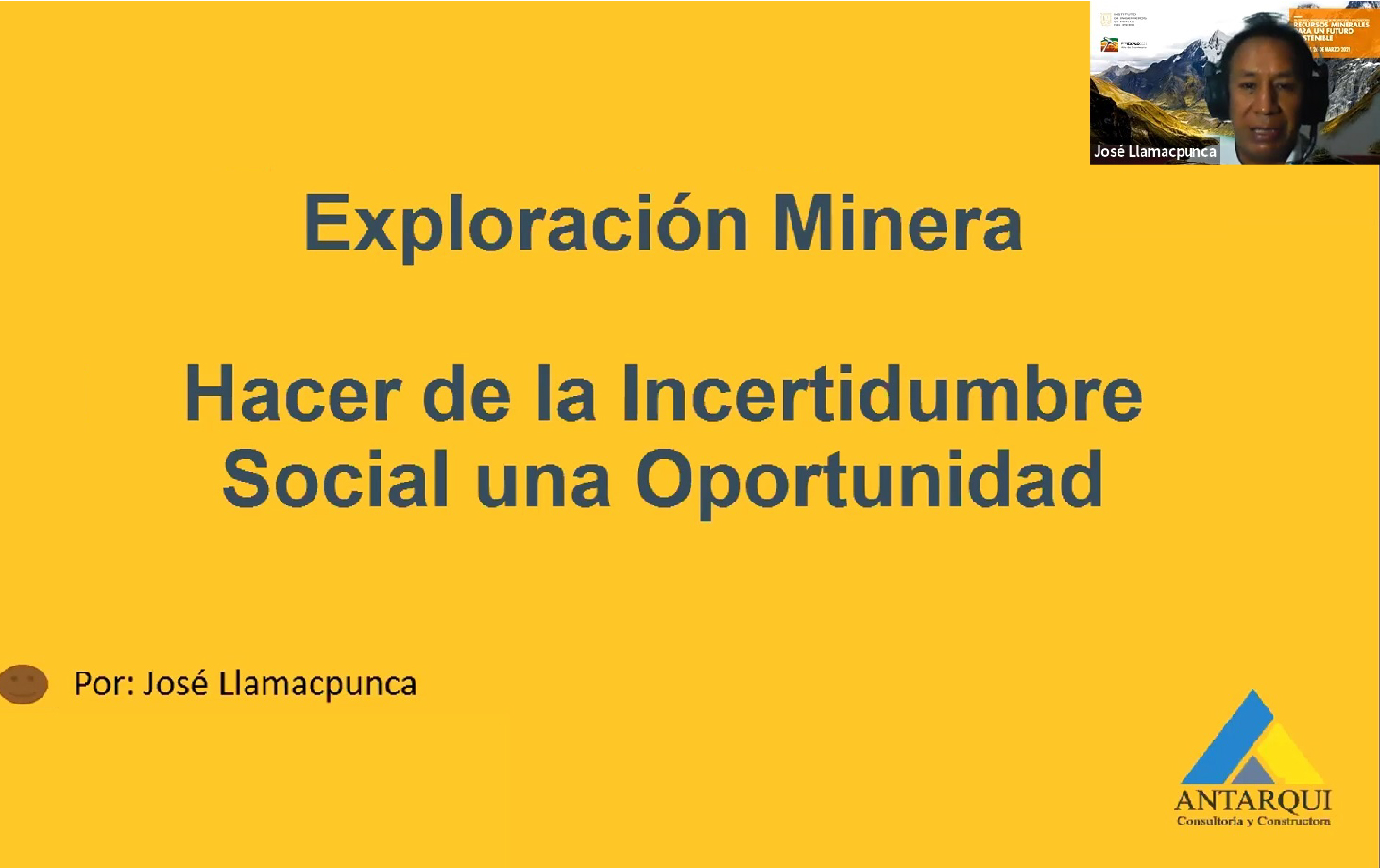
During the conference "Mining Exploration: Making Social Uncertainty an Opportunity", the social manager of Vale Exploration Peru and Consultoría y Constructora Antarqui, José Llamacpunca, questioned the role of some Non-Governmental Organizations (NGOs) regarding mining activity.
"We know that NGOs only intervene where formal companies are, because so far we have not seen them fighting in Madre de Dios against the illegal ones. No NGO fights for the environment or for labor rights or for the protection of territories in those areas; but if they see a formal company that can finance a dialogue or agreement process they are present and we must unmask this type of opportunistic actions," Llamacpunca emphasized.
The role of Social Management
During his participation in the proEXPLO 2021 Seminar entitled “Social Management in Mining Exploration - Risk and Value Analysis,” the specialist in Social Responsibility and Community Relations also highlighted the importance of the role of the Social Management area in mining exploration.
Thus, he indicated that one of its missions is to build trust based on an investment recovery and sales value.
"Good management will maximize the value of the company, and the social aspect is directly related to the capacity to generate positive social impacts and sustainability of the company's institutional image. Therefore, it is essential that social management and investment be key elements in the execution of the business," he said.
He also emphasized that the organization or the company internally must understand the dynamics of social work with the communities.
“Let us remember that the first contact of the mining company with the communities must involve a lot of social empathy and avoid falling into confrontations such as saying that one party owns the surface and the other owns the subsoil, because it will be seen as a scenario of measuring power and strength,” emphasized José Llamacpunca.
proEXPLO 2021: Mineral Resources for a Sustainable Future
Key global trends in the mining industry
 01st March
01st March
Key global trends in the mining industry
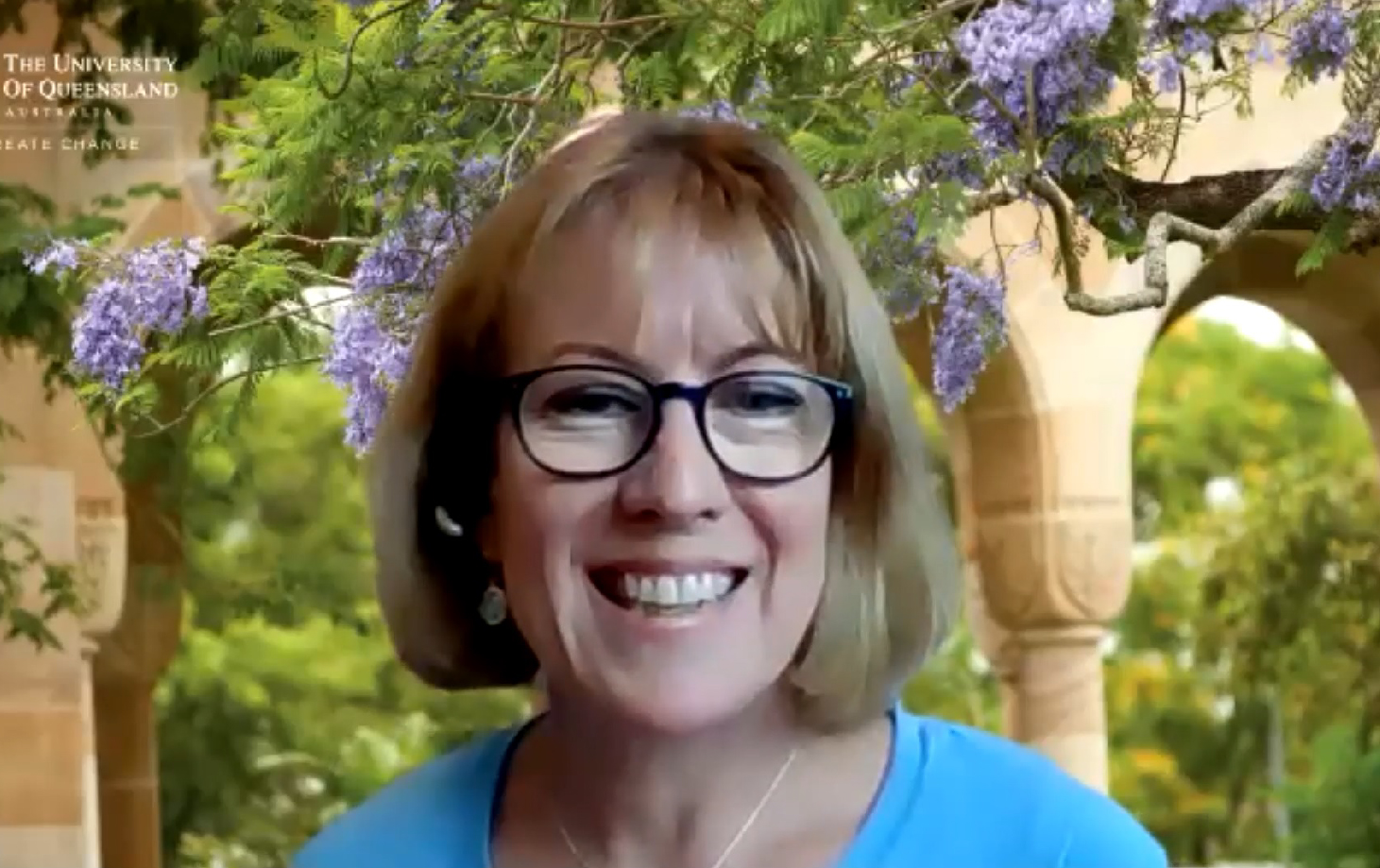
At the Road to proEXPLO 2021 Seminar, the research manager of the Centre for Social Responsibility in Mining of the Sustainable Minerals Institute of the University of Queensland (Australia), Sarah Mackenzie, presented the global trends related to mining.
A fundamental issue for the expert is that exploration teams must start building a knowledge base of the social fabric and economic context; that is, it is essential to know the social context, collect data on communities, demographics, their livelihoods, their cultural practices, the resources they use and what they value, in order to measure their impacts, manage their risks and make informed decisions about the choice of methods or approaches or technologies.
The role of Social Management
"We need to think about the impacts that exploration activities and later mining could have on people, on their environment, on their lives, on their future and act. It is essential to integrate social effects into the exploration phase to ensure that damage is avoided and fair solutions are sought for all," he said.
Thus, in her lecture "Social management in mining exploration", the specialist pointed out that the first trend to analyze is governance, which she defined as the way in which rules, norms and actions are structured, maintained, regulated and accountable.
"Governance approaches are changing, trends are moving away from a linear government-led hierarchy approach to a multi-stakeholder approach where government, civil society and industry work together to develop regulations and governance mechanisms," explained Sarah Mackenzie.
She added that as people are now more involved and interconnected with each other, they expect to be able to participate in decision-making processes that affect them. "This implies greater transparency. So today we are seeing initiatives multiplying in this area, such as the extractive industries transparency initiative; and we are also seeing efforts to improve practice and increase accountability through guiding principles and standards," she said.
Sarah Mackenzie commented that the second trend refers to the increasing inequality of social conflicts. "Considering the social impacts, the human rights of local communities and the risks they run is increasingly present in our industry and that from the beginning of any project. In view of this, we must ask ourselves if we are respecting the rights of communities and if we are providing them with fair opportunities," she said.
Similarly, she stated that the mining industry is in the middle of the line of fire where the links between mining, social justice and environmental problems are established. In this regard, she added that in a context of climate change and resource scarcity, no one can ignore the environmental challenges we face.
"Exploration activities may not have a high demand for water, land-use and energy, but in the future they may and knowledge of the local situation with respect to these resources will influence the evaluation of deposits," she highlighted.
In the ESG era
During her presentation, the CSRM research executive highlighted that within these trends and implications for the mining industry there are Environmental issues; Social issues; and Governance issues (ESG).
"We are seeing that these issues are a priority for investors. They are paying more attention to these ESG players when thinking about where to place their funds," she said.
She also pointed out that the mining industry is seeing deposits that are increasingly complex and present risks related to the environment, social environment or governance.
"It was also found that an increase in the price of minerals would not be enough to mitigate these risks and that if they were not addressed, these risks would continue throughout the mine's useful life, generating negative impacts," she stated.
proEXPLO 2021: Mineral Resources for a Sustainable Future
Interview | Harry Chang, general manager of CORE TECH
 01st March
01st March
"We believe that 2021 will be a good year for mining exploration"
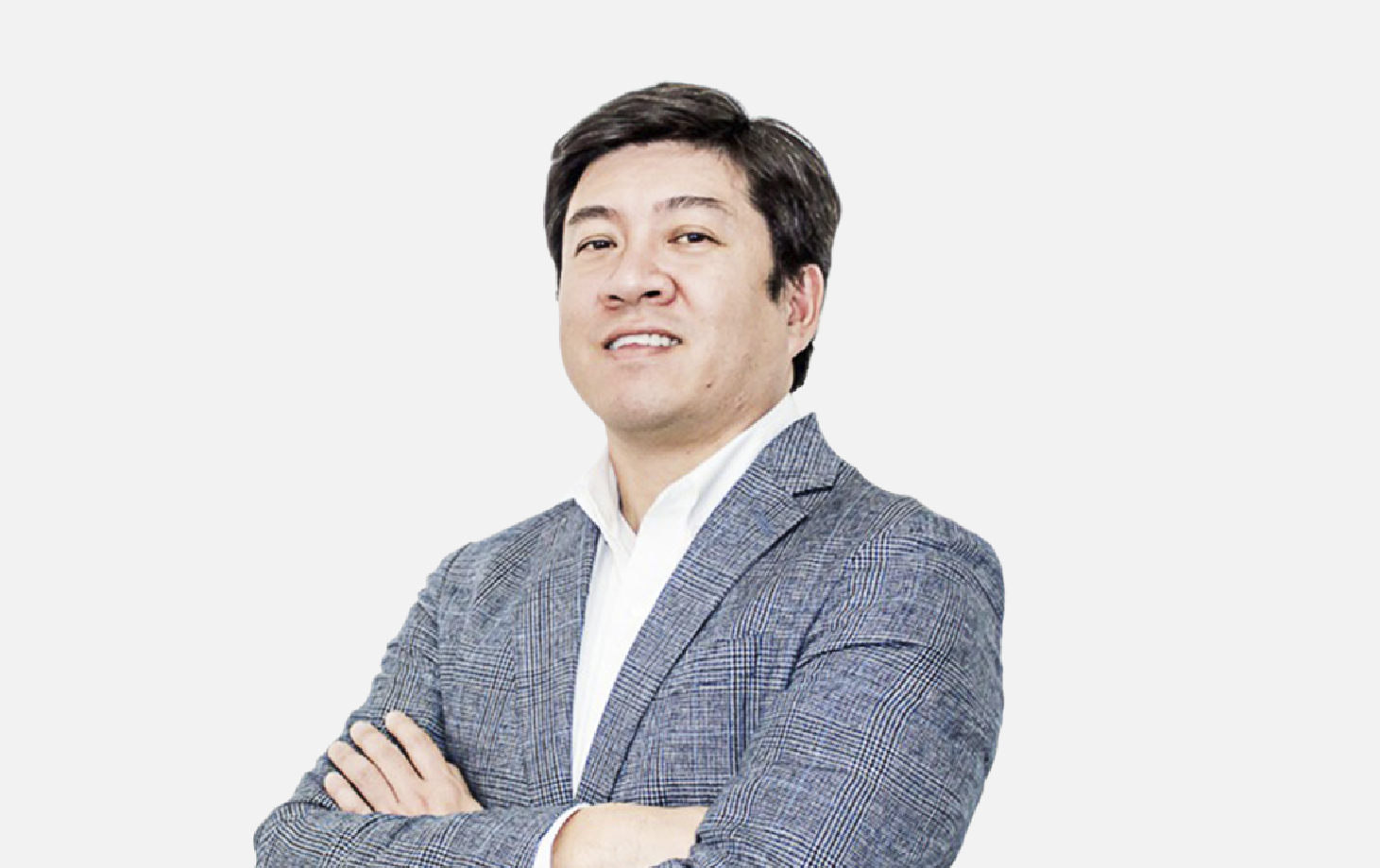
For Harry Chang, general manager of CORE TECH, exploration solutions must be accompanied by experienced engineers and technicians to maximize productivity and manage potential problems.
What are your expectations for this 12th International Congress of Prospectors and Explorers (proEXPLO 2021)?
CORE TECH has been actively participating and contributing to the development of mining exploration in Peru for 24 years.
About proEXPLO 2021, we are looking forward to present our new innovative solutions for the mining exploration sector, which despite the difficulties caused by the pandemic continues to seek efficiencies in its operations. In this sense, CORE TECH will have the opportunity to show these new tools, products and technology, which will generate value to our customers, improving their operations safely.
What investments has CORE TECH planned for the years 2021-2022?
CORE TECH continues to invest in human capital and new technologies for our clients. For this year, we are introducing the mechanical Directional Drilling system, which unlike other systems has multiple operational advantages, in addition to more competitive and environmentally friendly prices. This system allows mining companies to save meters of drilling to reach the targets.
On the other hand, we are introducing the online scanning system for drill holes, which will help in the detection of geological faults, detection of old caves, among others. We also continue to innovate and improve our line of drilling fluids and diamond bits, with a complete portfolio of the highest quality products. And this involves the performance of approved technical tests, through the execution, monitoring, control and technical validation of our products by our field engineers.
Finally, we will present new representative brands in diamond drilling equipment, such as the Italian brand Massenza with large water well drilling rigs and multipurpose equipment, the Dutch brand Eijkelkamp with sonic drilling rigs and CPT. Also, we continue to develop and improve our Semi-Automated Core Cutting Equipment, exporting to several countries in America and Europe.
What technologies has CORE TECH been applying in its work?
CORE TECH has been offering its clients the latest in technology for mining drilling, such as instrumentation for measuring hole deviation; we work with online solutions in the cloud, which allows reliability, speed and consolidation of data for the geology area.
We are also offering directional drilling solutions to perform directional hole deviation and be able to make multiple branches from a single platform (without the need to request permits) in order to cover a larger explored area, reduce costs in the length drilled and reach the mineralized zones. In addition, we are offering an online scanner for drill holes to detect faults, old caves, among others, which reduces uncertainty, prevents risks and reduces costs.
Finally, we offer Sonic drill rigs for exploration, which allows recovering samples in their entirety, in inaccessible areas such as tailings, dumps, very humid areas such as swamps, jungle, etc.
Why is prospecting and exploration important for mining?
Prospecting and mining exploration are the most important and also the riskiest activities, since without them the development and growth of Peruvian mining would not be possible.
Unfortunately, due to various factors, such as over-regulation, excessive controls, cost increases, among others, mining exploration investment in our country has been falling steadily and has dropped from 25th to 34th place in the mining competitiveness ranking. Eventually, current and potential new investors may lose interest in investing in our country.
CORE TECH, always committed to the development of mining exploration, has always been a pioneer in the search for innovations and new technology that allows the mining exploration activity to be more efficient and productive. Also, we market products of the highest quality to achieve greater progress for our customers.
How would you describe Peruvian geology and geologists?
Peruvian geology is highly complex and challenging, which forces us to use products, tools and equipment of the highest quality and reliability in order to achieve the objectives set, both in efficiency, productivity and effectiveness. This is where the "bad savings" often arise and distract from the main core.
The Peruvian geologist is a very complete professional, who has the possibility of training in the different branches of his profession by working in the field and facing the different geological and logistical difficulties that cannot be found in other parts of the world.
At the same time, they are highly valued internationally and with the proper experience and comprehensive academic training they can be successful at a global level.
What has been the main impact of the COVID-19 pandemic on CORE TECH's performance?
Just like all companies in Peru, with the pandemic, CORE TECH saw its economic activity decrease by around 15%. Fortunately, the mining sector was in the first phase of economic reactivation last year, managing to recover what was lost during almost the whole year in the last quarter.
We expect that in 2021, with the good price of minerals and the exploration investment plans of mining companies, we will be able to carry out the amount of exploration that could not be done in 2020. We believe that this 2021, will be a good year for mining exploration, drilling more meters than in 2019.
On the other hand, CORE TECH has been diversifying its presence also in mining production with production steels (Top Hammer, Rotary and DTH) as well as mining production tools and equipment, transferring the experience and prestige already gained in mining exploration to mining production contractors and mining companies.
proEXPLO 2021: Mineral Resources for a Sustainable Future
Mining companies and suppliers confirm their presence at proEXPLO 2021
 22nd February
22nd February
Mining companies and suppliers confirm their presence at proEXPLO 2021
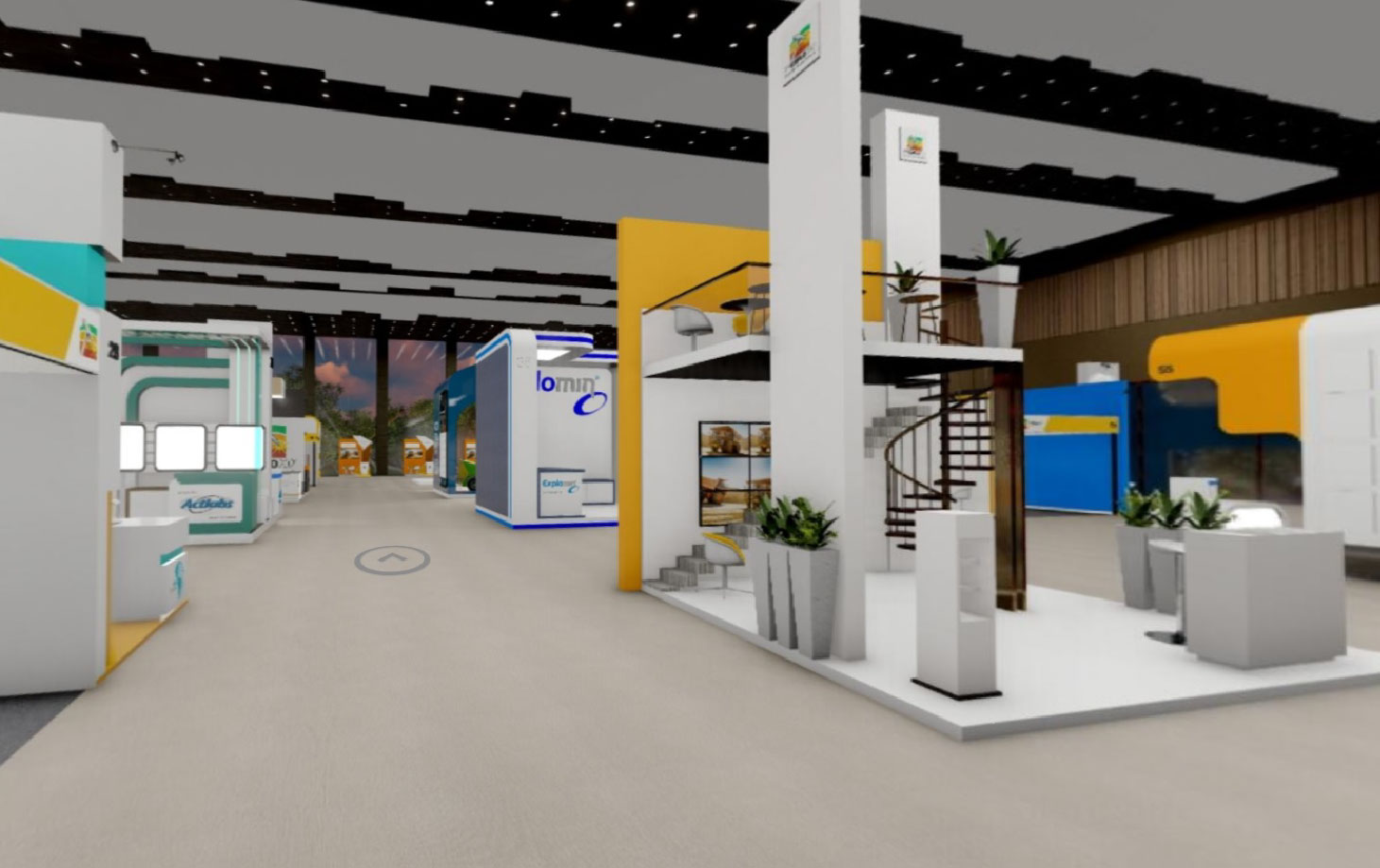
The Peruvian Institute of Mining Engineers (IIMP) is organizing this year the 12th International Congress of Prospectors and Explorers - proEXPLO 2021.
In this edition, the 1st Exploration Projects Fair will be launched as a new platform for commercial relations between small mining investors and large mining companies or investment funds interested in expanding their portfolios.
To date, the participation of Argentina, Brazil, Chile, United States, Australia, Canada, Ecuador, France, United Kingdom and United States has been confirmed.
Likewise, the organizers have developed a virtual platform where mining companies and suppliers will be able to have a space and thus reach out to visitors and participants from Peru and abroad.
Newmont, Hudbay Minerals, Antamina, Panamerican Silver, Nexa Resources Peru, First Quantum Minerals, Gold Fields, Rio2 Limited, Southern Peru and Aruntani have already confirmed their participation.
The Ministry of Energy and Mines, Osignermin, and companies such as Boart Longyear, Rock Drilling, CALQUIPA (Calidra), Explomin del Perú, Core Tech, Redrilsa, among other important companies in the mining sector, will also have booths.
"The proEXPLO 2021 fair is different from the others because it is customized with the designs that the clients themselves have requested," detailed the organizers.
In that sense, interested companies can visit the demo that has been prepared and learn more details of the fair area; to do so, they only have to visit here.
On the other hand, due to the pandemic, proEXPLO 2021 will be held virtually from March 22 to 26 and will bring together important representatives from academia, industry and mining investors.
Also, according to the organizers, proEXPLO 2021 is expected to attract more than 4,000 national and international participants.
proEXPLO 2021: Mineral Resources for a Sustainable Future
Mineral Resources for a Sustainable Future, the slogan of proEXPLO 2021
 19th February
19th February
"Mineral Resources for a Sustainable Future", the slogan of proEXPLO 2021
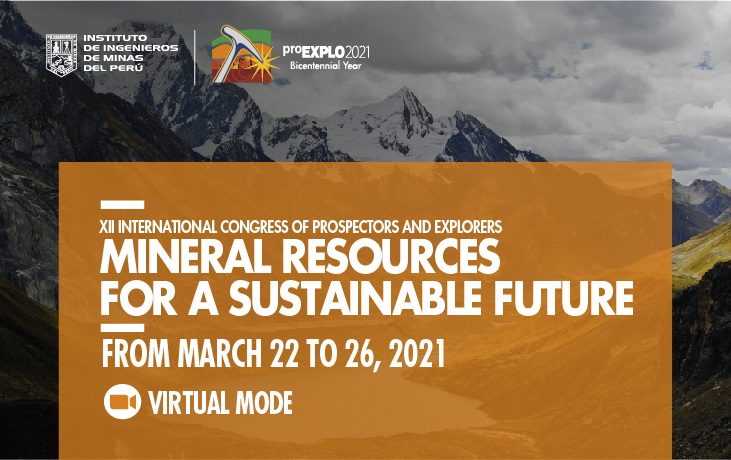
The 12th International Congress of Prospectors and Explorers (proEXPLO 2021), an event organized by the Peruvian Institute of Mining Engineers (IIMP), will be held from March 22 to 26. For this new edition, the Organizing Committee of proEXPLO 2021 -chaired by Eng. Enrique Garay-, agreed on the motto "Mineral Resources for a Sustainable Future" with the aim of emphasizing that in the future humanity will require minerals to create a cleaner world.
"Mining is a fundamental activity for the Peruvian economy and we mining companies are aware of the need to carry out our activities in an environmentally responsible context with a vision for the future, both for the communities in our areas of direct influence and for future generations," said Garay.
Exploration in Peru, which is generally carried out in areas far away from cities with many deficiencies, is an activity where, according to Garay, the geologist is in a certain way the "ambassador" of the mining company. That means that the geologist and his or her team are the first to establish relationships with the communities and plant the seed for a future relationship to hopefully find a deposit and make the relationship last.
"I think that companies have understood that this is the way to do business, to open doors and be new neighbors in a community, because when we arrive in a community, and this must be made very clear, we are the new neighbors, and we implement social responsibility policies; this is not only about generating jobs, but also sustainable development," said the president of proEXPLO 2021.
He also said that this year's edition will seek to continue strengthening the links between the academy, the industry and mining investors.
Currently, there are technologies that contribute to the exploration activity having a minimum impact on prospecting tasks. Eng. Carlos Urrea, member of the Organizing Committee of proEXPLO 2021, pointed out that there are technologies that allow accessing to faster sampling.
"In drilling, European technology is being used for directional drilling, which allows access to different targets inside the deposit to be drilled from very few drilling points. This makes it much easier in terms of time, deadline and budget," said Urrea.
On the other hand, the thematic axes of proEXPLO 2021 are:
- Innovation in exploration: new technological tools applicable to mining exploration will be presented and discussed.
- Exploration success stories: new deposits discovered in Peru and Latin America will be presented.
- Optimal transition: exploration to mine, oriented to present the engineering processes that turn discoveries into profitable mining operations.
proEXPLO 2021: Mineral Resources for a Sustainable Future
Moquegua ranked first in terms of investments in 2020
 19th February
19th February
Moquegua ranked first in terms of investments in 2020
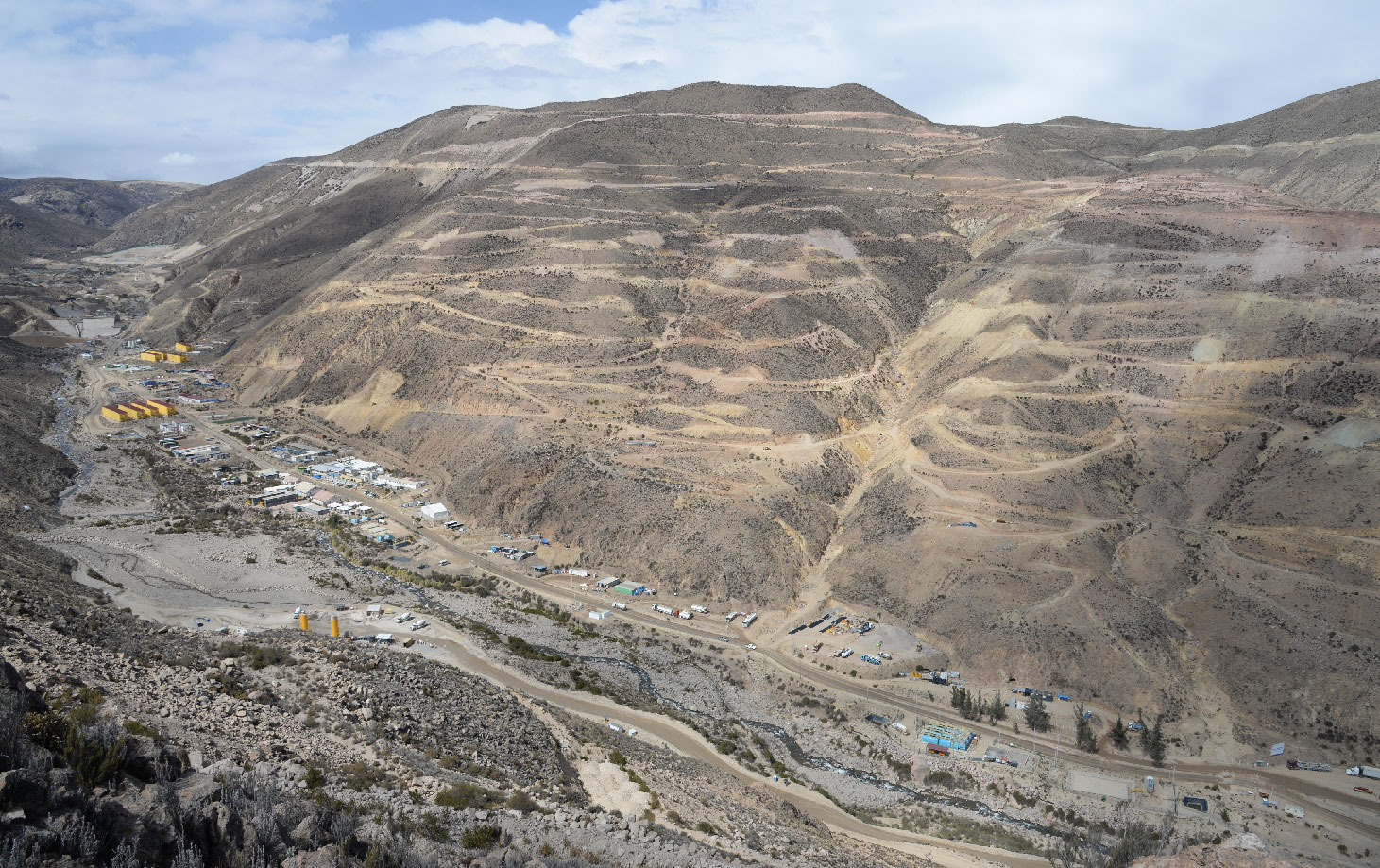
The Ministry of Energy and Mines (Minem) reported that a total of US$ 1,410.5 million of mining investment was executed last year in the Moquegua region, which represented 32.5% of the total amount reached nationally (US$ 4,334 million).
"In this way, Moquegua ranked as the first region in terms of investments in 2020 followed by Ica (13.5%) and Junin (9.5%), according to the Mining Statistical Bulletin (BEM) of the Minem, corresponding to December 2020," reported the ministry.
It also stated that the construction of the Quellaveco copper project -owned by Anglo American and located in the province of Sanchez Cerro- represented the great majority of investment executed in 2020 in the region and the country: US$ 1,313.8 million.
Impact on employment and taxes
The Minem also specified that, in December, Moquegua was the region with the second highest number of direct employment in the mining sector with 22,650 workers, which represented 11.4% of the national total. "Again, the construction of Quellaveco was the reason for this important result", it pointed out.
It should be noted that direct jobs in the mining sector have a positive effect on the generation of indirect jobs.
On the other hand, the transfers for mining concepts that Moquegua received by December 2020 amounted to almost S/ 240 million: about S/ 180 million corresponded to the canon minero; S/ 51.2 million to royalties; and about S/ 9 million to the operational rights and penalty.
proEXPLO 2021: Mineral Resources for a Sustainable Future
Ingemmet publishes for the first time the soil geochemistry of the Amazonian Plain
 19th February
19th February
Ingemmet publishes for the first time the soil geochemistry of the Amazonian Plain
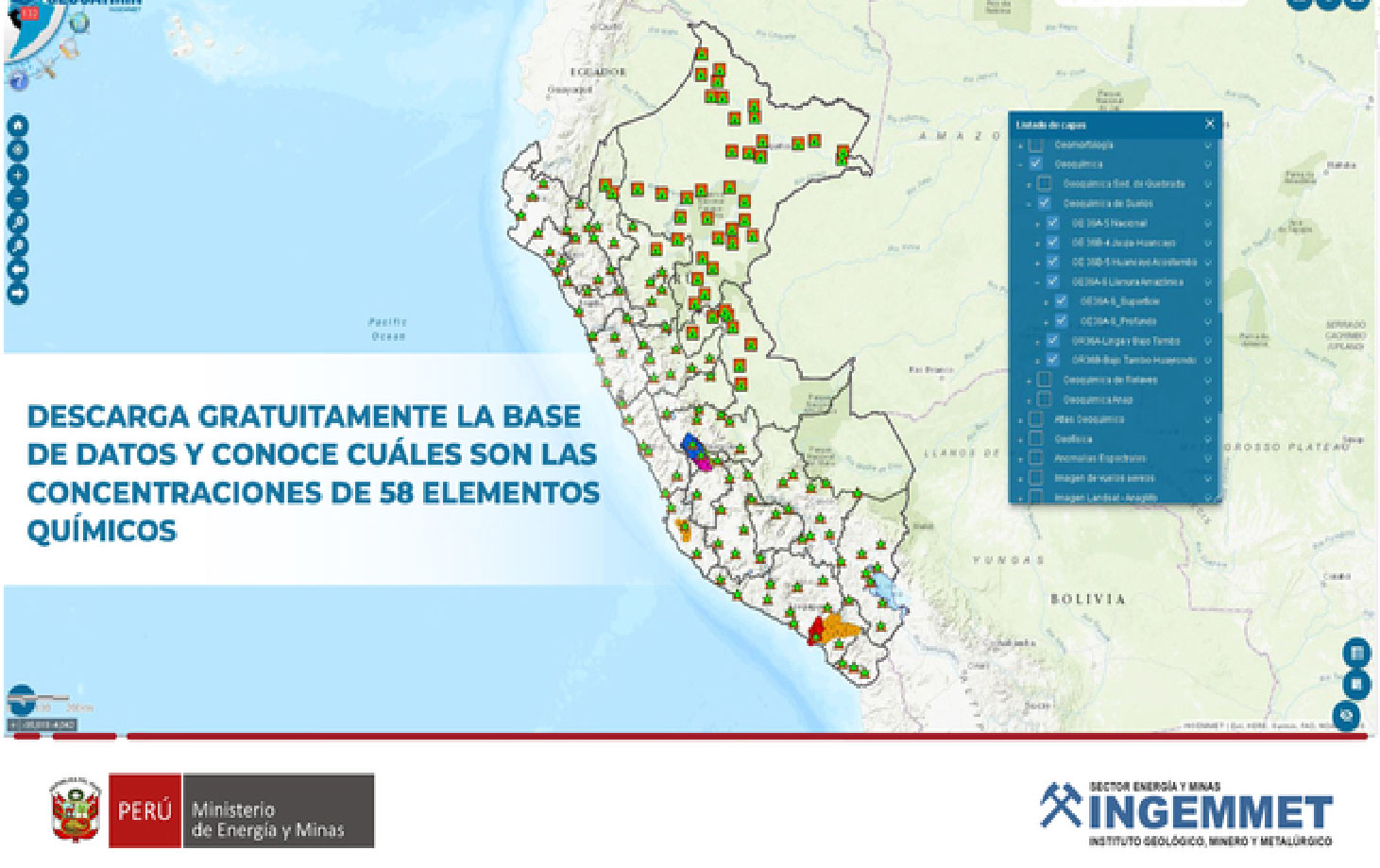
The Geological, Mining and Metallurgical Institute (Ingemmet) invites its users to learn about the soil geochemistry of the Amazon plain.
“This database contains information on chemical results from 48 samples of surface soils and 48 samples of deep soils from the Peruvian Amazon”, Ingemmet explained.
It added that each soil sample was analyzed in the institution's laboratory and concentrations of 58 chemical elements and ten major oxide elements were determined, including gold, silver, copper, molybdenum, lead, zinc, cobalt, vanadium, chromium, nickel, iron, tin, lanthanum and cerium.
Ingemmet also stated that the purpose of this database is to make updated, timely and quality chemical information freely available; in addition to being a basic source for mining exploration, environmental management actions, geoagriculture, geo-medicine, land-use planning policies, among others.
"Ingemmet's research projects generate geoscientific information; as well as support information for the different Activities and Projects of the DRME, Ingemmet, public institutions and will contribute to the development of research in mining exploration in Peru, geoenvironmental baseline, medical geology and processes of ecological-economic zoning and land-use planning, among others," it reported.
The public can download the database for free and learn about the concentrations of 58 chemical elements: http://metadatos.ingemmet.gob.pe:8080/geonetwork/srv/spa/catalog.search#/metadata/a7443649-79d8-4e74-80e8-4e622d2a6e28.
proEXPLO 2021: Mineral Resources for a Sustainable Future
In December, domestic copper production recorded the highest volume of the year
 12th February
12th February
In December, domestic copper production recorded the highest volume of the year
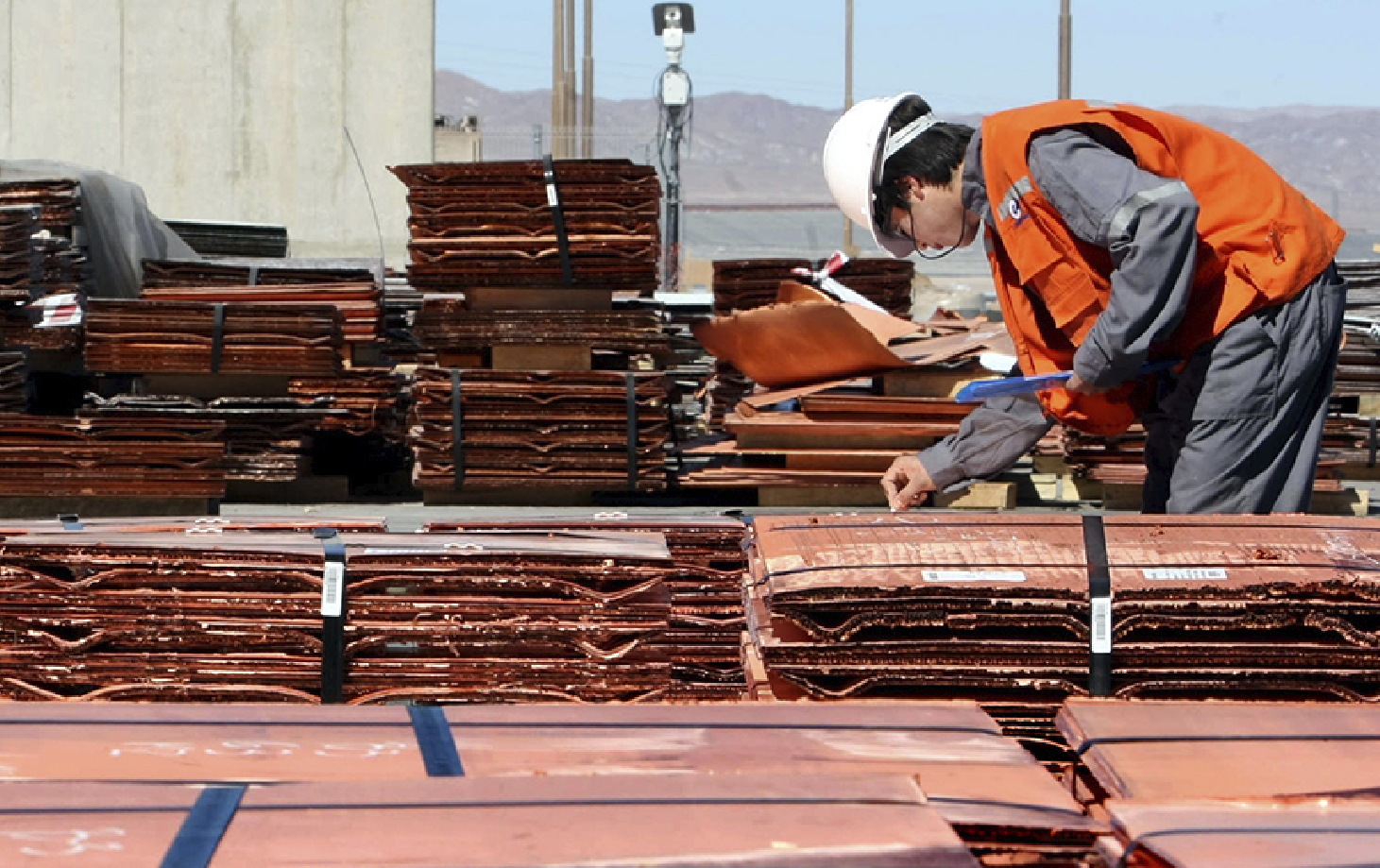
In December 2020, national copper production recorded the highest volume of the year, reflecting a significant recovery of 7.6% compared to the previous month and being very close to closing the year-on-year gap for the second time.
This was stated by the Ministry of Energy and Mines in its statistical bulletin updated as of December last year.
"In the last quarter of the year, the highest ore extraction was reported, representing 29.6% of the total produced in 2020. Despite this, a year-on-year contraction of 1.6% was obtained, going from 225,496 fine metric tons (FMT) in December 2019 to 221,980 FMT in December 2020", commented the Minem.
It added that due to the results of previous months, especially what was obtained during the first half of the year, total copper production in 2020 (from January to December) closed at 2'149,246 FMT, a value that represented a contraction of -12.5% compared to the 2'455,440 FMT of the same period of 2019.
Regions and companies
On the other hand, the Minem detailed that in 2020, Ancash ranked first in national copper production with a share of 18.6%. In second place was Arequipa with 18.3%, while in third place was Apurimac with a 14.6% share.
In terms of companies, Southern Peru Copper Corporation ranked as the first copper producer with a 19.7% share. Similarly, in second and third place were Compañía Minera Antamina and Sociedad Minera Cerro Verde with 18.4% and 18.0%, respectively.
proEXPLO 2021: Mineral Resources for a Sustainable Future
Social Management in mining exploration to be discussed at road to proEXPLO 2021
 12th February
12th February
Social Management in mining exploration to be discussed at road to proEXPLO 2021
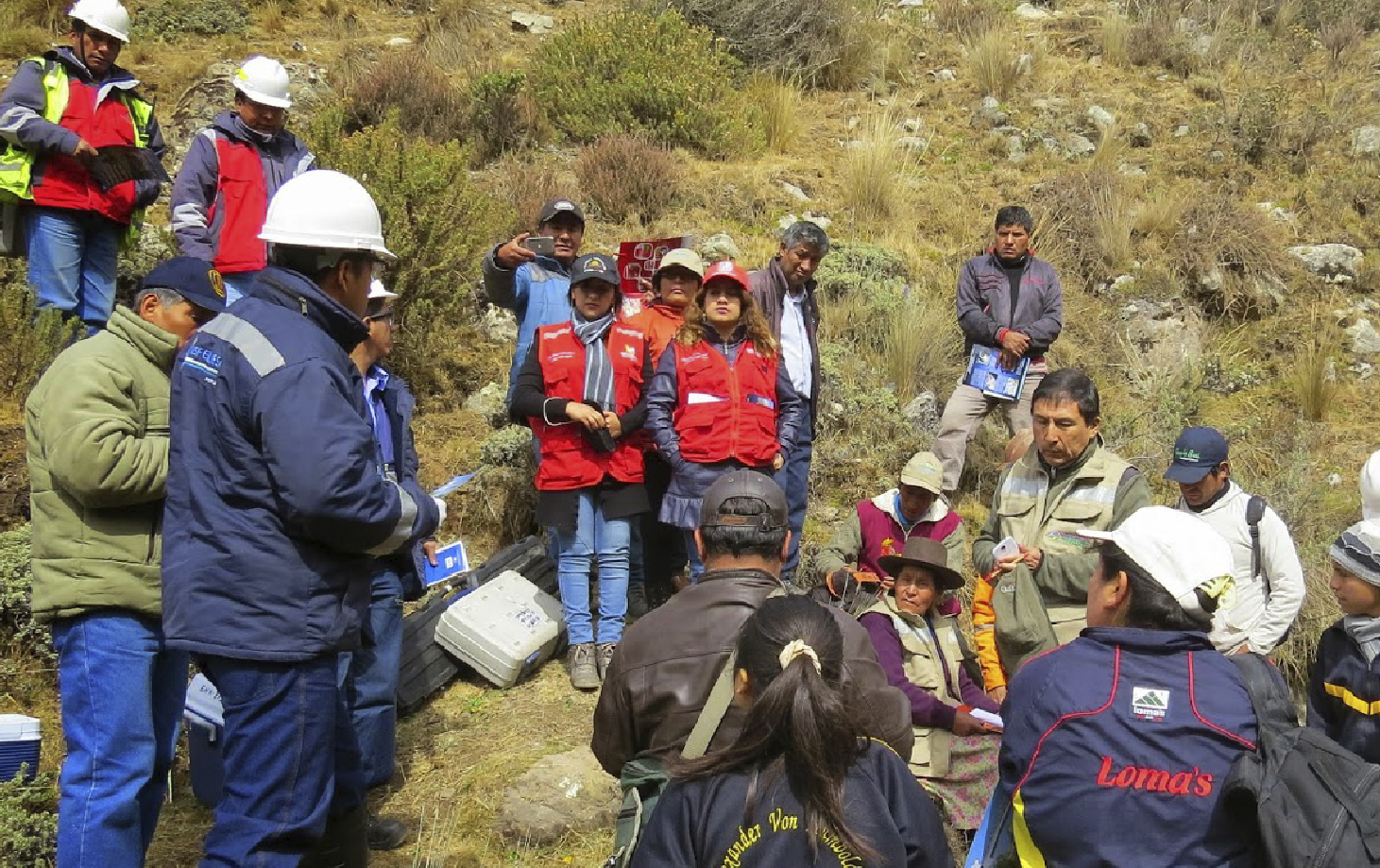
In this sense, this Tuesday, February 23rd at 6:00 pm, the virtual seminar "Social Management in Mining Exploration - Risk and Value Analysis" will be held and will be moderated by Andrés Recalde, member of the Organizing Committee of proEXPLO 2021, and consultant on social management strategies and lecturer.
As a reminder, this year the Peruvian Institute of Mining Engineers is organizing a new edition of proEXPLO, which will be held virtually from March 22 to 26.
According to the organizer, the seminar will be given by MSc. Sarah Mackenzie from the University of Queensland (Australia) who will present some aspects of the global context in which mining exploration activities are developed, the implications for exploration and what can be done to integrate social performance at the beginning of the life cycle of a mining project.
Also participating will be Mgtr. Oswaldo Ramirez Tuya from Pan American Silver (Peru), who will share some lessons learned based on his experience in the Peruvian case and will address the possibilities and limitations in the implementation of tools and methodologies that are usually used in social management during explorations.
Also present will be Mr. Jose Llamacpunca Huamán of Antarqui (Peru), who has worked in the companies Xstrata Peru and BHP Billiton Tintaya, as well as being a community advisor for mining negotiation issues in the regions of Cusco, Apurimac and Moquegua and is currently providing advice and consultancy in social management, land negotiation, among others in different cities of the country, including exploration projects of Vale Exploration Peru.
proEXPLO 2021: Mineral Resources for a Sustainable Future
proEXPLO 2021 Congress will address Peru joining CRIRSCO
 12th February
12th February
proEXPLO 2021 Congress will address Peru joining CRIRSCO
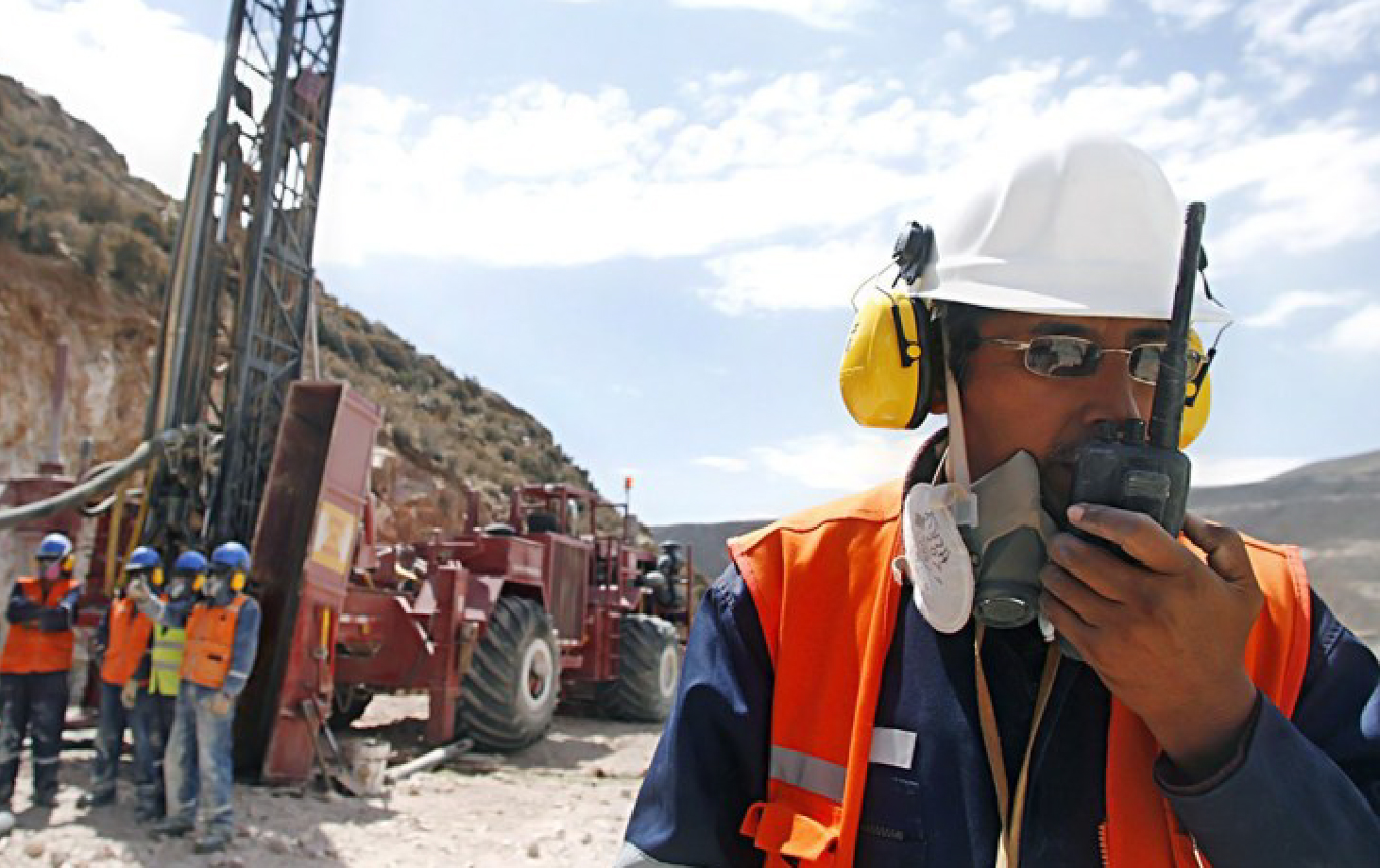
The International Committee for Resources & Reserves Reporting (CRIRSCO) is a globally recognized body, endorsed by the International Council on Mining and Metals (ICMM) as the entity that represents the mining industry in matters related to the classification and reporting of mineral assets.
"The way to realize one of the main aspirations of the mining industry is for Peru to be part of CRIRSCO and thus encourage national professionals to certify mineral resources and reserves. Under this vision, this will be one of the central topics of the 12th International Congress of Prospectors and Explorers - proEXPLO 2021", detailed the congress organizers.
Thus, for the session on Friday, March 26, the president of the board of directors of the Brazilian Commission for Resources & Reserves (CBRR), Julio Nery, and the representative of this organization to CRIRSCO, Edson Ribeiro, have been invited.
The president of the Colombian Commission of Mineral Resources and Reserves, Wilfredo López, and the head of the Chilean Commission for the Qualification of Competencies in Mineral Resources and Reserves, Sergio Vicencio, have also been invited to participate. Samuel Canchaya, general manager of Sampling OK, will participate representing Peru.
Those interested in participating in this conference and others to be held in proEXPLO 2021, can register here: link
proEXPLO 2021: Mineral Resources for a Sustainable Future
Interview | Eng. Martín Barrios Domínguez, Executive Director of Calidra Peru
 12th February
12th February
“proEXPLO will allow us to learn about new technologies applicable to mining exploration”
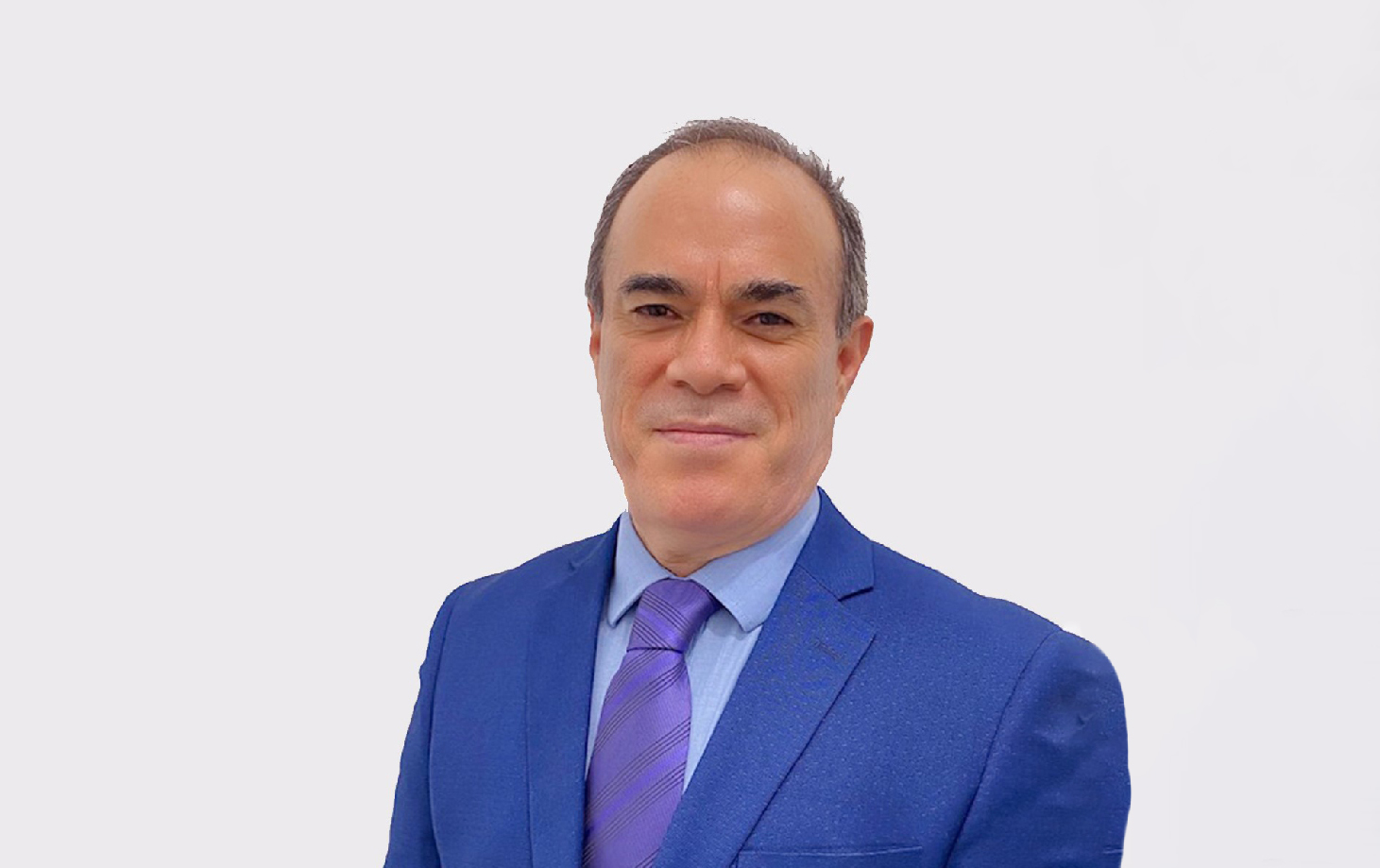
Said Eng. Martín Barrios Domínguez, Executive Director of Calidra Peru, who shared the plans of this company linked to the mining activity, which also has quicklime production plants in Colombia, Argentina and Chile.
What are your expectations for this 12th International Congress of Prospectors and Explorers (proEXPLO 2021)?
Our expectations regarding the International Congress of Prospectors and Explorers are very high because this event will allow us to learn about new technologies applicable to mining exploration.
On the other hand, and which is very relevant for us as a company related to mining, is that this event is very important because new mining prospects discovered in Peru and Latin America will be presented.
This fact will allow us to identify the prospects in which the companies have already identified an interest in exploration, mining and commercialization of the minerals they are interested in, and it is at this stage where we, after having identified and carried out the follow-up of prospection and exploration, enter to offer our product which is lime, when we have already manufactured a product tailored to the mining company's operation, both in Peru and in Latin America, where we can also enter, since we currently have quicklime production plants in Colombia, Argentina and Chile.
It is clear that this Congress has foreseen a strengthening in the academic, industrial and mining prospects to reinforce exploration with an environmental approach, something we identify with, since our plants have been designed for zero pollution.
What investments has Calidra planned for the years 2021-2022?
The CALIDRA Group has planned an investment in the district of Callalli, province of Caylloma, Arequipa region, for the construction of a second MAERZ kiln with a capacity of 400 MT/day, which added to the one already existing in the plant at the above-mentioned location, would total 6,800 MT/day.
With this volume we will serve the mining market in southern Peru, as well as the central and northern part of the country, for all our suppliers and to attract new, current and future suppliers resulting from the materialization of prospecting and exploration of deposits.
On the other hand, we intend to enter the Brazilian market with quicklime and, if necessary, with construction lime and the other types of limes we produce. We will also invest in another MAERZ kiln in Argentina in order to expand our market in that country and in Chile.
What technology has Calidra been applying in its work?
CALIDRA uses MAERZ kilns in its operations, which is a state-of-the-art Swiss technology kiln, of the PFR (Parallel-Flow Regenerative) type, suitable for calcining with natural gas, micronized coal (pet coke), or a mixture of both. Due to its high thermal efficiency in the calcination process (double shaft), it allows to obtain limes of high reactivity and purity, with a considerable saving of energy and fuel consumption, therefore, it indirectly favors the environment.
How do you describe Peruvian geology?
According to the geological context, Peru is a country of abundant mineral resources. Throughout its territory there are a great variety of metalliferous deposits of diverse nature.
In recent years, exploration has been focused on the search for epithermal gold and silver deposits and low sulfidation.
It is important to mention that Peru ranks first in the production of gold in Latin America, with more than 132 tons per year, and it is projected to reach historical records never achieved in the national history.
More than 40 substances are produced, including metallic and non-metallic. Of the first one we will mention: antimony, bismuth, cadmium, copper, tin, iron, indium, manganese, etc., and they have been recognized in different locations throughout the country, but more exploration is needed to define and quantify their exploitation possibilities. Non-metallic minerals include calcium oxide, barytes, limestone, gypsum, kaolin, fire clays, talc and ornamental rocks.
It is crucial to find a systemic exploration of the country. Based on the new geological information of the territory, the knowledge of the Andean metallogenesis and the new exploitation technologies available, this will make it possible to evidence and quantify new and greater mineral and energy resources at the national level.
How would you describe Peruvian geology professionals?
Regarding this, we have to point out that Peruvian geology professionals are highly qualified, since they have a wide experience due to the mineralogical richness of the Peruvian geography. In our case, this has allowed us to carry out the mining of our quarry in an orderly and uniform manner, which allows us to manage costs efficiently.
We consider that Peruvian geology professionals are apt to perform not only at a national level but also worldwide, they are very disciplined and diligent, very constant in their work.
What has been the main impact of the COVID-19 pandemic on Calidra's performance?
In this regard we must say that the COVID-19 pandemic has had an impact not only at the national level but globally, so our company is no stranger, with the difference that our operations did not stop at all, but what we noticed was that our orders with some suppliers suffered a slight decrease, which understandably, due to the temporary closure of markets, had to reduce their production rate, but we also highlight that in the pandemic we have gained new customers who have valued on a technical level our type of lime and the proximity of our plant to the mining companies nationwide and with competitive prices.
proEXPLO 2021: Mineral Resources for a Sustainable Future
Cochilco projects copper price at US$ 3.3/lb for 2021
 08th February
08th February
Cochilco projects copper price at US$ 3.3/lb for 2021
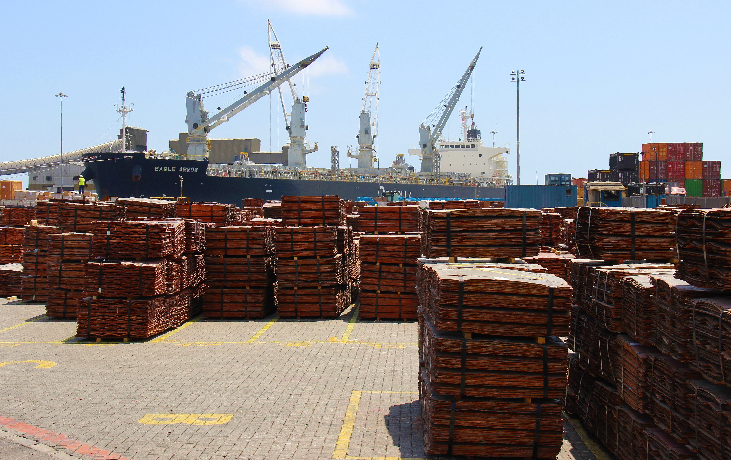
The update implied a significant increase with respect to the previous projection (US$ 2.9 per pound for 2021). What elements led to the revision of a more conservative projection?.
According to the Chilean entity, the better outlook is based on: high economic growth projected for China, which, according to the World Bank and the International Monetary Fund, would exceed 8% in 2021.
Likewise, the persistent vulnerability of the metal's supply is noted, in addition to the trend towards the depreciation of the dollar in international markets and the growing process of vaccination against COVID-19 in developed economies (United States, Europe and Japan).
On the other hand, during 2021, the copper market would present a deficit of 70,000 tons, while in 2022 the condition changes to a surplus of 116,000 tons.
In this sense, the pandemic still has the potential to impact market expectations. However, he anticipates that if the pandemic gets out of control in the main producing countries, the price of the red metal could be higher than projected.
proEXPLO 2021: Mineral Resources for a Sustainable Future
Investment in mining exploration amounted to US$ 223 million in 2020
 08th February
08th February
Investment in mining exploration amounted to US$ 223 million in 2020
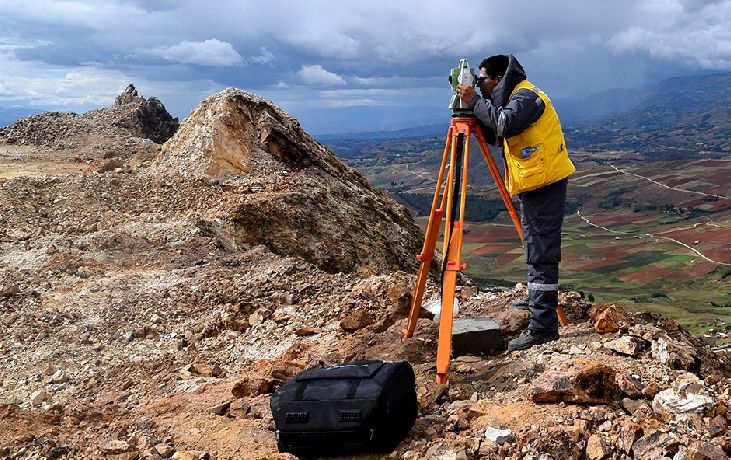
Although investments in mining exploration decreased worldwide by 10%, according to estimates by Eng. Miguel Cardoso, vice president of the Peruvian Institute of Mining Engineers (IIMP), the decrease in Peru has been greater, and this draws attention to the Peruvian case, where a declining trend was already noticeable in recent years.
For the second consecutive year, the largest amount of investment in exploration corresponded to Compañía Minera Poderosa, the second largest gold producer in Peru, in 2020. It was followed in importance by Cia. de Minas Buenaventura, the second largest silver producer, and Consorcio Minero Horizonte, the sixth largest gold producer in 2020.
This is one of the lowest amounts destined to explorations in the last decade, something that generates concern in the mining sector, since exploration is the beginning of the mining productive process. This occurs in a context in which mining experts have been anticipating that we are facing the beginning of a cycle of high demand for minerals in the world.
In fact, during his recent participation in the Mining Engineering Week, Steve Enders, head of the Mining Engineering Department at the Colorado School of Mines, said that "We will see a great demand for metals and minerals as we have never seen before and the challenge is to offer a workforce to meet that demand", he said.
During the launching of the 12th edition of the International Congress of Prospectors and Explorers (proEXPLO 2021), the president of proEXPLO 2021, Enrique Garay, highlighted the importance of exploration to give continuity to our mining industry, which will be fundamental for the future of the country, and the economic reactivation after the pandemic.
"Unfortunately with the price of gold, at 1850 dollars an ounce, and copper, at 8000 dollars a ton, we have no new projects. They have all been discovered 15 years ago," the expert said.
proEXPLO 2021: Mineral Resources for a Sustainable Future
Ingemmet shares open scientific research data
 08th February
08th February
Ingemmet shares open scientific research data
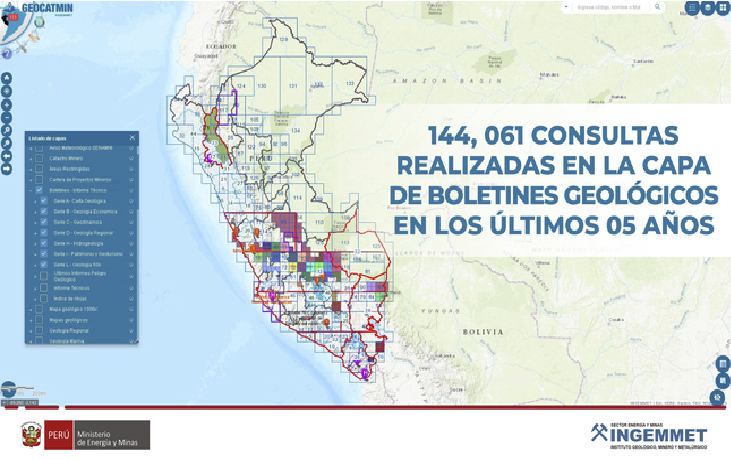
The reusable data shared by Ingemmet are data that have been processed using standardization techniques, made available through the national open data platform, where you can find text, table and spatial data; these are reusable because they allow access and download in a standard format to be reused with free or proprietary software.
The Ingemmet Institutional Repository disseminates, in open access, the scientific-technical work of the institution's researchers generated over the years, such as geological bulletins, maps, technical reports, papers presented at congresses, research articles, working papers, institutional reports, among others.
The geological bulletins are the results of scientific research, which are subject to a demanding review process and are then published in the Ingemmet Institutional Repository where they can be searched, consulted and downloaded for free.
At the end of 2020, it was considered convenient to link the geological bulletins, published in the repository, with their research data; available through a metadata file in Geocatmin, to facilitate the download of databases and maps.
Through the Geological and Mining Cadastral Information System, Geocatmin, users can also access this information, the list or link of the geological bulletins is contained in the Geocatmin bulletins layer. There you can find the area of the project concerned in the bulletins study.
To access the link to the document (bulletin) you must check on each polygon, this option allows access to the institutional repository, where you will find the complete study and associated maps.
To download the geological bulletins from Geocatmin, you must enter the system and activate the layer of bulletins and technical reports, then select the sublayer bulletins, finally you must select the bulletins on the map where the link to the research and its maps will be activated.
These maps are downloaded in Shapefile, pdf and mxd formats, which are the most demanded and used. Using the geodatabase download tool, data can be downloaded in shp, autocad and geodatabase formats.
This is how Ingemmet shares information for the common good, by making this data available to the public without access limitations, as it is information generated and obtained by a public entity.
proEXPLO 2021: Mineral Resources for a Sustainable Future
Interview | Eng. Susana Vilca, president of the Ingemmet
 08th February
08th February
“The challenge for exploration companies is to understand the geological context of subsoil”
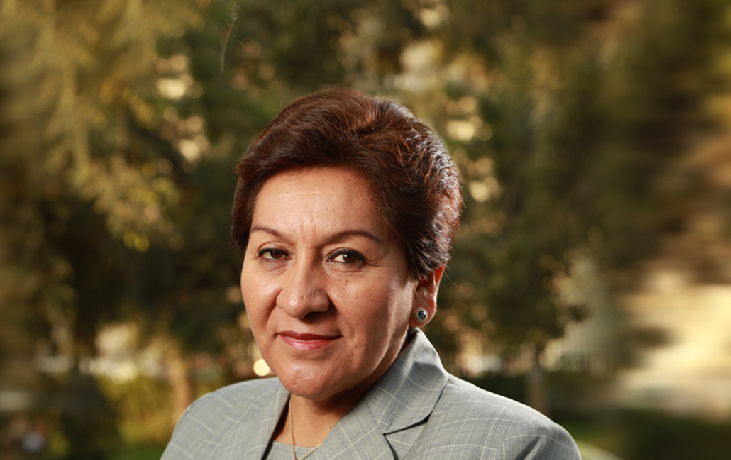
The president of the Geological, Mining and Metallurgical Institute (Ingemmet) maintains that mineral exploration is increasingly complex and tools and/or knowledge that are apparently not directly related to a specific exploration method must be used.
1. What do you consider to be the challenges faced by exploration companies in Peru and worldwide?
Globally, exploration companies face the lack of financing for mining investment; and the country risk, translated into governance, social conflicts, regulatory risks; the same that do not guarantee the effectiveness of the exploration activity.
In the national context, and according to the opinion of explorers gathered in executive roundtables and through other means, we have numerous permits and difficult procedures for each one, which does not help with the predictability of exploration permit procedures; in addition, prior consultation is often cumbersome in terms of steps and their execution.
In this regard, the executive has been working to create a favorable context.
From a technical point of view, as we all know, mineral exploration is increasingly complex and tools and/or knowledge that apparently are not directly related to a specific exploration method must be used.
Exploration methods that were used 20 years ago no longer give results and we must innovate. In Peru, the challenge for exploration companies is to understand the geological context of subsoil, geologists must interpret thousands of data and for this they need to apply artificial intelligence, obviously based on geological knowledge.
In that sense, we think that companies that understand how complex magmatism, sedimentology, geochemistry, structural geology, mineralogy can be will be able to find better results, but the most important thing that we should not underestimate is a good geological map.
This is why at INGEMMET we are giving more attributes to the 100K, 50K geological maps and the quality controls of the attributes of databases are carried out with the support of artificial intelligence to reduce errors.
What are the areas at national level that are richest in mineral deposits?
Peru is so big and has such a variety of deposits that we could not say which one is richer, since a geological metallotect that does not have many deposits at the moment could have them in a few years, for example, as was the case of the epithermal Au-Ag deposits hosted in the Callipuy-Miocene volcanics in Cajamarca.
Currently, the geological metallotects with the largest deposits and mining deposits are: The Marañon Fold and Thrust Belt with abundant Zn-Cu-Pb-Ag-Au polymetallic deposits, the Western Cordillera in the North, Center and South with high-intermediate-low sulfidation epithermal deposits, the Pataz Batholith with Au veins, the Coastal Batholith with Cu-Au-Mo porphyries, Andahuaylas-Yauri Batholith with Cu-Fe-Au-Mo porphyries.
And there is still much to explore in these metallotects, for example, mine expansions show us the vertical extension to depth of the mineralized bodies, it is not known to what depth in the crust the mineralized bodies are and what is the lateral extension of the mineralized bodies.
Some of the ore bodies related to porphyries of dacite composition may be related to more than one type of deposit, within the same metallotect or in the host rock. Variations in the composition of the porphyry and host rocks make Peruvian deposits polymetallic and form more than one type of mineral deposit.
3. Recently, the identification of polymetallic zones with Cu, Pb, Zn, Ag and Au potential was reported in Cajamarca. What other regions stand out?
In Bulletin 71B of regional mining geological prospecting in the Cajamarca region, 4 zones were determined to be of greater prospective interest in polymetallic elements in Cu, Pb, Zn, Ag and Au, mainly to the north of the region in the provinces of Jaén and San Ignacio such as: San Antonio (San José del Alto, Jaén) with economic potential with slightly anomalous Cu (456 ppm), Pb (210 ppm) and Zn (714 ppm) values with traces of Au (11 ppb); Buenos Aires (Huabal, Jaén), also with slight anomalies in Ag (6 ppm), Pb (795 ppm) and Zn (2412 ppm), as well as traces of Au (8 ppb) and Cu (182 ppm); Chamanal (San Ignacio), slight anomalies in Ag (2 ppm), Cu (874 ppm), Pb (96 ppm), Zn (344 ppm) and gold at 372 ppb; and Alto Cocharán (La Coipa, Jaén), with slight anomalies in Au (537 ppb), Pb (127 ppm), Sb (60. 7 ppm) and Zn (685 and 225 ppm).
In Peru, other regions producing zinc and lead such as Ancash, Junin, Pasco and Lima; gold such as Cajamarca, La Libertad and Arequipa, silver such as Ancash, Pasco and Junin; as well as copper, Arequipa, Ancash and Apurimac also stand out.
In general, the formation of polymetallic deposits requires the exchange of cations between igneous rocks of felsic composition and intermediate platform limestones, and understanding the preservation of the systems during the shortening of this belt and these types of rocks outcrop along the Marañón fold and thrust belt in central Peru.
How do you estimate Peruvian investments in mining exploration will develop this year?
Already with the experience lived in the pandemic of 2020 and with the much stricter protocols, the mining sector is so strict with them that it will be possible to develop these activities.
What actions does Ingemmet have planned for prospecting and exploration this year?
In the geological role, we will transform data by changing the way we store, analyze and deliver data. We want to ensure that the data we publish is dynamic and can be used by emerging technologies, such as artificial intelligence, machine learning, among others.
In the granting role, we are currently working on the online application, so that users can submit a mining application virtually from anywhere in the world.
Our main product, the National Geological Map, has greater attributes that will provide it with artificial intelligence so that our users can take advantage of it in a better way. This will help users to know more about the geological context and thus be able to define more exploration targets.
We will carry out a mapping of the Marañon Fold and Thrust Belt, which is an important metallotect for different types of deposits.
Likewise, in the Eastern Cordillera we are going to survey the Batholith, and I believe that after that we will have new horizons for exploration, as we did in the South of Peru.
If the pandemic conditions allow us to carry out field work, for this year we have programmed to study two ANAPs in the regions of Arequipa and Huancavelica to evaluate their potential. In the same way, new zones with geological mining potential will be identified to define new areas of interest for exploration.
How has Ingemmet been adapting to the pandemic?
By complying with the protocols established by the Ministry of Health (Minsa) and the sector for public administration work, we have been meeting the objectives of the Institutional Operational Plan, with remote, mixed and on-site work.
We are implementing digital transformation and innovating in geological research projects using artificial intelligence and machine learning for the development of products. And above all, training personnel in these technologies.
We have just concluded the migration of our database to an updated version of SIDEMCAT 2020, which will allow interoperability between INGEMMET and other institutions.
Similarly, GEOCATMIN is now more dynamic and has metadata from all the research projects that we have been working on in recent months.
In this context of pandemic, it has been considered essential to have the Online Application, a technological tool developed in INGEMMET that will eliminate the need for users to be physically present for its submission and will make it easier to apply for a mining concession from anywhere in the world.
proEXPLO 2021: Mineral Resources for a Sustainable Future
Attendees will be able to interact with the speakers at the Congress
 02nd February
02nd February
"Attendees will be able to interact with the speakers at the Congress"
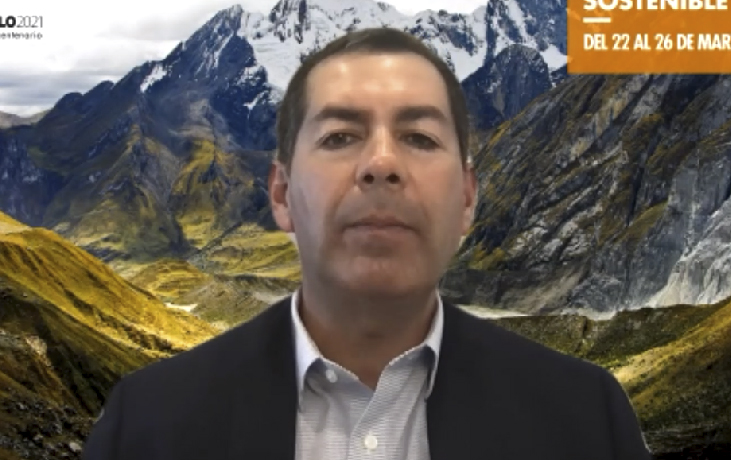
During the launching of the 12th International Congress of Prospectors and Explorers (proEXPLO 2021), Urrea said that after 22 years we have reached this new edition and have the opportunity, for the first time, to use a virtual platform, highlighting the advantages of participating in real time from any location.
According to Urrea, who is also executive president of Explomin Perforaciones LATAM, in addition to the advantages of participating in the keynote speeches, courses and technical talks, as well as poster presentations from anywhere in the world, there are also technical and booth presentations.
"I believe that the main emphasis is being able to interact with each of the speakers on logistics, laboratories, geophysical services, drilling services; and most importantly, the networking that can be taken advantage of on the virtual platform," he said.
In this sense, he invited everyone to participate in the event, adding that in the web page www.proexplo.com.pe you can find very useful information of interest. He reiterated the importance of being able to communicate in real time with each of the speakers and exhibitors.
On the other hand, he said that the use of technology such as Artificial Intelligence, big data, machine learning, helps a lot in data processing; but there are also many technologies that help to speed up the obtaining of samples.
"In our case, we are using European technology to do directional drilling, which allows us to optimize the number of rigs that have to be declared to obtain a permit," he specified. According to Urrea, from very few drilling points it is possible to access different targets within the deposit we want to explore. This, he said, makes it much easier in terms of time and deadlines, and obviously in terms of budget.
This is an example that we can take advantage of today and somehow overcome the restrictions that are currently in place when applying for permits, so that we can access different targets in a deposit with just a few rigs.
proEXPLO 2021: Mineral Resources for a Sustainable Future
IIMP presented the 12th International Congress of Prospectors and Explorers
 02nd February
02nd February
"IIMP presented the 12th International Congress of Prospectors and Explorers"
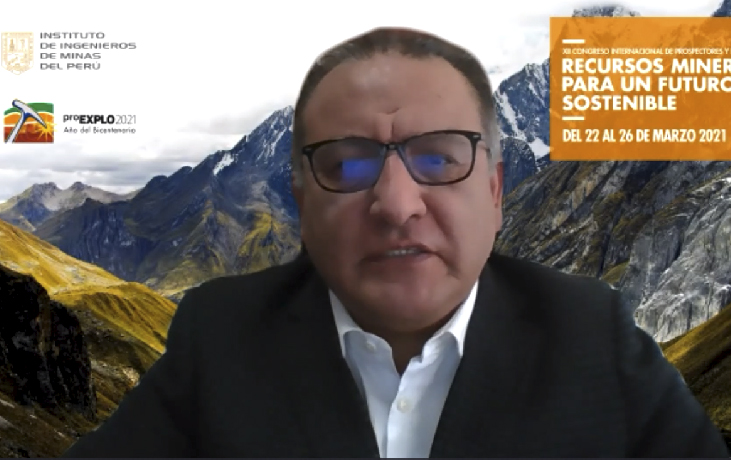
On January 27, the presentation of the 12th edition of the International Congress of Prospectors and Explorers (proEXPLO 2021), one of the main geological-mining events in Latin America, organized by the Peruvian Institute of Mining Engineers (IIMP), which will be held from March 22 to 26, 2021 in an entirely virtual format, took place.
"Our goal with proEXPLO 2021, under the slogan "Mineral resources for a sustainable future", is to disseminate among the communities of prospectors, explorers, investors and the general public that in the future we will need mineral resources that will help us to have a cleaner world", said the president of the Organizing Committee, Eng. Enrique Garay.
The conferences will be held during 5 days; the thematic sessions will be held in the mornings, while the technical program will take place in the afternoons. As for the first ones, there will be two sessions for junior mining companies and one session by the Geological, Mining and Metallurgical Institute (Ingemmet).
Also, the organizers highlighted that for the first time there will be a session for prospectors and a talk dedicated to the contribution of women in the advancement of exploration in Peru. On the last day of the thematic sessions there will be a special round table about Peru on the road to CRIRSCO.
On the other hand, they detailed that the sessions of the technical program are focused on three pillars: Innovation in mining exploration, Economic geology and From discovery to mine. Sixty technical papers will be presented virtually, from a total of 94 abstracts received from different countries; and 5 short pre-congress and 3 post-congress courses will be presented.
The ProEXPLO 2021 Organizing Committee consists of Enrique Garay Manyari, President of proEXPLO 2021; Silvia Rosas Lizárraga, Senior Advisor; Sebastian Benavides Kolind-Hansen, Head of Technical Talks; Ángel Mondragón Dávila, Head of Project Fair; and Jean Vallance, Head of Pre and Post Congress Courses.
Completing this list are Carlos Urrea Farias, Responsible for Technology Exhibition and Sponsorship; César Farfán Bernales, Responsible for Keynote Lectures; Alberto Arispe Bazán, Responsible for Project Fair; Jonas Mota e Silva, Responsible for Keynote Speeches; Andres Recalde, Responsible for Technology Exhibition and Sponsorship.
For more information on the event, please visit: https://www.proexplo.com.pe/es.
Mining Exploration
During a press conference, the president of proEXPLO 2021, Enrique Garay, highlighted the importance of explorations to give continuity to our mining, which will be essential for the future of the country, and the economic reactivation after the pandemic.
"Unfortunately with the price of gold, at 1850 dollars an ounce, and copper, at 8000 dollars a ton, we have no new projects. They have all been discovered 15 years ago," the expert said.
In this sense, he remarked that it will be crucial to place the importance of mining on the political agenda. "Of the 23 presidential candidates, I have only heard one or two talk about mining. Most of them are afraid to talk about it," he remarked.
For his part, Miguel Cardozo, vice-president of the Peruvian Institute of Mining Engineers (IIMP), remembers that in 2020 the country fell notably with respect to 2019, by 31% in exploration, while the world fell 10% due to problems referred to the pandemic.
In this regard, he emphasized that in addition to the pandemic, the major obstacle to mining exploration is the lack of competitiveness due to the permitting and prior consultation processes. He pointed out that greenfield explorations must be increased.
proEXPLO 2021: Mineral Resources for a Sustainable Future
Pre and post proEXPLO 2021 courses to be held
 02nd February
02nd February
"Pre and post proEXPLO 2021 courses to be held"
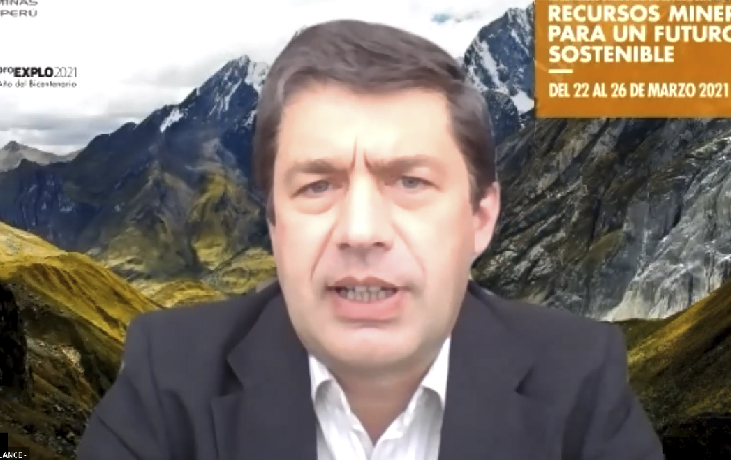
To ensure this, said the professor of the Pontificia Universidad Católica del Perú, exploration is carried out in two ways. New deposits with traditional or less traditional metals can be sought (greenfield exploration) and producing deposits can also be explored (brownfield exploration).
However, he pointed out that in both cases finding reserves or new deposits is becoming increasingly difficult, and those that have been easy to find have already been found. For this reason, we need to develop a variety of exploration methods, including desk work, review of satellite photos and field work.
"New exploration methods are now emerging that include geophysical studies, the use of drones and Artificial Intelligence, such as machine learning. They are very interesting methods and are useful if there is a good interpretation of the geological information behind the use of these methods", said Vallance.
In this respect, he stated that a close relationship is needed between the exploration work and the work of researchers in the Academy, in order to understand more and more the natural processes of formation of mineral deposits, increasingly improving the geological models.
These researchers are both teachers who will train the next generation of geologists and who can also participate in the ongoing training of geologists who are already working. "Here is the great role of proEXPLO 2021, which is to take part in the training with conferences, posters, seminars and short courses," he said.
Pre-Congress and post-Congress courses have been scheduled. In addition, three virtual seminars called "Road to proEXPLO" have been held since June 2020 with the participation of 5 world-renowned experts. These seminars lasted 2 to 3 years and were focused on copper.
Seven short courses of about six hours each are scheduled to be held between March 19 and 28. These are 5 pre-congress courses and 3 post-congress courses mainly for geologists working in mining companies and exploration companies in Peru.
These courses will be virtual and will be taught by experts from Australia, USA, Sweden, Canada and Peru. Registration for the courses is open. We are confident that the courses will be well attended.
Pre-Congress short courses
- Geometallurgy for Explorers - Samuel Canchaya.
- Valuation of Mining Projects - James Gilbertson and Mike Armitage.
- Tops and bottoms of epithermal deposits, and transition to porphyry deposits: Application to exploration - Jeff Hedenquist and Antonio Arribas.
- The Basics of Mining Disclosure Securities Laws - NI43-101 and S-K 1300 - Deborah McCombe and Rosmery Cárdenas.
- Strategies for (on-site) targeted geochemical analysis of minerals - Lisard Torró.
Post-Congress short courses
- Alteration and Mineralization in Porphyry Deposits - David Cooke.
- Geochemical and mineralogical applications for the selection of geophysical methods in the exploration of VMS deposits - Marcelo Imaña.
- Geochemistry Applied to Mining Exploration: Porphyry and Epithermal Systems - William Chávez Jr.
proEXPLO 2021: Mineral Resources for a Sustainable Future
New exploration techniques and methodologies will be discussed at proEXPLO 2021
 02nd February
02nd February
"New exploration techniques and methodologies will be discussed at proEXPLO 2021"
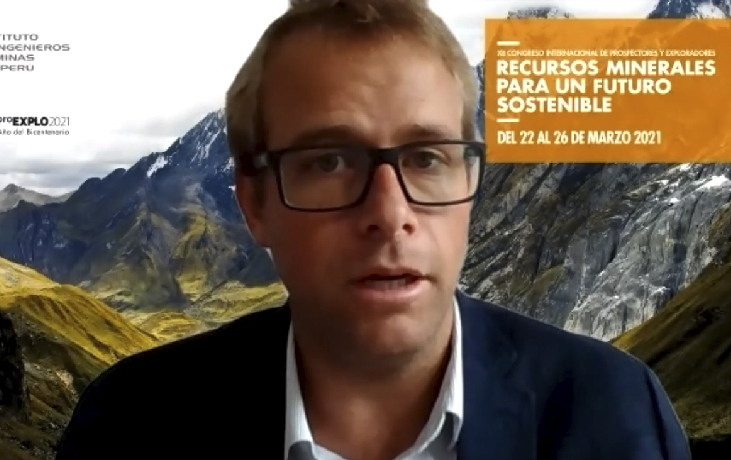
Hence, the conference program has been modified to adapt to this context, he pointed out, since the classic program of three full and intensive days has been changed to one of five days where technical programs will be held in the afternoons, while special programs of different topics will be held in the mornings.
In addition, presentations will be recorded on the same platform and will be available until the end of the month, in case participants fail to connect at the scheduled presentation time. We are also providing the facilities for participants to be able to connect at the time of the conference wherever they are.
"We have organized the technical program based on three pillars: the first will deal with Innovation in exploration with talks focused on the development of new exploration techniques and methodologies," said Benavides, who is also Exploration Manager for Peru and Ecuador at First Quantum Minerals.
The second pillar is focused on Economic Geology which will address exploration success stories and advances in geological knowledge in Peru and the region. While the third pillar focuses on all the steps necessary to make a deposit viable and turn it into a mine, such as geometallurgical studies, resource identification, community relations, etc.
The geoscientific community has responded very well to this Congress modality, he said. "We have received 94 technical papers from different countries of the region and the world, of which we selected 31 for oral presentations and 29 for poster presentations," he explained.
As for the oral presentations, Benavides said that these will have a duration of 15 minutes and held live, in blocks of three presentations and will have a Q&A session at the end of each block.
Posters, on the other hand, are documents that present the work in a summarized manner and will be presented by their author in a brief presentation that will be previously recorded and will be available with the document throughout the conference to be visualized by the attendees at any time. And participants will have the opportunity to ask questions to the author if they wish to do so.
In the mornings we have organized 5 thematic sessions. On Monday and Tuesday junior companies will present their projects, while on Wednesday it will be the turn, for the first time, of independent prospectors. We believe that these are crucial spaces for the geoscientific community to learn about these projects and the opportunities that are being developed and thus encourage more investment in these early stages of exploration.
On Thursday, Ingemmet will present its scientific and technological advances at the service of our community. Finally, on Friday there will be a special round table discussion on Peru on the road to CRIRSCO, which is a self-regulated association of Peruvian mining professionals who produce and sign technical reports and mineral resources for international stock exchanges.
Finally, the keynote speeches will be given by leading professionals in their fields of study.
- Dr. Antoine Caté (SRK Toronto) - "Machine learning for exploration: a review of current and future tools".
- Dr. Thierry Sempere (ANDES C&P – Peru) - "Exploring Peru for metals and hydrocarbons using innovative thinking".
- Dr. Jon Hronsky (Western Mining Services – Australia) - "An integrated model for Cu and Au mineralization at convergent margins: two fundamental processes interacting in variable geodynamic situations".
- Dr. Michael Doggett (Doggett & Associates – Canada) - "Transforming mineral resources for a sustainable future: lessons from the first 20 years of the new millennium".
- Msc. Eco. Erik Heimlich (CRU Group – Chile) - “Global copper market: short and long term fundamentals”.
Finally, there will be a special session on the contribution of women to the mining industry in Peru, which will be led by Silvia Koller from the Geological Society of Peru.
proEXPLO 2021: Mineral Resources for a Sustainable Future
November 2020 marked the sixth month of mining employment growth
 22nd January
22nd January
November 2020 marked the sixth month of mining employment growth
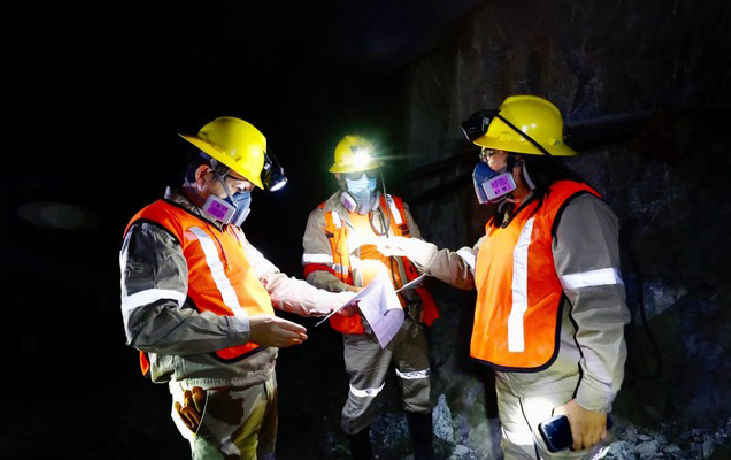
In November 2020, a total of 199,137 direct jobs in the mining sector were registered nationwide, according to the Ministry of Energy and Mines (Minem) and added that the number of direct mining workers registered during the penultimate month of 2020 meant a growth of 5.1% compared to October, as well as the sixth month of consecutive recovery growth, by virtue of the progressive and safe reactivation driven by the Government during the second quarter of 2020.
Also, in the latest edition of the Mining Statistical Bulletin, which includes a brief summary of the "Mining Employment Report 2020", the Minem detailed that of this universe, 50% was distributed in five regions, being Arequipa the first of them and where employment reached 25,349 people; that is, 12.8% of total.
The second position was held by the Ancash region with 21,125 workers (10.6%); followed by Moquegua, where employment benefited 20,121 people; a figure that represented a 10.1% share.
The last two regions were Junin and Lima with 18,230 and 14,477 workers, respectively.
proEXPLO 2021: Mineral Resources for a Sustainable Future
Inca Minerals licensed to drill Riqueza project
 22nd January
22nd January
Inca Minerals licensed to drill Riqueza project
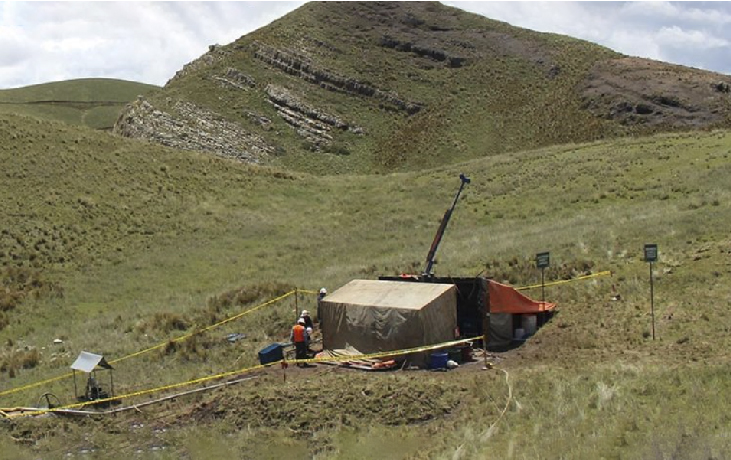
Australian-owned junior mining company, Inca Minerals, revealed that the Ministry of Energy and Mines (Minem) approved the drilling permit for the northeast zone of its Riqueza project, located in Huancavelica.
"This area of Riqueza hosts numerous copper, zinc and gold skarn and porphyry targets. In addition, the NE Area diamond core program includes 5,070 meters of drilling and the total area of the drill program covers 6,070 meters planned for the project," the company detailed.
Also, through a statement sent to the Australian Securities Exchange (ASX), the mining company stated that it "will now submit applications for a water permit and certificate to commence work, also known as an exploration permit".
proEXPLO 2021: Mineral Resources for a Sustainable Future
Peru's challenges and advances in exploration
 22nd January
22nd January
Peru's challenges and advances in exploration
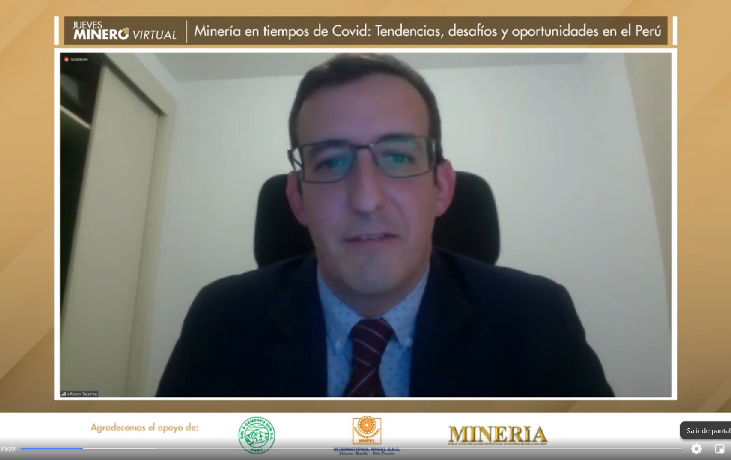
Peru is still on the radar of mining investors, including those involved in exploration, an activity considered high risk due to the uncertainty of results.
In view of this, for the director and general manager of Global Business Reports (GBR), Alfonso Tejerina, the country must overcome a series of challenges to guarantee the continuity of capital inflows.
The first challenge, he said, is the permits that have multiplied exponentially and have delayed the time of activities for the companies.
"Without the permits, this lack of activity has ended up affecting the share prices of junior companies, which have found it difficult to obtain funds. This causes a paralysis that is difficult to maintain", he said.
Similarly, Alfonso Tejerina pointed out that the political instability that Peru has experienced in recent years, which has forced five ministers to head the Ministry of Energy and Mines in just five months, has affected the entire sector and, especially, the exploration sector.
"So, in view of this, we perceive that risk investment, at a time when raising funds becomes more difficult, migrates to more predictable jurisdictions such as Canada or Australia," he emphasized.
During his speech: “GBR Presentation. Mining in Times of COVID: Trends, Challenges and Opportunities in Peru,” held in the Virtual Mining Thursdays, the director of GBR, on the other hand, highlighted that the current head of the Ministry of Energy and Mines (Minem) seeks to speed up the prior consultation process.
In addition, he pointed out that throughout 2020 there were junior companies that managed to enter the various stock markets and announced news about their projects in Peru.
One example was KuyaSilver, which began to list its shares on the OTCQB Venture Market and obtained the approval of the semi-detailed Environmental Impact Assessment (EIAsd) for the construction of a beneficiation plant at the Bethania silver mine, located in Huancavelica.
“Also, Pucará Gold has managed to position itself in the market with a market capitalization of 50 million Canadian dollars; and E29 with the Elida and Flor de Cobre projects, which are located in southern Peru, has entered the Toronto Stock Exchange,” commented Alfonso Tejerina.
proEXPLO 2021: Mineral Resources for a Sustainable Future
Interview | Eng. César Farfán Bernales, member of the Organizing Committee of XII International Congress of Prospectors and Explorers (proEXPLO 2021)
 22nd January
22nd January
“Our country was, is and will be a mining country par excellence”
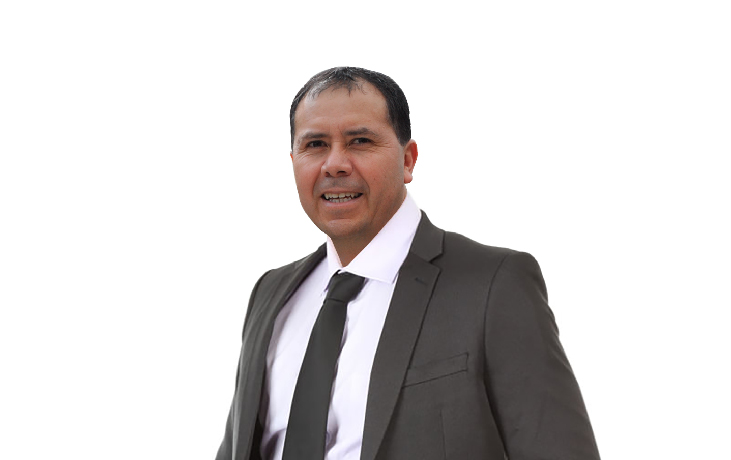
Said Mr. César Farfán Bernales, who added that we are a country with a wide diversity of mining deposits with a significant amount of metals to produce; and with a mining presence in almost every part of our territory.
What are the objectives of the 12th Congress of Prospectors and Explorers (proEXPLO 2021)?
proEXPLO has always had an important relevance in Peruvian mining exploration and, therefore, in the industry. Various actors from both the private and public sectors participate in this event to showcase new projects, advances, innovations and improvements that allow for a fundamental development of the mining industry.
As the slogan "Mineral Resources for a Sustainable Future" points out, the main objective of the congress is focused on the search for these mineral resources, ensuring that the environment where they are found guarantees their sustainability over time. This involves environmental, legal, political and social issues, as well as exogenous agents such as what happened this year with the COVID-19 that paralyzed the world.
This proEXPLO 2021 is based on three fundamental axes linked to Sustainability in the future of mineral resources. The first focused on exploration innovation; the second on exploration success stories from Peru and Latin America; and the third on the optimal transition from exploration to mining.
Finally, due to the pandemic, which is affecting the entire world, we decided with great effort to make this congress virtual, which will mark a milestone in history, and I am sure that everyone's expectations will be met fully.
How is work progressing regarding the keynote speeches for proEXPLO 2021?
The keynote speeches are practically ready, with very relevant high-level topics by world-class professionals, which I am sure will enrich all those who participate. There will be lectures on Machine Learning; exploration of minerals and hydrocarbons in Peru with innovative thinking; integrated model for copper-gold mineralization; turning mineral resources into a sustainable future, and the global copper market.
What do you think will be the contribution of proEXPLO 2021 to Peruvian mining?
Undoubtedly, the greatest contribution of this edition of proEXPLO 2021 will be innovation. Many of the mining exploration processes have evolved positively in terms of technology hand in hand with innovation; current technological tools make exploration more dynamic and agile.
Likewise, the new projects that will impact the future of Peruvian mining in a sustainable way over time and, finally, closing gaps in the understanding of the transition from exploration to the mine, will be topics of great contribution to Peruvian mining.
What takeaway do you want participants to take home at the end of proEXPLO 2021?
I hope that at the end of this edition of proEXPLO 2021 all participants realize the importance of having mineral resources for a sustainable future, understanding that mining exploration is innovating year after year based on the use of technology in an efficient and effective way but without forgetting the basic principles of exploration.
In addition, we have important success stories of projects mainly in Peru that will ensure the sustainability of the mining industry over time and finally internalize that the transition from exploration to mine construction is an important process involving many internal and external factors that when covered and developed properly will allow the development of sustainable mining over time.
Finally, we want participants to experience that despite even extreme difficulties such as those experienced in today's world in the midst of a pandemic caused by COVID-19, we are capable of moving forward with effort and dedication.
What are the main characteristics of Peruvian geology? Is there any particular factor that makes Peru stand out from other mining countries?
Peru's geology is an open book. Peru's geology is an open book.
Our country was, is and will be a mining country par excellence, and the Peruvian Andes have always shown its majesty throughout the length and breadth of the country. We are a country with a wide diversity of mining deposits with a significant amount of metals to produce; and with a mining presence in almost every part of our territory.
Based on the world ranking of metal reserves, published by Gerens in November 2019 and updated in October 2020, Peru is number 1 in world silver reserves; number 3 in world copper reserves; number 3 in world zinc reserves and number 7 in world gold reserves; which places us above countries such as Russia, Canada and Australia. But we still have a long way to go.
Finally, I would like to take this opportunity to invite all professionals and general public involved in the mining sector to participate in this edition of proEXPLO 2021, which in its first VIRTUAL edition, will have an extensive program that I am sure will meet all expectations.
proEXPLO 2021: Mineral Resources for a Sustainable Future
Generating more mining projects and operations will increase tax revenues
 18th January
18th January
"Generating more mining projects and operations will increase tax revenues"
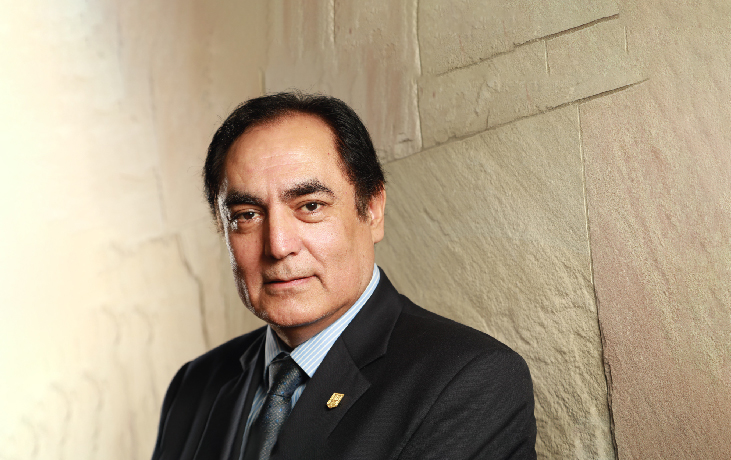
For the first vice-president of the Peruvian Institute of Mining Engineers (IIMP), Eng. Roberto Maldonado, the commissioning of mining projects and operations will allow to cover the fiscal deficit that Peru is currently experiencing.
"The generation of more mining projects and operations can increase tax collection and help cover the fiscal deficit, which is already being generated. We have to broaden the base otherwise we are going to cause a serious problem in fiscal terms and, especially, when Peru has the opportunity to generate projects that can help reduce the fiscal deficit", he said.
Furthermore, in response to the myth that mining does not contribute or contributes very little to the country's tax collection, he pointed out that a study, prepared by EY, showed the opposite and that the tax burden applied to Peruvian mining is above that of other competing countries.
"I am not suggesting that there should be a reduction of the tax base; but the solution is not to generate a burden on a burden as big as that of mining. In view of this, we have to generate more investment possibilities to be able to generate our tax base", he commented.
Development of projects in Cajamarca
During his presentation at the conference "The Role of Mining in Peru’s Development", as part of the Mining Engineering week, Roberto Maldonado highlighted the important portfolio of 46 projects for a combined investment of US$ 56,000 million.
He added that in this group, the Cajamarca region has a series of mining projects that must overcome either a business or social decision, or even a relatively complicated context.
"In Cajamarca we have the Conga, Galeno and La Granja projects, which are investments in the order of US$ 5,000 million, US$ 3,500 million and US$ 4,800 million. Clearly Cajamarca has the greatest amount of investment possibilities; however, they cannot be executed due to business, social and even political reasons; and this means that the possibility of a northern hub is limited in the possibility of exploiting and taking advantage of these resources and projects that we have", he said.
proEXPLO 2021: Mineral Resources for a Sustainable Future
Global Mining Exploration Budget Reaches US$ 8,328 Million in 2020
 14th January
14th January
Global Mining Exploration Budget Reaches US$ 8,328 Million in 2020
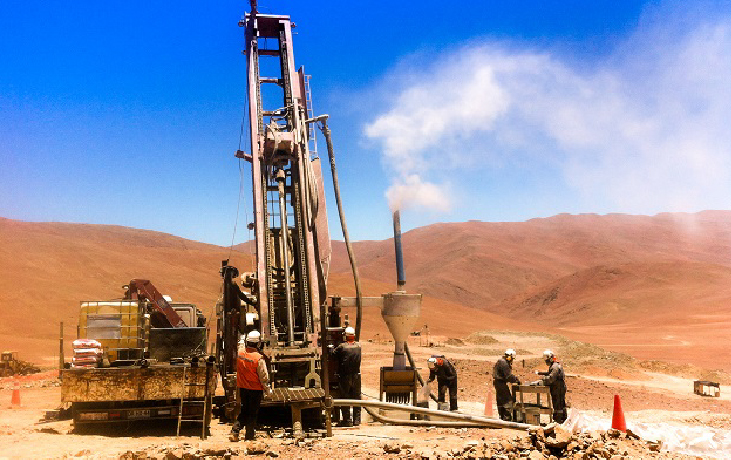
The consulting firm estimated that the mining exploration budget amounted to US$8,328 million, which was 10% lower than what was recorded in 2019 (US$9,285 million).
Mining majors in the world continued to capture significant amounts in exploration, among them Australia and Canada stood out with a 16% share each in the world's total exploration budget. By continents, the Americas captured 52% of the budget, while Latin America captured 25%, according to estimates by S&P Global Market Intelligence and the Chilean Copper Commission.
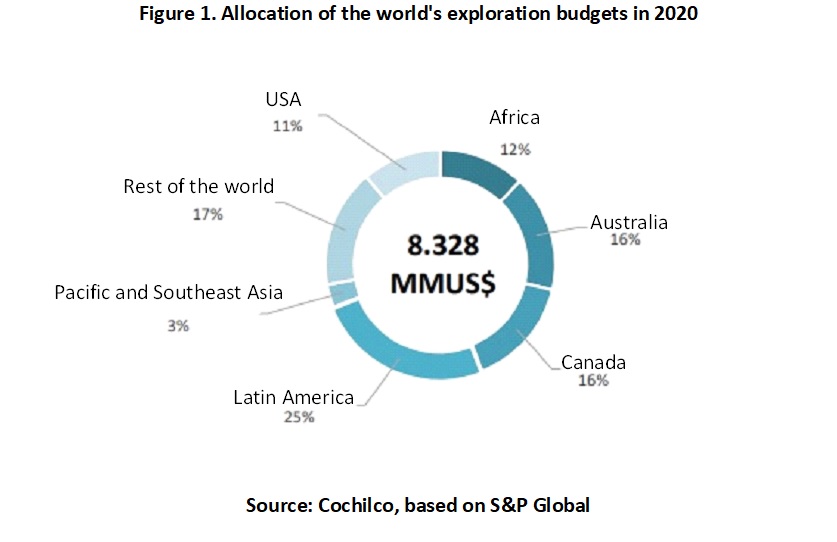
At the Latin American region level, the exploration budget in 2020 amounted to US$ 2,065 million. According to estimates, Peru ranked third with a share of 18%, although Chile and Mexico reached higher shares with 22% and 21% respectively.
It should be noted that other countries in the region - close to the Andes Mountains - that encourage the exploration of mining prospects, such as Ecuador and Argentina, have also received significant investments.
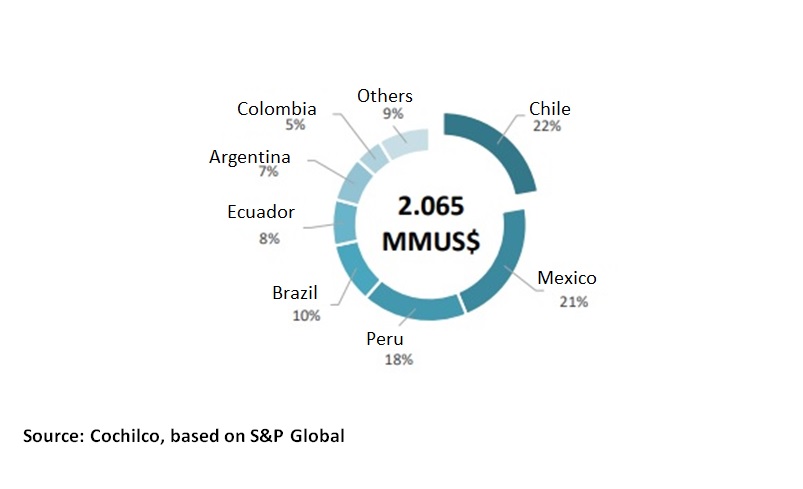
proEXPLO 2021: Mineral Resources for a Sustainable Future
Ingemmet Updates Mining Register Information
 14th January
14th January
Ingemmet Updates Mining Register Information
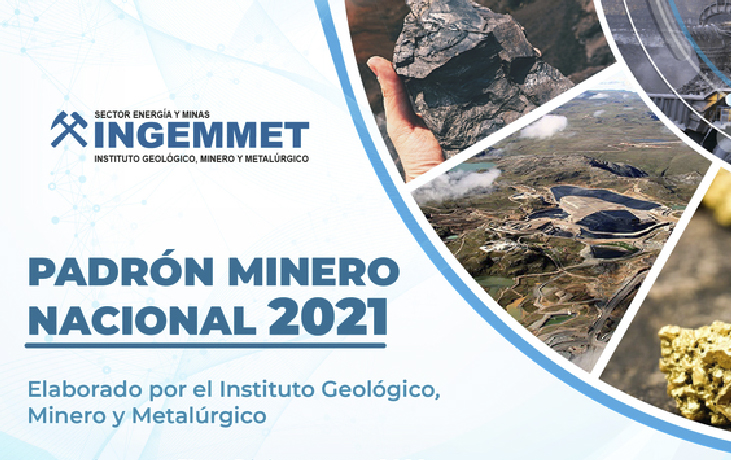
The Geological, Mining and Metallurgical Institute (Ingemmet) published the National Mining Register 2021 with information updated to December 31, 2020; according to the Mining Rights and Cadastre System (Sidemcat).
With this information, mining rights holders will be able to comply with their payment obligations for the operational rights and penalties during 2021.
Ingemmet informs that payments for the operational rights and/or penalties are made from the first working day of January until June 30 of each year, through authorized financial entities.
The National Mining Register allows to know the area and the new amount to be paid with respect to the incorporated areas of extinguished mining concessions or mining claims, which can be downloaded here: link
In addition, the penalty in the Economic Administrative Unit, accumulation and division or fractionation, is calculated based on the oldest title.
Finally, please note that the Automatic Accreditation of the operational and penalty payments must be made using the unique code, which appears on the voucher together with the name of your mining right. This will allow you to be sure that your payment has been made correctly.
proEXPLO 2021: Mineral Resources for a Sustainable Future
Interview | Andres Recalde, member of the Organizing Committee of XII International Congress of Prospectors and Explorers (proEXPLO 2021)
 8th January
8th January
“Peru is a must-visit destination for those seeking to gain significant experience in mining exploration”
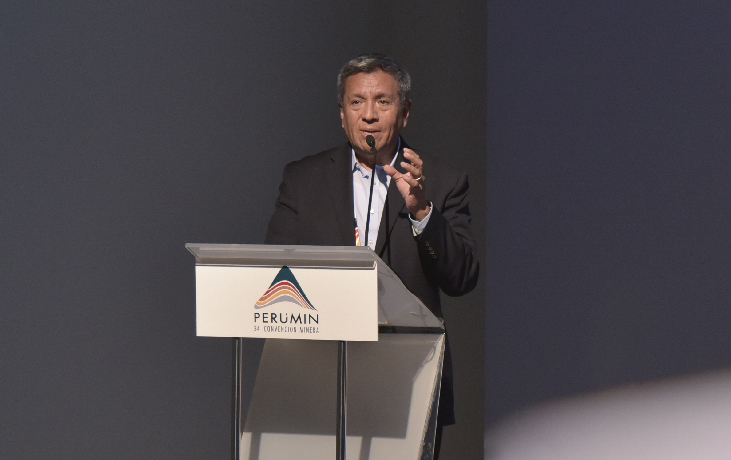
Said Andrés Recalde, member of the Organizing Committee of the 12th International Congress of Prospectors and Explorers (proEXPLO 2021).
What do you consider to be the objectives of the 12th Congress of Prospectors and Explorers (proEXPLO 2021)?
I believe that the congress will seek to focus on innovation, exploration success and the optimal transition from exploration to mining.
For my part, I am joining to support the dissemination of technological innovation as well as to highlight the importance of giving a social management approach to innovation in exploration, exploration success and the optimal transition from exploration to mining.
Currently, the primary stages of a mining project's life cycle, i.e. prospecting and exploration, are not exempt from good social management. Thus, for example, in Peru there are already exploration projects with elements of good social management, with local and official social actors such as local or regional governments.
What work is being done at the committee level to achieve these objectives?
For my part, it is to make contacts and attract the interest of exploration companies in Canada -where I currently live and have the opportunity to meet the circle of investors, investment houses, stock market analysts, people from the Toronto Stock Exchange- to see proEXPLO as evidence that Peru is a very large and varied field, with many opportunities to invest in exploration.
What will be the contribution of proEXPLO 2021 to Peruvian and world mining?
Let us remember that Peru, unlike other countries, hosts the majority of the world's most important and commercial metals and they are spread throughout the country; we have a very great mineralogical wealth and this is what is so attractive.
I want to share an anecdote: all the experienced geologists I know have been to Peru and they point out that our country is a must-visit destination for those who are looking for relevant experience in mining exploration. This already tells us enough about how attractive and valuable it is to consider Peru in the experience of geologists; especially for Canadian investment, which represents about 80% of the total world exploration investment.
What takeaway do you want participants to take home at the end of proEXPLO 2021?
The interest of the organizing committee and my commitment to the committee is to encourage people to see that Peru can be highly innovative in exploration and prospecting; we have a lot of professional and technical quality.
A moment ago you mentioned the social management approach. Why is it important in mining projects?
Social management in exploration and prospecting has a very important principle: the mining cycle must start properly in all its aspects: environmental, technological, financial.
However, it is a very risky stage because not all exploration projects result in a commercially important asset; that is, there may be ore but not enough quantity or grade to make the investment attractive.
Then, parallel to that, the image created with that initial contact between the company and the local stakeholders is important; because this image has to represent an industry, not a company. What I mean is that there are professionals who see mining exploration as something that must be done very quickly and it does not matter what people in the local environment say or see. This is a mistake.
My work with Canadian explorers is to make them see that the investment they make, no matter how short or simple, has to be professional and has to give value to the industry's presence; not to the project, which can last 2 weeks, but if in that time many mistakes are made, it will be the industry that will come out badly because the population will no longer regard the industry with favor, it will doubt and that doubt becomes fear and if that fear grows it becomes conflict.
My message is to encourage companies to use the basic principles and methodologies of relationship and social management in such a way that they provide value even though they are only in the area for a short time, but without leaving a bad precedent for the industry.
IIMP puts a lot of emphasis on getting this right and proEXPLO is no exception. We have to incorporate this aspect of social management in order to do this properly, despite its short-term and not being a large investment, but it has to be done correctly. I think it is an important aspect, parallel to good exploration, to technological innovation, parallel to exploration success; parallel to a transition from exploration to mine -which is the most sensitive part- there has to be an adequate handling of social management so that everyone is satisfied with the presence of mining industry.
What Canadian mining experiences do you think can be replicated in Peruvian mining?
I do not think that in terms of technological, financial or environmental management Peru lacks anything compared to Canada. The same regulatory framework that exists in Canada is repeated in all countries, obviously there are nuances of application, of depth. I believe that in Peru we have a good regulatory scheme and although nothing is perfect, it works, and it is possible to start and finish well; there is evidence of that and it is not that our regulatory system hinders everything; it may take time but it is possible to reach an end.
On the other hand, regarding consultation, I think the difference between Canada and Peru is more on the side of community governance. I mean that if there is a consultation process, in Canada the average inhabitant is used to express themselves, there are means to express their will, their preference, and their opinion.
In Peru we are not used to follow a process where people make themselves heard, where their opinion is part of something and, since we feel that there is no Government presence - a phrase that I disagree with -, we resort to pressure, either through a party or using means not covered by the law, and we take that route so that we no longer have a dialogue where everyone benefits, but rather a dialogue where I consider that my message must be obeyed by others; and this is different in Canada.
Let us remember that in Canada we have native and indigenous peoples, who have by regulation, by Canadian law, clear mechanisms of consultation and if that negotiation with an exploration or prospecting company is not in their best interest, they have mechanisms to improve it or to cancel it; but it does not lead to conflicts.
If we review history, it is very rare to find a conflict between a mining company and an indigenous community, because there are mechanisms for dialogue and conciliation that are active and in force if there is the will to benefit both parties.
In Peru we need this democratic interaction, this process of dialogue in which everyone can benefit. We do not have it very mature yet, but we are getting there with the new generations and we can make them see that everyone can benefit.
It must be kept in mind that the ore in the subsoil lacks economic value; therefore, it must be extracted with technology and capital; but the product of that extraction must benefit the greatest number of actors. Now the negotiation mechanisms are flawed, but companies, with the help of the government, have to demonstrate that it is possible to distribute in a way that benefits everyone in a positive way.
proEXPLO 2021: Mineral Resources for a Sustainable Future
Mining investment in November 2020 amounted to US$ 384 million
 6th January
6th January
Mining investment in November 2020 amounted to US$ 384 million
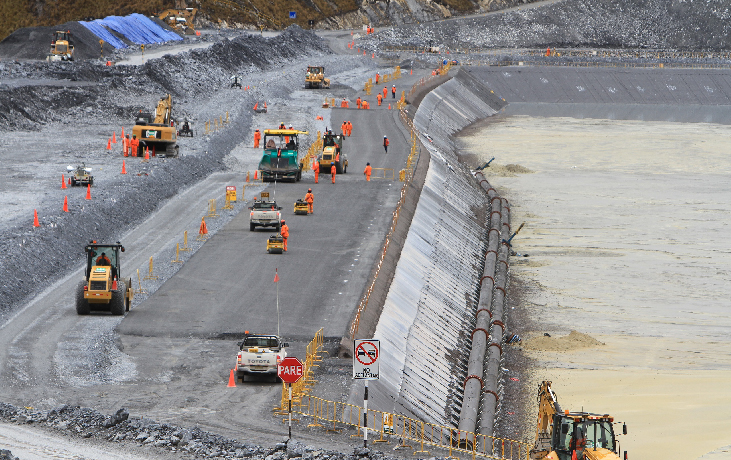
The Ministry of Energy and Mines (Minem) reported that in November 2020, investments amounted to US$ 384 million, showing a slight recovery of 0.7% with respect to the previous month; however, a year-on-year contraction of 38.3% was registered with respect to November 2019.
In its mining statistics bulletin, Minem also stated that from January to November 2020, mining investments amounted to US$ 3,667 million, an amount that is 31.1% lower than that recorded for the same period in 2019, when investments amounted to US$ 5,325 million.
In terms of companies, in the period from January to November, Anglo American Quellaveco maintained its first position with a 32.0% share, in addition to being leader in four of the six investment areas.
On the other hand, Marcobre ranked second with 12.0%, while Minera Chinalco Peru remained third with 6.9%.
By category
Regarding categories, Minem detailed that in November 2020, Mining Equipment, Development and Preparation, Exploration and Others reported positive month-to-month variations.
"Thus, regarding investment in Mining Equipment, in November 2020, it registered the second consecutive month of growth with an executed investment of US$ 46 million, which translated into an increase of 10.8% with respect to the previous month.
In the Development and Preparation category, US$ 44 million was invested in November 2020, an increase of 7.1% over the previous month. Thus, the amount executed in the aforementioned item continues to increase for the sixth consecutive month.
Investment in Exploration amounted to US$ 21 million in November, a month-on-month increase of 0.6%. As for the accumulated value of investments in exploration as of November, it amounted to US$ 194 million, showing a 39.3% drop with respect to the same period of the previous year. It is worth noting that the figure obtained in November is the highest amount of investment in exploration registered since March 2020.
proEXPLO 2021: Mineral Resources for a Sustainable Future
Ingemmet identifies polymetallic zones with potential in Cajamarca
 6th January
6th January
Ingemmet identifies polymetallic zones with potential in Cajamarca
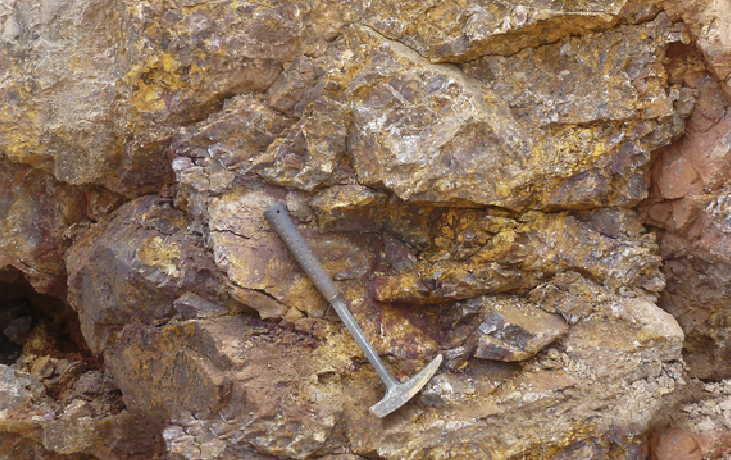
In the survey, we took as a base the lithostratigraphic units, the Miocene magmatism, the petromineralogy, and the geochemical and spectral anomalies, in a total area of 323.90 km2; where 187 samples were collected for geochemical and petromineralogical studies, identifying four zones of very high and high prospective interest and four zones of medium to low prospective interest.
The study concluded that the zones with the highest prospective interest are San Antonio, with slightly anomalous values of copper (456 ppm), lead (210 ppm) and zinc (714 ppm) with traces of gold (11 ppb); and Buenos Aires, with slight anomalies in silver (6 ppm), lead (795 ppm) and zinc (2412 ppm), as well as traces of gold (8 ppb) and copper (182 ppm).
Similarly, prospective interest was identified in Chamanal with slight anomalies in silver (2 ppm), copper (874 ppm), lead (96 ppm) and zinc (344 ppm) and gold (372 ppb); and in Alto Cocharán with gold (537 ppb), lead (127 ppm), antimony (60.7 ppm) and zinc (685 and 225 ppm).
On the other hand, according to the mining potential map prepared, in the Cajamarca region, there are areas with a very high mining potential (4.65%); high mining potential (64.3%); medium mining potential (6.3%); low mining potential (24.27%) and very low mining potential (0.48%).
There are eight zones, the study locates the Chamanal, Alto Cocharán, San Antonio, Buenos Aires and Las Colpas deposits in the Strip VI of Porphyry and skarn of the upper Jurassic and they are related to porphyry system deposits", stated Ingemmet.
Furthermore, Ingemmet added that the Succhapampa and Chontilla deposits are located in Strip XXI of gold and silver epithermals. While El Sauce deposit would be located in the Strip XX of Miocene Porphyry related to deposits of porphyritic systems.
"The largest metallic mining potential is found mainly in the northern and eastern sectors of the provinces of Cajamarca, Hualgayoc and the surroundings of Cajabamba. Other areas of interest are the eastern part of Celendín and Chota provinces, Cutervo, a large part of Chota, except for the Bagua basin, and to the far north, in San Ignacio province," stated Ingemmet.
proEXPLO 2021: Mineral Resources for a Sustainable Future
Minem approved 9 FTAs constituting investments of over US$ 13 million in 2020
 6th January
6th January
Minem approved 9 FTAs constituting investments of over US$ 13 million in 2020
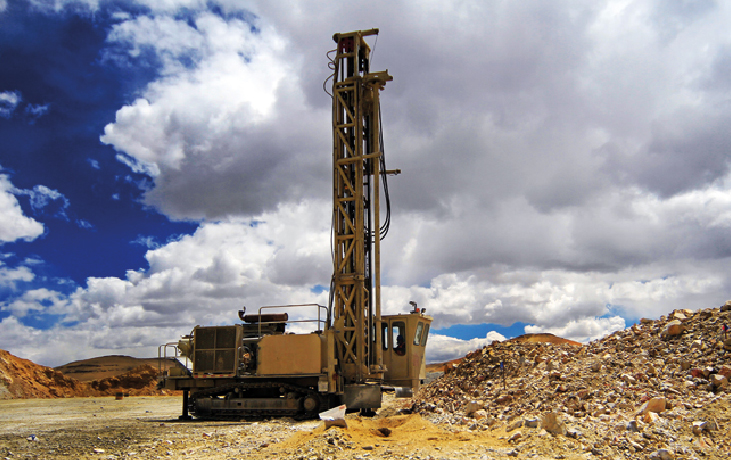
The Ministry of Energy and Mines (Minem) approved a total of 9 Environmental Technical Files (FTA), which represented investments of US$ 13'499,200 during 2020.
According to Rumbo Minero, the largest amount invested was US$ 3.7 million and came from the "Apache" mining exploration project (in Moquegua) presented by Minera Antares Peru, a company whose main objective was to confirm the existence of copper (Cu) reserves through the execution of 40 diamond drillings distributed in 20 platforms.
The second largest investment project was Nexa Resources' "Chorobal", which would require an investment of US$ 2'970,000. Thus, this media could find out that the main objective was to obtain geological information to prove the existence of economically exploitable mineralization, copper (Cu) and zinc (Zn), from the exploration of 26 drill holes distributed in 12 diamond drilling platforms.
Meanwhile, Corisur, a subsidiary of Canadian Auryn Resources, would be interested in knowing and evaluating the existence of mineralized bodies and structures in the "Curibaya" project. The budget was estimated at US$ 1.9 million, ranking third among the largest amounts.
Similarly, Minem granted Questdor the approval to execute a diamond and reverse air drilling program, in order to identify or discard the presence of economic copper mineralization at 100%, considering the construction of 20 platforms, and the execution of four drill holes in each platform for its Parcoy project.
The FTAs of "Los Perdidos" (Nexa Resources), "Oroya Este" (Alpayana) and "Humamantata" (Apurimac Copper) were also approved and would require US$ 1'359,000, US$ 670,200 and US$ 500,000, respectively.
In addition, Minera Barrick Misquichilca received the approvals of its exploration projects "El Alto" and "La Bandera", with budgets estimated at US$ 300,000 each.
proEXPLO 2021: Mineral Resources for a Sustainable Future
Interview | Eng. Jonas Mota e Silva, member of the Organizing Committee of XII International Congress of Prospectors and Explorers (proEXPLO 2021)
 4th January
4th January
“This proEXPLO edition will focus on innovation and success in exploration”
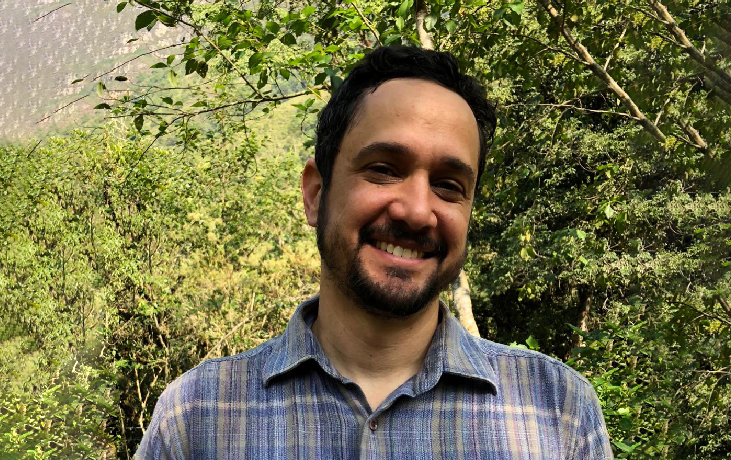
Engineer Jonas Mota e Silva also highlighted that in the upcoming edition of proEXPLO 2021 congress, to be held from March 22 to 26, the optimal transition of a project to a mine will also be discussed.
What are the objectives of the 12th Congress of Prospectors and Explorers (proEXPLO 2021) organized by the Peruvian Institute of Mining Engineers (IIMP)?
ProEXPLO has been playing an essential role in Peruvian mining exploration, as it has brought together stakeholders from industry, academia, government entities and investors, creating a diversified space for the exchange of ideas.
For this edition, the congress slogan is "Mineral Resources for a Sustainable Future", allowing us to focus not only on business, but also on a look at how we can establish better environmental and social practices in the future. Exploration and mining want to go beyond their business in conjunction with the Government, the third sector and universities, to drive a movement to transform society for a better future for all.
Similarly, this proEXPLO edition has much from the President of the Organizing Committee, Eng. Enrique Garay, who is a very pragmatic person; therefore, emphasis is being given to fundamental issues such as innovation and success in exploration; because I believe that looking at discoveries that occurred in the past will help us succeed in the future.
Another fundamental aspect that will be covered in this congress will be the optimal transition from project to mine. We always focus a lot on the project or the mine; but the transition is a very risky stage. Therefore, having talks and specific discussions about this is very interesting.
How is work progressing regarding the keynote speeches for proEXPLO 2021?
Conference topics will be very interesting and the pandemic is "to blame" for this; because with the pandemic, the event went online and this has made it easier for us to bring in top professionals, people who are very expert in their fields. In addition to proEXPLO's technical talks, the keynote speeches are worth attending, as they will be highly informative.
What do you think will be the contribution of proEXPLO 2021 to Peruvian mining?
I would say the contribution would be to global mining because Peru is a very important player in the industry. We are the second largest producer of copper, silver and zinc. We are a leading country in mining; and I believe proEXPLO is key as it brings together many players.
The words I would use to highlight the contribution of the congress are “connecting people”, as it will bring together different actors; “teaching” because of the knowledge gained in each talk; “exchanging” because it gives the opportunity to share something with the community; and “meeting people” from Peru and other parts of the world.
What takeaway do you want participants to take home at the end of proEXPLO 2021?
We want people to feel that they can be better professionals and people; that they leave proEXPLO 2021 as a more developed collaborative network with new tools to be more successful in their mining work, in academia, in their government position or in the industry in general.
There is also a word that we must all bear in mind and that is cooperation, we have to work together, we have to share information and look for solutions to make the mining industry and the planet a better place to live; we have to look for better societies and this pandemic has given us time to reflect, and each of us has to come out of this pandemic as better humans and professionals. So let's cooperate with each other to have a better future.
At the beginning you mentioned the importance of achieving a socially and environmentally friendly project. How can this be achieved, especially considering Peru's situation?
Society has changed a lot. If you look back 100 years ago, deforest a jungle to build a road and cities was a synonym of development; today it is a synonym of destruction. Currently we want preserved ecosystems, high biodiversity, responsible use of natural resources and societies that are in harmony with the industrial activities being developed in their environment.
As such, old practices would no longer exist in today's world, so we must first connect with local communities and together design the plan for how the mine will be and how the explorations will take place.
Treat local communities not as actors, but as partners in the project, because in many cases they have owned the land for many centuries. And there are examples of this. In the past no one would have imagined having a mine high in the Andes; or in the middle of the Andes or in the desert drawing water from the sea to do the processing and not using a drop of fresh water.
So these are things that are possible and are happening today in Peru, things that were never imagined in the past; but there is much more to come and many more wonderful things that mining can implement to be better.
What are the main characteristics of Peruvian geology? Is there any particular factor that makes Peru stand out from other mining countries?
Peru has a large stretch of the Andes Mountains, which is one of the most productive in terms of metallic minerals. In addition, apart from the formations of magmatic arcs, Peru has a large amount of limestone and salt deposition; this combination is not found in any other country in the region.
So, Peru has a part of the Andes that is developed over limestone, which makes it very special in terms of porphyry skarn type deposit and allows it to have silver and zinc; and it also has the traditional Andes with large porphyries as well as Chile; this is why Peru is also a great producer of copper and will continue to be so.
On the subject of copper, do you think it will cease to be an important metal as some experts say?
One of the talks in proEXPLO and that will be in charge of Msc. Eco. Erik Heimlich, a CRU expert, is a good opportunity to learn about the short and long term fundamentals of copper in the global market. In general, copper is seen as a metal that will be increasingly demanded by humanity.
Part of the copper consumed by humanity comes from recycling, from electronic devices that we have; but there is a lot of this metal that must be extracted from the earth because humanity still needs infrastructure, hospitals, electricity, basic things to continue living in good conditions; and as the experts say, they have good grounds for the next two or three decades.
After that time, there may be surprises; on top of that, in the next two decades the world will stop resorting to hydrocarbons and burning fossil fuels to move their cars and industries to an electric world, and in an electric world a lot of copper is used. For example, a normal gasoline car uses between 20-25 kg of copper and an electric car uses between 75-80 kg; and now we are already seeing in other parts of the world that the fleet of cars that run on hydrocarbons is already being replaced by hybrid or electric cars.
proEXPLO 2021: Mineral Resources for a Sustainable Future
60 technical papers to be presented at proEXPLO 2021
 30th December
30th December
60 technical papers to be presented at proEXPLO 2021
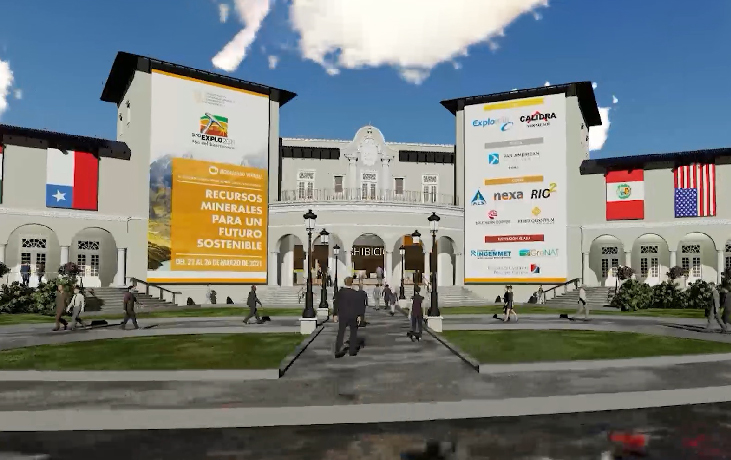
"These papers were selected from a total of 94 abstracts and were evaluated by the Review Committee, made up of specialists appointed by the Organizing Committee," stated the IIMP.
The IIMP adds that this set of 60 papers has been grouped into the following topics: innovation in mining exploration; economic geology and from discovery to mine. Presentations will also be given as oral and poster presentations.
Similarly, IIMP announces that renowned companies will be participating in the Junior and Prospector sessions of the proEXPLO 2021 technical program, which will be held from March 22 to 26.
“Peru on the road to CRIRSCO”
On the other hand, proEXPLO 2021’s organizer explains that on March 26th there will be a round table entitled "Peru on the road to CRIRSCO". CRIRSCO is an entity representing the mining industry in matters related to the classification and reporting of mineral assets.
"This round table will be integrated by the presidents of the National Reporting Organizations (NROS) of Brazil, Chile and Colombia; the president of CRIRSCO and the president of the Peruvian Committee of Mineral Resources and Reserves", states the IIMP.
During the congress, the Geological, Mining and Metallurgical Institute (Ingemmet) will also discuss four topics that will be presented on the penultimate day of the event, while the Geological Society of Peru (SGP) will give a talk on "The Contribution of Women to the Peruvian Mining Exploration Industry".
Renowned Professionals
The Institute announces that the 12th International Congress of Prospectors and Explorers 2021 will have the participation of renowned professionals who will give keynote speeches on various current topics.
Thus, the presentations of Antoine Caté, Senior Consultant in Structural Geology at SRK Toronto; Thierry Sempere, Consultant and Exploration Manager at ANDES C&P; Jon Hronsky, Director of Western Mining Services (WMS); Michael Doggett, Mineral Economist from Vancouver (Canada); and Erik Heimlich, Senior Analyst of the Base Metals Analysis team at CRU have been confirmed.
proEXPLO 2021: Mineral Resources for a Sustainable Future
Interview | Eng. Carlos Urrea, member of the Organizing Committee of XII International Congress of Prospectors and Explorers (proEXPLO 2021)
 29th December
29th December
“proEXPLO 2021's contribution is a technological one”
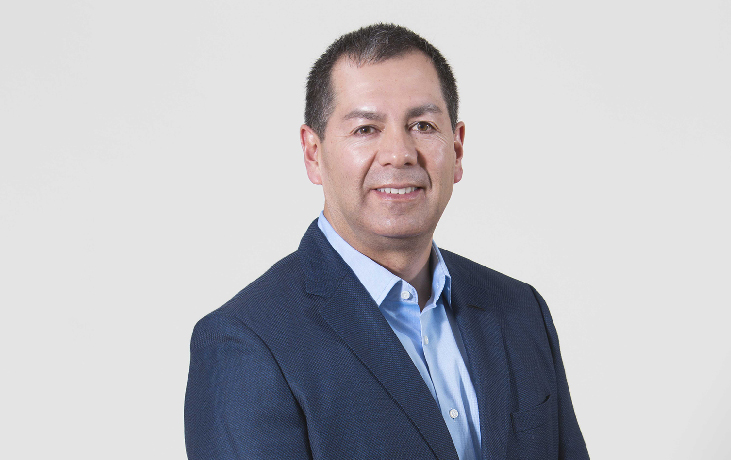
This was stated by Mr. Carlos Urrea, Executive President of EXPLOMIN Perforaciones and member of the Organizing Committee of proEXPLO 2021, an event organized by the Peruvian Institute of Mining Engineers (IIMP).
What are the objectives of the 12th Congress of Prospectors and Explorers (proEXPLO 2021)?
This will be the first time that the proEXPLO congress will be held online. Our aim is to promote and make known the new projects and prospects for mining exploration that we have in Peru, in the region and in other countries, in terms of geology, exploration and even new technologies that are being applied to new discoveries.
Furthermore, I believe that this event’s first virtual edition will be an open platform and will give us the opportunity to promote mining projects not only nationwide, but also at an international level, as it will have participants from other parts of the world, and it will surely arouse a lot of interest compared to previous editions.
I would like to take this opportunity to invite geologists and those of us involved in exploration activities to join us in this event. Registration is now open.
What are the advantages of proEXPLO 2021?
A great advantage of using a virtual platform is that it facilitates the sharing of knowledge and experience.
Similarly, it allows each exhibitor to present their products, services and technical information, and since there is no need to move equipment or involve complicated logistics, each exhibitor has the opportunity to interact with participants and general public from their home location, whether in Peru or abroad, as well as to create virtual conference rooms and digital networking.
Therefore, I encourage participants to familiarize themselves with the platform so that they can make the most of the virtual experience that proEXPLO 2021 offers.
What do you think will be the contribution of proEXPLO 2021 to Peruvian mining?
Undoubtedly, proEXPLO 2021's contribution is a technological one. I think that in the last few years, the digital disruption and transformation, not only experienced by the mining industry but by all industries in terms of communications and technology in general, has led to a huge amount of data and information that must be processed and this will contribute significantly to new discoveries. If all this comes together with the "permitting” process we need, especially in Peru, I believe that there will undoubtedly be a great advantage for new discoveries.
What takeaway do you want participants to take home at the end of proEXPLO 2021?
The message we should all grasp is that the world has already changed and those of us on the exploration side are not oblivious to this reality. What remains is to take advantage of the technological resources that we have at our disposal today in order to revise the projects, to produce more resources and to become more productive, which is what our country requires for the long awaited economic reactivation, since we need to develop more projects until they become mines.
How do you expect the market for exploration providers to develop in 2021?
Definitely, the market for goods and services suppliers is directly related to the price of minerals generated by the mining activity.
If we manage to make a division between precious metals, we see that gold and silver in recent months have maintained certain stability and are very much linked to political and economic issues. Meanwhile, base metals such as copper, zinc and lead have increased significantly in recent weeks, which has a direct impact on exploration and mining activity in the country. This can be seen in the greater demand for services, and today mining companies are exploring more than ever before. In turn, the government, I understand, is determined to expedite the permitting process that allow projects to move forward.
In this sense, suppliers of goods and services are constantly increasing their imports of products and inputs, most of which come from Asia or North America. On the other hand, service suppliers are also looking forward to constantly innovate with new technologies that allow for higher safety standards and higher productivity to reduce costs.
How do you envision mining exploration in 2021?
For me, there are 2 sides. The situation in 2020 caused by the COVID-19 pandemic has clearly led to a halt in mining exploration activity in the country; and on the other hand, the higher prices of both precious and base metals that we have seen in recent months have generated great expectations for the coming year, even beyond the political issue that our country is facing.
Therefore, since mining companies urgently need to replace the mining resources they have already consumed during this year, there is a greater demand for services; this is also accompanied by new technology that allows for significant cost savings and higher safety levels, which makes me think that the levels of geological exploration will be quite interesting next year.
What new developments are expected in terms of technology for mining exploration?
It is well known that obtaining an exploration permit in our country is very complicated. In this sense, a clear example of technological innovation is directional drilling with which it is possible to drill from the same point towards several targets within the mining property without having to build many drilling platforms.
It is well known that when a company applies for an exploration permit it needs to place a number of platforms and requires declaring the exact location of each platform; then, with the directional drilling technology, it is possible to reach many exploration points in depth from very few platforms. For example, this is a very clear contribution through which technology facilitates exploration work in terms of time and costs.
On the other hand, we have the use of automated equipment with rod manipulators that raise safety standards, expose the personnel to fewer risks and make the activity more productive.
In this sense, there are projects that were explored many years ago and no geological potential was discovered; however, today with the use of technology these areas can be re-explored. This is how new projects have appeared where many companies had previously explored and today a natural resource with significant potential to become a mine in the future has just been discovered.
proEXPLO 2021: Mineral Resources for a Sustainable Future
The Vice-Ministry of mines will promote mining exploration
 28th December
28th December
The Vice-Ministry of mines will promote mining exploration
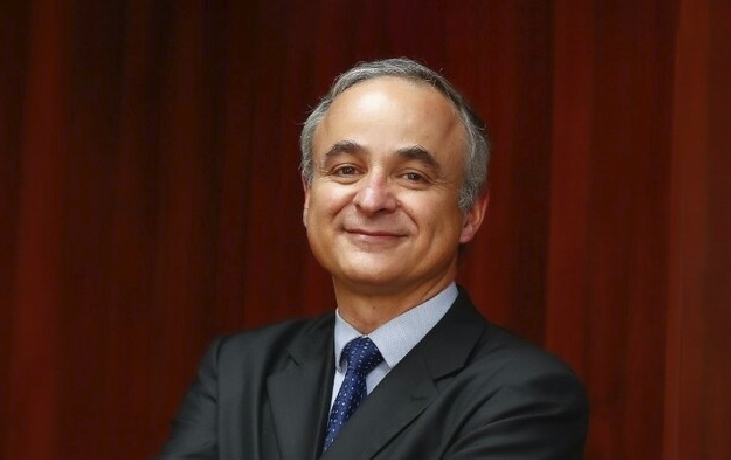
"Mines that do not explore come to an end and, with it, foreign exchange inflows, canon, work and social responsibility; therefore, we have to explore, this is an important matter for us", declared Vice-Minister Montero.
Furthermore, the official considered that mining exploration represents a very high risk investment, because there is no certainty about the proven, probable or inferred reserves.
"I would say that out of every 100 exploration projects, only 1 becomes a mine. In addition, during an exploration we are not talking about canon, about employment, we cannot talk about a local supplier because we do not know if there is something there, maybe there are resources, but they do not justify a mine," he said.
In view of this and regarding the development of prior consultation at this stage of mining activity, Vice-Minister Montero explained that the Ministry of Energy and Mines (MINEM), headed by Minister Jaime Gálvez, has been working on the issue from a technical perspective.
"Thinking about prior consultation in this business scenario with such a high risk really seems to be an opportunity for improvement. We are trying to understand where the opportunity for improvement lies so that we can streamline processes and promote exploration in Peru more effectively without infringing on rights", he said.
Two More Core Aspects
The Vice-Minister of Mines, Jorge Luis Montero, informed that his administration, apart from exploration, will also focus on managing conflicts..
"It is the second most important issue for us; because if we don't manage conflicts what we have are mines that are halted, blocked, stopped and the effect in the end is the same, we lose foreign currency, royalties (canon) and development opportunities," he emphasized.
Similarly, he commented that the third most important issue is the closure of mines due to environmental impacts.
"We are in an interesting and dynamic exchange of ideas with the Ministry of the Environment and we are looking at ways to promote a deeper discussion with normative forecasting for a more effective mine closure, a mine closure that takes place in stages as the mine evolves and the final mine closure," he revealed in Rumbo Minero TV.
proEXPLO 2021: Mineral Resources for a Sustainable Future
Mining will consolidate its recovery with the start of new projects
 28th December
28th December
Mining will consolidate its recovery with the start of new projects
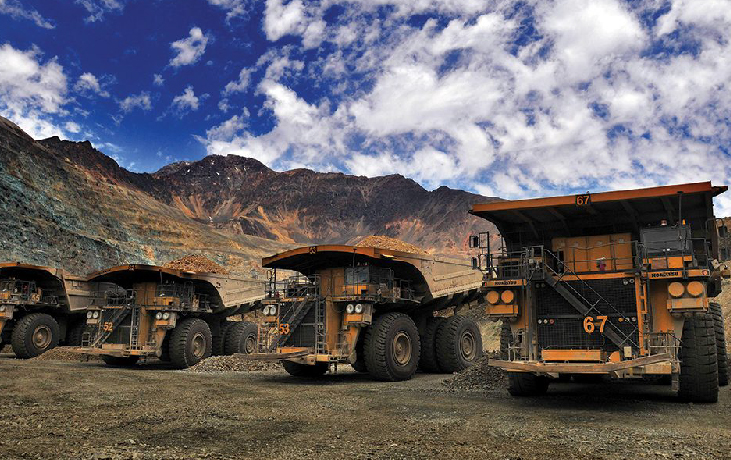
Thus, the gross domestic product (GDP) fell 16.3% in March, 40.49% in April, 32.75% in May, 18.06% in June, 11.7% in July, 9.82% in August, 6.95% in September and 3.79% in October due to the current situation affecting our country.
Meanwhile, mining activity decreased 22.98% in March, 47.21% in April, 49.90 in May, 13.55% in June, 6.41% in July, 10.22% in August, 10.88% in September, 1.08% in October, according to information from the National Institute of Statistics and Information (INEI).
"In mid-December 2020, the Ministry of Energy and Mines (MINEM) predicted that the mining sector would close the year with a level of production close to that recorded before the onset of the coronavirus pandemic.
"The good news is that, for the first time this year, in October the production of copper was 207,000 tons, higher than what was reported in the same month last year," said the head of MINEM, Jaime Galvez.
Outlook 2021
For his part, the former Deputy Minister of Mines, Romulo Mucho, said that the prices of (most) metals have significantly improved in recent months and that this will contribute to the annual result.
“For next year, the good performance of mining production will be encouraged by the start of operations at Mina Justa and the expansion of Toromocho. These projects will contribute to the growth of mining in 2021", said Mr. Mucho.
According to the recent inflation report of the Central Reserve Bank (BCR), metal mining will register an improvement of 14.4% in 2021, explained by the normalization of mining production and the start of operations of Mina Justa and the expansion of Toromocho.
"In addition, the growth of the Chinese economy, which demands 53% of the world's copper production, will contribute to the progress of mining activity in 2021," said the specialist.
Similarly, according to the latest Inflation Report of the Central Reserve Bank (BCR), the Chinese economy would register a growth of 1.7% this 2020 and 8.1% in 2021.
On the other hand, the Minister of Energy and Mines maintained that the mining deposits would not stop their operations, in case confinement returns in case of an eventual resurgence of the COVID-19.
Meanwhile, mining activity decreased 22.98% in March, 47.21% in April, 49.90 in May, 13.55% in June, 6.41% in July, 10.22% in August, 10.88% in September, 1.08% in October, according to information from the National Institute of Statistics and Information (INEI).
"This considering that the companies that develop this productive activity have in place the respective biosafety protocols for their workers," said Galvez.
In this regard, Romulo Mucho, considered that the mining activity is well prepared to face an eventual new wave of coronavirus.
"For example, mining companies have invested in the expansion of their camps. So, in the spaces where before two people slept, now only one does, among other things," he said.
Mining Projects 2021
According to MINEM, next year, about seven mining projects will initiate construction works with a promised investment of US$ 3.577 billion.
The most important of this group is Yanacocha Sulfuros (Cajamarca), which will commit investments of US$ 2.1 billion.
Work is also expected to begin on the Corani (Puno) scientific project, which will require an investment of US$ 579 million.
Another important initiative is the San Gabriel gold project, located in the Moquegua region, which will require an investment of US$ 422 million, and finally the expansion in Ica of Minera Shouxing Peru, an iron producer, for US$ 140 million.
Sources: El Peruano
proEXPLO 2021: Mineral Resources for a Sustainable Future
Portfolio of mining exploration projects exceeds US$ 498 million
 21st December
21st December
Portfolio of mining exploration projects exceeds US$ 498 million
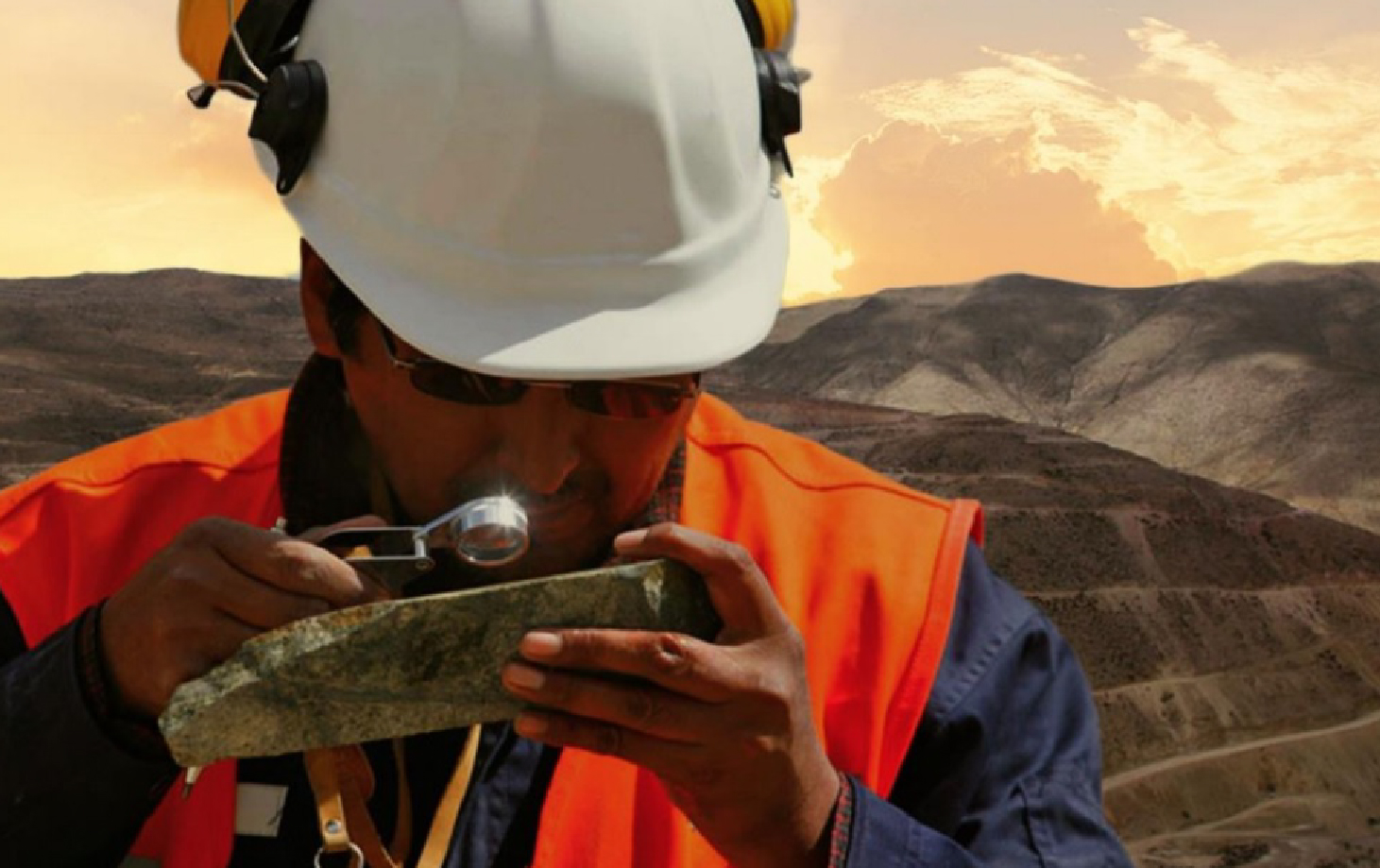
Regarding minerals, the ministry detailed that copper projects rank first with an investment of US$ 262 million distributed in 18 exploration projects in the portfolio.
In second place are the 21 gold projects with an accumulated investment budget of US$ 90 million; followed by the 13 silver projects with a joint investment of US$ 82 million.
Locations by Regions
In the same document, the Ministry of Energy and Mines specified that the largest investments in exploration are found in the south with 21 projects, representing 56% of the total with an investment of US$ 279 million, among which the regions of Arequipa, Moquegua and Apurímac stand out.
In second place is the central macro-region with 30 exploration projects representing 25% with a joint investment of US$ 124 million; and the most outstanding regions are Pasco, Lima and Ayacucho.
Finally, the northern macro-region with 13 projects represents 19% participation and a global investment of US$ 96 million. Among its regions, Cajamarca and Ancash stand out.
proEXPLO 2021: Mineral Resources for a Sustainable Future
Poderosa, Buenaventura and Horizonte lead exploration investment as of october
 21st December
21st December
Poderosa, Buenaventura and Horizonte lead exploration investment as of october
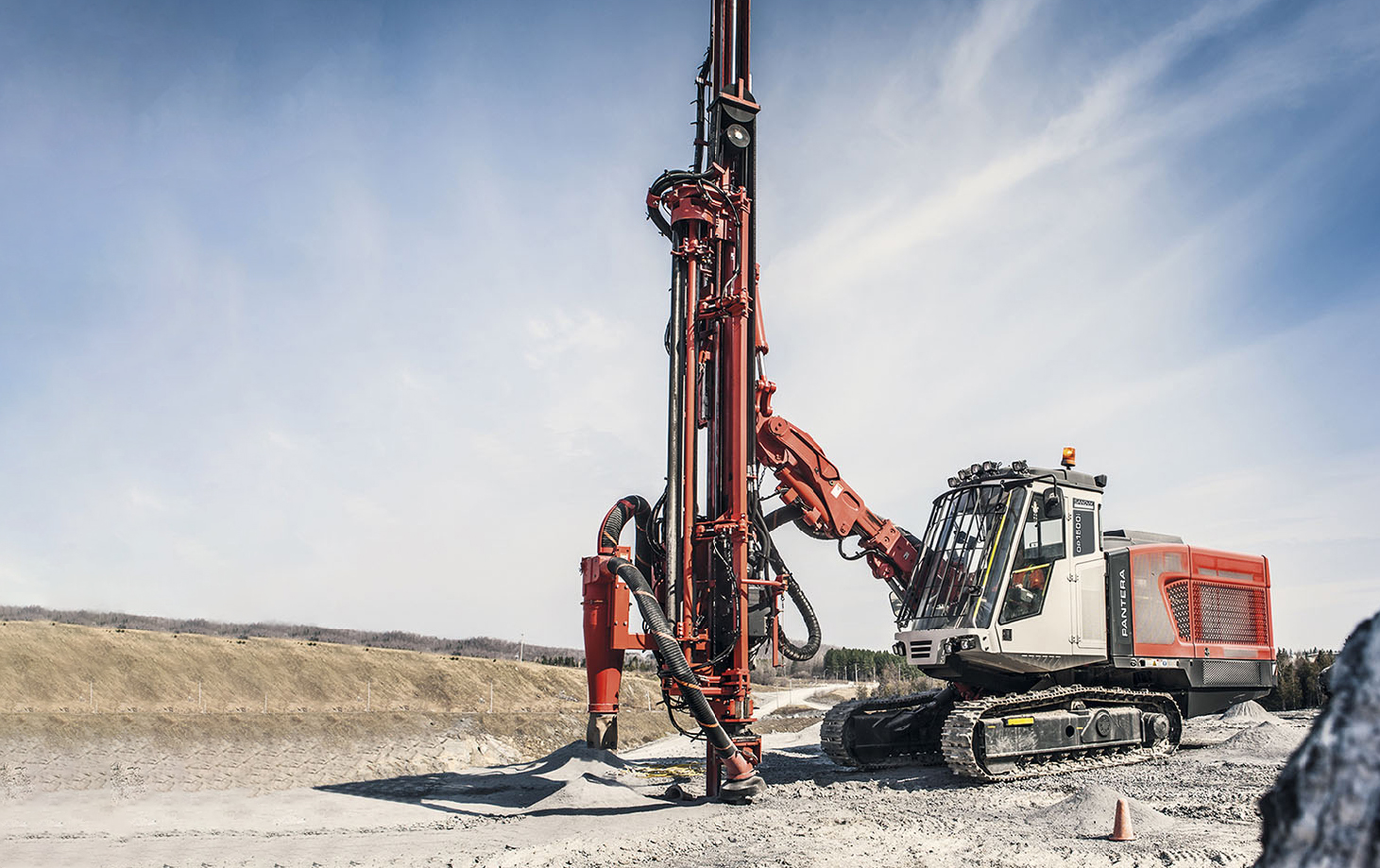
Last August, the Geological, Mining and Metallurgic Institute (Ingemmet) granted a total of 297 concession titles at a national level; accumulating a total of 984, without considering the months of April, May and June.
The first company was Compañía Minera Poderosa, which spent US$ 27.5 million, or 15.9% of the total investment. It was followed by Compañía de Minas Buenaventura with an investment of US$ 17.9 million (10.4%); and Consorcio Minero Horizonte that allocated US$ 11.1 million, an amount that represented 6.4% of the total investment in this activity.
Likewise, the ranking of the first five places was completed with Minera Barrick Misquichilca and Nexa Resources with investments of US$ 10.6 million and US$ 7.3 million, respectively.
Positive results
In October, investment in mining exploration amounted to US$ 21 million, reflecting a 24.3% month-on-month increase and the second consecutive month of growth..
proEXPLO 2021: Mineral Resources for a Sustainable Future
World´s largest gold mines
 17th December
17th December
World's largest gold mines
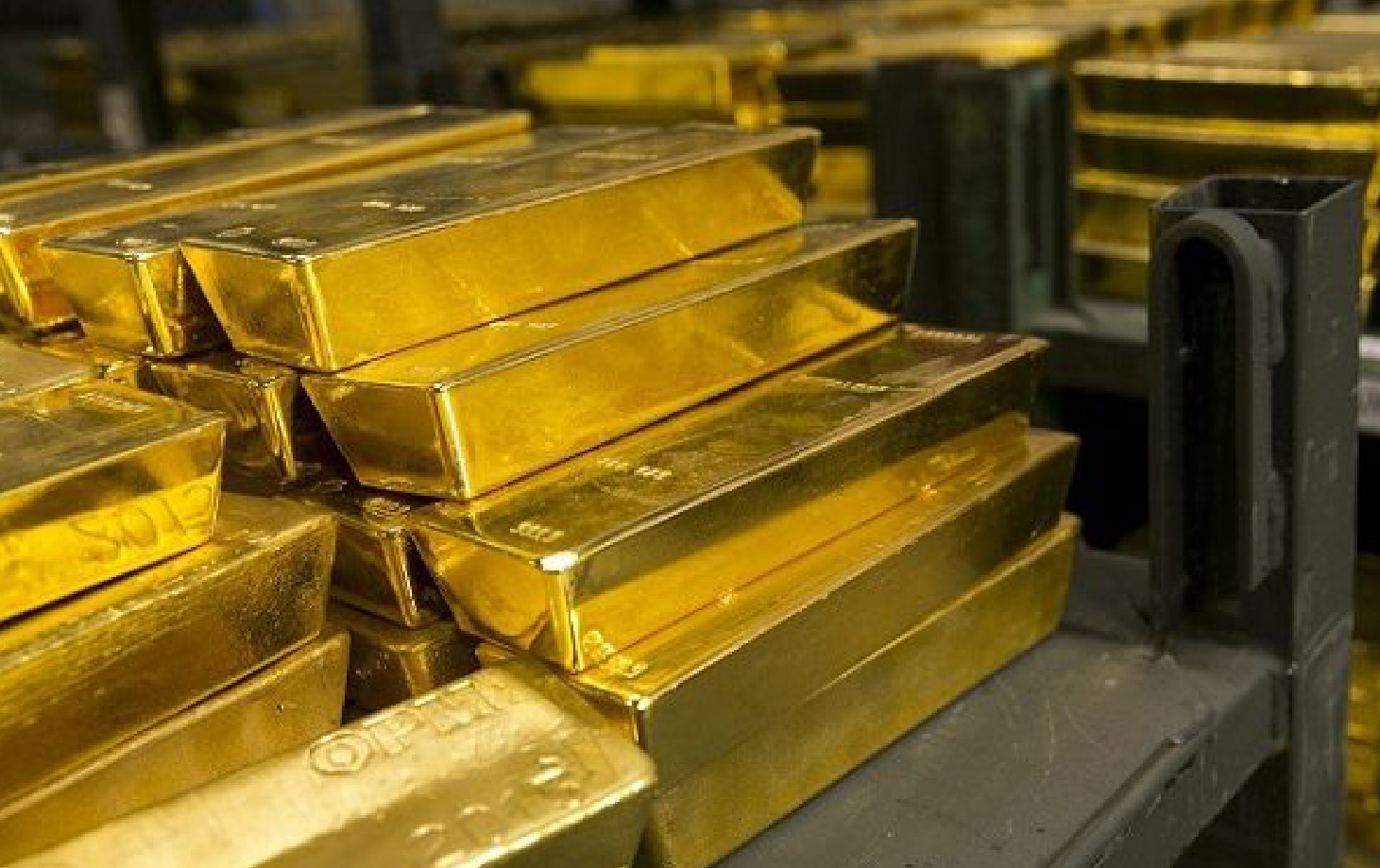
Other important sources of gold include the extremely deep Mponeng mine in South Africa, the Super Pit and Newmont Boddington mines in Australia, the Grasberg mine in Indonesia, and mines in the state of Nevada in the United States.
China is currently the world's largest gold producer, while Canada, Russia and Peru are also major players internationally.
In terms of companies, Nevada Gold Mines, majority owned by Canadian company Barrick Gold, is the largest gold mining complex in the world, with a production of around 3.5 million ounces per year.
Although new gold mines are still being found, experts point out that discoveries of large deposits are becoming increasingly scarce. As a result, most gold production now comes from older mines that have been in use for decades.
Pueblo Viejo Displaced Yanacocha in Latin America
For nearly two decades, Minera Yanacocha in Peru was the leading gold producer in Latin America. However, various circumstances caused its production to drop and its privileged position to be occupied by the Pueblo Viejo mine in Dominican Republic.
Pueblo Viejo was the fourth largest production mine in 2018, with a total of 30.1 tons and projected to reach 31.1 tons in 2019, according to oroinformación.com magazine. However, its production rate was declining due to the lower concentration of gold in the ore extracted, the magazine explains.
Its owner, the Canadian Barrick Gold, has undertaken an expansion process "that will allow the leading mine (in the region) to extend its useful life to the 2030s or even beyond," states the publication.
Sources: BBC Mundo, oroinformación.com and MINEM
proEXPLO 2021: Mineral Resources for a Sustainable Future
Mining exploration: Overview of 2020 and what to expect in 2021
 17th December
17th December
Mining exploration: Overview of 2020 and what to expect in 2021
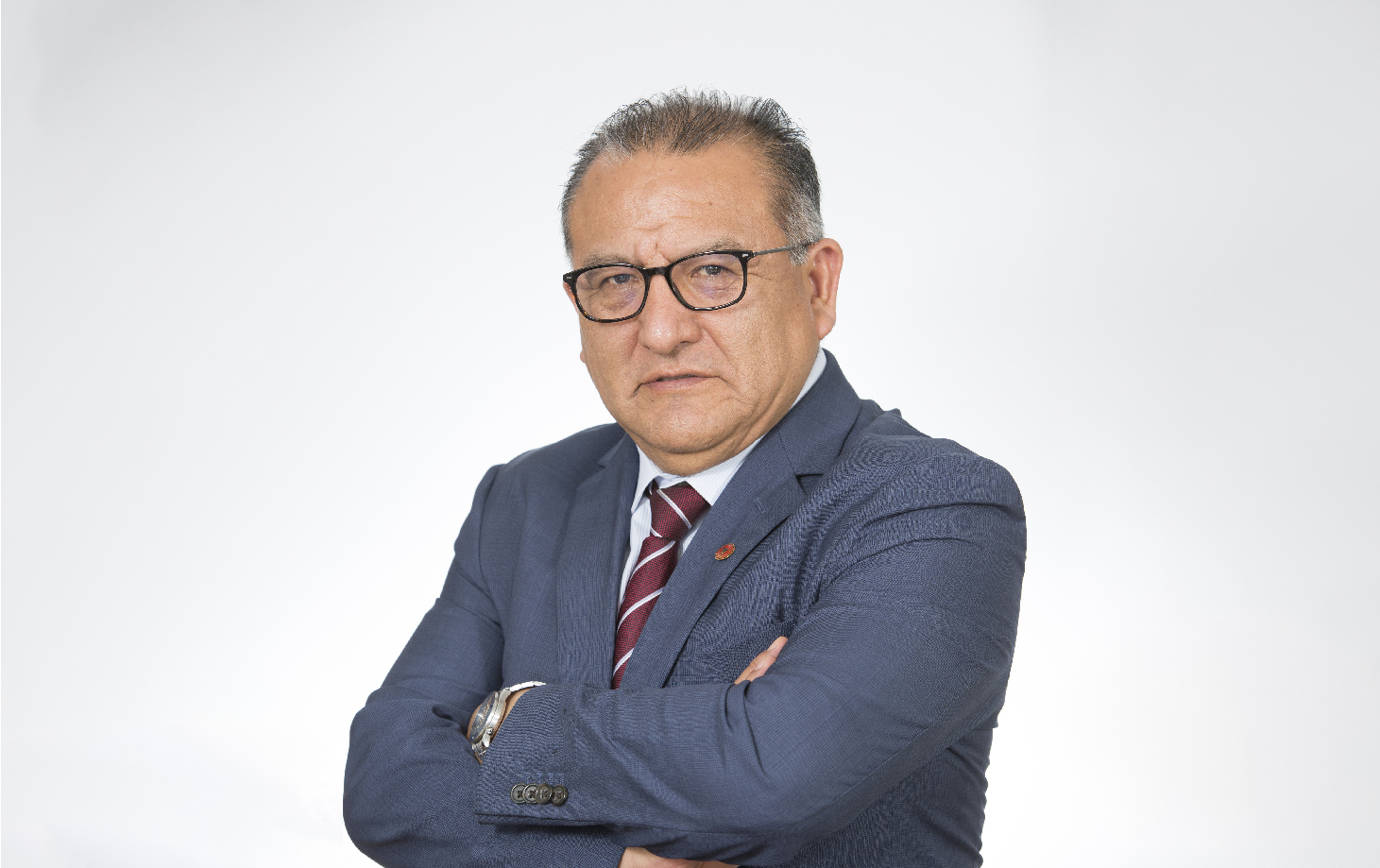
It has also been demonstrated that mining is and will be the activity that enables a rapid economic recovery through its linkages to other activities, as well as the generation of income and direct and indirect employment at the national level.
In this context, Peru's mining exploration plays a strategic role, since it is the initial activity in the mining production process, without forgetting that it competes in attracting investment with other countries with geological potential around the world that offer a competitive framework and environment.
Hence the urgency to continue promoting measures to promote exploration not only in brownfield projects but mainly in greenfield projects, as the future of mining depends on the progress of investments in exploration and new mining discoveries.
The COVID-19 pandemic had an impact on exploration investment in 2020, which shrank by 40% between January and October compared to a similar period in 2019, according to the Ministry of Energy and Mines (MINEM). And we believe that the 64 exploration projects developed in 2020 will increase next year.
To this end, we consider it important that other ministries accompany MINEM's efforts to facilitate mining exploration. In this regard, the modification of the Environmental Protection Regulations for Mining Exploration Activities in 2020 stands out, which established a positive administrative silence for the applications of the Environmental Technical File (FTA).
Also relevant was the establishment of a maximum period of 60 working days for the Agency of Environmental Assessment and Enforcement (OEFA) to control the closure of mining exploration projects, since the mine holder submits the corresponding closure report.
In addition, it is worth noting MINEM's initiative to seek to expedite the procedures for exploration by exchanging the prior consultation process for a prior agreement that would be negotiated with the communities when evaluating the lands where exploration will take place. The intention is to apply the existing regulations without leading to a prolonged process. The aim of this initiative is to reduce to about six months the time it takes to complete a prior consultation process in the exploration stage, which usually takes one year.
On the other hand, professional geologists, who are experts in mining exploration, use a set of advanced technological tools: big data, machine learning, artificial intelligence, among others, which contribute to the discovery of new mineral deposits in a sustainable way.
These are some of the topics that will be addressed at the 12th International Congress of Prospectors and Explorers - proEXPLO 2021, which under the slogan: "Mineral Resources for a Sustainable Future", is organized by the Peruvian Institute of Mining Engineers and will take place between March 22nd and 26th, 2021.
proEXPLO 2021: Mineral Resources for a Sustainable Future
Interview | Jean Vallance, member of the Organizing Committee of XII International Congress of Prospectors and Explorers (proEXPLO 2021)
 4th December
4th December
"proEXPLO will contribute to strengthen links between academia, industry and investors"
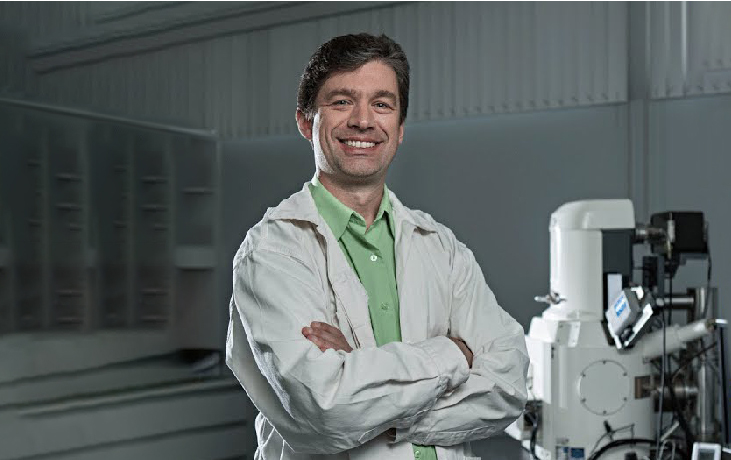
Stated Jean Vallance, member of the Organizing Committee of the 12th International Congress of Prospectors and Explorers - proEXPLO 2021.
What are the objectives of the 12th Congress of Prospectors and Explorers (proEXPLO 2021)?
Our first goal is to hold for the first time a fully online congress under the particular circumstances we have now. Being fully virtual allows us to have a new way of communicating between us and it is also a new way of having more channels.
The other objective of this congress is to contribute to strengthen the links between academia, industry and investors. Similarly, we will seek to strengthen the development of mining exploration in an environmentally clean context and focused on meeting requirements.
How goes the public acceptance of proEXPLO 2021 courses?
The first thing we did was to choose the subjects of the courses, so the members of the Organizing Committee did some surveys in our circle; and as each member of the committee has his or her specialty, we know which subjects can be interesting and necessary.
On the other hand, we know that proEXPLO courses have been successful among the public; this is why 8 subjects have been designed with local and foreign experts (United States, Australia, Sweden).
In the case of course registrations, there is a slight difference with respect to congress registrations or the delivery of technical papers. Currently we do not have much news; which is normal because in November and December mining companies and stakeholders are very busy with closing annual budget matters. So, what we are going to see is an increase in registrations at the beginning of February, which is what happens in every edition of proEXPLO.
What do you think will be the contribution of proEXPLO 2021 to Peruvian mining?
ProEXPLO is above all a space for the different mining stakeholders to share; so we will have several conferences with presentations of new geological and geophysical concepts applied to exploration; and we will look at other subjects related to improving productivity involving geometallurgy, machine learning and job opportunities.
It is also a space where companies can share their experiences of relations with community and environment; therefore, it is proEXPLO's contribution to create this space for discussion so that each actor can share their experience and enrich the debate and generate new ideas for the common good.
What takeaway do you want participants to take home at the end of proEXPLO 2021?
This congress will be very unique because of the COVID-19 pandemic; but in spite of this pandemic we want to convey the message that progress is still being made in academia, industry, society and environment. Things do not stop completely and we want to bring as much normality as possible to the events and move forward with proEXPLO. In the future, this virtual modality could continue in part, allowing specialists to participate, who in previous years would not have been able to be present. So it is an opportunity that we should also take advantage of.
Why is mining geology important?
Geology has always been important to the mining industry and has become increasingly essential over the years for two main reasons. The first is because it is increasingly difficult to find new mineral deposits; and deposits that exist on the surface have already been discovered and now the challenge is to find deeper deposits that are not so easy to detect. So a geological analysis is very important for that and absolutely essential.
The second reason is that, because of this difficulty in finding deposits, companies are looking to make the most of deposits already known; optimizing production, and favoring brownfield exploration to increase the life of operations; which makes it possible to compensate in part for the difficulty of finding new deposits; and at this stage geology is also essential.
What are the aspects you think Peruvian mining geologists should improve in order to become more competitive?
One of the great qualities of the Peruvian mining geologist is that he is a highly motivated, hard-working person, used to the difficult geographical conditions of Peru, such as the relief, the altitude of working at over 4,000 meters for weeks in an adverse climate, and being away from family for a long time. He/she also has good knowledge of mineralogy and topography.
For me, what needs to be improved is the proficiency in foreign languages, particularly English. Speaking English is a sine qua non for a Peruvian geologist who wants to work inside or outside Peru and it is also a sine qua non to keep his/her knowledge up to date through readings that are essentially in English and that are focused on geology and other subjects related to the mining world. It is also useful if you want to attend congresses such as proEXPLO or courses, and lately there is a lot of learning material on the Internet, especially on YouTube, but most of them are in English.
proEXPLO 2021: Mineral Resources for a Sustainable Future
National Geological Map of Peru Will have an integrated database in 2022
 1st December
1st December
National Geological Map of Peru will have an integrated database in 2022
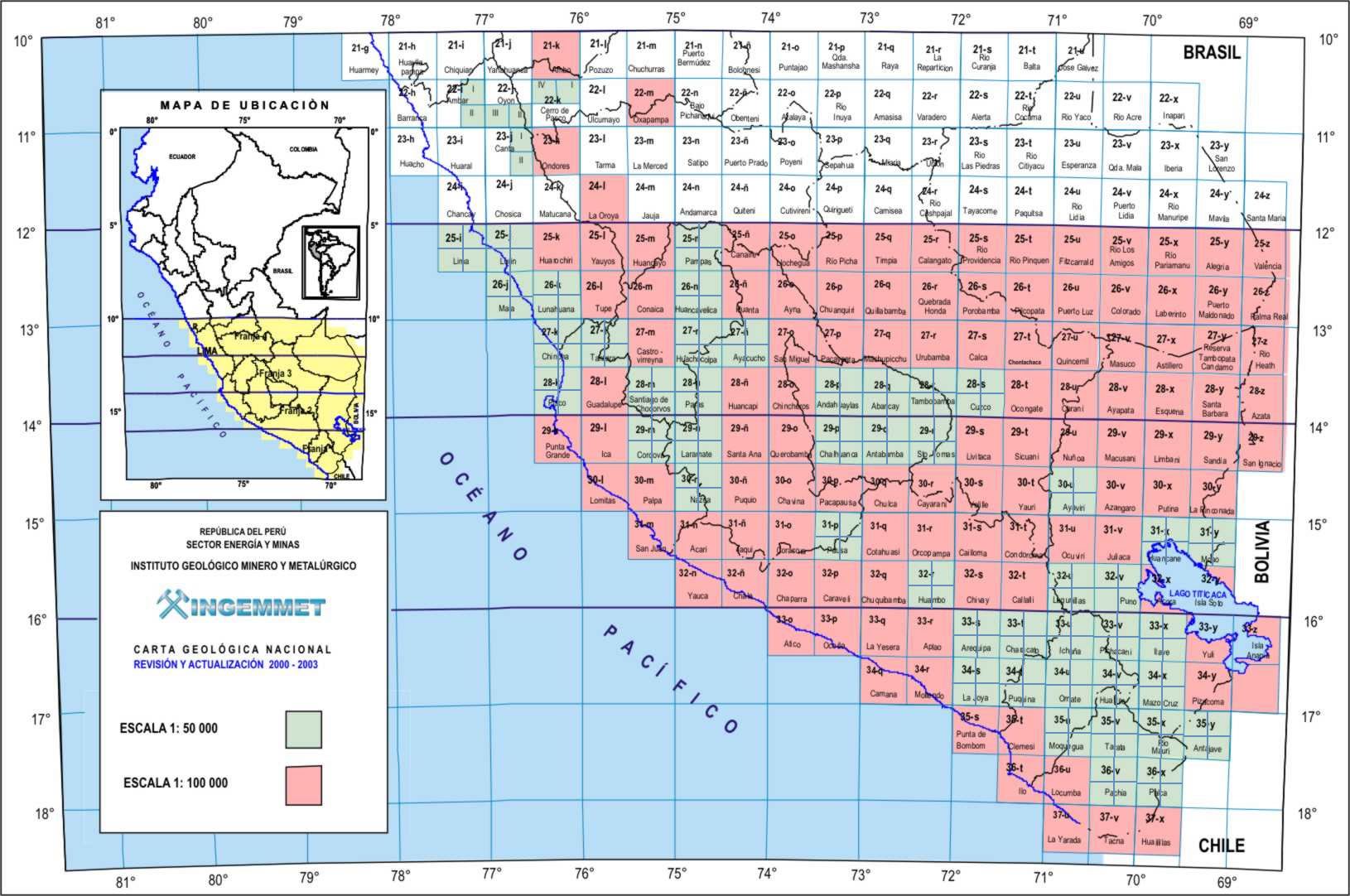
This was reported by Elvis Sánchez, researcher of the Regional Geology Directorate (DGR) of Ingemmet. In addition, he highlighted the use of Artificial intelligence (AI) for the synthesization and automation of stages in the development of the geological map at any scale.
The specialist participated in the virtual event 1st Seminar of the National 50k Geological Map, from the Coast to the Sub-Andean and its applications, under the topic "Challenges and perspectives of digital cartography in the National Geological Map to improve the quality of information and the participation of users in its elaboration".
Sanchez detailed that the use of technology for making geological maps consists of three stages: pre-field, field and post-field.
Importance of AI
On the last day of the event, which had the #SinCienciaYTecnologíaNoHayFuturo (No Science, No Technology, No Future), the application of Machine Learning in the creation of the National Geological Map on a scale of 1:50,000 was discussed.
In this regard, Luis Coba made a presentation on "The use of machine learning in the preparation of digital geological maps and its application in various research studies", where he indicated that in order to use this AI a standardized database is indispensable.
"In a digital geological map and with a database it is possible to make quick queries and elaborate different types of maps according to the user's needs", said Coba, who also highlighted that the technology makes it easier for the user to download and use the information.
It is worth mentioning that data architecture: related tables, frame standards, colors and others, are available so that users can elaborate maps in scales, depending on their requirements, under the same standards with which Ingemmet cartography is developed.
The event was closed by Engineer Rildo Rodriguez, Director of Regional Geology, who highlighted that the information provided by Ingemmet, through the geocatmin and the National Geological Map, promotes and enhances economic recovery.
proEXPLO 2021: Mineral Resources for a Sustainable Future
Prior Consultation of Projects Monica Lourdes and Jasperoide successfully completed
 1st December
1st December
Prior Consultation of Projects Monica Lourdes and Jasperoide successfully completed
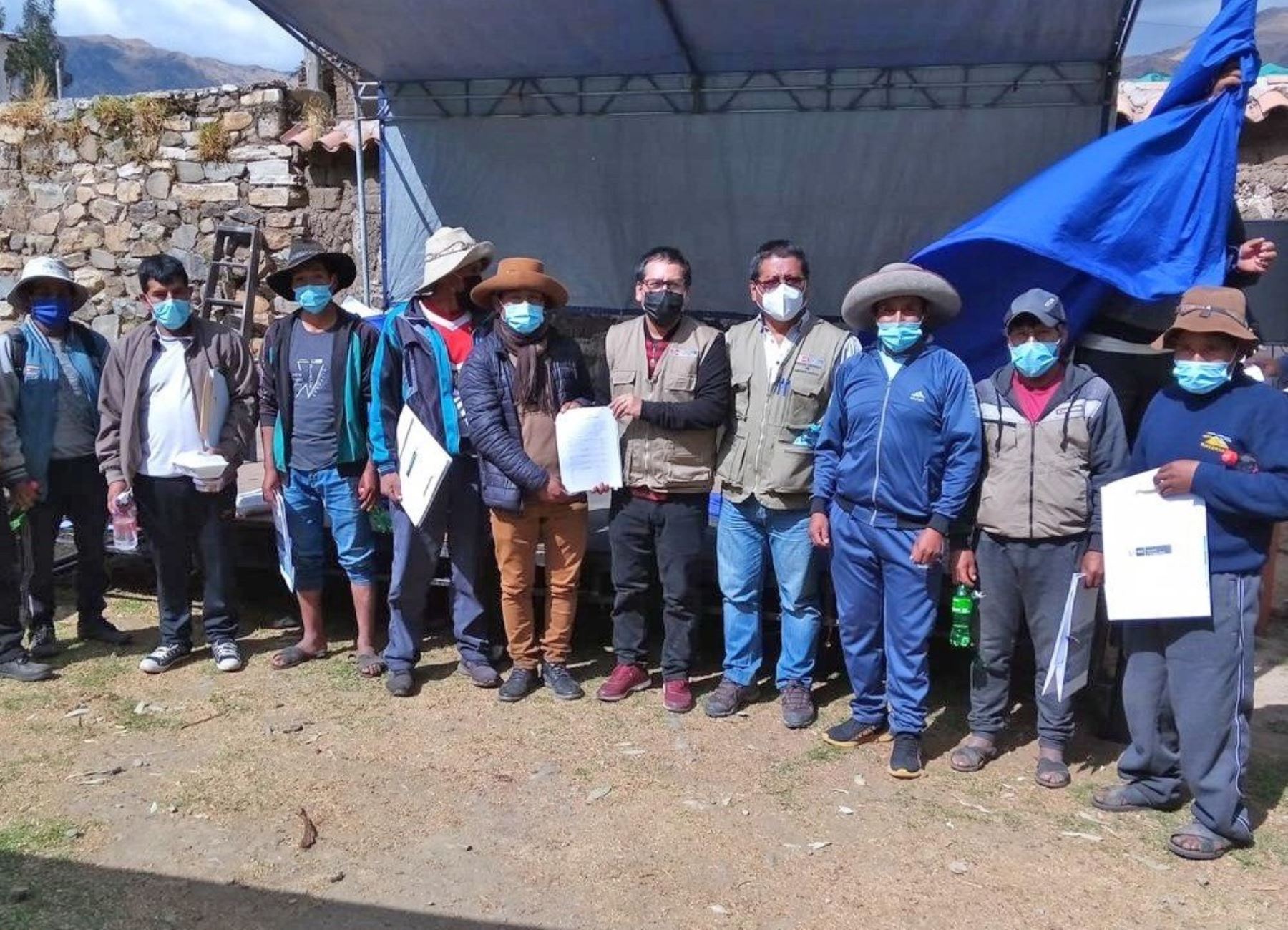
"The prior consultations were carried out respecting, recognizing and valuing the cultural expressions of indigenous communities, as well as the current legal framework," highlighted the head of Minem, Jaime Gálvez.
In August, the Prior Consultation with representatives of the native Quechua people of San Andrés, located in the district of Puquio (Lucanas, Ayacucho), regarding the authorization to begin exploration activities for the Monica Lourdes project of Nexa Resources, was satisfactorily completed.
"We agree with Minem's authorization for the development of the Monica Lourdes exploration project (...) we expressly request that the Prior Consultation process be concluded", states the minutes signed by the community..
Then, in October, more than 50 representatives of the campesino community of Hacca, located in the district of Omacha (Paruro, Cusco) unanimously agreed that Minem should grant authorization to begin exploration activities for the Jasperoide project of the KA Oro company.
"We received adequate information about the exploration project and we also know our collective rights," states the minutes signed by Hacca's representation.
"Both processes of prior consultation were executed respecting, recognizing and valuing the cultural expressions of the community in a climate of trust, collaboration and mutual respect," said Jaime Galvez.
"In order to efficiently carry out the preliminary informative workshops, the Minem included in the technical team a Quechua interpreter accredited by the Ministry of Culture. Similarly, the health prevention protocols against COVID-19 that have been agreed with the MINSA for the different actions and stages of the Prior Consultation were successfully implemented in all the processes that are being carried out.
Minister Gálvez congratulated the General Office of Social Management (OGGS), which leads the processes of Prior Consultation in the mining and energy sector, for the work done and for continuing to promote the development of sustainable mining activities that respect the rights of indigenous populations.
proEXPLO 2021: Mineral Resources for a Sustainable Future
Interview | Dr. Dr. Thierry Sempere, Keynote Speakers of the XII International Congress of Prospectors and Explorers (proEXPLO 2021)
 1st December
1st December
Thierry Sempere's View on the Andes Geology
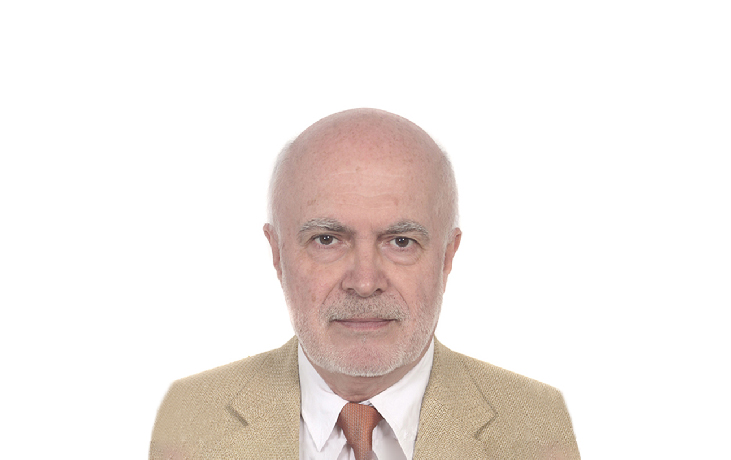
At the next edition of the International Congress of Prospectors and Explorers - proEXPLO 2021 - Thierry Sempere will give a talk on "Exploring Peru in search of metals and hydrocarbons using innovative thinking".
In your view, what are the main existing paradigms that are preventing geologists to get the Andean geology right?
Maybe one first point to stress is that there is a sort of “crypto-paradigm” which suggests implicitly that the Andes form one geological entity. In fact “the Andes” are far from being homogeneous, either along or across strike. My opinion is that no generalization should be attempted at the scale of the entire Andes, i.e. from Venezuela to Tierra del Fuego, because it’s always better to avoid comparing apples and oranges.
This topographic image of South America and adjacent regions (ocean waters have been removed) clearly shows how variable the Andes are along strike:
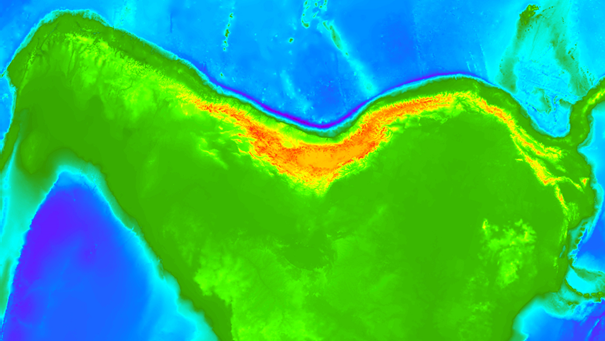
This marked lateral topographic variation reflects that the processes – I insist on the plural – that resulted in building the Andes have also varied along strike – and probably across strike, too. We should always remember that. Because my geological experience is almost limited to the Andes and Subandes of Peru and Bolivia, in the following I express myself only on the geology of these countries.
When I say – colloquially – that it is needed to “get the geology right”, I mainly think about the geology dealt with during mining or hydrocarbon exploration: I mean that I’m not talking from an academic perspective. Andean academic geology often tends to be dogmatic and thus to overlook data that fly in the face of preferred paradigms (a shortcoming commonly observed, indeed – see below), whereas exploration geologists, in order to find a deposit, absolutely need to “get the geology right”, i.e. to know what is really down there, whatever the paradigms are.
In my opinion, the main problematic paradigm is the widespread belief that the Andes result only from tectonic shortening imposed by the subduction of the Nazca plate. This belief is now so rooted by tradition that it has turned into a dogma.
As nearly all mountain ranges on Earth, the Andes exist because their crust has been thickened. The current paradigm states that this thickening was achieved by tectonic shortening alone (or nearly so) and rejects the idea that thickening was locally achieved by magmatic additions and/or lower crustal ductile flow, even in part. This dogma ignores that, in a number of regions, the crust is extremely thick and yet no (or very little) shortening is observed. In southern Peru, this key situation has been described as early as 1971 and 1989 by geophysicists, who observed that crustal thickness is maximum along the Western Cordillera (which coincides with the main magmatic arc) and logically concluded that crustal thickening there must have been achieved through magmatic additions along the arc. But these geophysical data and structural observations have been deliberately ignored by the dogmatic geoschools so far. About two decades ago, at a time when I still had faith in the dominant paradigm, I was surprised to observe that, although southern Peru is characterized by a thick crust, this region has been only affected by extensional and/or gravitational tectonics since the Late Paleozoic, confirming the original deductions of the mentioned geophysical works.
Regarding Peru, I’d thus say that this “shortening-only” paradigm has done and is doing a lot of harm, which is reflected in the mapping of almost any fault as a thrust or reverse fault – many times regardless of its evident offset! –, and thus in the production of partly wrong geological maps. The situation is not the same regarding Bolivia, where regional shortening has indeed entirely structured the Eastern Cordillera and Subandes (but, according to my current understanding, the situation in the Altiplano is quite different).
The still common reference to “compressional tectonic phases” in the Central Andes is another major problem. These “tectonic phases” are nothing else that the application to the geology of Peru, by Gustav Steinmann (1929), of Stille’s (1924) concepts – which are now completely obsolete as they were designed for an Earth where continents could not move! But at that time Stille’s ideas had met so much success that within a few years they had become a fashionable landmark in international geology. One then understands that when Steinmann interpreted unconformities he had observed in Peru as compressional “tectonic phases”, he was merely adapting to Peruvian geology this then fashionable interpretive framework. Stille’s “tectonic phases” were meant to explain why “geosynclines” separated by oceans would deform synchroneously in spite of the huge distances that separated them… The fact that the concept of “tectonic phases” was deeply related to that of “geosynclines” suggests that the former should be considered as an obsolete geomyth just like the latter. “Tectonic phases” are nevertheless still massively used as a major interpretive tool in Andean geology – to my bewilderment. It is really a pity that we’re still dealing with the consequences of a groundless geological craze that is nearly one century old.
Getting rid of the “tectonic phase” paradigm should however be easy if one remembers (1) that “tectonic phases” are only interpretations, (2) that these interpretations are now obsolete, and (3) that we should return in each case to the observations that once sustained them. These observations are generally angular unconformities, and each one should be reassessed and re-interpreted using the much richer interpretive tools that are currently available to us.
This point leads me to underline another major shortcoming common in Andean geology, namely the often intricate mixing of observations and interpretations. Although a firm scientific principle is that mixing facts and interpretations should be avoided at all time, this is unfortunately done frequently and tolerantly – especially among the dogmatic geoschools. Whether blatant or subtle, these mixings result in pseudo-scientific “soups” that have misleading meanings.
In order to “get the geology right”, Andean geologists first need to identify and carefully distinguish what are the undisputable observations and data that are available, on the one hand, and, on the other hand, what are the interpretations that have been given so far on the basis of these facts. The observations and data almost never change (if they are reliable), but the interpretations may be completely revised when needed and justified.
Can you comment what Peruvian institutions, universities and companies have done well and not so well in the past to properly understand the Andean geology?
This is a difficult question. I believe most people do generally the best they can, and also that nobody is really in a position to judge them – except maybe historians, but I am not even sure about this. Progress is often messy but is achieved after all, in spite of whatever shortcomings and drawbacks there may be in between.
Your question also opens toward many topics, so many that I can’t deal with all of them here. Therefore I will only address a few.
I would say first that institutions, universities and companies have generally distinct, specific objectives of their own (and their staff also have). In a number of cases, “properly understanding the Andean geology”, as you put it, is not one of them. This does not involve any particular criticism, as it is generally quite understandable – especially in the environments where bureaucracy and/or a bureaucratic mentality have grown out of proportion.
Concerning mineral exploration, one knows of course that discovering a new deposit results neither from a bureaucratic trámite nor the mastery of human relationships, but from a logical processing of variegated geologic information (and also luck!).
But my main answer to your question is that we are all subject to cognitive biases, which are very many indeed (just consult this link and you’ll be amazed). However most of us generally do not realize they fall victim to cognitive biases, unless they have become familiar with the notion. Because they are more experienced, some older persons are less affected than younger people, who are invariably prone to cognitive biases. This is why I’d suggest tthat we should analyse the history of geological knowledge in the Peruvian Andes in terms of cognitive biases, because most shortcomings are rooted in them.
One of these is an excessive respect for tradition. Many Andean geologists seem to believe that the first Andean geologists, from South America or other continents, “got it right” from the start. I am convinced that this is extremely unlikely – how could have they achieved that at a time when geological concepts were so mistaken? – and therefore I only respect their objective descriptions, which in most cases are excellent.
This excessive respect for traditional interpretations explains why obsolete concepts have survived until today (and, I anticipate, will do for some longer time). Because most of them are engineers, it is also a tradition among Andean geologists to favor the blind use of techniques over that of logical or critical thinking. This situation results in a very limited questioning of traditional interpretations.
There are other significant biases of sociological nature. A major bias lies in the unconscious belief that academics who have achieved a high social status hold the geological truth about “the Andes” and are somehow infallible, even over regions they have never studied. It is revealing that a number of companies hire as consultants on the geology of Peru high-status persons who have visited Peru on only a few opportunities, but who are viewed as eminent specialists on “the Andes” in general. The belief that “getting the geology right” is correlated to social status is one of the most amusing I know. One may remember here that those who achieve high academic status are generally dogmatics – and what is most needed for successful exploration are creative people – just the opposite.
This mentality is also reflected in the rather common belief that a person who obtains a doctorate magically converts into a sort of infallible oracle. Indeed, a doctor in geology is often deemed to know almost everything relevant, and to be right on whatever topic, even outside the field of his PhD dissertation, even against the arguments, correct as they may be, of whoever has not obtained a doctorate. In such cases, it is obvious that what counts is the status artificially implied by the doctorate, and not the scientific reality or arguments – and this is much a pity. Of course, this belief that “doctors can’t be wrong” is deeply … wrong. Doctors may well be wrong, just as anybody else.
The same mentality appears in the also frequent belief that any interpretation published in an indexed journal must be right – which is also wrong, of course. It should be self-evident that publishing in an indexed journal does not guarantee – at all – that what is published is the truth!
A similar bias lies in the excessive trust granted to interpretations brought forth by foreigners (especially those from North America or Western Europe) – just because they are or were foreigners. One terrible case is the completely wrong stratigraphy published by Newell in 1949 for the region northwest of Lake Titicaca. This geologist defined his stratigraphy along a section that is in fact cut by a thrust, but did not notice this thrust, and, most surprisingly, did not realize that the succession was repeating itself… This has resulted in a crazy stratigraphy plaguing all geological maps published by the INGEMMET in the concerned region. Twenty years ago, I published in Peru a paper pointing out the error and correcting the stratigraphy, but this has apparently had little effects.
Furthermore, there may be in this case “a bias in the bias”, in the sense that foreign scientists are themselves submitted to sociological biases of their own. Among these are those that induce them to publish papers in agreement with the paradigms favored in their own research system, in order to achieve promotion by their peers. This results in a deeply vicious circle, in which the true geology of Peru or Bolivia may end up being irrelevant to them, i.e. just instrumental to achieve a career. Because I have been myself a foreign researcher on the Central Andes during 34 years, I have had a front-row seat to watch how my (mainly French) colleagues proceeded in order to advance their individual careers, sometimes at the very expense of the scientific facts. For instance, 8 years ago, a young French researcher naively explained to me what conclusions he was going to reach in the Peruvian study that he had not even started to do! – and of course these in-advance conclusions amounted to confirming a paradigm currently fashionable in France… Sociological biases of this sort are just terrible, as they result in the international publication of flawed, if not wrong, interpretations, which may later receive excessive attention in the concerned countries.
These biases converge to give the impression that creativity, as opposed to tradition and dogmatism, may be undervalued in many local contexts. Not long ago, a major and insightful Peruvian geologist wished “more creativity and less bureaucracy” to our community, quite rightly I believe.
My teaching experience over several decades has confirmed this diagnosis. I remember one particular case in which a professor had recommended two “very good” students to me, whom I took later to a field test. They were absolutely unable to analyse by themselves the first simple outcrop I showed to them; they did not even look at the outcrop, and even less see the exposed unconformity, but kept searching in their memory to which units the strata might belong, instead of observing the simple exposure and deducing a conclusion… Thanks to this experience, I clearly understood that teaching may end up being dominantly memoristic, and that in this case the students deemed “best” may end up being those who can repeat exactly the teacher’s words… But favoring memoristic repetition obviously kills creativity. Teaching by favoring memory over logics cannot train students into the experience of logical deductions and critical assessments.
We haven´t seen too much discussion around salt-tectonics in ProEXPLO, do you think this subject is restricted to the “hydrocarbon geologists” or also apply to exploration and mining geologists? How?
I gave a talk in ProEXPLO 2019 on the interest of salt and salt-tectonics for mineral exploration, but I was indeed aware that it might be perceived as a little off-topic by part of the audience. Of course, the fact that a giant salt basin once extended over a large part of Peru (and southwestern Bolivia) should be of the highest interest for hydrocarbon exploration. But it is also interesting for mineral exploration from a number of perspectives: these include the variety of specific structures generated by salt tectonics (which may trap deposits), the high dissolvability of salt (in particular when mineralizing fluids circulate), and of course the capacity of the chloride ion to form coordination complexes able to transport metal ions in solutions. For example, my current research on the Peruvian salt issue is suggesting that specific stratigraphic positions are more prone to host certain mineral deposits – depending on the regional context, of course.
Exploration geologists interested by this issue may refer for details to the mentioned extended abstract in ProExplo 2019 and to the related presentation, which I suppose is also available.
What are the greatest question about the Andean geology that you haven´t found an answer yet?
Another difficult question, and maybe even a perilous one! Most dogmatic geoschools about the Andes express themselves as though these have found all the answers – or nearly so. As I try to keep away from any form of dogmatism, it’s not easy for me to reply.
One point I wish to underscore here is that, in my opinion, much of the progresses achieved during the last 10–15 years have resulted from zircon U-Pb geochronology, because it has provided reliable crystallization ages on a variety of magmatic rocks, and also maximum ages for a number of stratigraphic units (the University of Geneva has been particularly instrumental in achieving this). This enhanced flow of reliable chronological data has allowed to realize what synchronies there may have been between past magmatic, sedimentary, and tectonic processes, and has thus stimulated much thinking about the possible common causes of such synchronous phenomena. This has led to trails and leads, and in some cases to answers. For example, it has appeared that the rapid transition from marine to continental environments observed in Andean Peru at about 90–85 Ma, for which Steimann had imagined the “Peruvian tectonic phase”, was in fact synchronous with the rapid magmatic growth of the Coastal Batholith; this continentalization of the backarc basin thus did not result from a “tectonic phase”, but from the accelerated magmatic growth of the coeval arc! – driving another nail into the coffin of the “Andean tectonic phases”.
To focus on your question, I’d say that in 2017, at the end of my career as an academic researcher, I had come to admit that our knowledge about the Andes of Peru and Bolivia (the Andean segment I have studied) is still rather limited. We are in dire need of many more zircon U-Pb ages, and we are lacking crucial high-resolution geophysical images of the Andean crust and mantle. We also need geological maps that are not biased by preconceptions and paradigms, whether active or not, etc., etc.
I have however to admit that, after nearly 4 decades of studying this Andean segment, I think I have found what I believe are trails toward anwers to a number of questions, especially regarding Peru – but I am not fully convinced that, in the details, they are the correct tracks or leads. I find it characteristic enough that I am continuously improving these tentative answers as new data are obtained and my research progresses (as a matter of fact, I still do research as a consultant).
I tend to view our research activities as multidimensional helixes that spiral around a central point that represents the truth – a point that is in fact never reached, because it will always be impossible to reconstruct in all details the processes that have developed in the past and resulted in building the Andes and generating their ore and hydrocarbon deposits. Of course nobody has reached the truth yet (and even less the dogmatics who think they have), but it is important to remember that nobody will ever reach it either in all details.
From an academic point of view, I currently tend to think that one very interesting and still open question concerns the initiation of subduction along the now Andean margin. Current reconstructions favor that Peru stood in the midst of a major continental collision around ~1000 Ma. One of the involved continental blocks was apparently Laurasia, which therefore must have subsequently separated from proto-South America and moved away, resulting in the opening of an Atlantic-type ocean. This implies that the Peruvian margin must have been a passive, i.e. Atlantic-type, margin during quite some time, and then must have switched to the current active, i.e. Pacific-type, margin at some later time. When did these events occur, and how? What are the geological features in the Central Andes that allow to confirm this narrative? Can we reconstruct details of this initiation of subduction beneath Peru? And what were the consequences of this change for present-day economic geology and exploration?
From an economic-geology perspective, I must confess I have entered too recently the manifold discipline of ore geology to understand satisfactorily the links there must be between the formation of local deposits and the regional evolution. I have initiated a personal research about this captivating issue, but here also I have to confess that my current understanding is preliminary.
Of course the links between mining and regional geologies depend largely on the types of deposits that are considered, and it would be too long to review them here, even in a simplified way. Epithermal deposits in Peru, however, are closely related to young volcanic systems, and I do not think any Andean paradigm change should have a significant bearing on the corresponding exploration – except maybe the fact that extensional tectonics was in fact widespread and might have had some influence on the intensity of fluid circulations among volcanic systems.
proEXPLO 2021: Mineral Resources for a Sustainable Future
Peru is the country with the largest silver reserves in the world
 23rd November
23rd November
Peru is the country with the largest silver reserves in the world
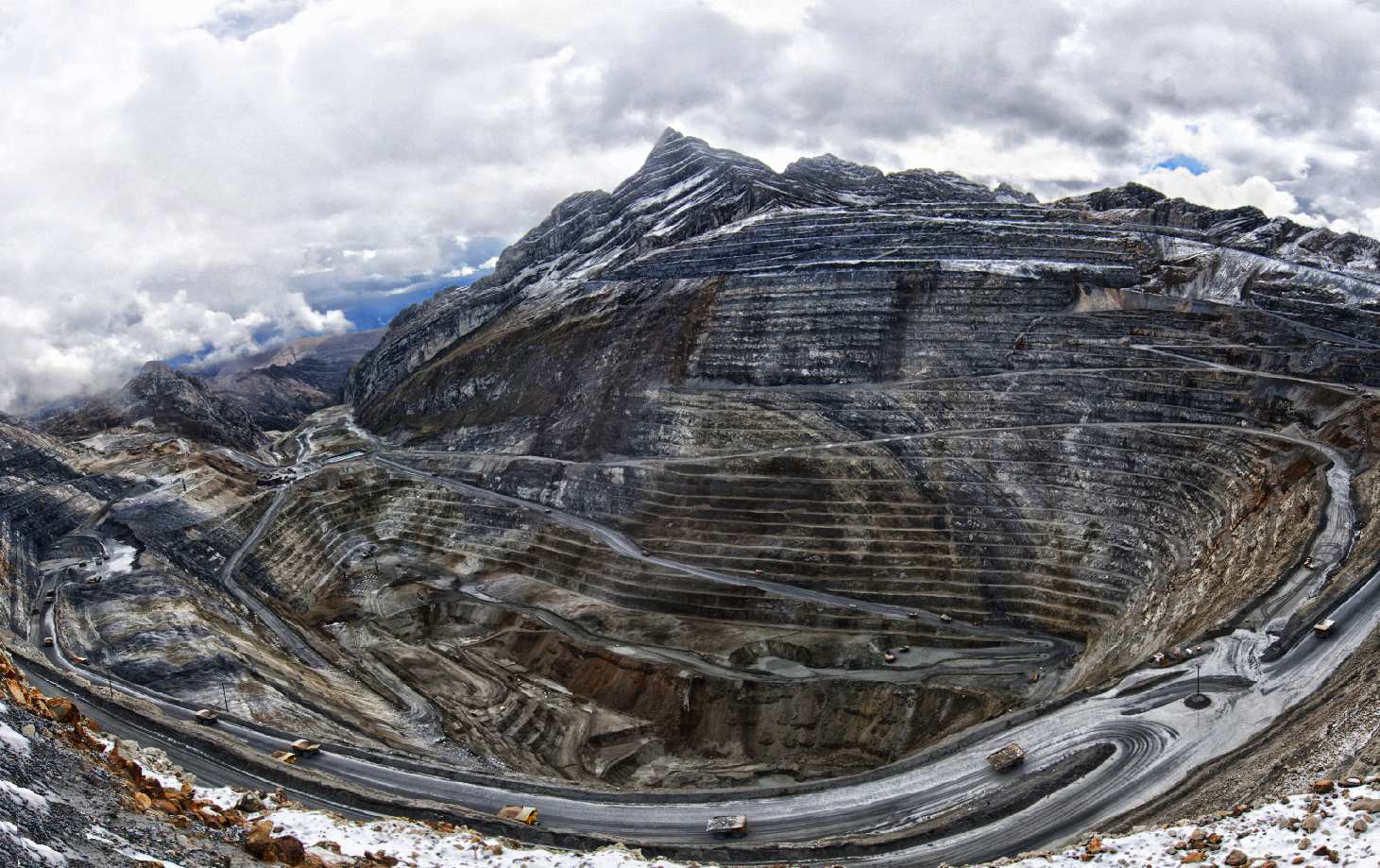
In terms of production, Peru ranked second worldwide, after Mexico, in 2019, with a total of 3,860 tons produced; although this volume was 7.2% lower than the 4,160 tons produced in 2018.
In January and February 2020, silver production was higher than that produced in the two similar months of 2019, and as a result of the measures taken to control COVID-19, monthly production declined. Thus, between January and September 2020, 2090 tons of silver were produced, a decrease of 26.5% compared to the same period in 2019.
The website Oroinformación.com reported that silver is one of the most sought-after metals by investors in 2020 and according to the financial blog Lombardi Letter, the factor that explains the upward cycle in the price of silver is the enormous demand for bullion or investment coins that has emerged in the market.
The highest level reached by the silver price during the course of 2020 was US$ 28.88/oz on September 1st; while analysts do not rule out that this level could continue to increase and reach US$ 50/oz, if greater demand persists.
Finally, regarding the location of silver reserves, if we consider the regions of the country, we observe that Ancash and Junin have 52% of the total silver reserves.
proEXPLO 2021: Mineral Resources for a Sustainable Future
Machine Learning of 50k Geological Map is now available to the public
 18th November
18th November
Machine Learning of 50k Geological Map is now available to the public
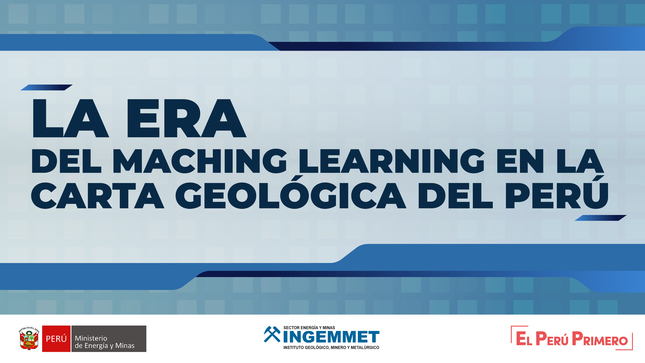
She pointed out that data architecture: related tables, grid standards, colors, and others, are available so that users can elaborate maps in the scales required under the same standards with which Ingemmet mapping is developed.
"She recalled that Ingemmet is governed by the democratization of geoscientific knowledge to strengthen the knowledge of the national territory, its resource potential and its sustainable use to attract investment, generate jobs and good living for more Peruvian families. She announced that information from all research projects will continue to be shared.
She also recommended that participants pay greater attention and analysis to mathematical calculations and models of mining and energy reserves.
The head of the entity greeted the academic authorities of UNSA referring that "Geoscientific research is a mission and commitment to Peru, aligned with the National Policy for the Popularization of Science and the need to generate knowledge for decision-making in mining and energy investment, prevention of geological risks and promotion of resource potential and ordinary mining procedure.
The 6th INTERNATIONAL CONGRESS OF SOUTHERN PERU GEOLOGY is already a success for everyone, especially for those who participate because they will obtain knowledge to innovate based on the criteria, experiences and trends of renowned national and international experts and scientists.
proEXPLO 2021: Mineral Resources for a Sustainable Future
Interview | Alberto Arispe, member of the Organizing Committee of XII International Congress of Prospectors and Explorers (proEXPLO 2021)
 18th November
18th November
"There is a boom coming in copper price for the next 10 years. In order to reduce poverty in Peru, we cannot leave our mining resources in the ground"
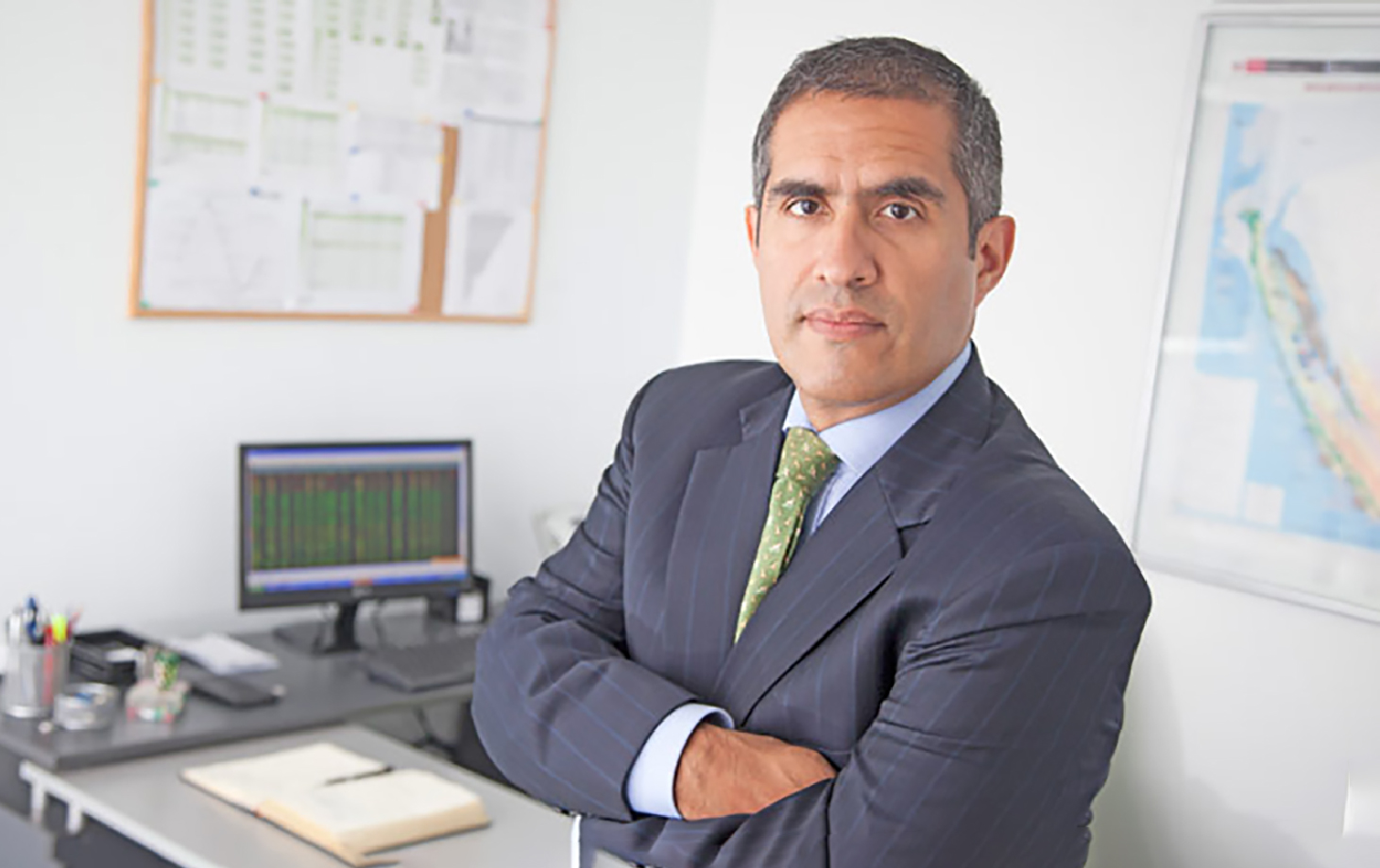
For Alberto Arispe, General Manager of Kallpa SAB and member of the Organizing Committee of proEXPLO 2021, this event organized by the Peruvian Institute of Mining Engineers (IIMP) aims to promote prospecting and mining exploration in Peru, Latin America and the world.
What are the objectives of the 12th Congress of Prospectors and Explorers (proEXPLO 2021) organized by the Peruvian Institute of Mining Engineers (IIMP)?
The objective of proEXPLO 2021 is to promote mining prospecting and exploration in Peru, Latin America and the world.
The event will also seek to highlight the importance of this activity for the Peruvian and global economy; as well as to know the perspectives of this activity for the next 2, 3, 5 and 10 years.
In addition, proEXPLO will be a platform for different stakeholders to discuss, get informed, exchange opinions and learn from this economic activity that is important for Peru and the world.
What do you consider will be the contribution of proEXPLO 2021 to Peruvian mining?
First of all, I think we need to promote the importance of mining for Peru's economic development and for reducing the poverty rate in the country, which is now around 25% due to the COVID-19 pandemic.
It should also be noted that Peru has a competitive advantage over other countries, and has a geological potential for resources and reserves of gold, copper, zinc, tin and other metals.
And it turns out that the global trend is towards environmentally friendly energy. That means that the demand for electric cars will increase significantly in the next 20 years. Today, electric car sales represent 3% of total new car sales in the world. This is expected to be 25% in 2030 and 55% in 2050. And each electric car demands 3-4 times more copper than a gasoline car. Therefore, since demand will rise significantly and supply is stagnant, it is very likely that the price of copper will explode sometime in the next decade.
So, if Peru produces 12.5% of the world's copper and has potential resources and copper reserves, it is quite obvious, as young people say, that we have to take advantage of this situation to exploit our resources and sell them, so that Peru's GDP grows, formal employment grows, taxes are collected, schools, hospitals and roads are built, and people are lifted out of poverty. It would be foolish to leave our mining resources in the ground and not take advantage of this great opportunity that the global market gives us.
In this sense, achieving these objectives requires policies that encourage investment in mining and in exploration and mining prospecting; always respecting the rules of the game: caring for the environment, paying taxes, reaching agreements with local communities that may be affected by a mine near their homes.
What do you think about the opinion expressed by former Minem at the Congress on Mining Competitiveness and Social Sustainability: that his administration would focus on promoting mining exploration?
I think it's a good idea and that's what has to be done. Without mining exploration and prospecting there will be no resources and without them there will be no exploitation. What good is it for us to have great geological potential if our assets are not going to be sold? What is the use of having competitive advantages if we are not going to take advantage of them? We need to reduce poverty and create a formal country, with educated people who respect authority and others, and with solid institutions. And in my opinion, the most efficient way to do this is to take advantage of the mining boom that will occur in the world in the coming years for the reasons already mentioned.
The challenge is to convince those people who don't know about the subject, who are the majority. Therefore, we have to make sure that people understand that we have to mine the resources from the ground and sell them so that our country will have more wealth, more work, less poverty. I reiterate, we have that great competitive advantage of copper, gold and zinc.
How can we convince people?
Since there is a high percentage of people who do not believe that mining is important or even hinders the activity, more action is required from the government and the private sector. Promoting more congresses like proExplo is one way.
Similarly, it is essential to talk to local communities. In that line, the government has to actively participate and mining companies have to compensate the communities if economic externalities arise. People are not irrational and if there are benefits for everyone, they will accept and even promote it.
How does Kallpa SAB foresee the behavior of junior mining companies and financing in 2021?
Mining is a very particular industry because the main variable that drives the expected return for companies is the price of metal. The price of gold, copper and zinc is quoted on the financial markets. Being a commodity, companies have to seek efficiency, reduce their costs, be competitive and seek to invest in exploration to increase reserves in a sustained manner.
The financial markets are more important now than they were 30 years ago. It is investors around the world that provide capital to mining companies through the purchase of bonds and/or shares. Let us remember that 30 years ago it was the owner of the company who gave the money; but now there are millions of owners, who through stockbrokers or investment funds buy shares/bonds of mining companies and thus provide capital to mining companies for their investments.
In this context, financing will depend on the perspectives that investors have about the price of metals, the level of management of companies, the friendliness of the country where projects are located to private investment, tax issues, relations with local communities, respect for the environment, among others.
Therefore, the policies dictated by the government and the congress are fundamental to move forward or backward.
Is there a positive outlook for more companies to come to Peru?
In general, there is a positive outlook and it will be maintained or improved as long as there are no significant changes to the economic model that has prevailed for 30 years. In the last 10 years, Peru has doubled its copper production. This is due to the trust investors have in Peru and the implementation of projects such as Las Bambas, Constancia, Mina Justa, Quellaveco and Toromocho, among others. Although it is true that large projects have been frustrated, such as Conga or Tía María, we have made progress. I consider it unacceptable that Conga is not being developed because Cajamarca has a very high level of poverty. If the project implementation is going to generate economic externalities to the affected communities, then they should be paid and we should move forward.
Now, obviously we must improve. Improvement would bring more investment, more formal employment, more taxes for the treasury, more schools, more hospitals, less poverty.
The Government should be much more proactive in attracting private investment to the sector and ensure that this investment is carried out efficiently by solving the problems that may arise with communities and by solving the bureaucratic problems that exist to move projects forward. On the political side, we need more stability. Definitely having three presidents in five years does not help.
Also, recently the acquisitions of junior mining company projects have been announced. At these prices, mining companies are cashing in and as they know they have to invest in mining exploration to produce sustainably, they tend to buy. If this continues, we should not be surprised if there are more purchases of mining exploration companies.
What takeaway do you want participants to take home at the end of proEXPLO 2021?
There are three key takeaways. The first is to understand that Peru is fortunate to be the second largest copper producer in the world in a market where a copper price boom is expected in the coming decades. The world will be looking for energy that is environmentally friendly and cars, ships and planes will be electric. Again, it takes 3 times more copper than a gasoline car to produce an electric car. The demand for copper will explode, and Peru has copper. We have to take advantage of the situation.
Second, in order to do this and reduce poverty we must invest in mining exploration and prospecting and then exploit these resources.
Third. In this context, we have to prepare ourselves for this. We must plan. We need to make a policy that allows us to develop our mining potential in an orderly manner, that complies with environmental regulations, that pays for the externalities that may arise, among others. We cannot live with our backs to the world. The world is extending a hand to us. It would be foolish not to accept that hand that will help us to significantly reduce poverty in Peru.
proEXPLO 2021: Mineral Resources for a Sustainable Future
Interview | Dr. Michael Doggett, Keynote Speakers of the XII International Congress of Prospectors and Explorers (proEXPLO 2021)
 18th November
18th November
"The Peruvian mining industry has grown significantly in the last 20 years"
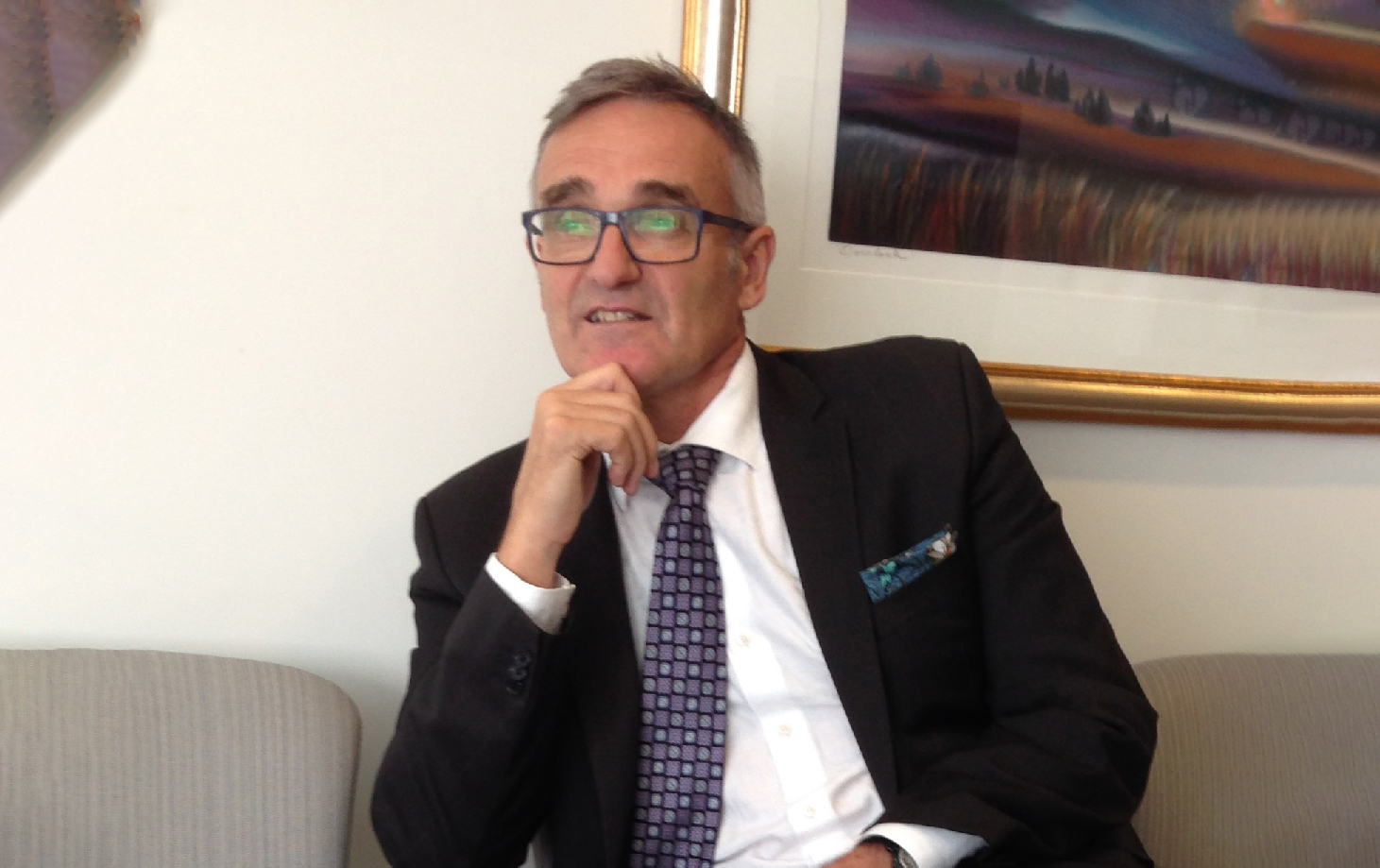
Stated Dr. Michael Doggett, Senior Consultant of Michael Doggett & Associates, who will present the keynote speech “Converting Mineral Resources for a Sustainable Future: Lessons from the First 20 Years of the New Millennium” at the next edition of the International Congress of Prospectors and Explorers - proEXPLO 2021.
Looking back at the past 20 years, what the mining industry has done well and not so well?
Over the past 20 years, the mining industry has adapted to the reality of decreasing grades by incorporating technologies that have allowed growth in production without significant increases in real cost of commodities for end users. From an exploration perspective, our industry continues to be able to find deposits as market demand shifts. Need lithium, cobalt, graphite, rare earths? No problem – we can find sufficient quantities to meet demand while avoiding significant long-term price increases.
Our industry has come up short in both the perception and reality of its broader role in society. We continue to deal with major tailings dam breaches, destruction of cultural landmarks, and conflict with indigenous and local communities. In our role as convertors of natural wealth to financial wealth, we have yet to shake our image as being part of the problem rather than part of the solution.
What are the greatest challenges the mining industry will face within the next 20 years?
The greatest challenges are in the realm of ESG. Companies are faced with a growing list of challenges to maintain and grow their business: addressing climate change and the use of fossil fuels and water in mining activities; acquiring permits and social licences and establishing stable community relations; addressing social, ethnic and economic inequality in most major mining jurisdictions; and, addressing the concerns of shareholders who are increasingly pushing company management to focus on ESG issues.
How do you see the Peruvian mining industry past performance and future perspectives within the context mentioned above?
The mineral industry in Peru has grown significantly over the past 20 years and should continue to grow over the next 2 decades. While advances have been made on many fronts, the issues of social licence, water, and community relations continue to be flash points. There is no magic solution to these issues and while they vary from project to project both companies and governments must strengthen their commitment to make partners rather than adversaries.
Additionally, the role of small scale mining – particularly in the gold sector – has become significant in terms of domestic production. The formalization process for small scale miners and processors has been haphazard (at best) leading to uncertainty and a large grey area between informal and illegal mining. Again, no magic solution exists but governments need to continue to press ahead with reforms in this area.
Regarding the distribution of exploration and mining investments among the world, what changes do you expect do see within the next decades? Any emerging jurisdiction on your radar or things should be pretty much steady?
The trade-off between preceived geological potential and political risk will continue to determine the level and distribution of exploration expenditures among jurisdictions. As is always the case, a signifcant discovery will draw investment to a jurisdiction in hopes of duplicating success. From a mine development perspective, long lead times mean that most new mines over the next 20 years will be based on deposits already discovered. In that sense, things will not change in any signficant way with respect to emerging jurisdictions.
Do you think this pandemic world will reshape mining industry? How?
COVID-19 has laid bare many of the social and economic inequalities that exist in most countries with respect to access to medical care and support networks. In conjunction with ongoing social movements such as Black Lives Matter and political reform marches in Chile and other countries, this pandemic will lead to change. This can be perceived as a risk or as an opportunity. For the mining industry, the first step is to recognize impending change and to be part of the solution rather than part of the problem.
proEXPLO 2021: Mineral Resources for a Sustainable Future
Peru would have 91 million tons of copper reserves
 5th November
5th November
Peru would have 91 million tons of copper reserves
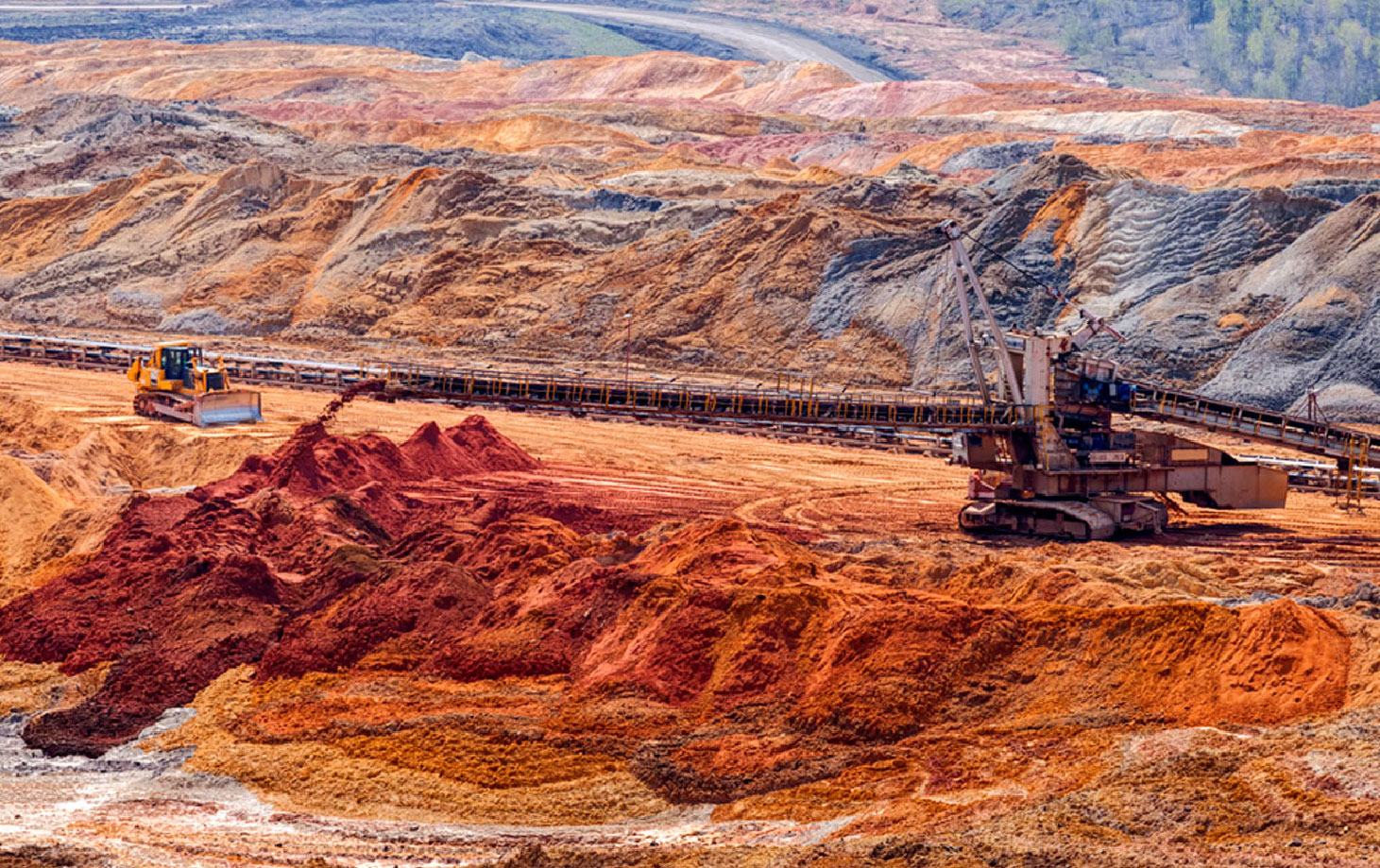
According to the Ministry of Energy and Mines (MINEM), the total copper reserves in Peru would reach 91’721 000 metric tons (MT). Of this total, 56.13% (51’489,000 MT) would correspond to proven reserves; that is, they come from measured mineral resources. On the other hand, 43.87% (40'232,000 MT) would be probable reserves; that is, they come from the indicated mineral resources and require confirmation.
In the "Map of Main Mining Projects and Units in Exploration - 2020 edition" elaborated by MINEM and updated to September of this year, it was detailed that Moquegua is the region leading the portfolio of reserves with a total of 23'255,000 metric tons (MT) of copper, of which 58.21% (13'538,000 MT) are proven reserves and 41.79% (9'717,000 MT) are probable reserves.
The second region with the largest copper reserves is Arequipa (15'413,000 MT) and in third place is Tacna with a total of 12'915,000 MT of copper. Followed by Piura and Junin with 12'375,000 MT and 7'029,000 MT, respectively.
proEXPLO 2021: Mineral Resources for a Sustainable Future
Interview | Dr. Jon Hronsky, Keynote Speakers of the XII International Congress of Prospectors and Explorers (proEXPLO 2021)
 3rd November
3rd November
"Mantle structure influences all deposits"
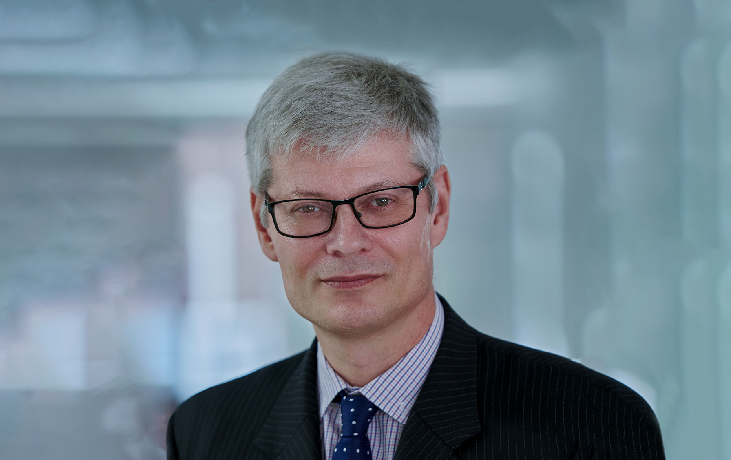
At the proEXPLO 2021 Congress, Dr. Jon Hronsky, Principal of Western Mining Services (WMS), will present his talk "An Integrated Model for Copper (Cu) and Gold (Au) Mineralization in Convergent Margins: Two Fundamental Processes interacting in Variable Geodynamic Situations".
What were the main reasons that made Western Mining a successful company on making discoveries?
It was mainly about the leadership of the organisation and the culture, which focused on innovation, scientific excellence and the individual development of Geoscientists. There was a strong emphasis on looking in new areas where people had not thought to explore before.
How do you think the mantle composition influences on the formation of Cu and Au deposits?
Mantle structure influences all deposits because it provides important plumbing for ore-forming processes. The actual composition of the mantle is quite important for the formation of Au deposits which require metasomatised mantle lithosphere as a source. Cu deposits however, do not depend on the composition of the mantle but rather the regional geodynamics that occur during arc magmatism.
How could we "map" mantle heterogeneities in base of superficial evidences?
Yes, to a certain extent we can use superficial features such as surface geology and structure as proxies for underlying mantle structure. Patterns of features in these superficial data sets (for example, alignments of mantle-derived intrusive rocks such as lamprophyres) can be used to infer a probable relationship with underlying mantle structures. Gravity data are particularly useful as they tend to record the signal of deeper structure. Although of course there is always significant uncertainty with this approach, when we see the coincidence in patterns between several different data sets this gives us more confidence that we are really looking at a deep mantle-related feature. However, as we get better data sets (seismic tomography, isotopic mapping) that directly map the mantle, our ability to identify these structures will improve.
How do you see the mineral exploration potential for Cu and Au here in Peru?
Peru is a very well endowed region of the world and has great mineral Exploration potential for Cu and Au.
proEXPLO 2021: Mineral Resources for a Sustainable Future
Interview | Dr. Antoine Caté, Keynote Speakers of the XII International Congress of Prospectors and Explorers (proEXPLO 2021)
 26th October
26th October
"Machine Learning for exploration: review of current and future tools"
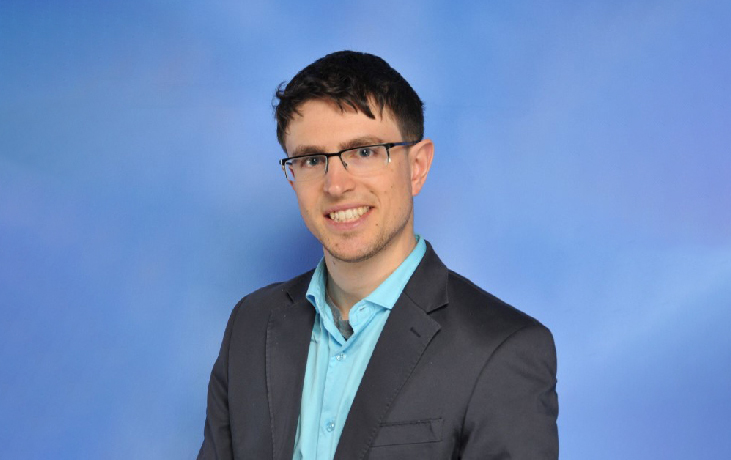
Dr. Antoine Caté, Senior Consultant in Structural Geology at SRK Toronto, will lecture on this topic at the next edition of the International Congress of Prospectors and Explorers - proExplo 2021. Below you will find an interview with Dr. Caté.
How did you become an expert on “machine learning” applied to mineral exploration?
I was first introduced to machine learning during my graduate studies in Quebec. The project required to integrate a large multi-element lithogeochemical dataset over a deposit. We realized we needed machine learning to answer the problem. I then continued to learn through both academic and industry-related projects. Machine learning was just starting to become a subject of interest at the time and I had the chance to be at the right place at the right time.
Can you please define for non-experts the meaning and relationship between “big data”, “machine learning”, “neural networks” and “artificial intelligence”?
The term “big data” references any dataset that is too large to process, analyze and visualize with standard software. A dataset can be large due to its volume (number of data points), its variety (the complexity of each data point) and velocity (the speed at which the data is generated). The vast majority of datasets in exploration geology cannot be classified as big data.
The term “machine learning” references to all computer algorithms that make predictions based on example data. Example data is provided to the algorithm, the algorithm learns automatically and with minimal human input the patterns in the data, and it can make predictions based on this learning. For example, an algorithm can be provided thousands of images of rhyolite and basalt. The algorithm will learn the difference between the two and will be able to predict if a new image is a rhyolite or a basalt.
A neural network is a network of neurons or nodes connected between each other by weights. A weight represents the strength of the connection between two neurons. Neural networks architecture is inspired by biological neurons in the human brain. The neurons are connected in a given order with the value of a neuron being determined by the value of all the input neurons multiplied by the connecting weights. As a simple theoretical example, input values such as assay data are provided to a network. The assay data is multiplied by the connecting weights to calculate the output neuron. If the output neuron has a low calculated value, the sample is barren. If the output neuron has a high value, the sample is mineralized. Complex neural networks with millions of interconnected neurons can be used for complex tasks such as automated core logging using core images.
The field of artificial intelligence focuses on the research regarding computers ability to think and reason like a human. However, in a more down-to-earth explanation, artificial intelligence refers to all software or algorithms that mimic human cognitive functions. This definition encompasses a large spectrum of artificial intelligences. For example, an Excel cell that calculates 1+1=2 is an artificial intelligence. A self-driving car is also an artificial intelligence.
Can you tell us about a success case of discovery driven by the use machine learning?
Machine learning cannot be independently responsible for having any discoveries whatsoever. Machine learning has been used with other tools to make discoveries in mineral exploration. There are several examples of companies such as Goldspot Discoveries or Orefox which have generated targets using machine learning and have validated them in the field. However, machine learning is just one of the combined array of tools that lead to the discovery. Good data collected in the field or through remote-sensing, sound exploration model and skilled field geologists validating the targets are all necessary parts of the discovery process. Machine learning is just a powerful tool that helps mineral exploration, similarly to geological mapping and structural analysis.
Do you think this pandemic world we all now live on may accelerate even more the use of computer-based processes in mineral exploration?
I totally agree with this statement. The pandemic was a good opportunity to take some time to look at our data and to extract value from it. We also had to find ways to continue exploration without being able to access the field. And this generally goes through a computer. As an example, we had to rely on logging core using core images during the pandemic. It was also an opportunity to develop new tools. We had to build an algorithm that automatically maps all the veins from drill core images of a deposit for a client as manual relogging would have been too costly and time-consuming. I think the pandemic was a good opportunity to optimize our work and improve the exploration process. Despite these opportunities, the pandemic has reminded us how valuable field work and site visits are.
proEXPLO 2021: Mineral Resources for a Sustainable Future
Interview | Eng. Sebastian Benavides Kolind-Hansen, member of the Organizing Committee of XII International Congress of Prospectors and Explorers (proEXPLO 2021)
 3rd November
3rd November
"Bureaucracy and paperwork should be minimized throughout the exploration process"
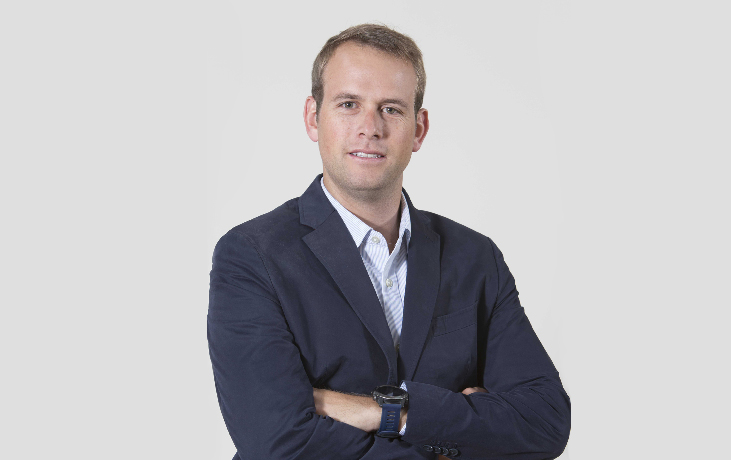
Engineering Geologist Sebastian Benavides Kolind-Hansen, member of the Organizing Committee of proEXPLO 2021, evaluates the importance of the upcoming event of the Peruvian Institute of Mining Engineers (IIMP) to be held from March 22 to 26, 2020. He also highlights the country's need to work more on mining exploration.
What are the objectives of the 12th Congress of Prospectors and Explorers (proEXPLO 2021) and what will be its contribution to Peruvian mining?
First, we must bear in mind that Peruvian mining has the potential to be in a privileged position and that, as a country, we can provide the world with minerals that are necessary, not only today, but in 20 years' time, when we will fall back on a greater dependence on batteries for electric cars, copper for electrical system wiring or the different metals that are used in solar panels, among many other elements. In that context, exploration is necessary so that we can consider what will be needed in years to come and explore it today; this is what it takes for a project to become a mine, and to ensure that in 20 years we will still be a competitive mining country.
Regarding the proExplo 2021 congress - an event to be held from March 22nd to 26th, 2021 - its main objective and contribution is to create a space where the latest advances of different mining exploration projects in Peru and the region can be shared and discussed, in addition to the importance of scientific innovation.
Similarly, it will aim to help develop ideas that can lead us to be better positioned as a mining industry in the future. What we invest today is what we will have tomorrow, and proExplo is a space that will contribute to this vision of making the most of this situation and bringing forward all the projects that we have in our portfolios.
Also, this edition will emphasize a correct and feasible transition from an exploration project to a mine, which is something not often talked about in the exploration activity.
We will also explore in depth the role that our country plays in providing the world with minerals - both metallic and non-metallic - towards a sustainable future, where less fossil energy is used and more environmentally friendly resources are promoted.
What do you think about the opinion expressed by Minem at the Congress on Mining Competitiveness and Social Sustainability, that his administration will focus on promoting mining exploration?
I totally agree that exploration is the aspect that we have to emphasize on the most as a mining industry.
The reality is that, according to the latest Estamin, investment in Peruvian mining grew by 25% between 2018 and 2019; however, investment in exploration fell by 13%. This is because exploration itself is a high-risk activity, companies invest without knowing whether they will get a return or not. In scientific terms, the risk of this investment in different countries is the same, but not in the jurisdictional level. This is why exploration is particularly susceptible to additional risks inherent to each country.
Statistics show that in Peru today, companies are willing to invest more in advanced projects, with a higher level of certainty -despite some political or jurisdictional risk-, but there is clearly less and less investment in greenfield exploration, since we represent a higher risk than other countries where foreign companies may take their capital to.
One of the main detriments to our competitiveness as a mining country is the delays in permits and bureaucratic processes. Also, in many cases, companies that have done their job properly and have all the permits from the government may experience social conflicts, without receiving support by the government, despite having received the permit and approval for the technical plan from them, and the company must face this conflict alone.
We must address these issues in order to become more competitive and, especially, to set our sights on time. For example, in Chile, from the moment the company decides to drill until it has a drilling machine operating, an exploration permit can take three to four months; while in Peru it can take a year and a half; so the time it takes to explore one project in Peru is the same it takes to explore six in Chile.
These are situations that make us less competitive and attract less investment, especially high-risk investment which is what we need in exploration in order to take forward the projects that we will be exploring, building and mining in the coming decades.
So, do you agree that an exploration project should not require the same permits as an exploitation project?
I very much agree with that. We have to reach a consensus that is reasonable and avoid filling the entire exploration process with bureaucracy and paperwork.
Statistics show that most exploration projects do not get to the drilling stage, and when it is decided to drill, most of these projects do not exceed four or five boreholes; therefore, the impact on the environment is not as significant, and environmental controls are relatively easy to carry out and monitor.
I very much agree that as the project grows, we must increase the number of permits and protocols; but if you put a similar burden of "permitting" on an exploration project where the intention is to drill a hole to test the area and get an idea of it and see if there is anything interesting, compared to a company that is already defining a resource, there is something wrong with the system.
What does it take to get authorities and communities to understand that exploration requires a different approach?
I believe that in order to change social opinion about the mining industry, companies and the government must work on a positive and realistic message about the benefits of mining; as well as present what the real problems of the industry are and explain why a sustainable future depends on mining.
The average public opinion of someone who does not have a connection with the mining industry is often negative, so there is a problem of ignorance and lack of information from the industry and the government.
Also, for many years we have been looking for the government and politicians to reduce the number of regulations and let us be more competitive; however, when the government has to deal with an anti-mining population group, they won't do it because they are politicians. Therefore, what we need is to convince the population and give a real and joint message, a message that in time will allow people to gradually accept mining, or at least make them listen to both sides and have an informed opinion.
I think it is then that we will be able to reach the government and ask them to reduce the regulations because there are no longer any confrontations with the people; and, in my opinion, this will be the most efficient way to achieve these changes in regulations, to boost the mining projects that we have stopped in so many parts of Peru.
What do you consider to be the main aspects of exploration in the new decade?
Exploration in the new decade, on the technical side, has several new challenges that we are starting to understand now; but we have not been able to decipher things such as exploring at greater depth, exploring under post-mineral cover, exploring in areas of greater vegetation, or entering new jurisdictions, actions that have not been necessary to address in the past because we had many deposits near the surface, in desert areas, among others.
It will also be characterized by a new set of elements being explored; so, nowadays, things like lithium become much more relevant than in the past and all this has to do with the sustainable future and the need for batteries to store energy; etc.
Similarly, we are going to have more competition, because new jurisdictions are being opened compared to 10 or 20 years ago when they were not as friendly to mining as Ecuador and Colombia; and many companies are going to want to explore and take positions in those countries; this means that competition for investment is increasing and we must be even more competitive.
I believe that these will be times of change and we have to be well prepared in order to face them. The most important thing to keep in mind in order to become competitive in this scenario is that we need to be closer to the population in general and give a better image of the industry; a joint message that can lead us to be more competitive and to have more successful projects and, consequently, more investments in exploration and more resources for the country to close the gaps.
What takeaway do you want participants to carry with them at the end of proExplo 2021?
I expect participants to take away that exploration is the starting point for the entire mining industry.
Today, we have several challenges that we have to overcome and work to become more competitive as mining industry and this will lead to more companies deciding to invest in our country.
As we invest more in exploration in our country and grow in innovation and become more competitive, we will be more successful and this will lead us to be able to provide the world with new mines, new deposits, new discoveries that can sustain the economy and make us a more sustainable and environmentally friendly society for the next decades.
On average, a mine takes between 15 to 20 years from the moment the deposit is discovered until it starts to be mined; therefore, we have to realize that what we are exploring today will be a mine responding to the demands of society in 15 or 20 years’ time, not to today's society; therefore, spaces such as proExplo 2021 invite us to meet and discuss ideas, to see how we can improve as a country, as an industry and as explorers.
proEXPLO 2021: Mineral Resources for a Sustainable Future
Geocatmin celebrates 10 years of service in Peru
 3rd November
3rd November
Geocatmin celebrates 10 years of service in Peru
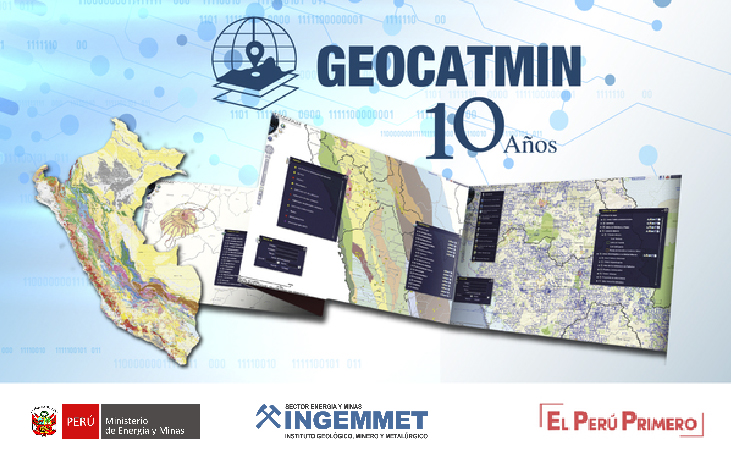
According to Ingemmet, the system aims to provide mining, geological and general public users, a geo portal with information that seeks to promote research, transparency and access to researches, through 200 layers of information.
"Geocatmin is a great Ingemmet online window for free and open access to geological and mining cadastral information, which allows to integrate and standardize information for the development of investment projects," stated the institute.
With regard to its functionalities, they include locating mining concessions with mineral potential; identifying new projects considering the corresponding environmental permits; identifying geological hazards for public or private investment projects; identifying areas with environmental impact assessments (EIA) for reuse in new baseline studies of mining projects.
Similarly, it allows to locate areas with geological studies and prospecting in exploration projects to reuse them in new projects; locate energy sources (water, wind and geothermal) for investment projects; and identify population centers affected by a project, in order to design plans for public engagement.
"Only two years after its launch, in 2012, Geocatmin registered more than 160 million interactions, and today, in 2020, the system registers more than 1.4 billion interactions, with a daily average of 800 000 interactions, which would be, in times of pandemic, like attending to 1,400 people per day, worldwide," highlighted the geological institute.
proEXPLO 2021: Mineral Resources for a Sustainable Future
Great expectation for the 12th International Congress of Prospectors and Explorers - proEXPLO 2021
 26th October
26th October
Great expectation for the 12th International Congress of Prospectors and Explorers - proEXPLO 2021
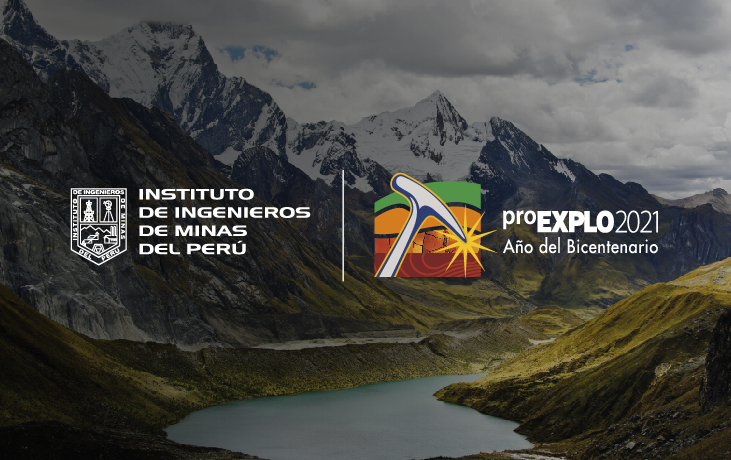
After the success of the First Congress on Mining Competitiveness and Social Sustainability, the Peruvian Institute of Mining Engineers (IIMP) is now organizing the 12th International Congress of Prospectors and Explorers - proEXPLO 2021.
To date, people and companies have shown great interest in this new edition, which will be held from March 22nd to 26th, 2021, online.
Moreover, the interest of participants comes in a context where Peru has been showing great potential in terms of copper, gold, silver, zinc and other metal deposits in demand in the international market.
“We welcome national and foreign mining speakers and investors, industry professionals and students. We are confident that proEXPLO 2021 will meet the expectations of those who will join us in this first virtual edition of the International Congress of Prospectors and Explorers,” highlighted the President of proEXPLO 2021, Enrique Garay.
Pending Taskss
On the other hand, although authorities have shown interest in promoting mining exploration activities and optimizing administrative procedures, there are pending issues such as improving relations between companies and communities to allow smooth development of mining projects and reduce conflict around mining activity.
Under this vision, the proExplo 2021 organizers have chosen "Mineral Resources for a Sustainable Future" as the slogan for this new edition, with the aim of continuing to strengthen the bonds between academia, industry and mining investors, seeking to reinforce the development of mining exploration in an environmentally clean context.
proEXPLO 2021: Mineral Resources for a Sustainable Future
Most concession titles were granted in August so far this year
 26th October
26th October
Most concession titles were granted in august so far this year
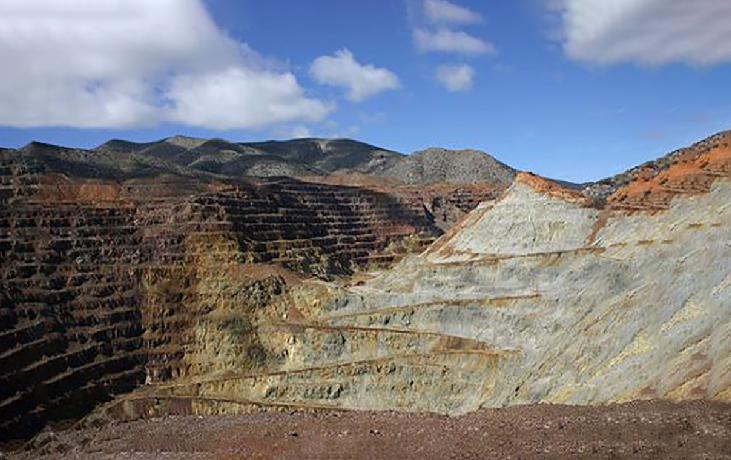
Last August, the Geological, Mining and Metallurgic Institute (Ingemmet) granted a total of 297 concession titles at a national level; accumulating a total of 984, without considering the months of April, May and June.
This was reported by the Ministry of Energy and Mines (MINEM) in its Mining Statistics Bulletin updated as of August of this year.
In addition, it is worth noting that the August value was the highest so far this year, followed by January (241), February (187), March (157) and July (102).
In terms of hectares, Ingemmet detailed that from January to August a total of 529,839 hectares have been granted in concession. Of this value, August was also the highest with 170,410 hectares (ha).
proEXPLO 2021: Mineral Resources for a Sustainable Future
Investments in Mining Exploration Totaled US$ 134.9 Million as of August
 23rd October
23rd October
Investments in mining exploration totaled USD 134.9 million as of august
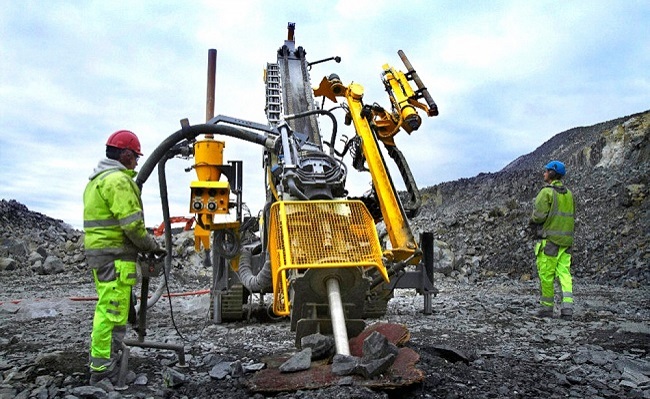
From January to August of this year, mining companies operating in Peru spent a total of US$ 134.9 million in exploration. This was published by the Ministry of Energy and Mines in its mining statistics bulletin updated as of the eighth month of 2020.
The Ministry also stated that in August alone, investment in this activity was US$ 13.3 million, 55.9% less than the same month last year.
The companies
Regarding the ranking of companies, MINEM stated that, from January to August of this year, Compañía Minera Poderosa remained in first place with an investment of US$ 23 million, representing 16.9% of the total (US$ 134.9 million).
The second place was held by Compañía de Minas Buenaventura with an accumulated investment of US$ 11.1 million, representing 8.2%, followed by Minera Barrick Misquichilca with US$ 9.1 million and a 6.8% share.
“These three companies together represented 31.9% of the total investment in mining exploration”, reported MINEM.
In fourth and fifth place were Consorcio Minero Horizonte and Nexa Resources Peru, which invested US$ 8.3 million and US$ 5.5 million, respectively.
proEXPLO 2021: Mineral Resources for a Sustainable Future
Interview | Eng. Enrique Garay, President of the XII International Congress of Prospectors and Explorers (proEXPLO 2021)
 4th September
4th September
"Peru has the best geological characteristics"
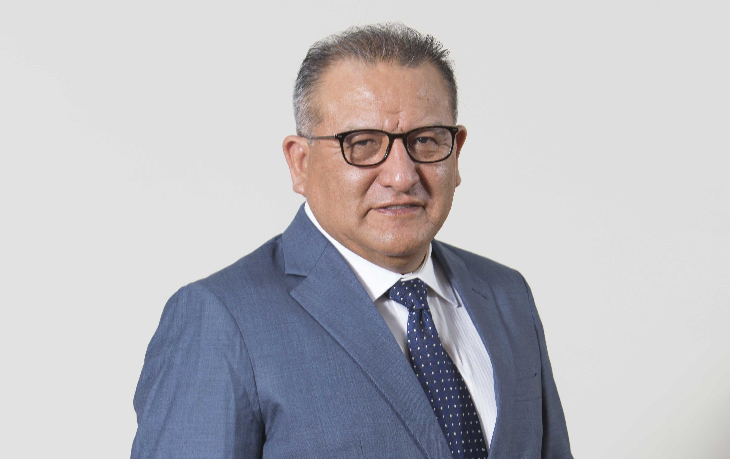
Engineer Enrique Garay, President of the 12th International Congress of Prospectors and Explorers (proEXPLO 2021), shares information on this major international event to be held from May 22nd to 26th, 2021, organized by the Peruvian Institute of Mining Engineers, as well as his thoughts on current exploration issues.
What are the objectives of the 12th Congress of Prospectors and Explorers (proEXPLO 2021)?
Our objectives for the 12th Congress of Prospectors and Explorers (proEXPLO 2021) include bringing together and integrating the community of Prospectors and Explorers from Peru and the world for presenting new discoveries of mineral deposits, advances in technological innovation for mining exploration, and how we can turn those discoveries into mines. It will also be an opportunity for participants to network and visit the technology and exploration services fair. On the other hand, there will also be presentations by junior exploration companies and private investor projects. I would like to add that proEXPLO 2021 will take place from March 22nd to 26th, 2021.
What changes has the new post-Covid-19 normality generated in terms of structure for this event?
It should be noted that, due to the global health emergency, and in order to safeguard the health of participants, on this occasion, the 12th Congress of Prospectors and Explorers (proEXPLO 2021) will be held online.
What progress has been made towards the 12th Congress of Prospectors and Explorers (proEXPLO 2021)?
Because of its virtual modality, this time proEXPLO 2021 will offer 5 days of technical talks, with 4 - hour duration in the afternoon. At the end of each day, we will present keynote speeches by renowned world-class professionals. Then, in the mornings there will be two days of talks given by Junior Mining Companies and one day of talks given by private mining investors. The suppliers' fair will also be virtual, allowing Congress attendees to interact with the suppliers directly in a virtual environment specially designed for this event. Also, as usual, there will be virtual short pre and post Congress courses.
What are the main new aspects of this new proEXPLO edition?
We will have several news. For example, there will be two days of sessions held by Junior Exploration Mining Companies, one day of sessions for private prospectors, and the biggest novelty is that, this time, proEXPLO 2021 will be completely online and in real time, where participants and speakers will be able to interact directly, and visitors to the fair will also be able to interact with suppliers. We will be providing timely informing on this platform's features, which will be user-friendly and accessible from a computer, tablet or smartphone.
What is your opinion about the recent change in mining exploration regulations made by the government? What would you highlight about this change?
The simplification of procedures for mining exploration is very positive. Unfortunately, in recent years, Peru has lost competitiveness in the management of exploration permits. For example, managing an Environmental Affidavit (DIA, for its Spanish acronym) that allows drilling on up to 40 platforms takes between 18 and 24 months; while in Chile a similar permit takes 3 months and in Canada it takes 2 weeks. Unfortunately, we must recognize that Peru has lost competitiveness in the Fraser ranking; it is our responsibility to improve our ranking.
One of the country's objectives was to capture 8% of investments in exploration worldwide by 2021. Can this still be achieved?
Of course, the country has the best geological characteristics to host different types of ore deposits. If we reduce the time taken to obtain permits for the exploration and execution of mining projects, and if we also define clear rules for our relationship with the communities, Peru will once again be attractive for mining investment, but we are aware that such investment must be a responsible mining investment that complies with Peruvian standards and laws and respects the communities.
What needs to be done to encourage investment in mining exploration in the country?
We need clear rules and reduced permitting times; we need to reach a framework agreement to achieve a social license and eliminate prior consultation. The national, regional and local governments must invest the taxes paid by mining in favor of the communities where mines operate; and, above all, this is the political will of central and regional governments, with the participation of private companies and, of course, communities with whom long-term sustainable development policies must be defined.
proEXPLO 2021: Mineral Resources for a Sustainable Future
Rising Gold Prices Attract Investors for Exploration Projects
 4th September
4th September
Rising gold prices attract investors for exploration projects
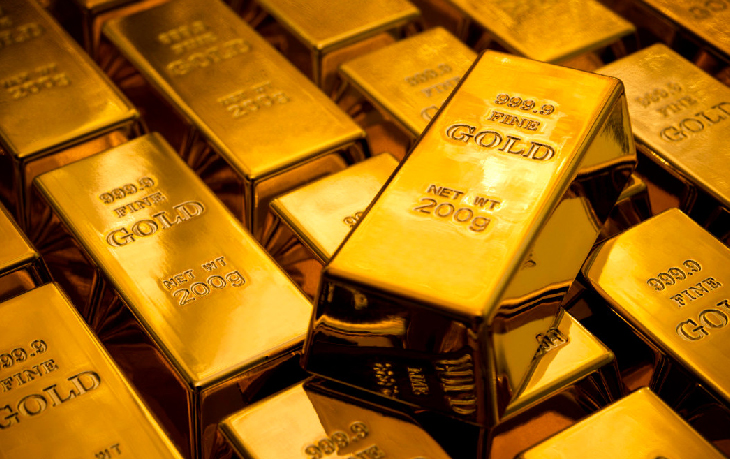
For Kallpa SAB's Capital Markets Manager Ricardo Carrión, this price projection is good enough to boost mining exploration projects that were waiting for more financing.
"In Peru, from what we are seeing, gold exploration projects are starting to move much faster than before. We have three or four gold projects mapped out that are starting to take off. There are some in very early stages and others a little more advanced," he said.
He explained that these mining companies operate privately, carrying out the exploration phase on their own account and then, as they find ore, they can offer what they have found to large mining companies.
According to Mr. Carrión, the projects they have detected, in their majority, will only enter the drilling stage, which could take months or years, and once they have indications that the drilling is on track, it is only then that the interest of companies will be shown.
"Many were stranded because there was no money in the industry and price was not attractive either. Today, at those levels, with good gold prices and working capital, they are being reactivated. Maybe in five years we could have a new gold mine, which was what Peru lacked to increase its reserves," he said.
He mentioned that, in 2009, there was also a high price of minerals and then this began to settle down, so he considered that activity for new projects will be very similar to what it was at that time.
"Among analysts there is a consensus that good years are coming for mining and gold specifically," he said.
proEXPLO 2021: Mineral Resources for a Sustainable Future
Investment in Mining Exploration Totaled USD 122 Million as of July this Year
 4th September
4th September
Investment in mining exploration totaled USD 122 million as of july this year
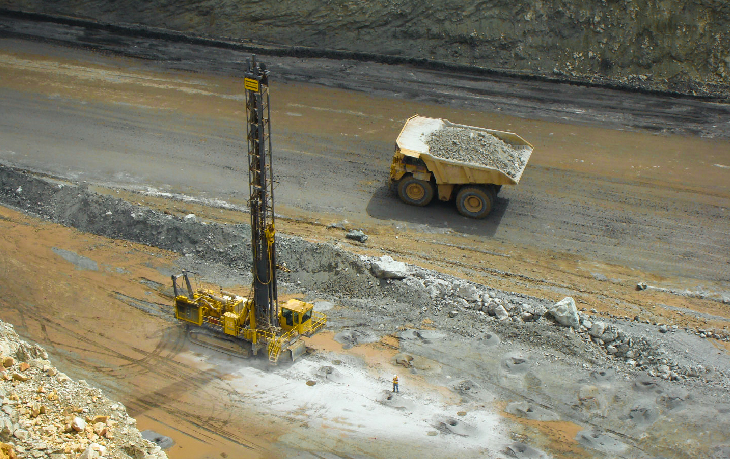
From January to July of this year, mining companies operating in Peru spent a total of USD 121.6 million on mining exploration, according to information from the Ministry of Energy and Mines (MINEM). This figure represents a decrease of 38.8% compared to the same period in 2019, when investment in exploration amounted to USD 198.6 million.
According to this report, investment in this area in July alone was USD 15 million, which was 7.1% higher than the amount registered in the previous month.
In addition, it was specified that, from January to July, Compañía Minera Poderosa S.A. and Compañía de Minas Buenaventura S.A.A. were in first and second positions, with an investment of USD 22 million and USD 9 million, respectively.
They were followed by Minera Barrick Misquichilca S.A. with an investment of USD 8 million, Consorcio Minero Horizonte S.A. with USD 7 million and Nexa Resources Peru S.A.A. with USD 5 million. Thus, the five companies together represented 42.7% of the total investment in mining exploration as of July of this year.
As recalled, the Second Vice President of the Peruvian Institute of Mining Engineers (IIMP), Miguel Cardozo, pointed out that mining exploration projects are normally at short term; therefore, long term agreements with communities are not required.
In view of this, he considered the application of Prior Consultation in Peru, which within the framework of ILO Convention 169 requires informing the population about long-term impacts, to be an "absolute absurdity”.
proEXPLO 2021: Mineral Resources for a Sustainable Future
Interview | Miguel Cardozo, Second Vice President of the Institute of Mining Engineers of Peru (IIMP)
 4th September
4th September
"Applying prior consultation to mining exploration is an absolute absurdity"
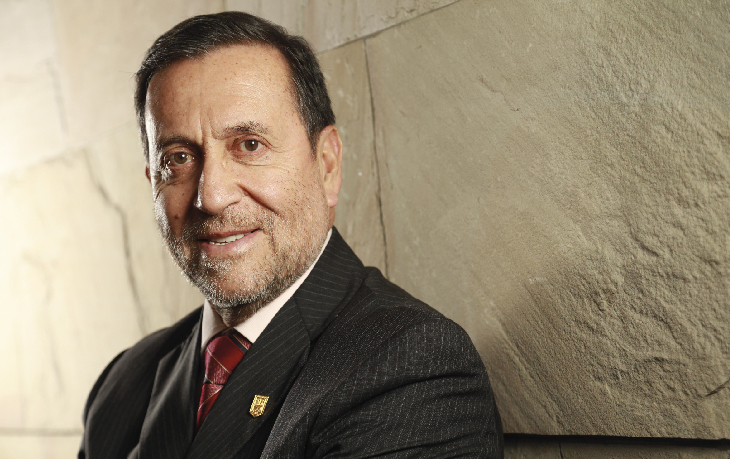
The Second Vice President of the Peruvian Institute of Mining Engineers (IIMP), Miguel Cardozo, pointed out that mining exploration projects are normally at short term; therefore, long term agreements with communities are not required.
In view of this, he considered the application of Prior Consultation in Peru, which within the framework of ILO Convention 169 requires informing the population about long-term impacts, to be an "absolute absurdity”.
"Out of 1,000 prospects, one becomes a mine and 100 achieve the drilling stage, which also takes a few months. In the vast majority of cases, companies arrive, search and leave. So, what are we going to inform communities? That we are looking for a deposit that we don't have?”, he asks.
Similarly, Miguel Cardozo maintained that the mining exploration carried out by companies in Peru does not generate significant impacts, however, it faces obstacles that prevent its development.
"The law treats us as if we were environmental criminals and we are guilty before we even start. Negative administrative silence is impossible to handle. No deadline is met because there is no way to make it mandatory. There have been attempts to eliminate it for the Environmental Technical File case, but the Environmental Impact Statement and the Semi-Detailed Environmental Impact Assessment are still missing," he explained.
Finally, he added that if there is no mining, the country will have a difficult economic situation, so it is essential to sit down and consider the issue together and by consensus.
proEXPLO 2021: Mineral Resources for a Sustainable Future
IIMP holds grand launch of proEXPLO 2021 exploration event
 13th February
13th February
IIMP holds grand launch of proEXPLO 2021 exploration event
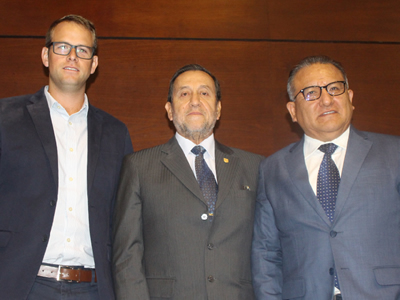
The Peruvian Institute of Mining Engineers (IIMP) made the grand launching of the 12th International Congress of Prospectors and Explorers (proEXPLO 2021), one of the most important mining exploration events in the continent, which will be held in the framework of our Bicentennial, from February 8 to 10, 2021.
This presentation took place during the traditional Mining Thursday, organized by the IIMP, with the special participation of Eng. Enrique Garay, president of the event, and Eng. Sebastián Benavides Kolind-Hansen, member of the organizing committee of the event, who gave the presentation "Mining exploration in the new decade".
Other members of the organizing committee are Dr. Miguel Cardozo, vice-president of the IIMP, Dr. Silvia Rosas Lizarraga, and engineers David Kelley, Jean Vallance, César Farfán Bernales, Carlos Urrea Farias, Ángel Mondragón Dávila, Jonás Mota e Silva and economist Alberto Arispe Bazán.
During his presentation, Eng. Enrique Garay said that this new edition aims to emphasize that mining exploration must be understood from a comprehensive point of view, since each of its activities forms part of a value chain that allows us to consolidate the discovery of new deposits.
He added that proEXPLO 2021 is projected to receive more than 900 participants, and will have three research categories: 1) Innovation in Exploration, 2) Exploration Success Stories: Peru and Latin America, and 3) Optimal Transition: From Exploration to Mine.
First Exploration Projects Fair
One of the novelties of proEXPLO 2021 will be the presentation of the First Exploration Projects Fair, a new platform for commercial interaction between small mining investors and large mining companies or investment funds interested in expanding their investment portfolios.
"We want proEXPLO 2021 to be a platform for this type of negotiations. Not just juniors, but individual investors who have a mining property and can present their projects in an orderly, technical and sustained manner," he remarked.
Likewise, the traditional Core Shack will be held, a space especially designed for the exhibition of exploration samples from the projects of leading mining companies in the country, showing the progress of their explorations through witnesses, photographs and plans. This will be aimed at junior mining companies.
There will also be a Technological and Trade Exhibition with the participation of the main mining and service companies that work in exploration, as well as universities and mining industry institutions.




